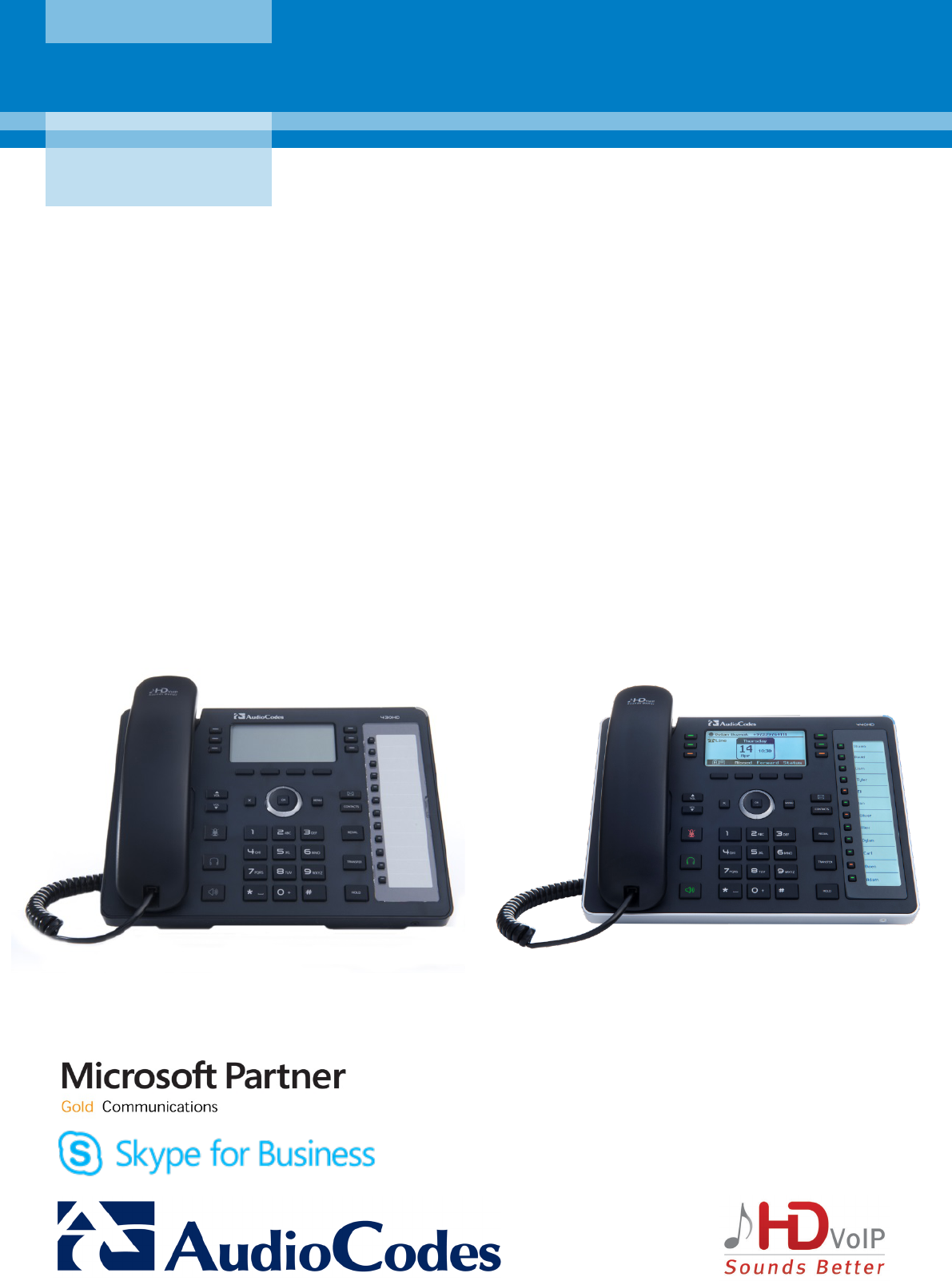
AudioCodes 400HD Series of High Definition IP Phones
HD VoIP 430HD and 440HD IP Phones
User’s Manual
430HD and 440HD IP Phones for Microsoft
®
Skype
™
for Business
Version 3.0.1

User's Manual Contents
Version 3.0.1 3 430HD and 440HD IP Phone
Table of Contents
1 Introducing the 430HD and 440HD IP Phone .......................................................... 11
1.1 About AudioCodes' Series of High Definition IP Phones ................................................. 11
1.2 Cutting Edge Voice Quality & HD VoIP ........................................................................... 11
2 Setting up the Phone ................................................................................................. 13
2.1 Unpacking ........................................................................................................................ 13
2.2 Device Description ........................................................................................................... 13
2.2.1 Front View .......................................................................................................................... 13
2.2.2 Rear View .......................................................................................................................... 15
2.3 Cabling ............................................................................................................................. 16
2.4 Mounting the Phone ......................................................................................................... 17
2.4.1 Desktop Mounting .............................................................................................................. 17
2.4.1.1 Routing the Handset Cable ................................................................................ 17
2.4.2 Wall Mounting .................................................................................................................... 17
3 Getting Started ........................................................................................................... 19
3.1 Getting Acquainted with the Phone Screen ..................................................................... 19
3.2 Softkeys ........................................................................................................................... 20
3.3 Navigating the Phone Menu ............................................................................................ 21
3.4 Selecting an Alphanumerical Mode ................................................................................. 22
4 Signing In ................................................................................................................... 25
4.1 Signing in with PIN Code ................................................................................................. 25
4.2 Signing in with User Name and Password ....................................................................... 26
4.3 Signing in with the Cloud PBX Web Option ..................................................................... 26
4.4 Signing Out ...................................................................................................................... 27
4.4.1 Signing out if the 'Sign out' Softkey is Removed from the Screen .................................... 27
4.5 Displayed Messages ........................................................................................................ 30
5 Unlocking a Locked Phone ....................................................................................... 31
6 Customizing Your Phone .......................................................................................... 33
6.1 Changing the Screen Language ...................................................................................... 33
6.2 Selecting Ring Tone ........................................................................................................ 34
6.3 Enabling Call Waiting ....................................................................................................... 35
6.4 Managing Simultaneous Incoming Calls .......................................................................... 35
6.4.1 Configuring Busy on Busy ................................................................................................. 36
6.5 Defining Call Forwarding ................................................................................................. 37
6.6 Setting Date and Time ..................................................................................................... 38
6.7 Changing Screen Contrast Level ..................................................................................... 40
6.8 Defining BLF LCD Contrast ............................................................................................. 41
6.9 Defining Screen's Backlight Timeout ............................................................................... 42
6.10 Selecting an Answering Device .......................................................................................
43
6.11 Defining Location ............................................................................................................. 44
6.12 Defining an Outbound Proxy ............................................................................................ 45
6.13 Adjusting Volume ............................................................................................................. 46
6.13.1 Adjusting Ring Volume ...................................................................................................... 46
6.13.2 Adjusting Tones Volume .................................................................................................... 46
6.13.3 Adjusting Handset Volume ................................................................................................ 46
6.13.4 Adjusting Speaker Volume ................................................................................................ 47
6.13.5 Adjusting Headset Volume ................................................................................................ 47
6.14 Managing Phone Directories ........................................................................................... 48

430HD and 440HD IP Phone
User's Manual 4 Document #: LTRT-11939
6.14.1 Accessing Directories ........................................................................................................ 48
6.14.2 Adding a Contact to the Personal Directory ...................................................................... 49
6.14.3 Editing Contact Information in the Personal Directory ....................................................... 50
6.14.4 Deleting a Contact from the Personal Directory ................................................................ 51
6.14.5 Adding a Person to Favorites after a Call with them is Logged ......................................... 52
6.14.6 Removing a Person from Favorites ................................................................................... 53
6.14.7 Searching for a Contact in a Directory ............................................................................... 54
6.15 Searching for a Contact in the Corporate Directory using T9 .......................................... 55
6.15.1 Changing from T9 to A/a/1 ................................................................................................. 55
6.16 Defining Function Keys as Speed Dials ........................................................................... 56
6.16.1 Configuring Pause Dialing for a Speed Dial to an Ext. behind an IVR .............................. 57
6.16.2 Editing a Speed Dial .......................................................................................................... 58
6.16.3 Deleting the Speed Dial ..................................................................................................... 59
6.17 Defining Function Keys as Paging Dials .......................................................................... 60
6.18 Defining Programmable Keys as Speed Dials ................................................................. 62
6.18.1 Deleting the Speed Dial ..................................................................................................... 63
6.19 Defining Programmable Keys as Paging Dials ................................................................ 64
6.20 Defining Programmable Keys as Key Events .................................................................. 66
6.20.1 Defining Programmable Key #6 as a VocaNOM Speed Dial ............................................ 67
6.20.2 Deleting a Key Event ......................................................................................................... 68
6.21 Changing your Presence Status ...................................................................................... 69
6.22 Viewing Microsoft Exchange Calendar in the Phone Screen .......................................... 70
6.23 Receiving Meeting Reminders ......................................................................................... 71
7 Performing Basic Operations ................................................................................... 73
7.1 Using Audio Devices ........................................................................................................ 73
7.2 Making Calls .................................................................................................................... 73
7.2.1 Dialing ................................................................................................................................ 73
7.2.2 Redialing ............................................................................................................................ 74
7.2.3 Dialing a Missed Call ......................................................................................................... 75
7.3 Answering Calls ............................................................................................................... 76
7.4 Rejecting Incoming Calls ................................................................................................. 77
7.5 Silencing Incoming Calls .................................................................................................. 78
7.6 Making a New Call Even Though a Call is Coming in ..................................................... 78
7.7 Ending an Established Call .............................................................................................. 78
7.8 Viewing Missed, Received and Dialed Calls .................................................................... 79
7.9 Paging .............................................................................................................................. 81
7.9.1 Performing Outgoing Paging Calls .................................................................................... 81
7.9.2 Receiving Incoming Paging Calls ...................................................................................... 81
8 Performing Advanced Operations ........................................................................... 83
8.1 Answering Waiting Calls .................................................................................................. 83
8.2 Placing Calls On Hold ...................................................................................................... 84
8.3 Handling Multiple Incoming Calls ..................................................................................... 84
8.4 Calling a Contact from 'Favorities' ................................................................................... 85
8.5 Using a Speed Dial to Call ............................................................................................... 86
8.6 Transferring Calls ............................................................................................................ 87
8.6.1 Performing a Blind Transfer ............................................................................................... 87
8.6.2 Performing a Consultative Transfer ................................................................................... 88
8.6.3 Performing a Semi-Consultative Transfer.......................................................................... 89
8.6.4 Merging Calls ..................................................................................................................... 90
8.7 Parking a Call .................................................................................................................. 91
8.8 Configuring Group Call Pickup (GCP) ............................................................................. 91
8.9 Initiating a Multi-Party Skype for Business Remote Conference ..................................... 92

User's Manual Contents
Version 3.0.1 5 430HD and 440HD IP Phone
8.10 Muting Calls ..................................................................................................................... 95
8.1 Setting up Better Together over Ethernet ........................................................................ 96
8.1.1 Installing the BToE PC/Laptop Application ........................................................................ 96
8.1.2 Making Sure BToE is Correctly Installed ......................................................................... 104
8.1.3 Configuring the BToE TCP Port ....................................................................................... 104
8.1.4 Enabling BToE for Online Users ...................................................................................... 105
8.1.5 Automatically Pairing the BToE PC/Laptop Application with the IP Phone ..................... 105
8.1.6 Manually Pairing the BToE PC/Laptop Application with the IP Phone ............................ 106
8.1.6.1 Manually Generating a Pair Code .................................................................... 106
8.1.6.2 Manually Connecting the IP Phone with the BToE PC/Laptop Application...... 107
8.1.6.3 Connecting the Skype for Business Client with the IP Phone .......................... 110
8.1.7 Making Sure IP Phone/ Skype for Business Client are Paired ........................................ 110
8.1.7.1 Making Sure Skype for Business Client is Paired ............................................ 110
8.1.7.2 Making Sure the IP Phone is Paired ................................................................ 111
8.2 Using BToE Functions ................................................................................................... 112
8.2.1 Signing in to the Phone from the Skype for Business Client ........................................... 112
8.2.2 Making a Call (Click-to-Dial) ............................................................................................ 113
8.2.3 Answering a Call .............................................................................................................. 113
8.2.4 Establishing a Unified Communications Call Conference ............................................... 115
8.2.5 Transferring a Call ........................................................................................................... 117
8.2.6 Switching the Primary Audio Device ................................................................................ 117
8.2.7 Routing Voice from a Video Call to the Phone ................................................................ 119
8.3 Using the Boss Admin Feature ...................................................................................... 120
8.3.1 Viewing who the Admins are on the Boss' Phone ........................................................... 120
8.3.2 Viewing who the Bosses are on the Admin's Phone ....................................................... 121
8.3.3 Viewing Bosses and Admins ........................................................................................... 122
8.3.4 Handling an Incoming Call for the Boss........................................................................... 122
8.3.5 Calling on Behalf of the Boss ........................................................................................... 122
8.3.5.1 Using Boss' Line Key ........................................................................................ 123
8.3.5.2 Keying in the Destination Phone Number ........................................................ 124
8.3.5.3 Pressing the CONTACTS Key ......................................................................... 125
8.3.6 Answering a Call on Boss' Phone .................................................................................... 125
8.3.7 Redirecting an Established Call to Boss' Voicemail ........................................................ 126
8.3.8 Redirecting an Incoming Call to Boss' Voicemail ............................................................ 126
8.3.9 Admin Handing Off a Call to Boss ................................................................................... 127
8.3.10 Boss Handing Off a Call to Admin ................................................................................... 127
8.3.11 Boss Monitoring Admins, Seizing a Call Put on Hold by an Admin ................................. 128
8.3.12 Admin Picks up a Call from Boss ..................................................................................... 128
8.3.13 Admin 1 Picks up a Call from Admin 2 ............................................................................ 128
8.3.14 Admin's Phone Notifies Recipient that Admin's Call is on Behalf of Admin's Boss ......... 129
8.3.15 Admin Calling Boss, Admin Calling a Recipient on Behalf of Boss ................................. 129
8.4 Using the Multiple Boss Admin Feature with the 440HD Sidecar .................................. 130
8.4.1 Displaying a Boss's or an Admin's Active Calls in the Sidecar ........................................ 130
8.4.2 Boss Picking up a Call that Admin Put on Hold ............................................................... 132
8.5 Viewing and Playing Voicemail Messages .................................................................... 133
8.5.1 Sending an Incoming Call Directly to Voicemail .............................................................. 134
9 Managing Calls on 2+ Phones with a Delegated Line, Using Sidecars ............... 135
10 Troubleshooting ...................................................................................................... 139
10.1 Uploading Logs to MS Server for Support Purposes ..................................................... 139

430HD and 440HD IP Phone
User's Manual 6 Document #: LTRT-11939
List of Figures
Figure 2-1: Front View ...................................................................................................................................... 14
Figure 2-2: Rear View ....................................................................................................................................... 15
Figure 2-3: Cabling ........................................................................................................................................... 16
Figure 3-1: Phone Screen in Idle State ............................................................................................................ 19
Figure 3-2: Phone Menu ................................................................................................................................... 21
Figure 3-3: Alphanumerical Selection ............................................................................................................... 22
Figure 3-4: Entering a Symbol (e.g., a dot) ...................................................................................................... 23
Figure 3-5: Reverting to Letters (e.g., abc) ...................................................................................................... 23
Figure 4-1: Login ............................................................................................................................................... 28
Figure 4-2: Web Interface – Home Page .......................................................................................................... 28
Figure 4-3: Sign-in – Content Blocked Page .................................................................................................... 29
Figure 4-4: Sign-in – Windows Security Prompt ............................................................................................... 29
Figure 4-5: Windows Security Prompt .............................................................................................................. 30
Figure 4-6: Sign-out .......................................................................................................................................... 30
Figure 8-1: InstallShield Wizard – Preparing to Install ..................................................................................... 97
Figure 8-2: Welcome to the InstallShield Wizard ............................................................................................. 97
Figure 8-3: License Agreement ........................................................................................................................ 98
Figure 8-4: License Agreement ........................................................................................................................ 98
Figure 8-5: Destination Folder .......................................................................................................................... 99
Figure 8-6: Change Current Destination Folder ............................................................................................... 99
Figure 8-7: Ready to Install ............................................................................................................................ 100
Figure 8-8: Installing AudioCodes Better2Gether ........................................................................................... 100
Figure 8-9: InstallShield Wizard Completed ................................................................................................... 101
Figure 8-10: AudioCodes Icon in Taskbar ...................................................................................................... 101
Figure 8-11: Control Panel>Programs>AudioCodes Better2Gether .............................................................. 102
Figure 8-12: Computer Management > Services and Applications ................................................................ 102
Figure 8-13: Device Manager > AudioCodes B2GoE USB Driver ................................................................. 103
Figure 8-14: Popup Menu ............................................................................................................................... 104
Figure 8-15: About AC BToE .......................................................................................................................... 104
Figure 8-16: TCP Port ..................................................................................................................................... 104
Figure 8-17: AC BToE TCP Port .................................................................................................................... 105
Figure 8-18: Popup Menu ............................................................................................................................... 107
Figure 8-19: Phone Pairing ............................................................................................................................. 107
Figure 8-20: AC BToE Failed Indication ......................................................................................................... 107
Figure 8-21: AC BToE is Connected Indication .............................................................................................. 107
Figure 8-22: Popup Menu: 'Disconnect' Enabled, 'Phone Pairing' Disabled .................................................. 108
Figure 8-23: BToE Disconnected ................................................................................................................... 108
Figure 8-24: Popup Menu: BToE Disconnected ............................................................................................. 108
Figure 8-25: Start > Programs > AudioCodes > BToE Controller .................................................................. 109
Figure 8-26: Skype for Business Sign-in Request Prompt ............................................................................. 110
Figure 8-27: Primary Device: IP Phone .......................................................................................................... 117
Figure 8-28: Primary Device: Headset ........................................................................................................... 118
Figure 8-29: Primary Device: Speaker ........................................................................................................... 118

User's Manual Contents
Version 3.0.1 7 430HD and 440HD IP Phone
List of Tables
Table 2-1: Font View Description ..................................................................................................................... 14
Table 2-2: Rear View Description ..................................................................................................................... 15
Table 3-1: Phone Screen in Idle State .............................................................................................................. 19
Table 3-2: Softkeys ........................................................................................................................................... 20
Table 4-1: Displayed Messages Indicating Processes In Progress ................................................................. 30
Table 6-1: Time Zones...................................................................................................................................... 39
Table 6-2: Presence Statuses .......................................................................................................................... 69
Table 8-1: Multiple Boss Admin ...................................................................................................................... 130
Table 9-1: Phone Screen in Idle Mode and Sidecar BLF Keys and Fields .................................................... 135
Table 9-2: Phone A: Answered Incoming Call on Phone A ............................................................................ 136
Table 9-3: Phone B: Answered Incoming Call on Phone A ............................................................................ 136
Table 9-4: New Incoming Call ........................................................................................................................ 137
Table 9-5: Answered New Incoming Call ....................................................................................................... 137
Table 9-6: Phone B: Answered New Incoming Call ....................................................................................... 138
Table 9-7: Phone B: Two Red BLF Keys........................................................................................................ 138
Table 10-1: Troubleshooting ........................................................................................................................... 139

430HD and 440HD IP Phone
User's Manual 8 Document #: LTRT-11939
This page is intentionally left blank.

User's Manual Notices
Version 3.0.1 9 430HD and 440HD IP Phone
Notice
Information contained in this document is believed to be accurate and reliable at the time of printing.
However, due to ongoing product improvements and revisions, AudioCodes cannot guarantee
accuracy of printed material after the Date Published nor can it accept responsibility for errors or
omissions. Updates to this document and other documents can be viewed by registered customers at
http://www.audiocodes.com/downloads.
© Copyright 2017 AudioCodes Ltd. All rights reserved.
This document is subject to change without notice.
Date Published: June-26-2017
Trademarks
AudioCodes Ltd. All rights reserved. AudioCodes, AC, HD VoIP, HD VoIP Sounds Better,
IPmedia, Mediant, MediaPack, What’s Inside Matters, OSN, SmartTAP, VMAS, VoIPerfect,
VoIPerfectHD, Your Gateway To VoIP, 3GX, VocaNom, AudioCodes One Voice and CloudBond
are trademarks or registered trademarks of AudioCodes Limited All other products or trademarks
are property of their respective owners. Product specifications are subject to change without
notice.
WEEE EU Directive
Pursuant to the WEEE EU Directive, electronic and electrical waste must not be disposed of with
unsorted waste. Please contact your local recycling authority for disposal of this product.
Customer Support
Customer technical support and services are provided by AudioCodes or by an authorized
AudioCodes Service Partner. For more information on how to buy technical support for
AudioCodes products and for contact information, please visit our Web site at
www.audiocodes.com/support.
Abbreviations and Terminology
Each abbreviation, unless widely used, is spelled out in full when first used.
Documentation Feedback
AudioCodes continually strives to produce high quality documentation. If you have any comments
(suggestions or errors) regarding this document, please fill out the Documentation Feedback form
on our Web site at http://www.audiocodes.com/downloads. Your valuable feedback is highly
appreciated.

430HD and 440HD IP Phone
User's Manual 10 Document #: LTRT-11939
Related Documentation
Document Name
400HD Series IP Phones for Microsoft Skype for Business Release Notes
400HD Series IP Phones for Microsoft Skype for Business Administrator’s Manual
430HD IP Phone for Microsoft Skype for Business Quick Guide
440HD IP Phone for Microsoft Skype for Business Quick Guide
400HD Series IP Phones for Skype for Business Hosting Partner (LHPv2) Environment Configuration Note

User's Manual 1. Introducing the 430HD and 440HD IP Phone
Version 3.0.1 11 430HD and 440HD IP Phone
1 Introducing the 430HD and 440HD IP Phone
AudioCodes' 430HD and 440HD IP Phones for Microsoft Skype for Business are based on
AudioCodes High Definition voice technology, providing clarity and a rich audio experience in
Voice-over-IP (VoIP) calls.
Note: Microsoft rebranded Lync as Skype for Business so whenever the term Skype for
Business appears in this document, it applies also to Lync.
The phone is a 1-line, 2 concurrent calls per line, premium model which includes a large
monochrome multi-language graphic Liquid Crystal Display (LCD).
The phone is a fully-featured telephone that provides voice communication over an IP network,
allowing you to place and receive phone calls, put calls on hold, transfer calls, make conference
calls, etc.
Read this User’s Manual carefully to learn how to operate the product and take advantage of its
rich feature set.
1.1 About AudioCodes' Series of High Definition IP Phones
AudioCodes Series of High Definition IP Phones offers a new dimension of voice call quality and
clarity for the IP Telephony market. This new series of IP Phones further expands AudioCodes’
VoIP product offering for the service providers’ hosted services, Enterprise IP telephony and
Enterprise contact centers markets. As a natural addition to the AudioCodes Mobile Clients,
Media Gateway, Media Server & Multi-Service Business Gateway products, the AudioCodes
Series of High Definition IP Phones enable Systems Integrators and end-customers to build end-
to-end solutions that rely on AudioCodes’ technological advantage and proven track record in
providing state-of-the-art products. The AudioCodes Series of High Definition IP Phones meet a
growing demand for High Definition VoIP solutions in end-user phones and terminals, improving
the productivity and efficiency of business communications with new quality standards set by the
High Definition voice technology.
1.2 Cutting Edge Voice Quality & HD VoIP
Based on AudioCodes’ advanced, robust and field-proven VoIPerfectHD™ software,
AudioCodes’ IP Phones are designed to utilize wideband coders. The phones feature enhanced
proprietary capabilities such as packet loss concealment, high quality wideband acoustic echo
canceler, and low-delay adaptive jitter buffers to enrich the HDVoIP experience.

430HD and 440HD IP Phone
User's Manual 12 Document #: LTRT-11939
This page is intentionally left blank.
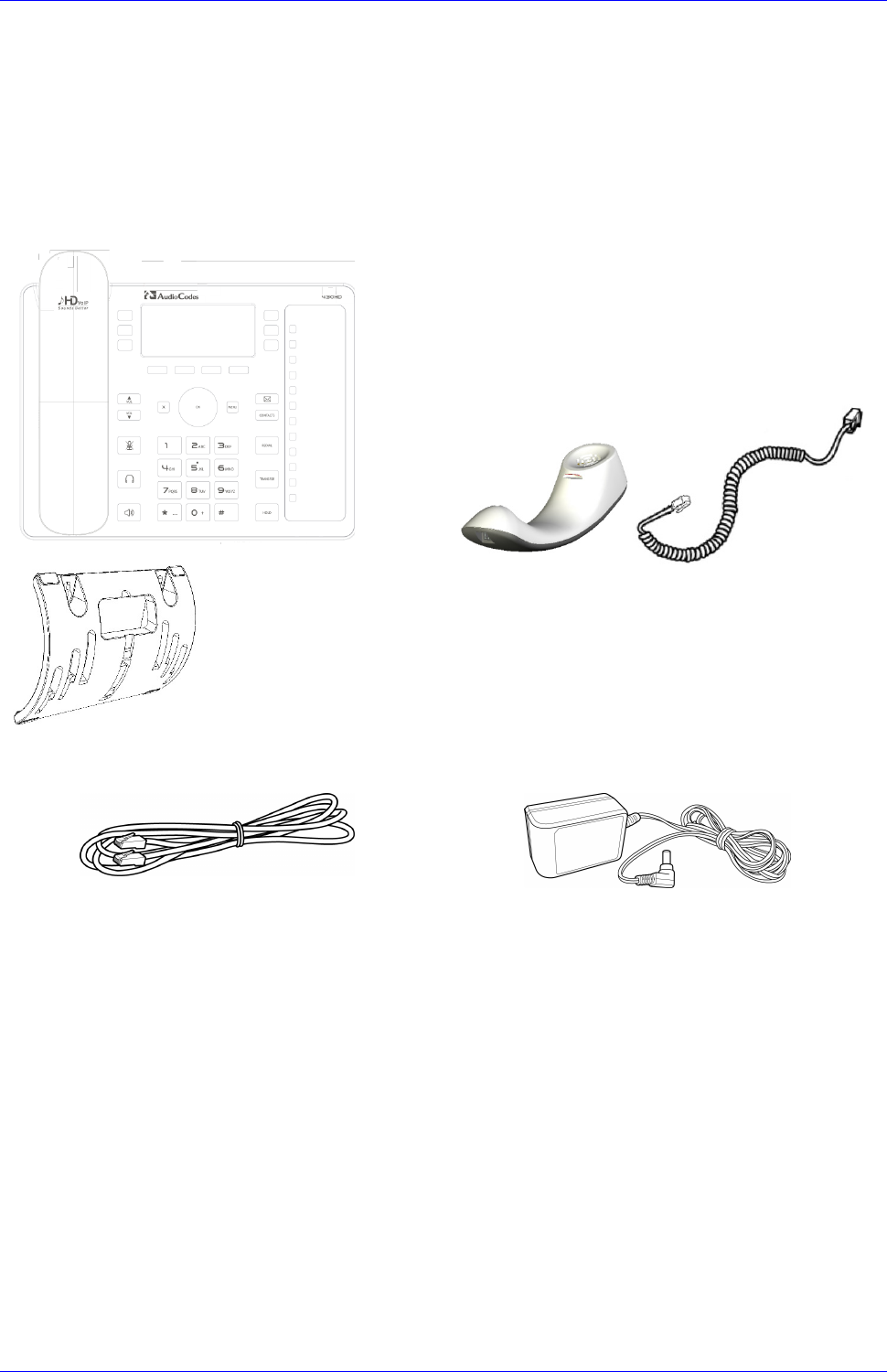
User's Manual Contents
Version 3.0.1 13 430HD and 440HD IP Phone
2 Setting up the Phone
2.1 Unpacking
When unpacking, ensure that the following items are present and undamaged:
IP Phone / Stand Handset / Cord
Cat 5e Ethernet Cable AC Power Adapter (Optional)
If anything appears to be missing or broken, contact the distributor from whom you purchased the
phone for assistance.
2.2 Device Description
Use the graphics below to identify and familiarize yourself with the device's hardware functions.
2.2.1 Front View
The front view of the phone is shown in Figure 2-1 and described in Table 2-1.
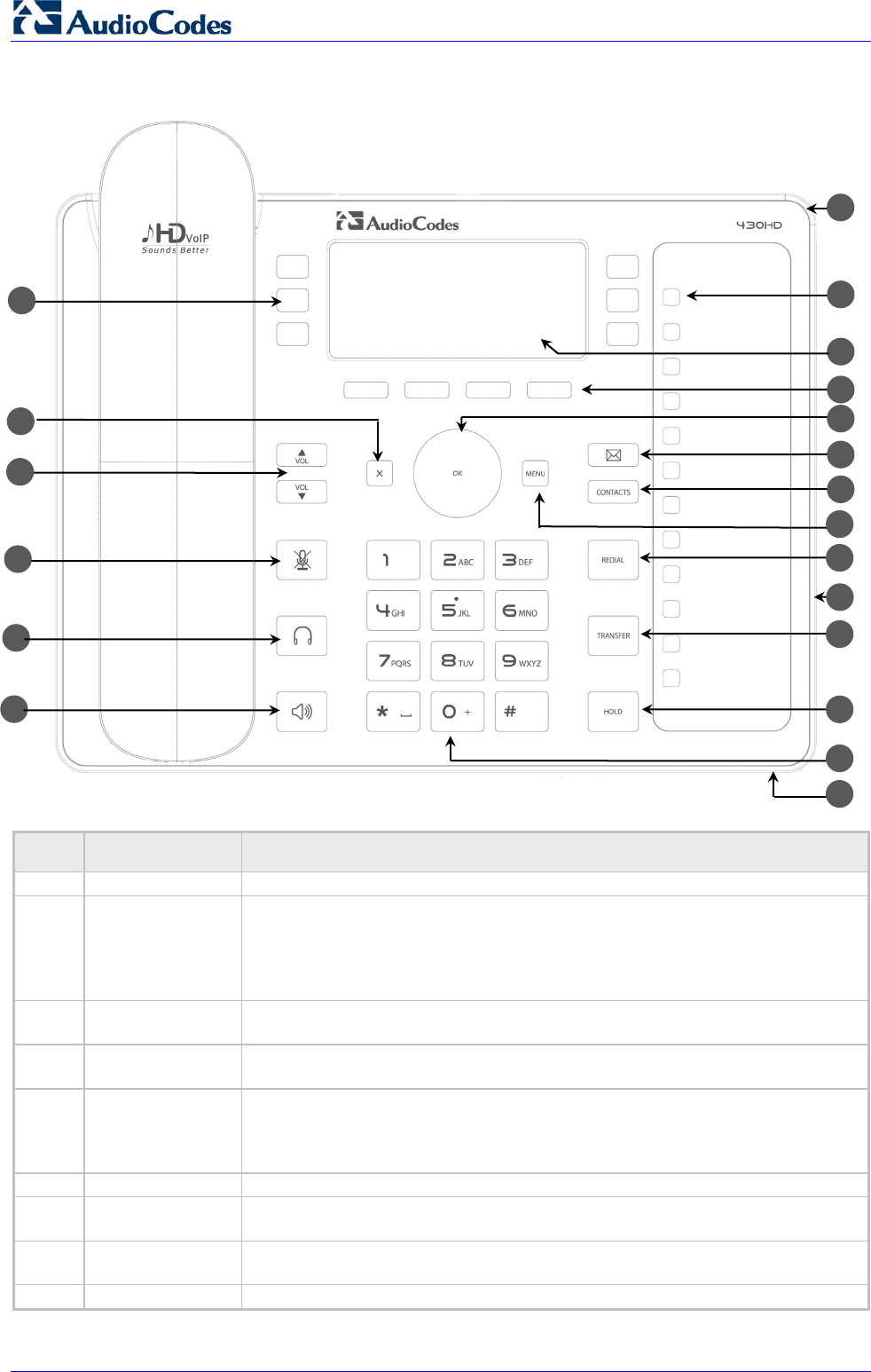
430HD and 440HD IP Phone
User's Manual 14 Document #: LTRT-11939
Figure 2-1: Front View
Table 2-1: Font View Description
Item # Label/Name Description
1
Ring LED
Flashing blue light visually indicates an incoming call.
2
Speed Dial &
BLF
Twelve Speed Dial buttons to quickly call the contact whose name is
displayed adjacent to it. You can configure these speed dial buttons with
Busy Lamp Field (BLF) functionality. On the 440HD phone, a dedicated
electronic screen displays contacts’ names. On the 430HD phone, you can
attach to a paper strip handwritten contacts’ names.
3
Screen
Interactive screen displaying calling information and letting you configure
phone features.
4
Softkeys
See Section 3.2 on page 20 for details on the four softkeys and the available
functions they offer.
5
Navigation
Control / OK
Press the upper rim to scroll up menus/items in the screen. Press its lower
rim to scroll down. Press its left or right rim to move the cursor left or right
(when editing a contact number for example). Press the OK button to select
a menu/item/option.
6
Voicemail
Retrieves voicemail messages.
7
CONTACTS
Press to directly access the 'Favorites' directory. Other directories can be
accessed from the 'Favorites' screen.
8
MENU
Accesses menus: (1) Call Log (2) Calendar (3) Keys Configuration
(4) Settings (5) Device Status (6) Administration (7) Favorities (8) Log upload.
9
REDIAL
Accesses a list of recently dialed numbers; one can be selected to redial.
1
3
4
5
6
7
8
9
11
15
16
17
18
13
12
2
20
19
14
10
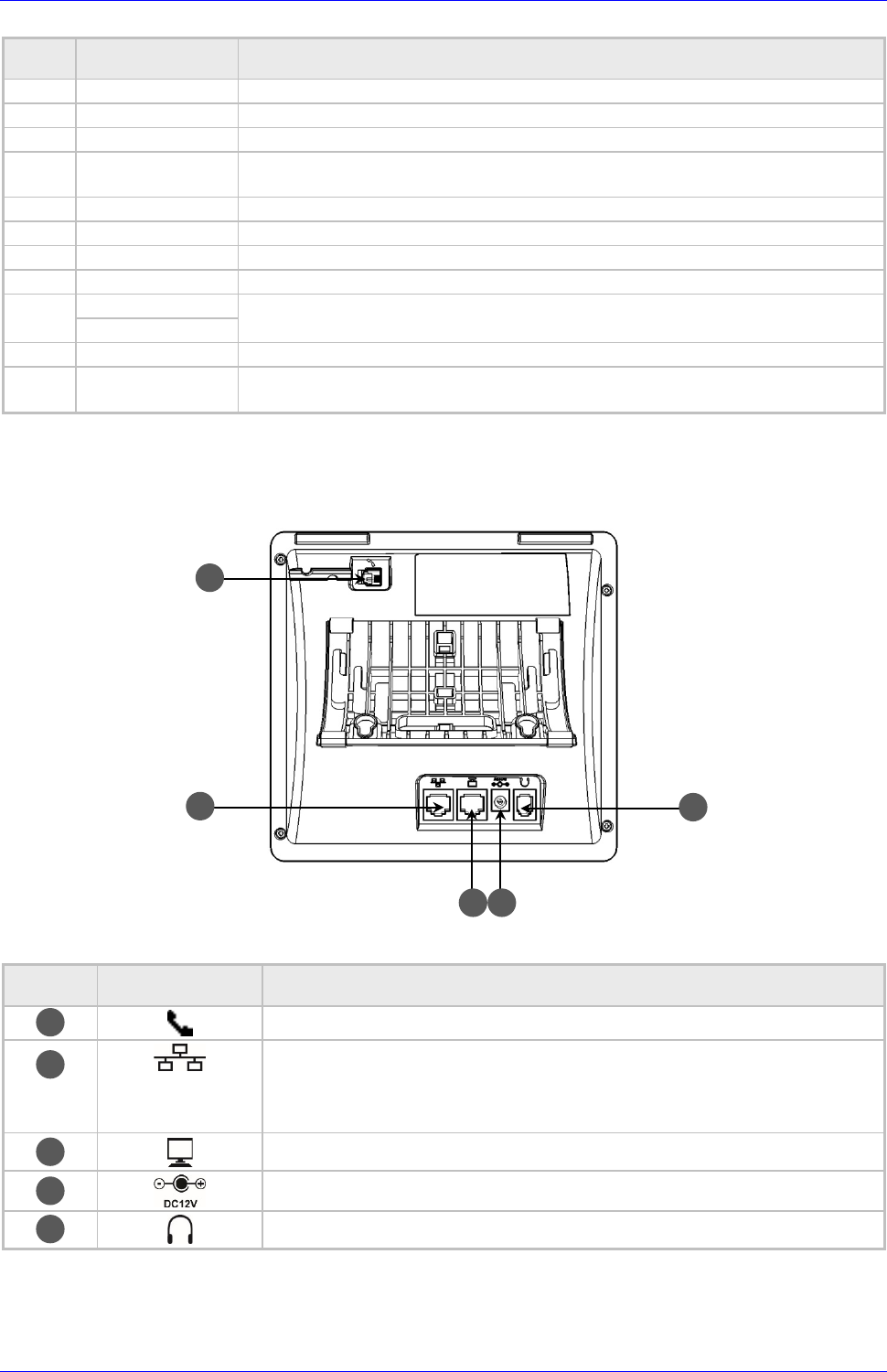
User's Manual Contents
Version 3.0.1 15 430HD and 440HD IP Phone
Item # Label/Name Description
10
Kensington lock
Allows locking the device.
11
TRANSFER
Transfers a call.
12
HOLD
Places an active call on hold.
13
Alphanumerical
Keypad
Keys for entering numbers, alphabetical letters and symbols (e.g., colons)
14
Microphone
Allows talking and listening. Network administrators can disable it if required.
15
SPEAKER
Activates the speakerphone, allowing a hands-free conversation.
16
HEADSET
Activates a call using an external headset.
17
MUTE
Mutes a call.
18
▲ VOL
Increases or decreases the volume of the handset, headset, speakerphone,
ring tone and call progress tones.
▼ VOL
19
x
Cancel an action, such as dialing a number, after beginning it.
20 ---
Programmable keys, located on each side of the screen, to which you can
assign functions.
2.2.2 Rear View
The rear view of the phone is shown in the figure below and described in the table below.
Figure 2-2: Rear View
Table 2-2: Rear View Description
# Label Description
Handset jack, i.e., RJ-9 port, to connect the handset.
RJ-45 port to connect to the Ethernet LAN cable for the LAN connection
(uplink - 10/100/1000 Mbps). If you're using Power over Ethernet (PoE),
power to the phone is supplied from the Ethernet cable (draws power
from either a spare line or signal line).
RJ-45 port to connect the phone to a PC (10/100/1000 Mbps downlink).
12V DC power jack that connects to the AC power adapter.
Headset jack, i.e., RJ-9 port that connects to an external headset.
2
4
3
1
1
2
3
4
5
5
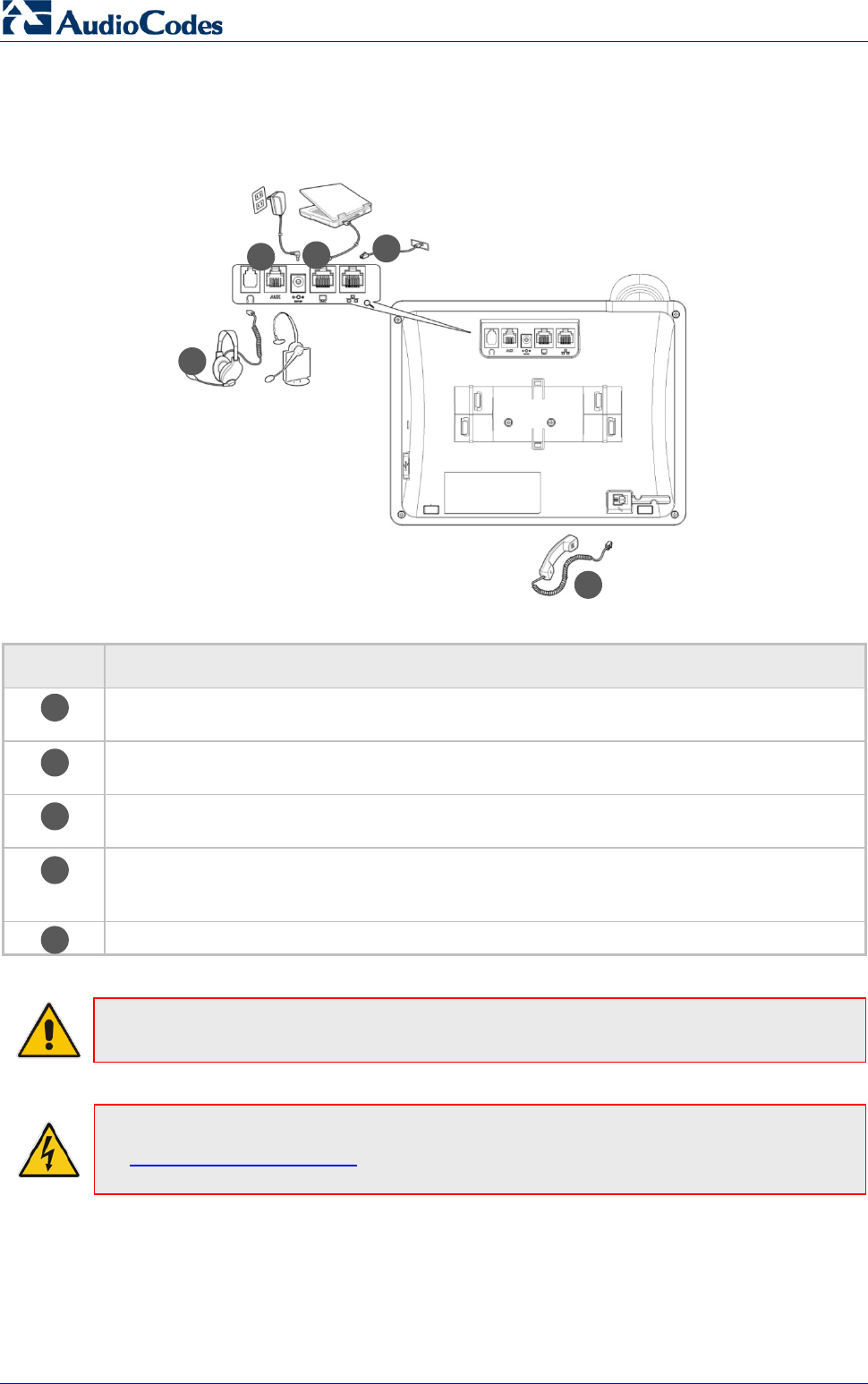
430HD and 440HD IP Phone
User's Manual 16 Document #: LTRT-11939
2.3 Cabling
This section shows how to cable your phone.
Figure 2-3: Cabling
Action Description
Connect the short, straight end of the cord to the handset.
Connect the longer, straight end to the jack (RJ-9 port, for the handset) on the phone.
Connect the RJ-45 LAN port to your LAN network (LAN port or LAN switch/router), using a
CAT 5 / 5e Ethernet cable
Connect the RJ-45 PC port to a computer, using a CAT 5 / 5e straight-through Ethernet
cable
Connect the connector tip of the AC power adapter to the phone’s power socket (labelled DC
12V). Connect the two-prong AC adapter directly to the electrical wall outlet. When the
phone powers up, all the LEDs momentarily light up
Connect the RJ-9 headset jack to a headset (optional)
Note: If the LAN to which the phone is connected supports Power over Ethernet (PoE), no
AC adapter is required; the phone receives power from the Ethernet network.
Prior to connecting power, refer to the Compliancy and Regulatory Information at
www.audiocodes.com/library.
1
2
3
4
5
1
2
3
4
5
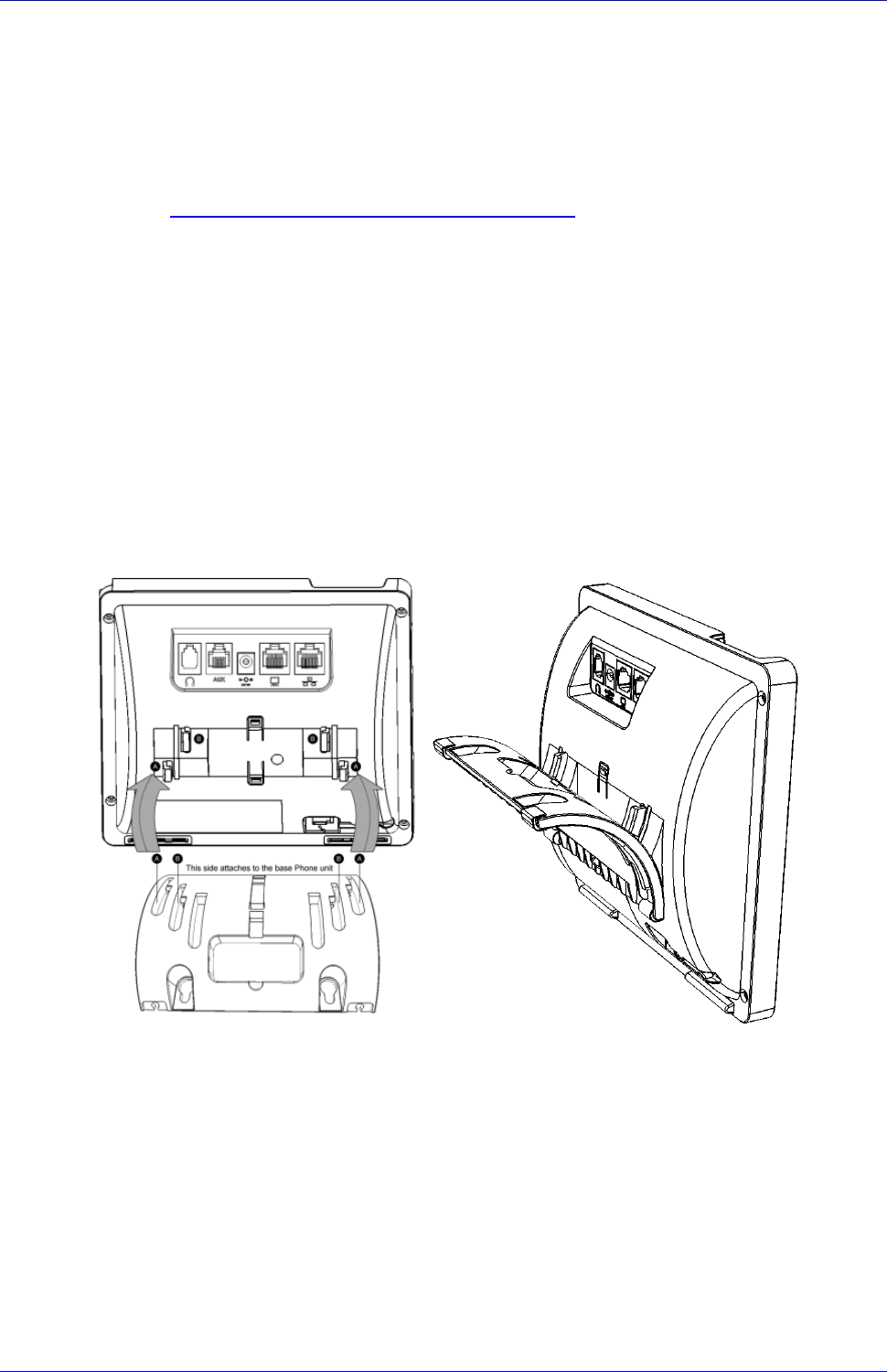
User's Manual Contents
Version 3.0.1 17 430HD and 440HD IP Phone
2.4 Mounting the Phone
The phone can be mounted on a:
Desk (see Section 2.4.1 below)
Wall (see Section 2.4.2 on page 17)
See also https://www.youtube.com/watch?v=oGe9STB9lFE to assemble the base stand.
2.4.1 Desktop Mounting
This section shows how to place the phone on a desk or flat surface.
To mount the phone on a desk or flat surface:
1. Off-hook the handset (if on-hook) and place the phone upside down, i.e., base-up, on your
desktop.
2. On the phone's base, identify outer rails.
3. On the phone's stand, identify outer notches.
4. Invert the stand and align its outer notches with the base's outer rails.
5. Insert the stand's outer notches into the base's outer rails and slide the notches along the
rails until the stand click-locks into the base.
6. Revert the phone and stand it on the desktop.
2.4.1.1 Routing the Handset Cable
The phone features a groove for routing the handset cable.
2.4.2 Wall Mounting
This section shows how to mount the phone on a wall.
To mount the phone on a wall:
1. Attach the stand of the phone for the purpose of a wall mounting:
a. Detach the base.
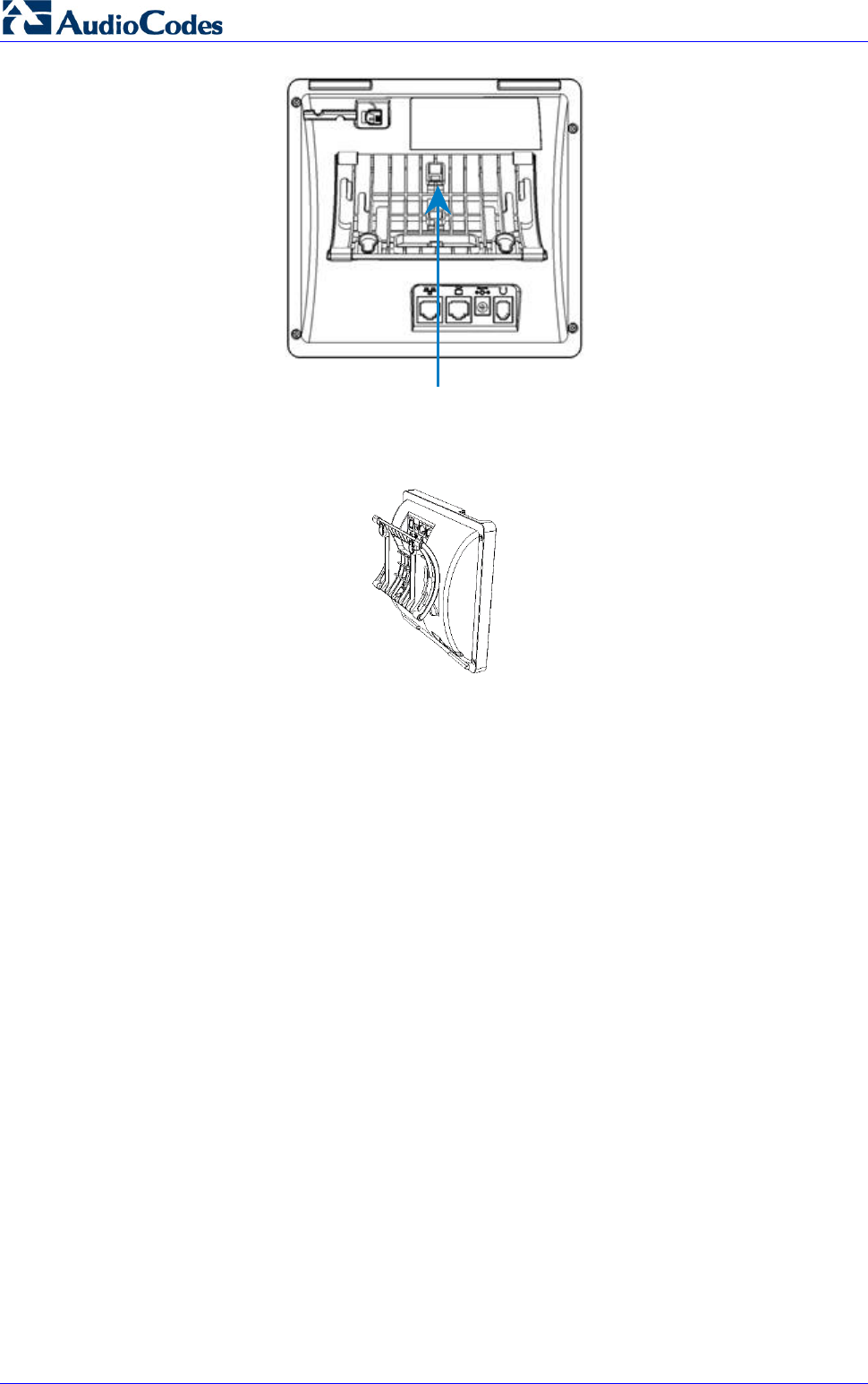
430HD and 440HD IP Phone
User's Manual 18 Document #: LTRT-11939
To detach the phone's stand, push this button
b. Attach it again as you did for a desktop mounting (see Section 2.4.1 on page 17) only
now make sure that it's flatly aligned to lie flush against the wall, i.e., slide the inner rails
of the phone stand onto the phone base's inner notches.
2. Connect the AC power adapter, LAN and PC cords.
3. In the wall, drill two horizontal holes at a distance of 3 15/16 inches (100 mm) from one
another, in line with the template.
4. Insert two masonry anchors into the holes if necessary.
5. Thread two screws (not supplied) into the two masonary anchors; ensure that the heads
extend sufficiently (about 3/16 inch or 5 mm from the wall) for the phone stand's keyhole
slots to hang on.
6. Hang the phone stand's keyhole slots on these screws.
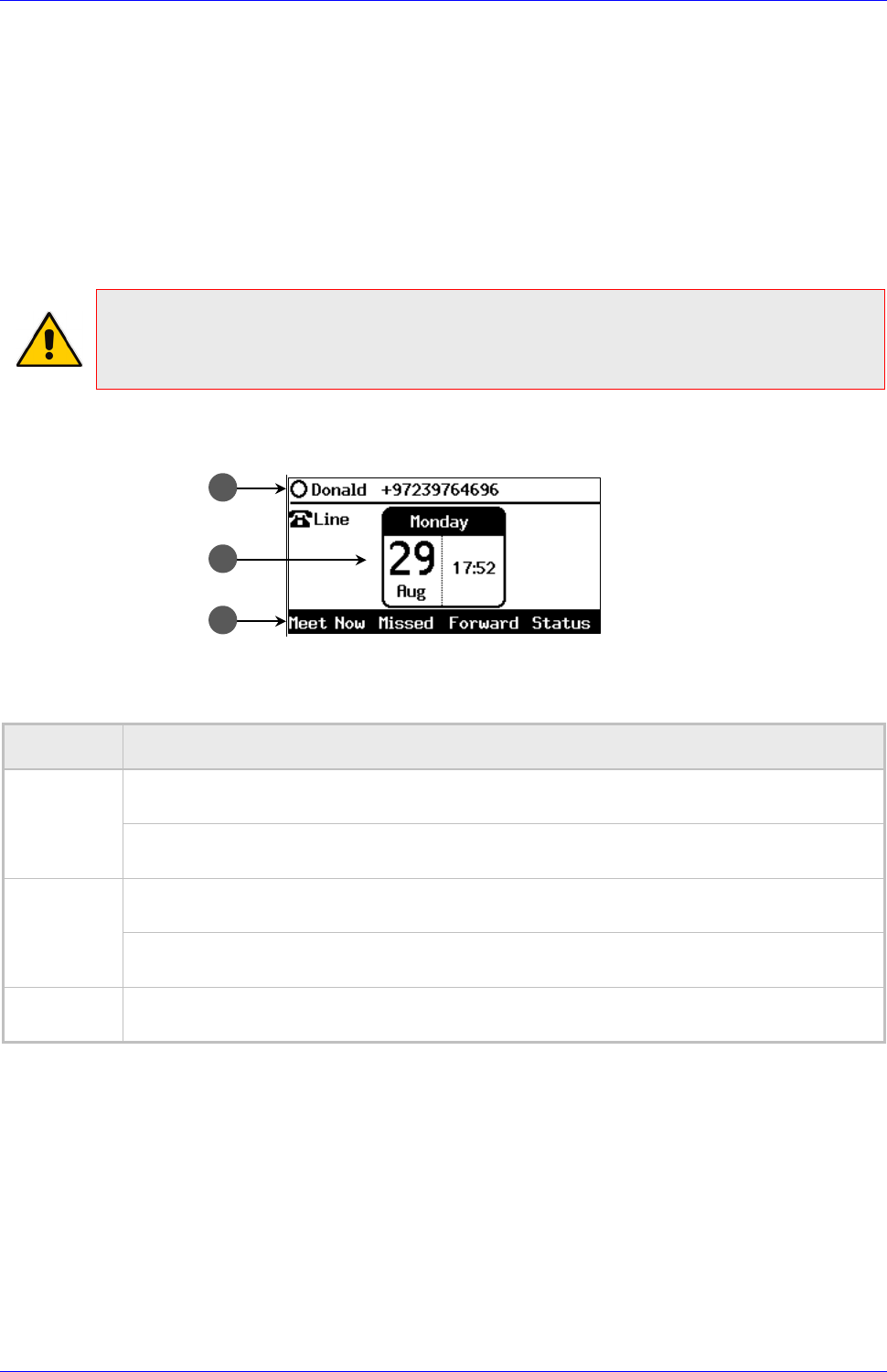
User's Manual Contents
Version 3.0.1 19 430HD and 440HD IP Phone
3 Getting Started
This section gets you started with the phone. The phone features a screen providing an intuitive,
menu-driven user interface for configuring the device and viewing call information.
This section shows how to use the phone’s screen but before using it, you must sign in.
3.1 Getting Acquainted with the Phone Screen
This section gets you acquainted with the phone screen.
Note:
• Screenshots of the 440HD screen are shown in this manual.
• 430HD screens are identical unless indicated otherwise.
The figure below shows the phone’s screen in idle state.
Figure 3-1: Phone Screen in Idle State
Reference:
Table 3-1: Phone Screen in Idle State
Reference Description
1
Presence status (Available, Busy, Do not disturb, Away, or Be right back).
See Section 6.21 on page 69 for details.
User name and phone number configured by your network administrator using the Web
interface.
2
Day, Date and Month, automatically retrieved from the Network Time Protocol (NTP)
server, enabled by your network administrator.
Time, automatically retrieved from the Network Time Protocol (NTP) server, enabled by
your network administrator.
3
Softkeys; to activate a softkey, press the hard key on the device, located below the screen,
corresponding to the softkey. See Table 3-2 for softkey descriptions.
1
3
2

430HD and 440HD IP Phone
User's Manual 20 Document #: LTRT-11939
3.2 Softkeys
The table below describes the softkeys displayed in the screen. Press the hard key located on the
device below the softkey in order to activate the softkey.
Table 3-2: Softkeys
Softkey Description
Meet Now
Initiates a phone conference based on the Skype for Business server. Replaces the Conf
softkey displayed in earlier versions of the 440HD phone and in the 430HD phone.
Missed
Displays missed calls.
Forward
Automatically forwards calls.
Status
Displayed in idle state. Lets you sets your presence status: Available, Busy, Do not disturb,
Away, Be right back.
Sign in
/Sign out
Sign in is displayed if you haven't signed in yet, in the idle screen.
Sign out
is displayed if you press the
Status
softkey after signing in.
Displayed after lifting the handset (for example). Opens the 'Favorites' defined in the Skype
for Business client.
Displayed after lifting the handset (for example). Displays the Call Log.
Select
Identical to the hard OK key on the phone. Either can be used. Selects a menu or option.
BToE
Displayed after pressing the MENU hard key. Generates a code for manually pairing the
phone with Skype for Business client, for unified communications.
A/a/1
Enables switching between input modes: abc, ABC, Abc, 123, or T9.
Save
Saves settings.
Cancel
Cancels the currently initiated call or configuration.
Dial
Displayed after a number is keyed, a directory contact is selected, or a logged call is
selected.
Clear
Displayed after entering a digit of a phone number (for example). Deletes from right to left.
Displayed after a number is dialed and answered on the other side, and after you answer a
call. Displays the Call Menu.
Conf
Displayed (1) after a number is dialed and the call is answered on the other side and (2)
after
you answer a call. Pressing it displays the ADD PARTICIPANT screen.
BXfer
Displayed (1) after a number is dialed and the call is answered on the other side and (2)
after
a call is answered. Lets you transfer the call in a blind transfer.
URL
Displayed after lifting the handset (for example). Enables calling a URL.
Detail
Displayed after selecting a call log (for example). If selected, the details of a logged call are
displayed (Time, Date, etc.).
+Fav
Displayed in the Call Details screen. Allows adding the person to the Favorites directory.
End
Displayed after pressing the
Dial
softkey (for example). Ends the call.
Back
Displayed after pressing the MENU key (for example). Returns to the previous screen.
Start
Displayed after pressing Forward > Forward to a number (for example).
Edit
Displayed after you select a contact to be edited (for example).
Delete
Displayed after pressing the MENU key on the phone and then selecting Call Log (for
example).
Silent
Displayed when the phone rings on an incoming call. Lets you silence the ring.
Reject
Displayed when the phone rings, alerting to an incoming call. Lets you reject the call.
Accept
Displayed when the phone rings, alerting to an incoming call. Lets you accept the call.
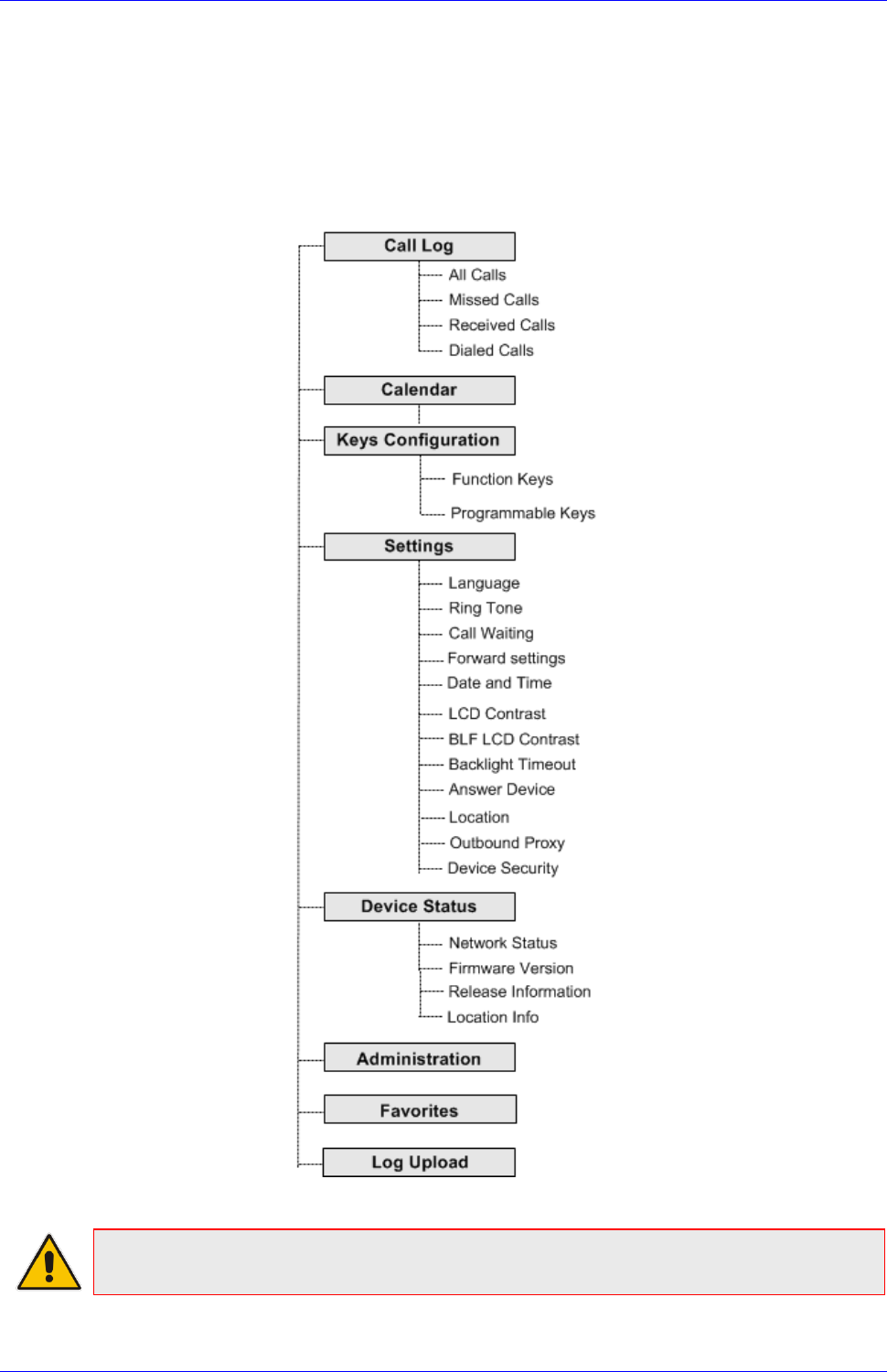
User's Manual Contents
Version 3.0.1 21 430HD and 440HD IP Phone
3.3 Navigating the Phone Menu
The MENU key on the phone lets you access information and configure settings shown in the
figure below. Press it to view call logs, view meetings scheduled in the calendar for that day
(integrated with Skype for Business client), configure speed dials, customize phone settings,
determine device status, perform administration, access 'Favorities' and other phone directories,
and perform log upload to Microsoft server.
Figure 3-2: Phone Menu
Note: Administration is intended for network administrators only. It is password protected.
See the Administrator’s Manual for details.
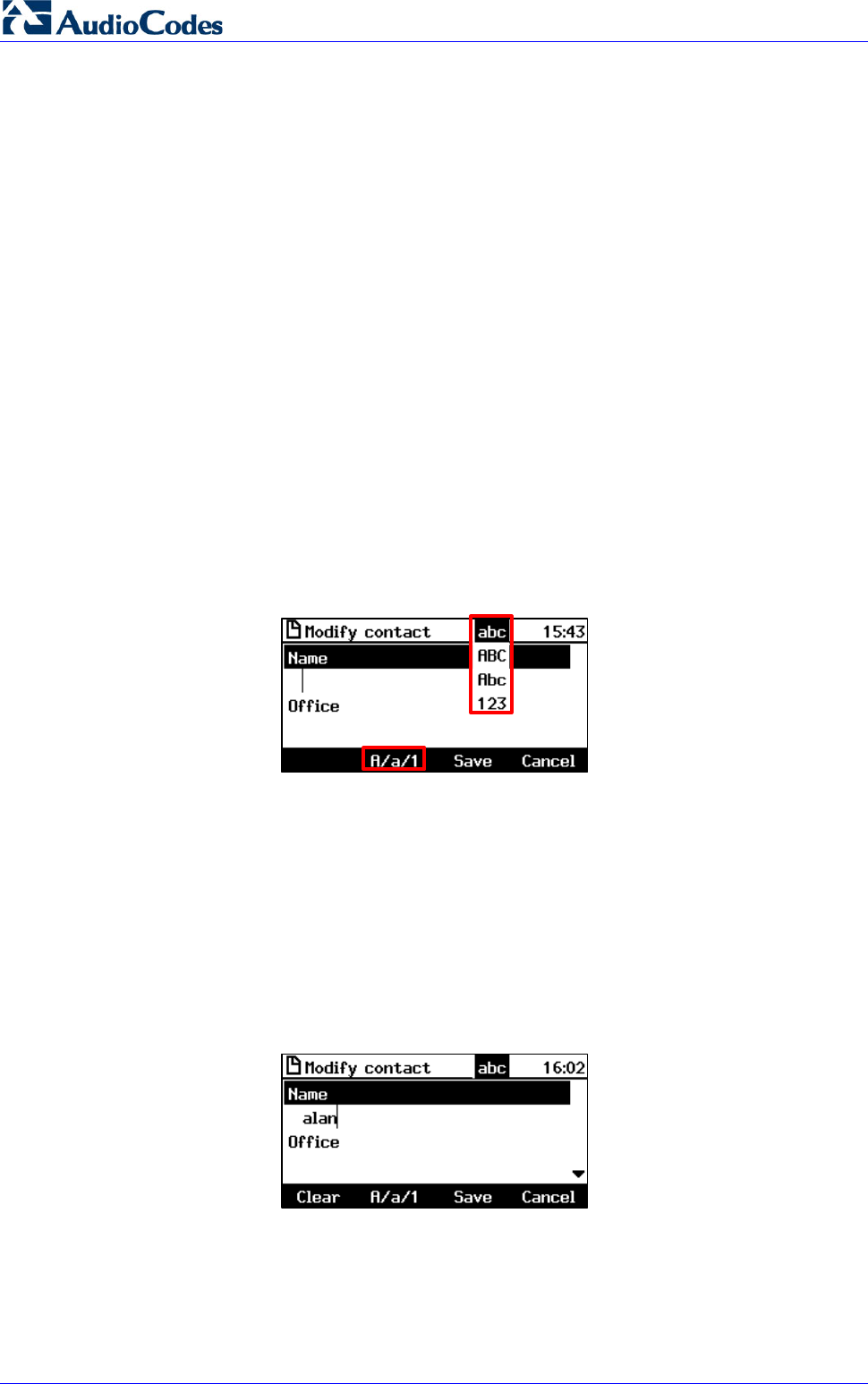
430HD and 440HD IP Phone
User's Manual 22 Document #: LTRT-11939
To access the menus:
Press the MENU key located on the device.
To navigate to menu items:
After opening the menu, press the navigation control button's lower rim -OR- press the menu
item's number, e.g., press 3 to navigate to Keys Configuration.
To select a menu or menu item:
Press the Select softkey or press the navigation control's OK button.
To cancel and move to a previous menu level:
Press the Back softkey.
3.4 Selecting an Alphanumerical Mode
The phone’s keypad allows you to enter alphabetical letters, numbers or symbols, and to switch
from one mode to another.
To select a number, letter or symbol (e.g., lower case letters):
1. When configuring a contact, for example, press the A/a/1 softkey:
Figure 3-3: Alphanumerical Selection
You can also access the mode menu by pressing the # key on the keypad. Press the # key
successively to navigate in the mode menu.
2. From the mode menu, navigate to and select:
• abc = lower case letters
• ABC = upper-case letters
• Abc = first-letter upper case, the rest lower case
• 123 = numerical mode (i.e., numbers)
3. Select abc (for example) and then on the keypad, press the ABC key (for example); a is
entered. Press the JKL key three successive times; l is entered; pressing it once produces j,
twice produces K). Similarly, enter a and n.
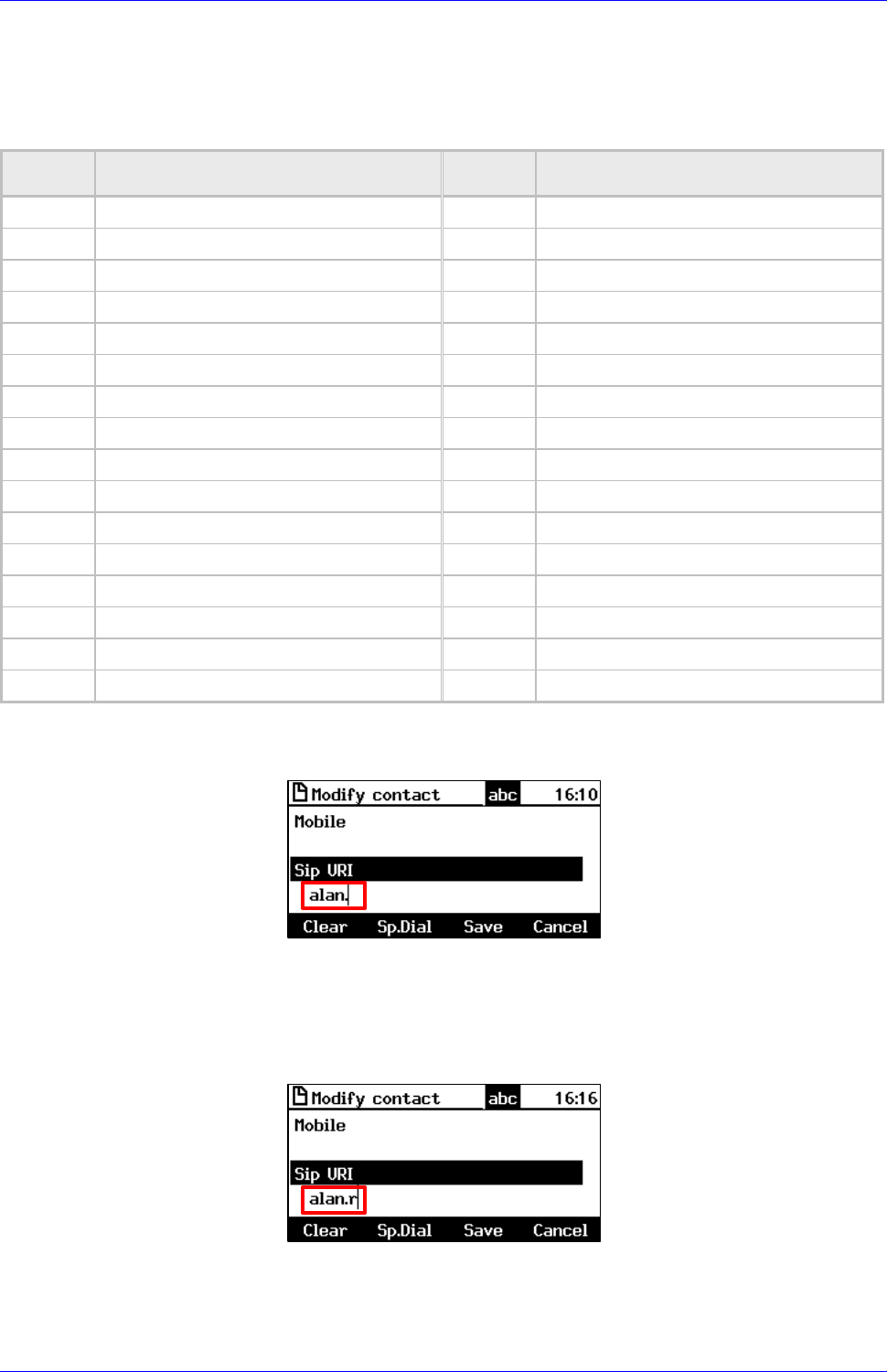
User's Manual Contents
Version 3.0.1 23 430HD and 440HD IP Phone
To enter a symbol (e.g., dot or @ or hyphen):
1. Press the A/a/1 softkey and navigate to abc (mandatory).
2. Press the 1 key on the keypad; a period / full stop is entered. Immediately press the 1 key
again; a backslash is entered. Pressing successively produces the following symbols:
Symbol Explanation Symbol Explanation
. Dot * Star sign
\ Backslash = Equal sign
@ At | Separator
; Semi-colon ( Open parenthesis
: Colon ) Close parenthesis
# Pound { Open parenthesis
$ Dollar } Close parenthesis
% Percentage [ Open square parenthesis
^ Caret ] Close square parenthesis
& Ampersand " Double quotation marks
! Exclamation mark ' Single quotation mark
? Question mark > Greater than
+ Plus < Less than
- Hyphen , Comma
_ Underscore / Forward slash
~ Approximates
Note that the asterisk (*) symbol is entered directly using the star key.
Figure 3-4: Entering a Symbol (e.g., a dot)
To revert to letters (e.g., abc):
Make sure the phone is in abc mode and successively press the PQRS key three times to
produce r (for example):
Figure 3-5: Reverting to Letters (e.g., abc)

430HD and 440HD IP Phone
User's Manual 24 Document #: LTRT-11939
This page is intentionally left blank.
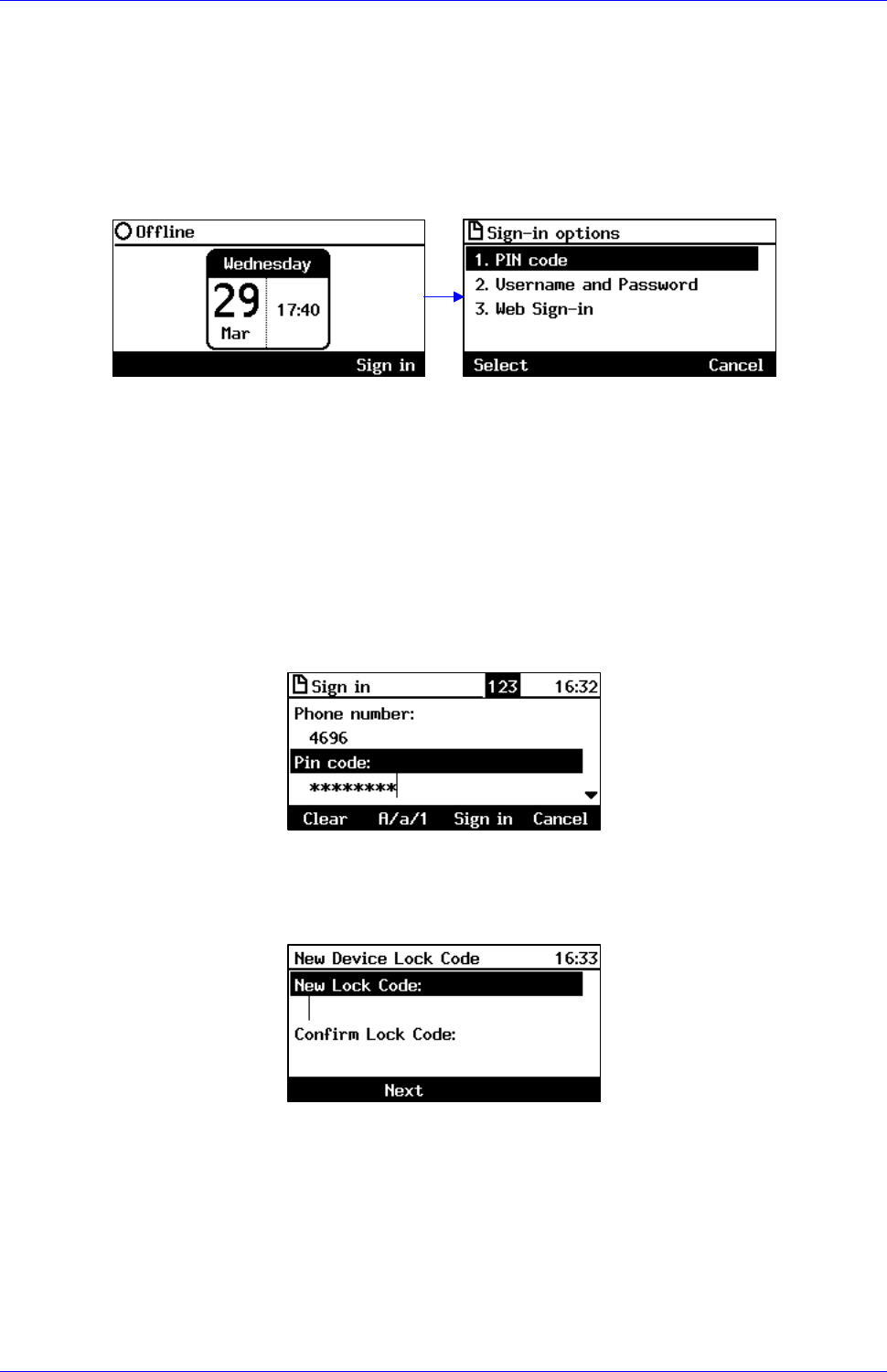
User's Manual Contents
Version 3.0.1 25 430HD and 440HD IP Phone
4 Signing In
This section shows how to sign in to the phone.
To sign in to the phone:
1. In the idle screen, press the Sign in softkey on the device; the sign-in options are displayed:
PIN code - see Section 4.1
User name and Password - see Section 4.2
Web Sign-in - see Section 4.3
4.1 Signing in with PIN Code
This section shows how to sign in with the PIN code and phone number. The PIN code is
provided by your network administrator.
To sign in with the PIN code:
1. In the 'Sign-in options' screen shown above, select the PIN Code option.
2. Enter your phone number and then navigate down with the lower rim of the navigation
control button to enter your PIN code. You can get it from your network administrator. To
switch from numbers to alphabetical letters and symbols, see Section 3.4.
3. Press the Sign in softkey; the Lock Code screen opens (see Section 5 for more information).
4. Enter a lock code and then press the Next softkey or navigate down. Enter the lock code
again to confirm, and then press OK; the phone is signed in and the idle screen is displayed.
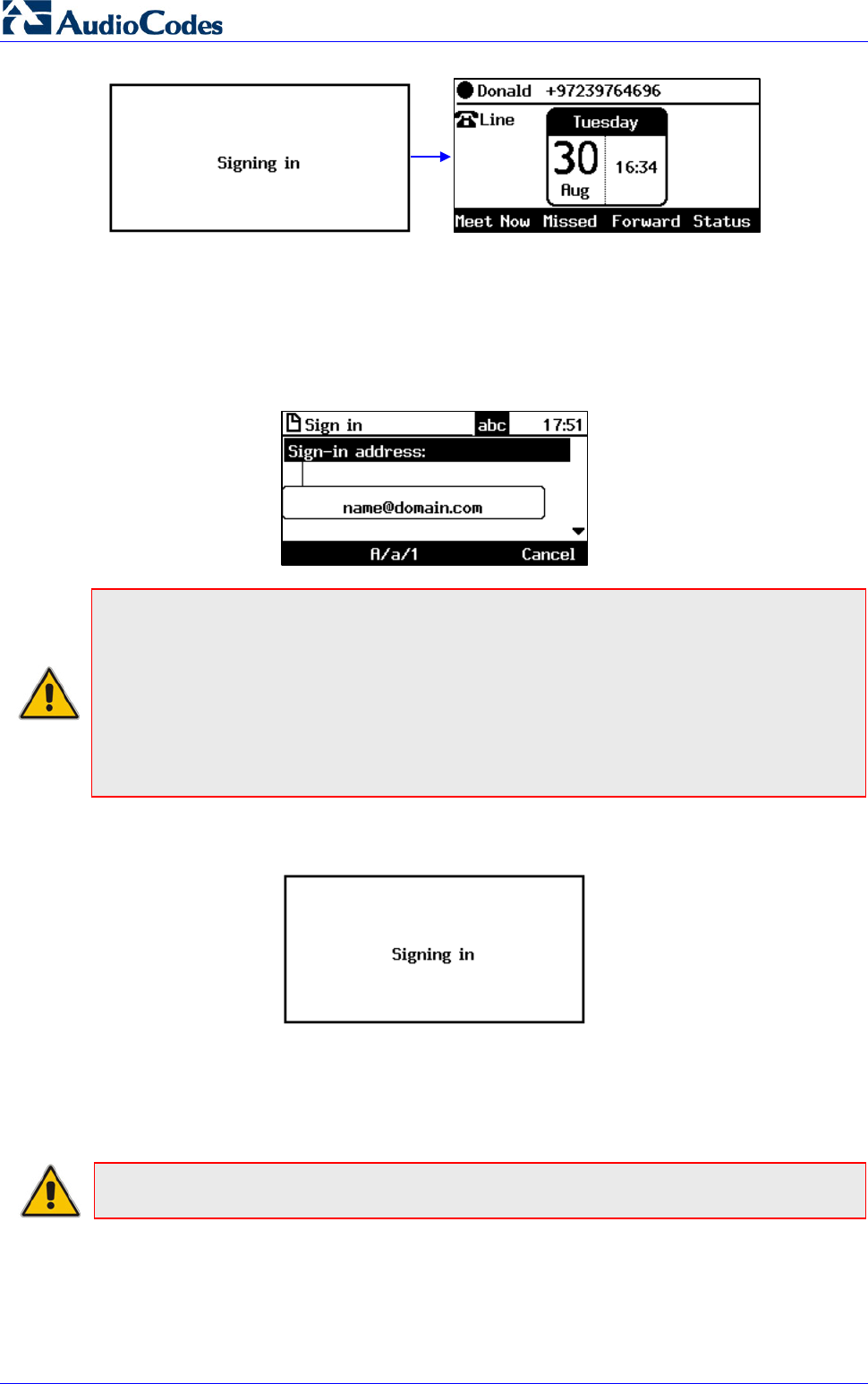
430HD and 440HD IP Phone
User's Manual 26 Document #: LTRT-11939
4.2 Signing in with User Name and Password
This section shows how to sign in with User Name and Password.
To sign in with User Name and Password:
1. In the 'Sign-in options' screen, select User name and Password.
Note: Signing in with a username that is a NetBIOS Domain Name, i.e., domain\username,
or with the PIN Code, are disallowed for Skype for Business online sign-in. They are only
allowed for on-premises sign-in. Online sign-in must be in the following format:
• Sign-in address, i.e., SIP URI. To switch from letters of the alphabet to symbols such as
@, - and period, see Section 3.4.
• User name, in UPN (User Principal Name) format, i.e., the way the user's name appears in
their e-mail address listed in the Active Directory: username@domain.com
• User’s network IT password (the same password you use to access your PC)
2. Press the Sign in softkey that's displayed; after signing in successfully, the New Device Lock
Code screen opens (see under Section 5 for more information).
4.3 Signing in with the Cloud PBX Web Option
You can sign in with the Cloud PBX Web option a.k.a. Device Pairing. Sign-in with this enables
connectivity to Microsoft's Cloud PBX, Microsoft's cloud-hosted version of enterprise voice.
Note: Applies only to Microsoft Cloud PBX users using the 430HD and 440HD phone.
The option exempts users from having to laboriously key in their user name and password using
the phone keypad. A URL and a Pairing Code are then displayed:

User's Manual Contents
Version 3.0.1 27 430HD and 440HD IP Phone
Users must then point their browser to the URL and enter the Pairing Code in the Microsoft web
page. Sign-in to Microsoft's Cloud PBX is then performed.
4.4 Signing Out
This section shows how to sign out.
To sign out:
1. In the idle screen, press the Status softkey.
2. In the Status screen press the Sign out softkey.
You're now signed out. You're returned to the idle screen displaying the Sign in softkey.
Note:
• After signing out, the next time you sign in the phone will present the option that was used
to sign in before signing out.
• If a user signs out and another signs in, the phone presents empty Speed Dials and empty
Call Logs to the newly signed-in user. The Speed Dials and Call Logs of the signed-out
user are not saved on the phone.
4.4.1 Signing out if the 'Sign out' Softkey is Removed from the Screen
Located in lobbies, cafeterias, employee lounges, meeting rooms, and other gathering places,
Common Area phones typically do not display a Sign out softkey in the screen, in line with
network management's decision to remove the capability from users. Users can sign out, if
necessary, using the Web interface.
To sign out using the Web interface:
1. Obtain the Common Area phone's IP address (MENU key > Status > Network Status > IP
Address) and point your Web browser to it; the phone's Web interface login page opens.
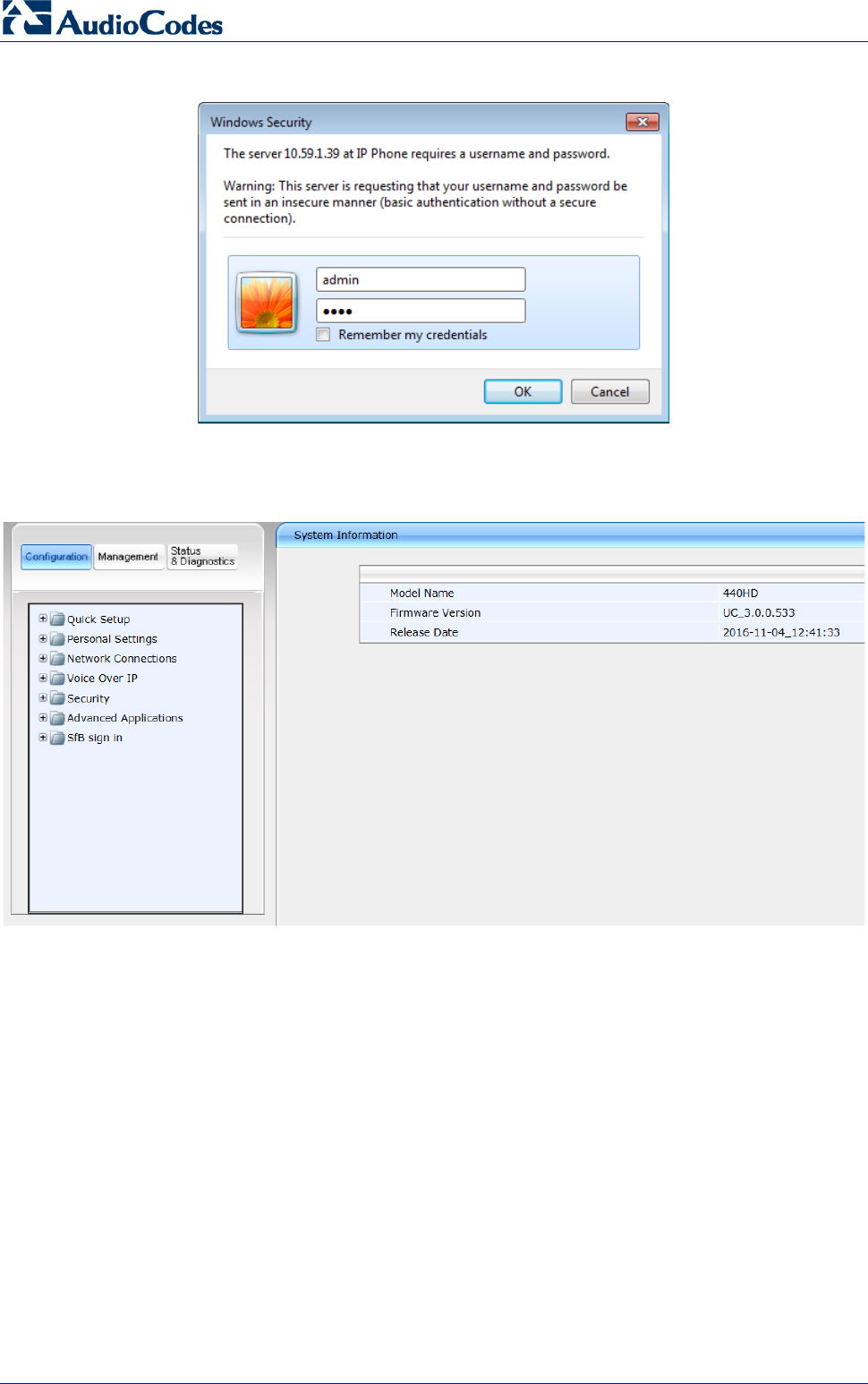
430HD and 440HD IP Phone
User's Manual 28 Document #: LTRT-11939
Figure 4-1: Login
2. Enter the login credentials (default username is admin and default password is 1234); the
Home page of the Web interface is displayed.
Figure 4-2: Web Interface – Home Page
3. In the Web interface, open the Sign-In page (Configuration tab > SfB sign in > Sign in).
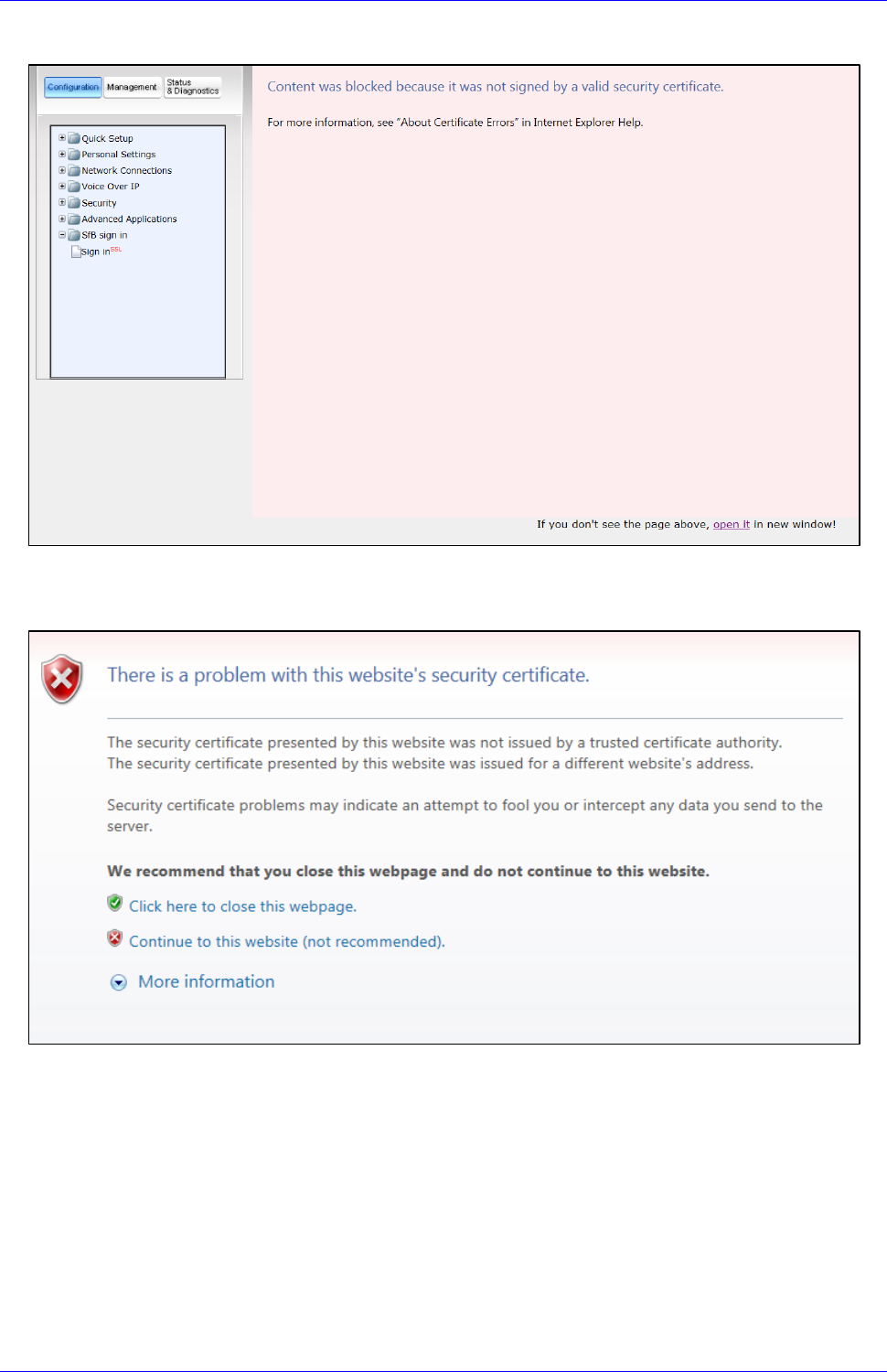
User's Manual Contents
Version 3.0.1 29 430HD and 440HD IP Phone
Figure 4-3: Sign-in – Content Blocked Page
4. Click the open it link and then click Show content.
Figure 4-4: Sign-in – Windows Security Prompt
5. Click the Continue to this website (not recommended) link.
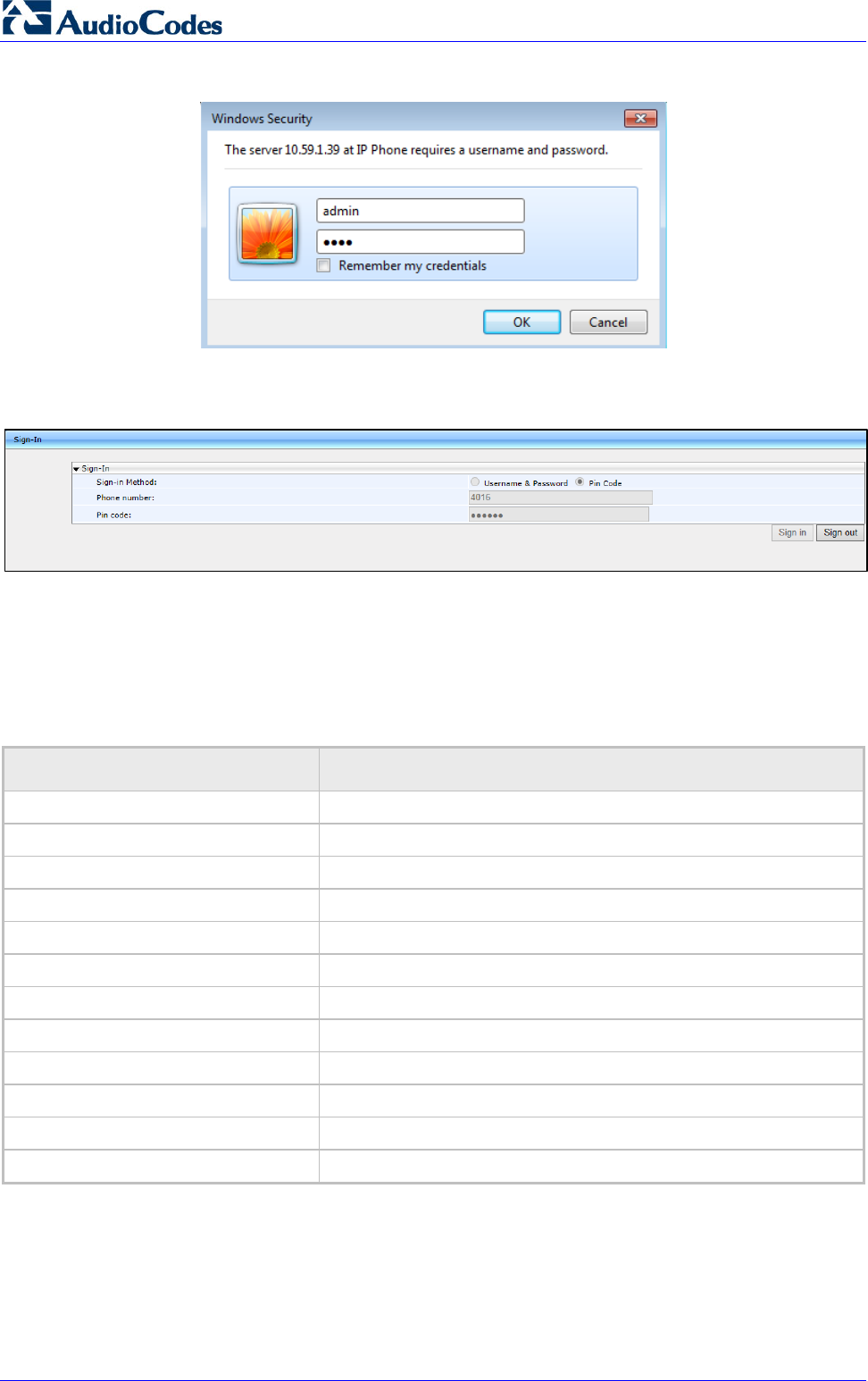
430HD and 440HD IP Phone
User's Manual 30 Document #: LTRT-11939
Figure 4-5: Windows Security Prompt
6. In the Windows Security prompt, enter the username and password and then click OK.
Figure 4-6: Sign-out
7. Click the Sign out button.
4.5 Displayed Messages
Messages indicating processes in progress, displayed in the screen, include:
Table 4-1: Displayed Messages Indicating Processes In Progress
Message Description
Initializing Initializing
Discovering LLDP Discovering VLAN using Link Layer Discovery Protocol (LLDP)
Discovering CDP Discovering VLAN using Cisco Discovery Protocol (CDP) )
Acquiring IP Acquiring an IP address from a DHCP server
Initializing Network Initializing the network
Signing in Signing in to the Skype for Business server
Signing in...Contacting time server Get the time from the NTP server
Discovering SfB server Auto discovering the Skype for Business server on the network
Registering Registering to a SIP proxy server (after booting up the phone)
Downloading Firmware File Downloading a firmware file
Upgrading Firmware Upgrading the phone’s firmware
Signing out Signing out of the Skype for Business server
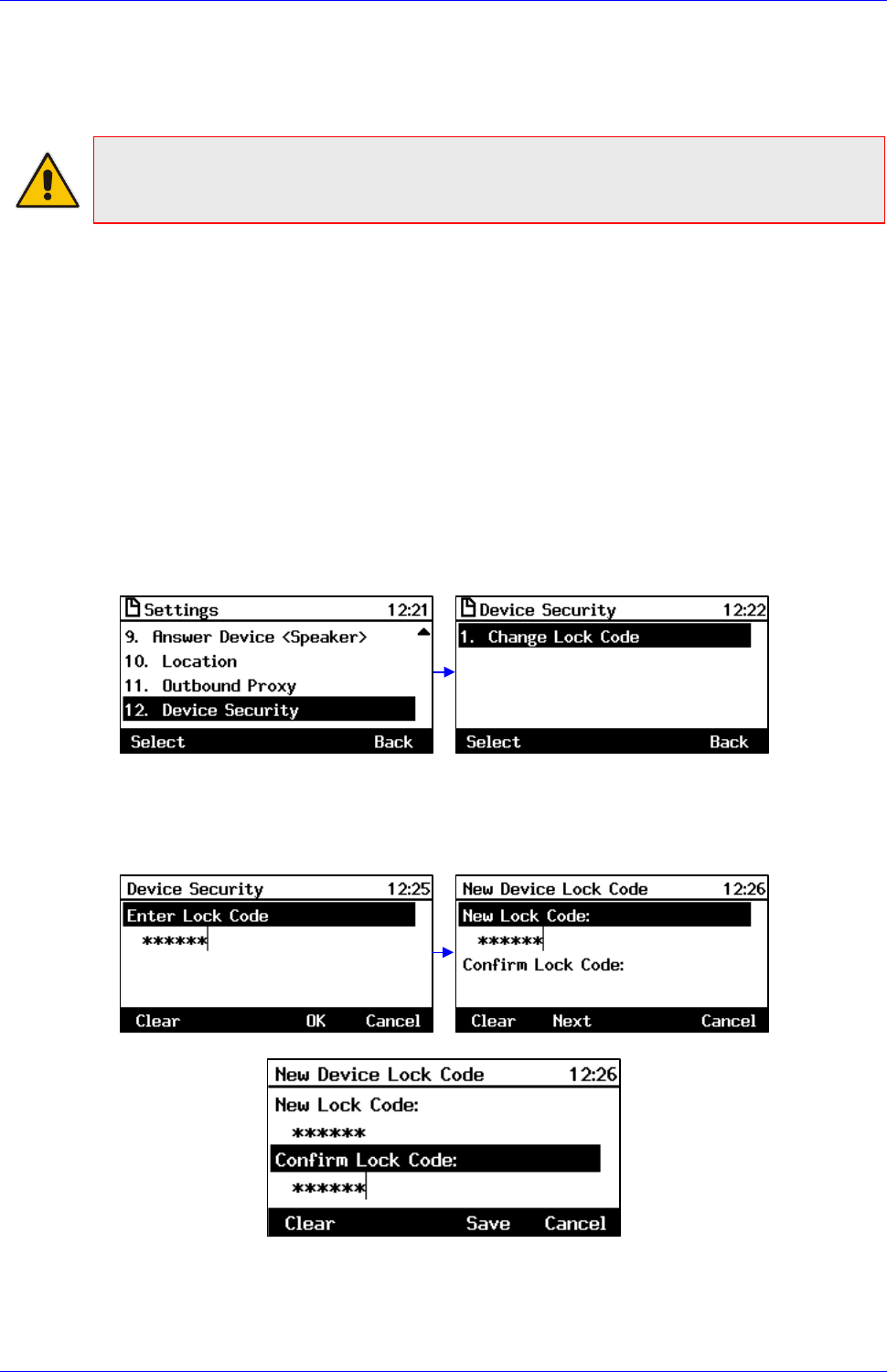
User's Manual Contents
Version 3.0.1 31 430HD and 440HD IP Phone
5 Unlocking a Locked Phone
Note: For the automatic locking feature to be available to users, the administrator must first
enable it in the Skype for Business server and Web interface. See the Administrator's Manual
for details.
The phone supports the capability to automatically lock after a configured period of time. The
feature secures phones against unwanted (mis)use. If left untouched for 10 minutes (default), the
phone automatically locks and is inaccessible to anyone who doesn't know its lock code.
After a phone locks:
Incoming calls are allowed, but outgoing calls need the lock code.
Without the lock code, users cannot access the Call Log, Calendar and Corporate directory,
but they can call preconfigured emergency numbers.
When signing in for the first time, the user is prompted for a lock code. After entering a code, e.g.,
123456, confirming it, and saving it, the phone goes into idle state, and after 10 minutes it is
automatically locked.
To manually change the lock code:
1. Press the MENU key on the phone, select Settings and then scroll down to select Device
Security.
2. In the Device Security screen that opens, select Change Lock Code, enter the old code,
click OK, then when prompted for the new code, enter it, press the Next softkey or scroll
down, and then confirm by reentering the code.
3. Press the Save softkey; if left untouched for 10 minutes (default), the phone will
automatically lock.
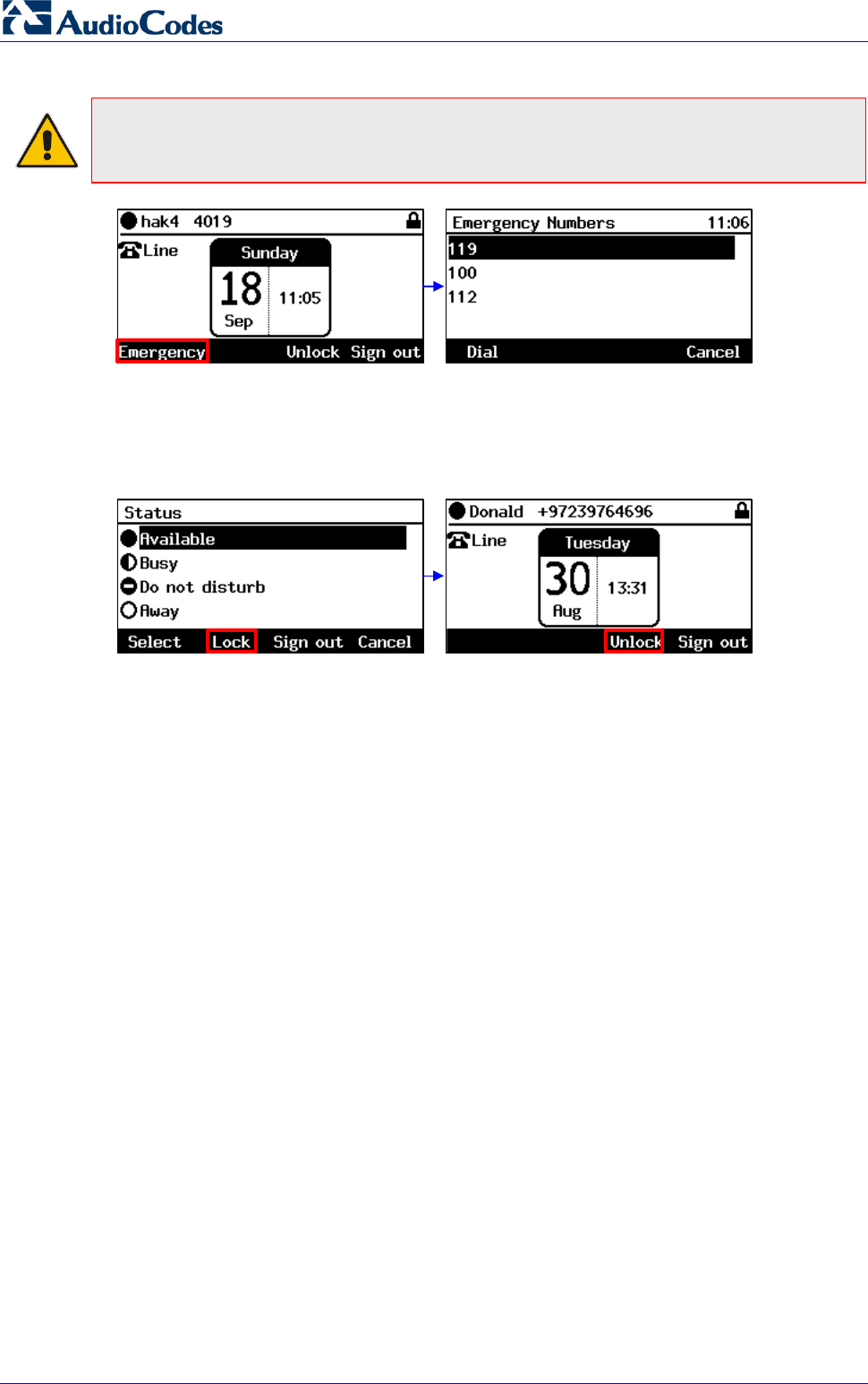
430HD and 440HD IP Phone
User's Manual 32 Document #: LTRT-11939
Note: Emergency numbers (police, ambulance service, firefighting service, etc.) will still be
available and dialable in the event the phone locks via a new Emergency softkey that is
displayed after the lock takes effect.
To manually lock a phone:
You can manually lock a phone at any time you choose.
When the phone is idle, press the Status softkey and then press the Lock softkey that is
displayed; the phone locks and an Unlock softkey is displayed in the idle screen.
To unlock a phone that's been locked:
You can unlock a phone that's been locked only if you know the lock code.
In the idle screen, press the Unlock softkey, enter the lock code that was entered as
described under Section 5, and then press the OK softkey.
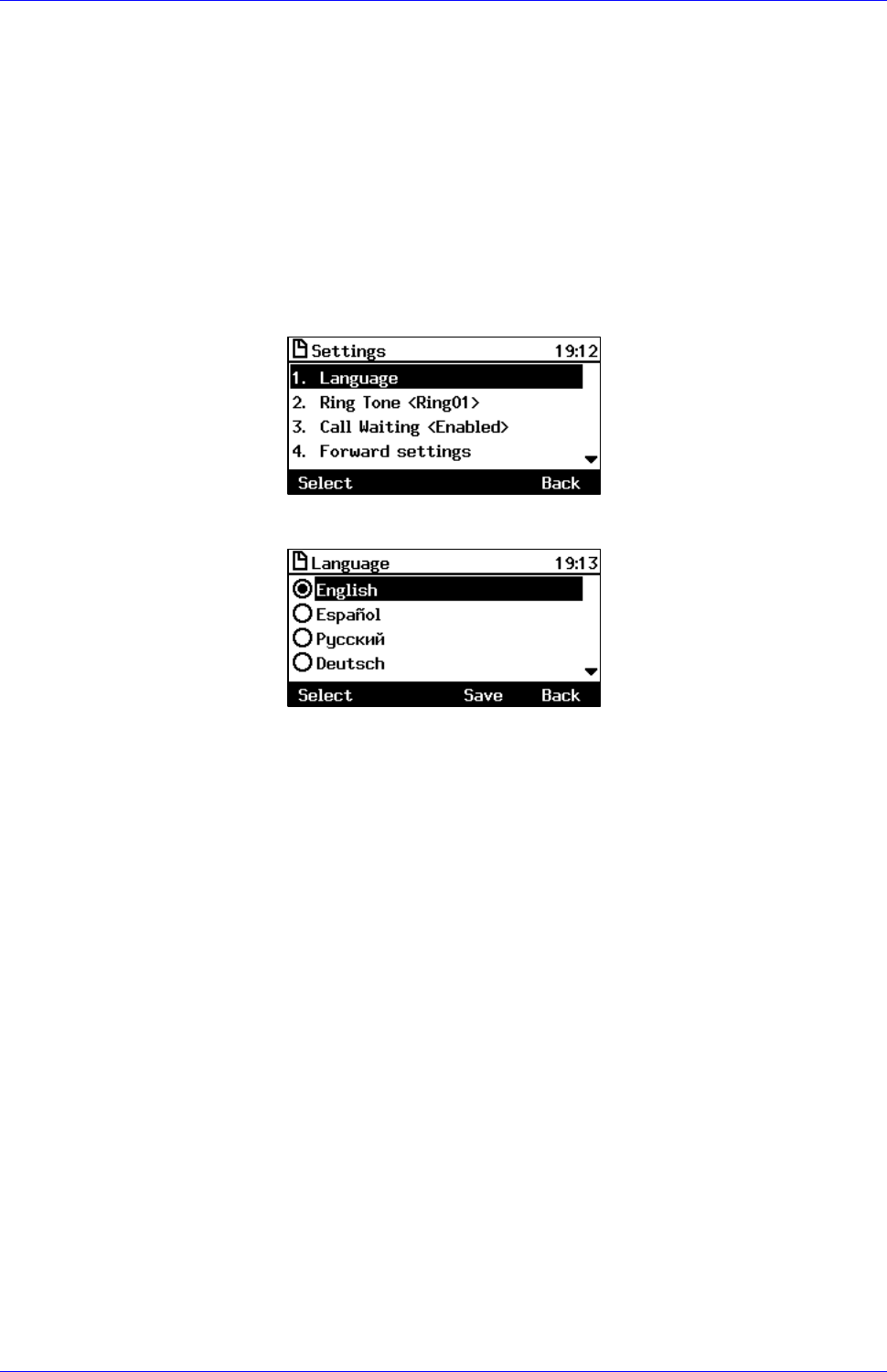
User's Manual Contents
Version 3.0.1 33 430HD and 440HD IP Phone
6 Customizing Your Phone
This section shows you how to customize your phone for enhanced usability.
6.1 Changing the Screen Language
The phone screen supports multiple languages. English is the default but you can change it to
another.
To change the default:
1. Access the Languages screen (MENU key > Settings > Language).
2. Navigate to the language you require.
3. Press the Select softkey to select it.
4. Press the Save softkey to save the setting.
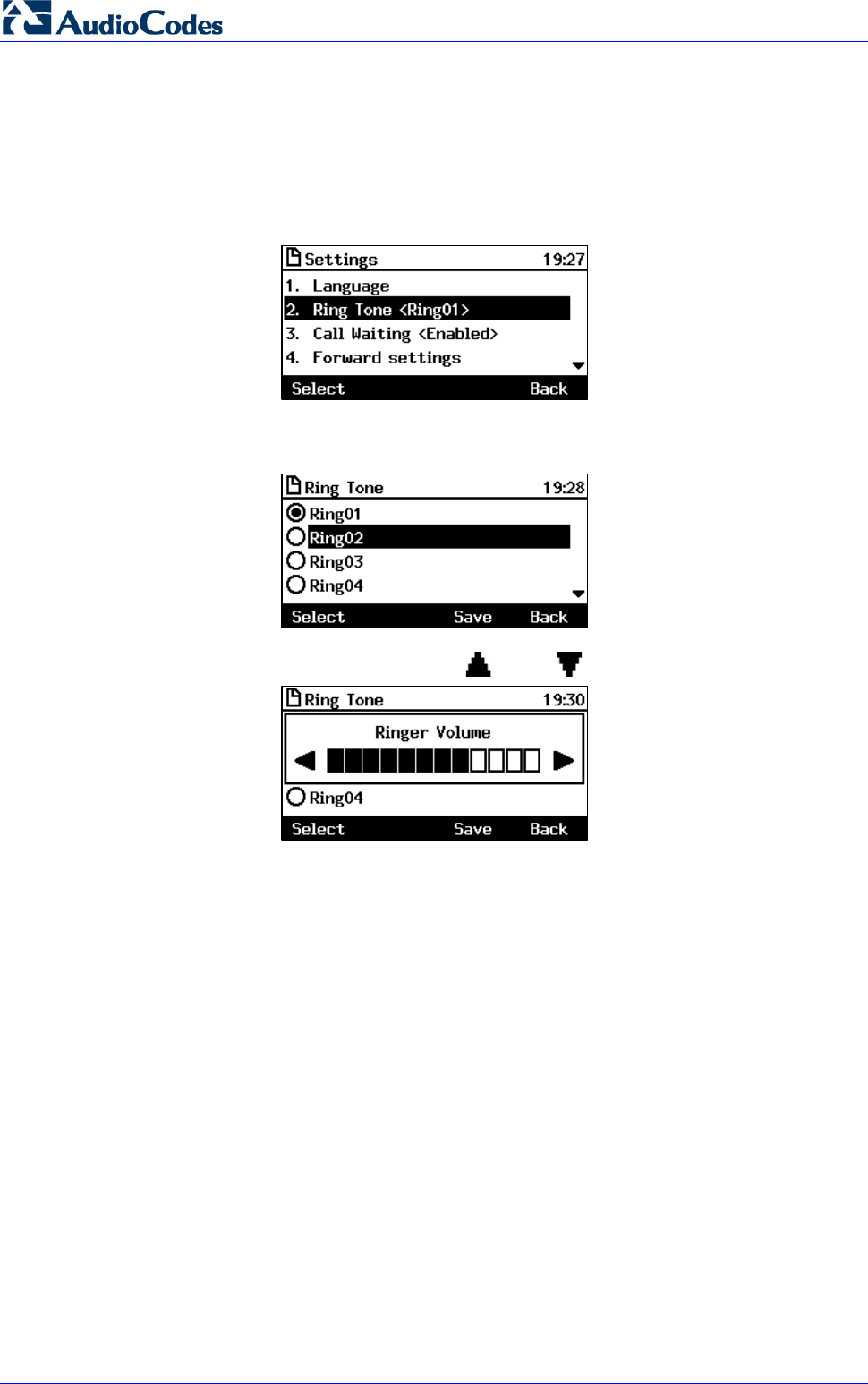
430HD and 440HD IP Phone
User's Manual 34 Document #: LTRT-11939
6.2 Selecting Ring Tone
You can choose from a selection of ring tones to indicate incoming calls .
To select a ring tone:
1. Access the Ring Tone screen (MENU key > Settings > Ring Tone).
2. Navigate to and select a ring tone. A sample of each ring tone is played as you navigate
through the list.
3. Set ring tone volume by pressing the VOL or VOL
key:
A few seconds after adjusting the volume level the Ringer Volume indication is hidden.
4. Press the Select softkey to apply your settings.
5. Press the Save softkey to save your settings.
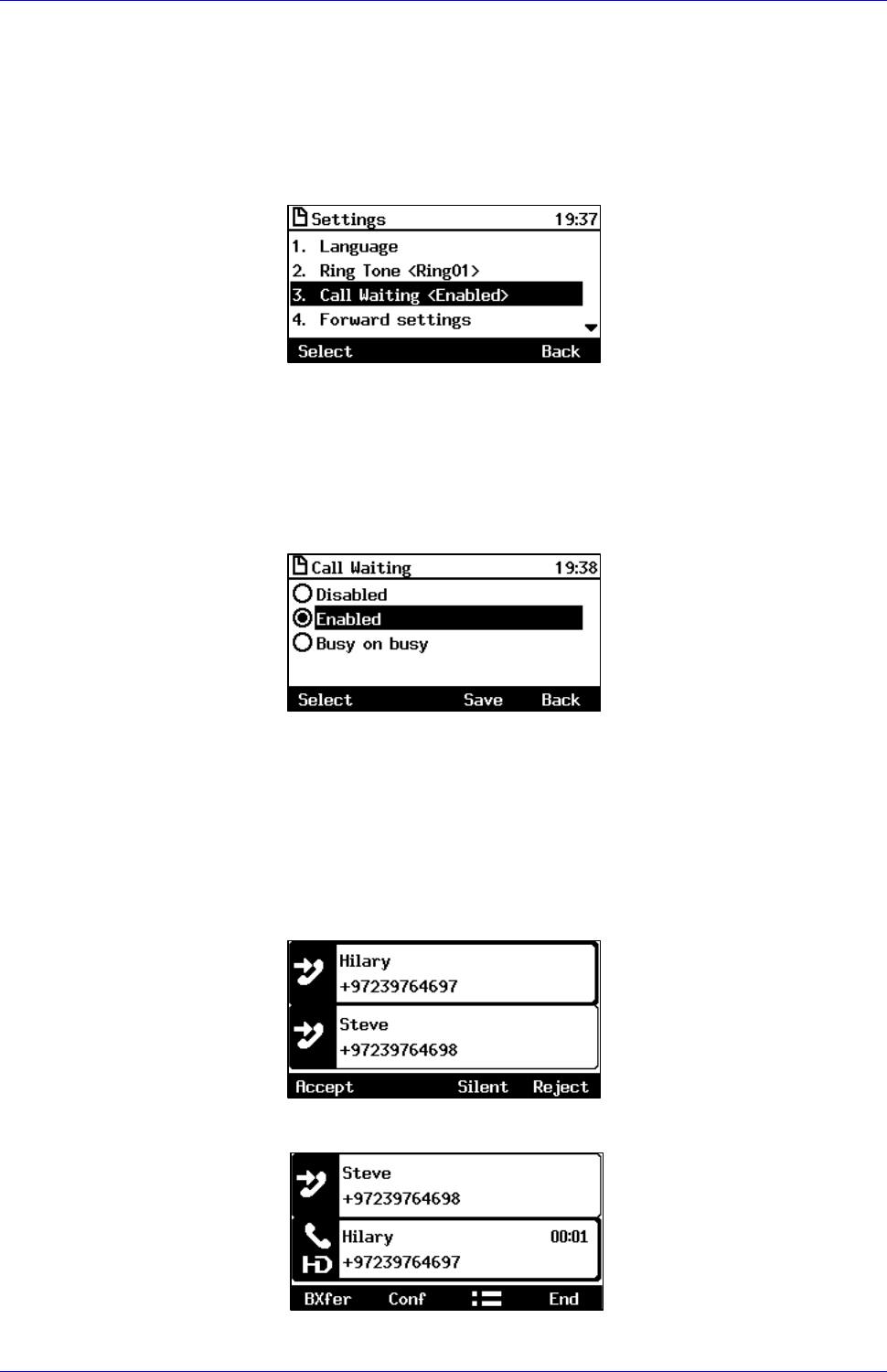
User's Manual Contents
Version 3.0.1 35 430HD and 440HD IP Phone
6.3 Enabling Call Waiting
You can enable or disable the call waiting feature.
To enable or disable call waiting:
1. Access the Call Waiting screen (MENU key > Settings > Call Waiting).
2. Navigate to and select:
• Disable (disables call waiting)
-OR-
• Enable (enables call waiting)
-OR-
• Busy on Busy (see Section 6.4.1 below)
3. Press the Select softkey to apply your settings.
4. Press the Save softkey to save your settings.
6.4 Managing Simultaneous Incoming Calls
If two calls simultaneously come in on a phone, or if a user is in a call and a third party calls, the
phone's screen displays them in a graphically user-friendly way.
Simultaneous incoming calls; both calling parties flash:
When one of the incoming calls is answered:
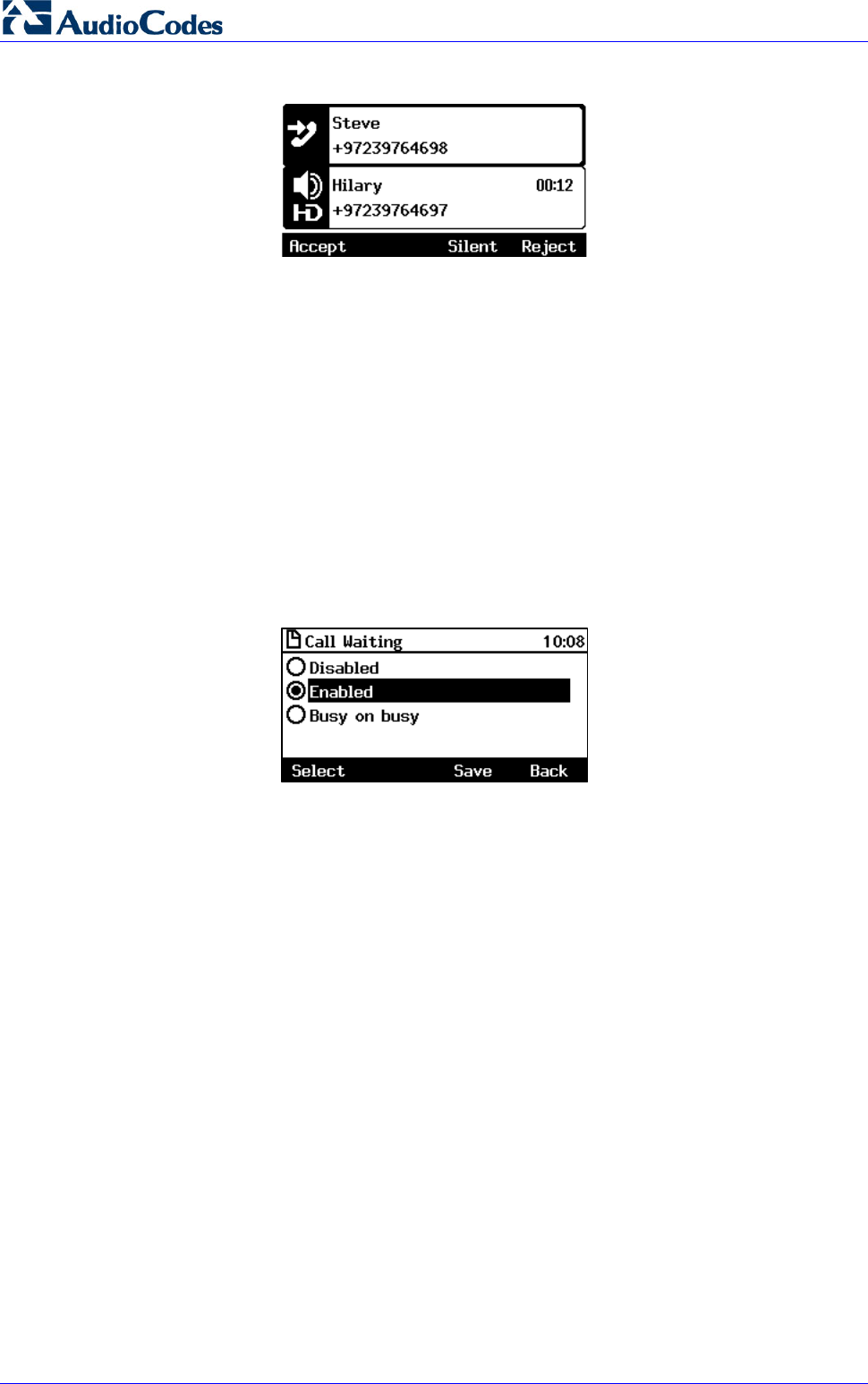
430HD and 440HD IP Phone
User's Manual 36 Document #: LTRT-11939
When a phone is in a call and another comes in:
Additional visual indications on the device:
The LED of the Programmable Key that is configured as an extension flashes red when a
call comes in on that extension
The LED of the Programmable Key that is configured as an extension is illuminated green
after a call that comes in on that extension is answered
The Ring LED in the upper right corner of the device flashes blue when a call comes in
6.4.1 Configuring Busy on Busy
If you're already in an active call on either the IP phone or Skype for Business client and a call
comes in, the Busy on Busy feature rejects the coming call and plays a busy signal to the caller.
To configure Busy on Busy:
1. Access the Call Waiting screen (MENU key > Settings > Call Waiting).
2. Select the Busy on Busy option.
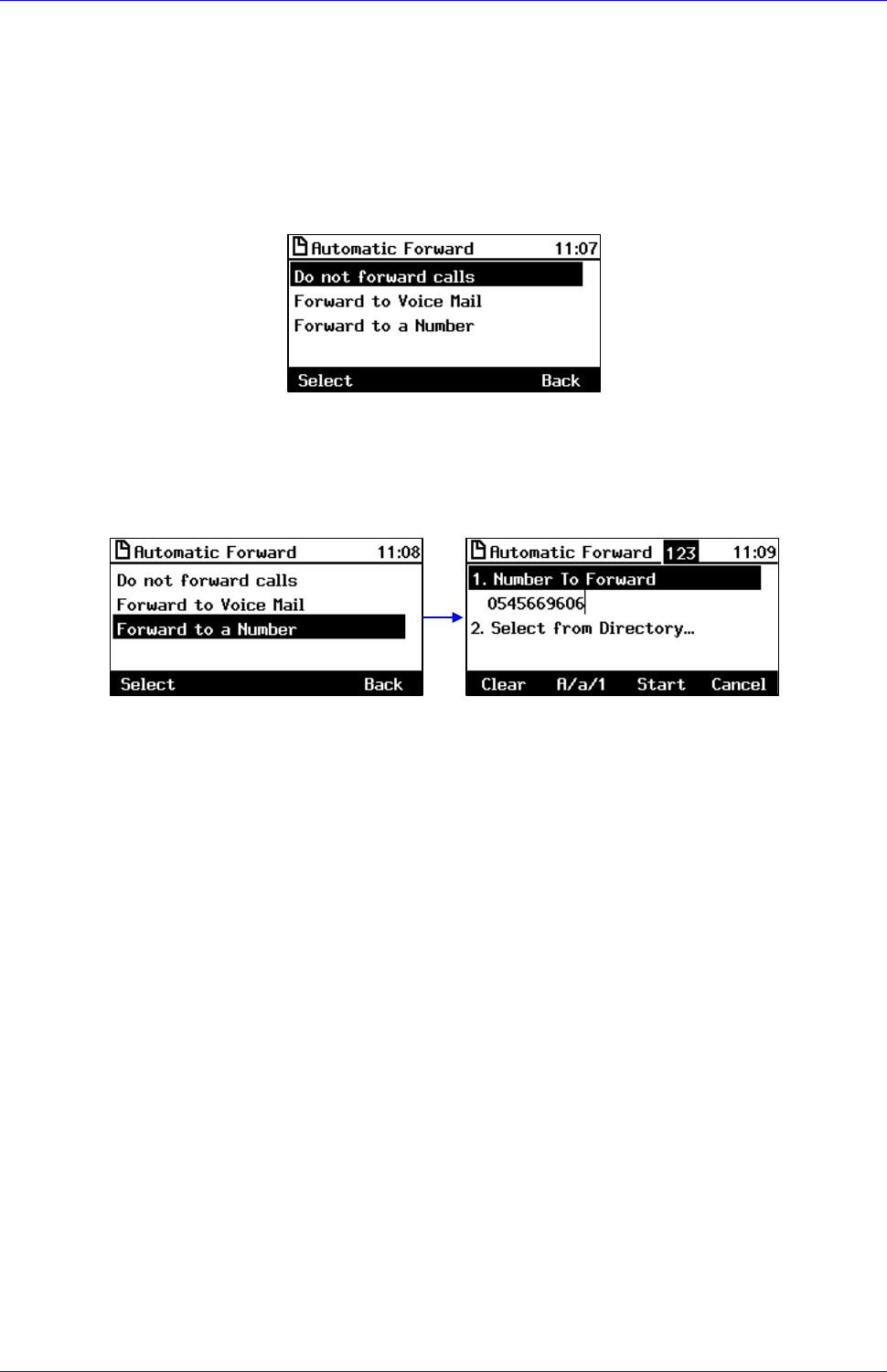
User's Manual Contents
Version 3.0.1 37 430HD and 440HD IP Phone
6.5 Defining Call Forwarding
This feature enables you to automatically redirect an incoming call to another phone number if a
user-defined condition is met, e.g., if the line is busy.
To define call forwarding:
1. Access the Automatic Forward screen (MENU key > Settings > Forward settings -or-
press the Forward softkey when the screen is in idle state):
2. To forward to voicemail: In the Automatic Forward screen, navigate to Forward to Voice
Mail and press the Select softkey; you're returned to the idle screen; calls will be
automatically forwarded to your voicemail.
3. To forward to a number: In the Automatic Forward screen, navigate to Forward to a
Number and press the Select softkey:
4. Enter the number and press the Start softkey; you're returned to the idle screen; calls will be
automatically forwarded to the number.
To deactivate call forwarding:
When the screen is in idle state press the Forward softkey and in the Automatic Forward
screen, select Do not forward calls.
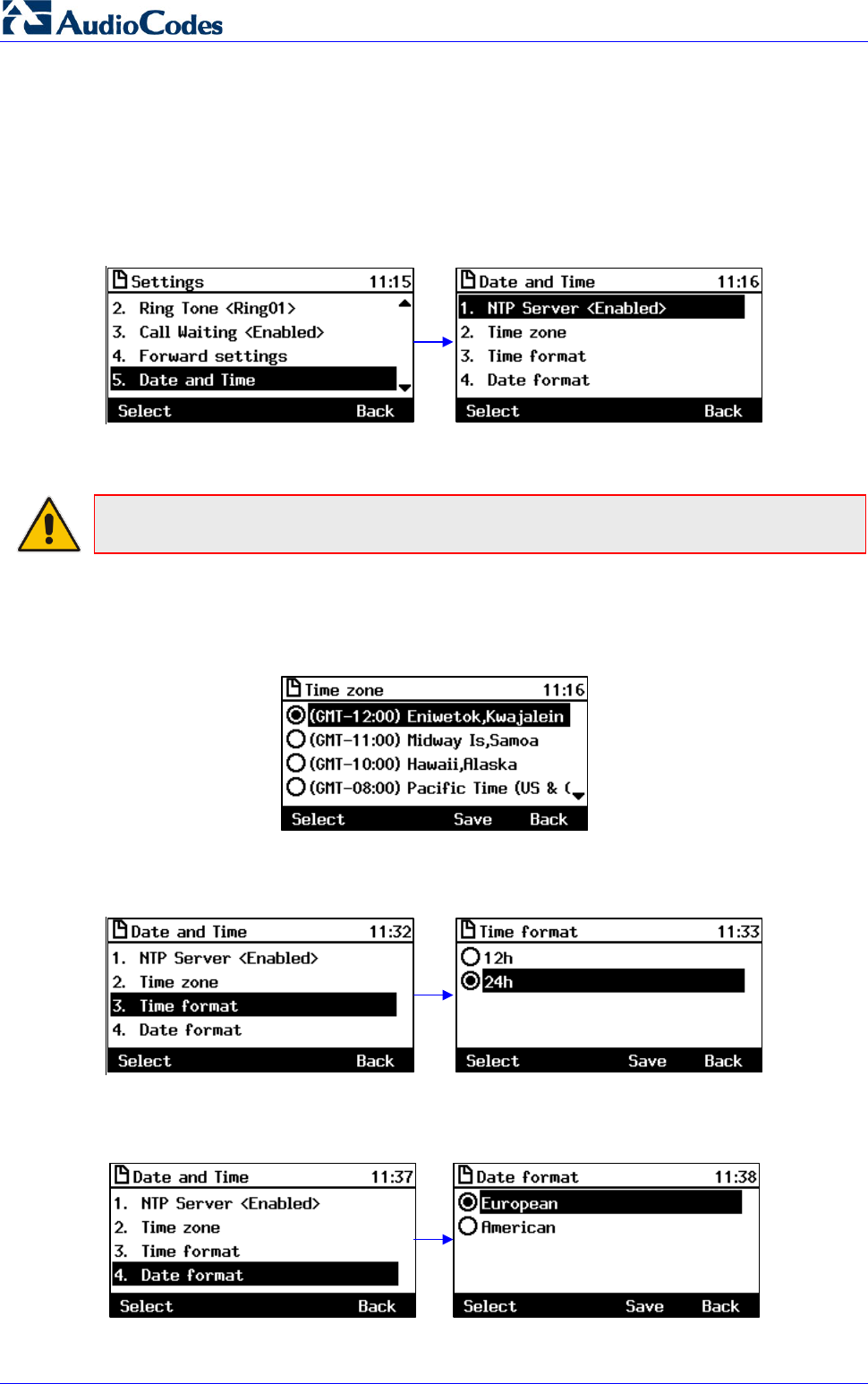
430HD and 440HD IP Phone
User's Manual 38 Document #: LTRT-11939
6.6 Setting Date and Time
Date and time is automatically retrieved from the deployed Network Time Protocol (NTP) server,
enabled by your administrator.
To enable the NTP server:
1. Access the Date and Time screen (MENU key > Settings > Date and Time).
2. If not already 'Enabled', notify your network administrator.
Note: To configure the NTP server, see the Administrator’s Manual.
To configure the time zone:
1. Navigate to and select the Time zone option and then select the time zone relevant to your
geographical location. See Table 6-1 for a list of all Time Zone options.
To configure the time format:
Navigate to and select the Time format option and then select the format of your choice.
To configure the date format:
Navigate to and select the Date Format option and select the format of your choice.

User's Manual Contents
Version 3.0.1 39 430HD and 440HD IP Phone
Table 6-1: Time Zones
Time Zone Place
(GMT-12:00) Eniwetok, Kwajalein
(GMT-11:00) Midway Is, Samoa
(GMT-10:00) Hawaii, Alaska
(GMT-08:00) Pacific Time (US & Canada
(GMT-07:00) Chihuahua, Mazatlan, Mountain Time (US & Canada
(GMT-06:00) Central Time (US & Canada
(GMT-05:00) Eastern Time (US & Canada
(GMT-04:00) Atlantic Time (Canada
(GMT-03:30) Newfoundland, Buenos Aires, Georgetown, Brasilia, Greenland
(GMT-03:00) Buenos Aires, Georgetown, Brasilia, Greenland
(GMT-02:00) Mid-Atlantic
(GMT-01:00) Azores, Cape Verde Is
(GMT 00:00) Greenwich Mean Time: Dublin, Edinburgh, Lisbon, London, Casablanca, Monrovia
(GMT+01:00) Amsterdam, West Central Africa, Madrid, Paris, Vilnius, Berlin, Bern, Rome, Vienna, Prague
(GMT+02:00) Cairo, Jerusalem, Bucharest, Helsinki, Riga, Tallinn, Athens, Istanbul, Minsk, Harare, Pretoria
(GMT+03:00) Kuwait, Riyadh, Nairobi, Baghdad, Moscow, St. Petersburg, Volgograd
(GMT+03:30) Tehran
(GMT+04:00) Abu Dhabi, Muscat, Baku, Tbilisi, Kabul
(GMT+05:00) Islamabad, Karachi, Tashkent, Yekaterinburg
(GMT+05:30) Bombay, Calcutta, Madras, New Delhi
(GMT+05:45) Kathmandu
(GMT+06:00) Almaty, Dhaka, Colombo, Almaty, Novosibirsk
(GMT+06:30) Rangoon
(GMT+07:00) Bangkok, Hanoi, Jakarta, Krasnoyarsk
(GMT+08:00) Beijing, Chongqing, Hong Kong, Urumqi, Perth, Singapore, Taipei, Irkutsk, Ulaan Bataar
(GMT+09:00) Osaka, Sapporo, Tokyo, Seoul, Yakutsk
(GMT+09:30) Darwin, Adelaide
(GMT+10:00) Canberra, Melbourne, Sydney, Brisbane, Guam, Port Moresby, Hobart, Vladivostok
(GMT+11:00) Magadan, Solomon Is, New Caledonia
(GMT+12:00) Fiji, Kamchatka, Marshall Is, Auckland, Wellington
(GMT+13:00) Nuku'alofa
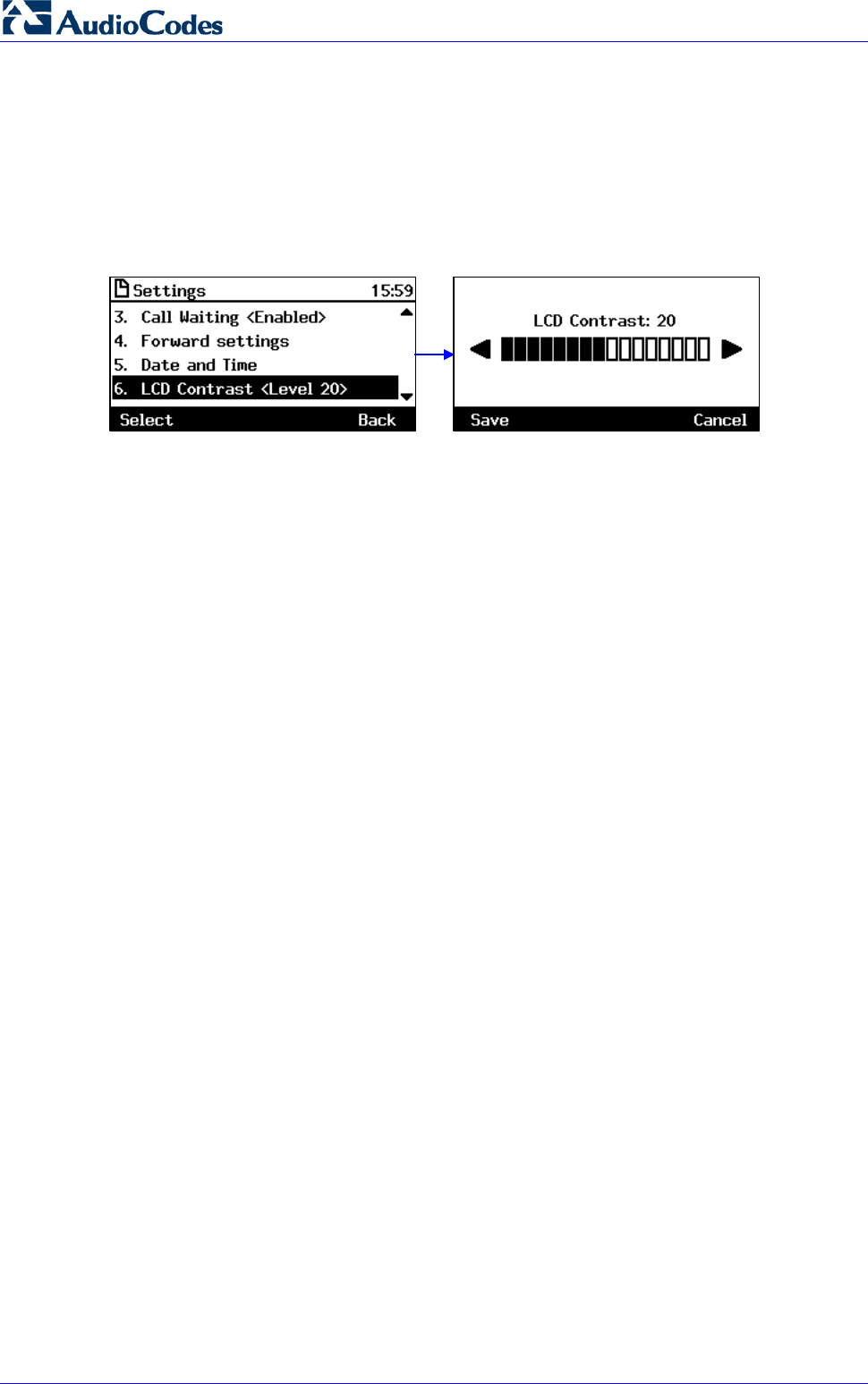
430HD and 440HD IP Phone
User's Manual 40 Document #: LTRT-11939
6.7 Changing Screen Contrast Level
The phone's screen supports 36 different contrast levels. The range is 0-35. The default is 14.
You can choose the level that suits you best.
To define the screen's contrast level:
1. Access the LCD Contrast submenu (MENU key > Settings > LCD Contrast).
2. Press the navigation control's left or right rim to navigate to the contrast level that suits you
best.
3. Press the Save softkey to apply your settings.
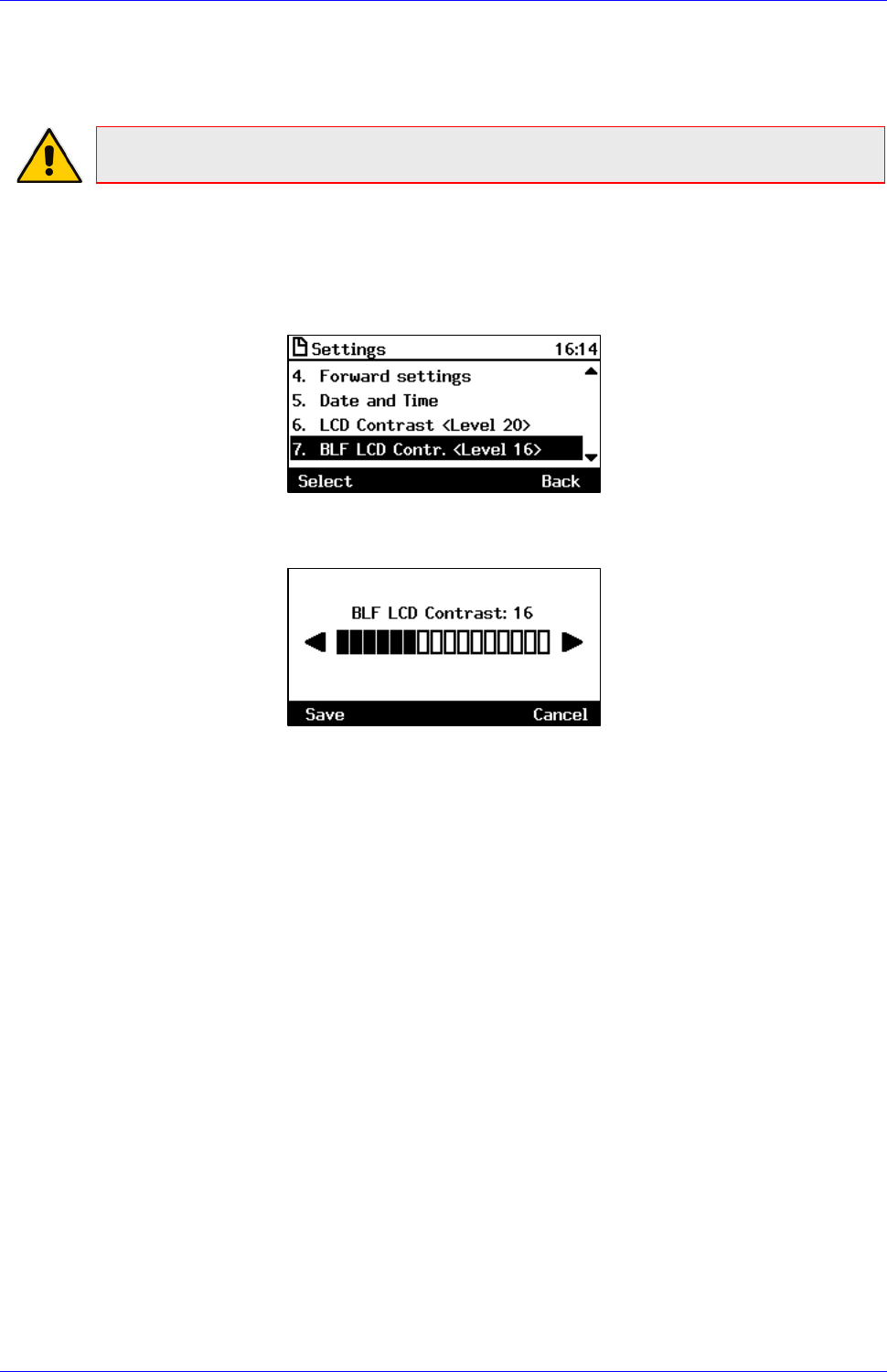
User's Manual Contents
Version 3.0.1 41 430HD and 440HD IP Phone
6.8 Defining BLF LCD Contrast
Note: Applies only to the 440HD IP Phone.
The BLF LCD supports 40 different contrast levels. The range is 0-39. The default is 16. You can
choose the level that suits you best.
To define the BLF LCD’s contrast level:
1. Access the BLF LCD Contrast submenu (MENU key > Settings > BLF LCD Contr.).
2. Press the navigation control's left or right rim to navigate to the contrast level that suits you
best.
3. Press the Save softkey to apply your settings.
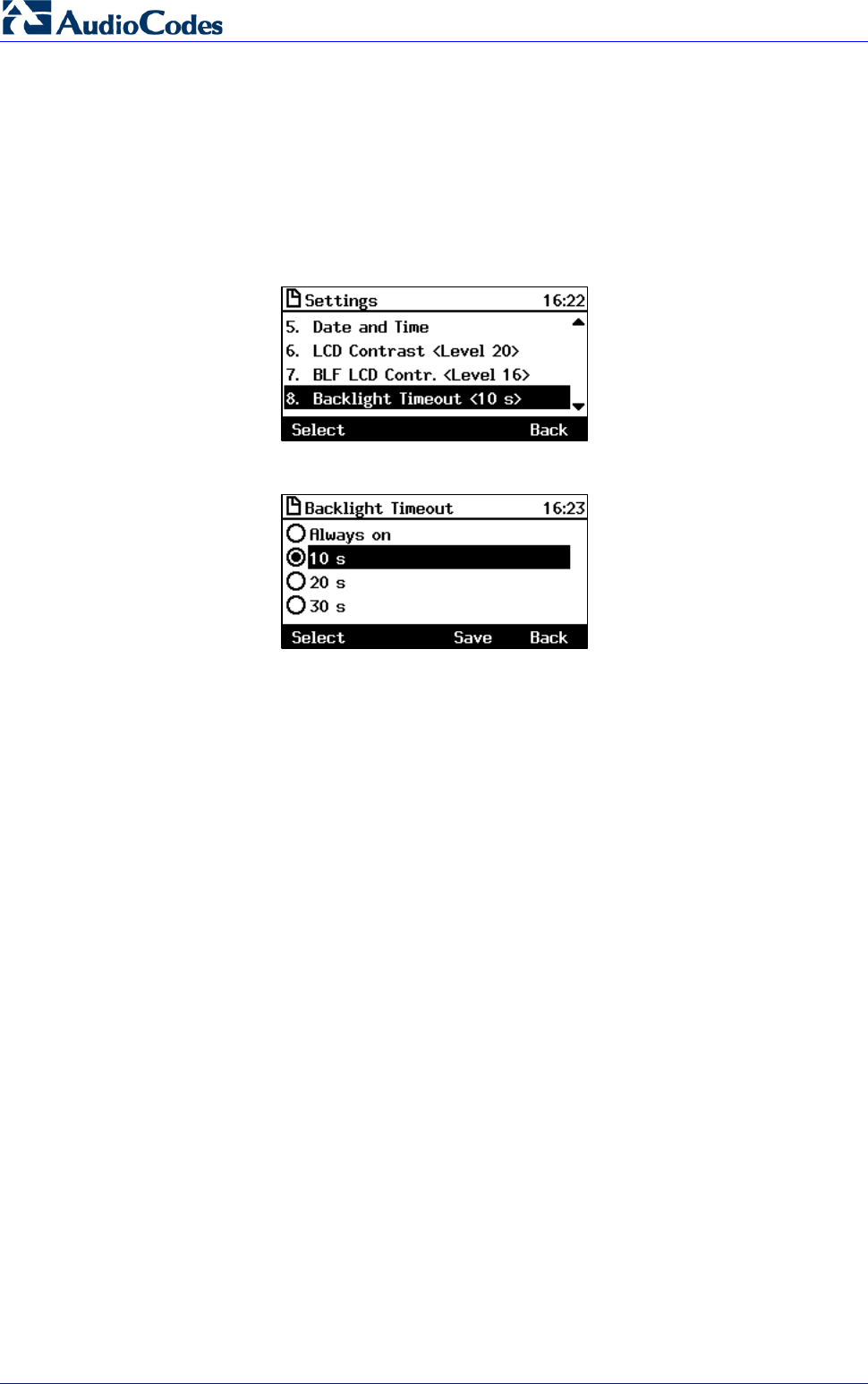
430HD and 440HD IP Phone
User's Manual 42 Document #: LTRT-11939
6.9 Defining Screen's Backlight Timeout
You can define how long the phone’s backlight will stay on when the phone is idle. When this
duration times out, the backlight switches off. For the backlight to never time out, you can select
the Always on option. The default is 10 seconds.
To define screen backlight timeout:
1. Access the Backlight Timeout screen (MENU key > Settings > Backlight Timeout).
2. Navigate to and select Always on or 10 / 20 / 30 / 40 / 50 / 60 seconds).
3. Press the Select softkey to apply your settings.
4. Press the Save softkey to save your settings.
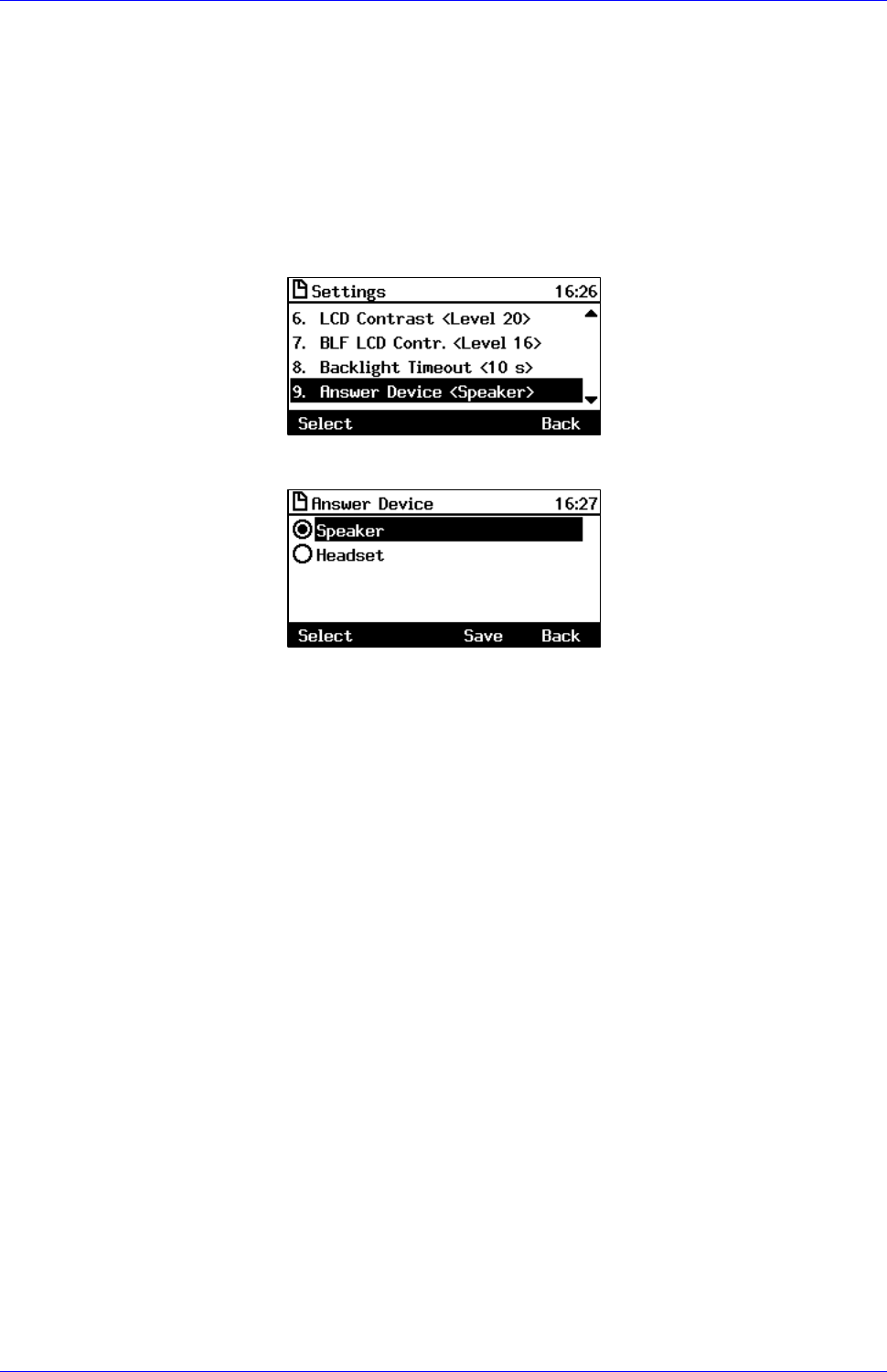
User's Manual Contents
Version 3.0.1 43 430HD and 440HD IP Phone
6.10 Selecting an Answering Device
You can select which audio device (speaker or headset) is activated when you answer calls (by
pressing the Accept softkey or lifting the handset) or when you dial calls (by pressing the number
keys on the keypad and then pressing the Dial softkey).
The default device is the speaker.
To select the answering device:
1. Access the Answer Device screen (MENU key > Settings > Answer Device).
2. Navigate to and select the device (Speaker or Headset) and press the Select softkey.
3. Press the Save softkey.
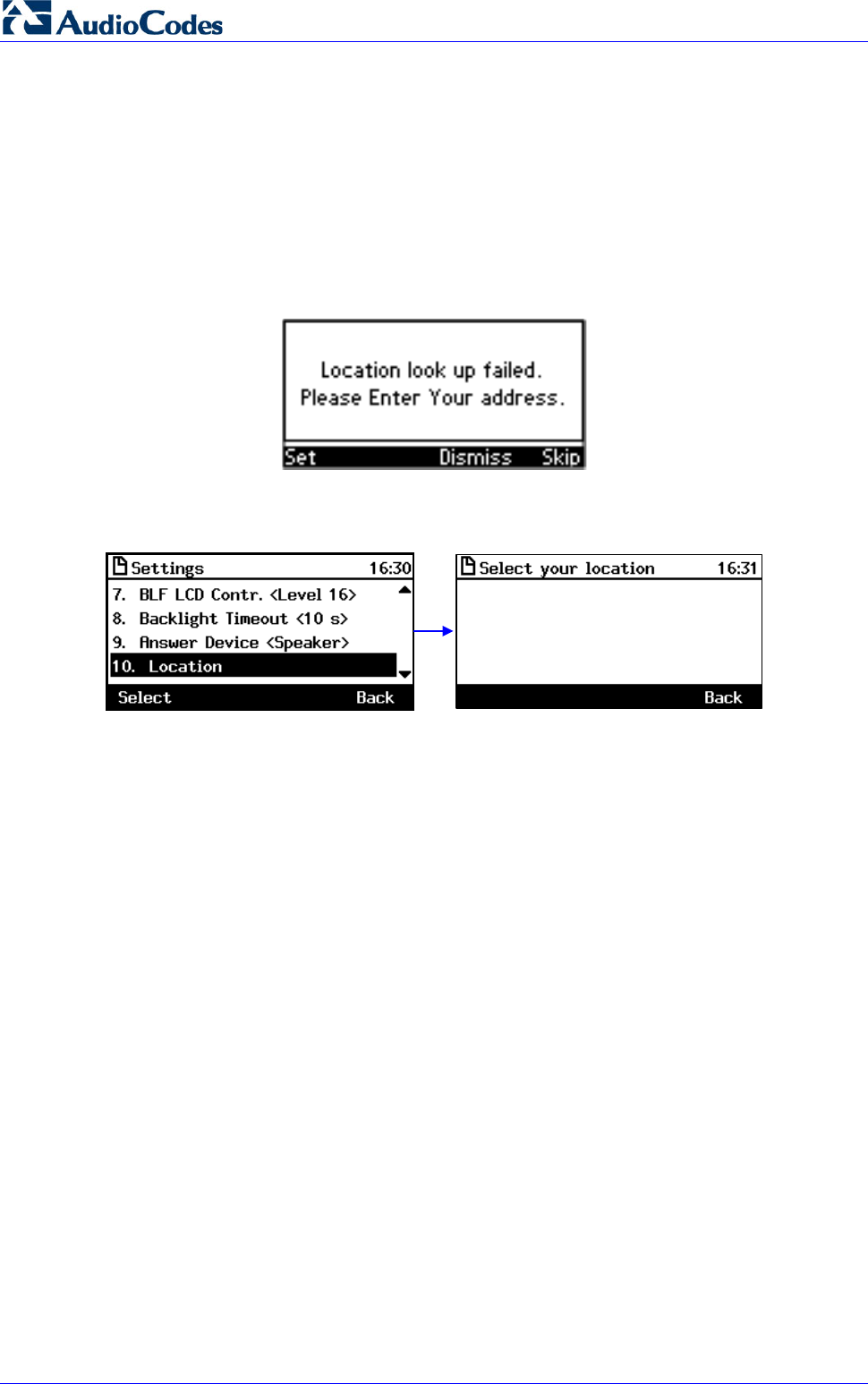
430HD and 440HD IP Phone
User's Manual 44 Document #: LTRT-11939
6.11 Defining Location
This feature enables the called party to identify the geographical location of the calling party. For
example, if a caller in the U.S. makes an emergency call to E911, the feature extracts the caller's
information for the police department to immediately identify the caller's location.
The network administrator configures geographical location for each subnet (see the
Administrator's Manual). After you sign in, your geographical location is downloaded via inband
provisioning. If geographical location is not provisioned by the server, a popup opens in the
phone's screen enabling users to either Set the location manually, Skip (the popup closes but
pops up every few hours), or Dismiss ('kills' the popup).
To manually set location:
Access the Location screen (MENU key > Settings > Location).

User's Manual Contents
Version 3.0.1 45 430HD and 440HD IP Phone
6.12 Defining an Outbound Proxy
Skype for Business Server Multitenant Hosting Pack is a Microsoft® Unified Communications
(UC) hosting solution for telecommunications and hosting providers. The solution enables
Microsoft hosting partners to deploy a single instance of the Skype for Business Server software
to securely and economically host multiple tenants with a rich, fully integrated UC solution.
To connect AudioCodes' Skype for Business-compatible phone to a hosted Lync environment
(LHP), a dedicated 'Out0062ound Proxy' parameter is available which is used to configure the
hosted service provider's domain name (FQDN).
Note: In hosted environments, it's common practice that this hosted domain name is different
to the enterprise's domain name. Refer also to 400HD Series IP Phones for Skype for
Business Hosting Partner (LHPv2) Environment Configuration Note.
To configure a phone for an LHP environment, configure the address of the Outbound Proxy as
the hosted service provider's domain name (FQDN).
To configure the address of the Outbound Proxy:
1. Open the Outbound Proxy screen (MENU key > Settings > Outbound Proxy).
2. Press the right rim of the navigation control to set the 'Use Hosted Proxy' field to Enabled.
3. In the 'Proxy Address' field enter the hosted service provider's domain name (FQDN).
4. Navigate down to the 'Port' field, configure it (default = 0), and then press the Save softkey.
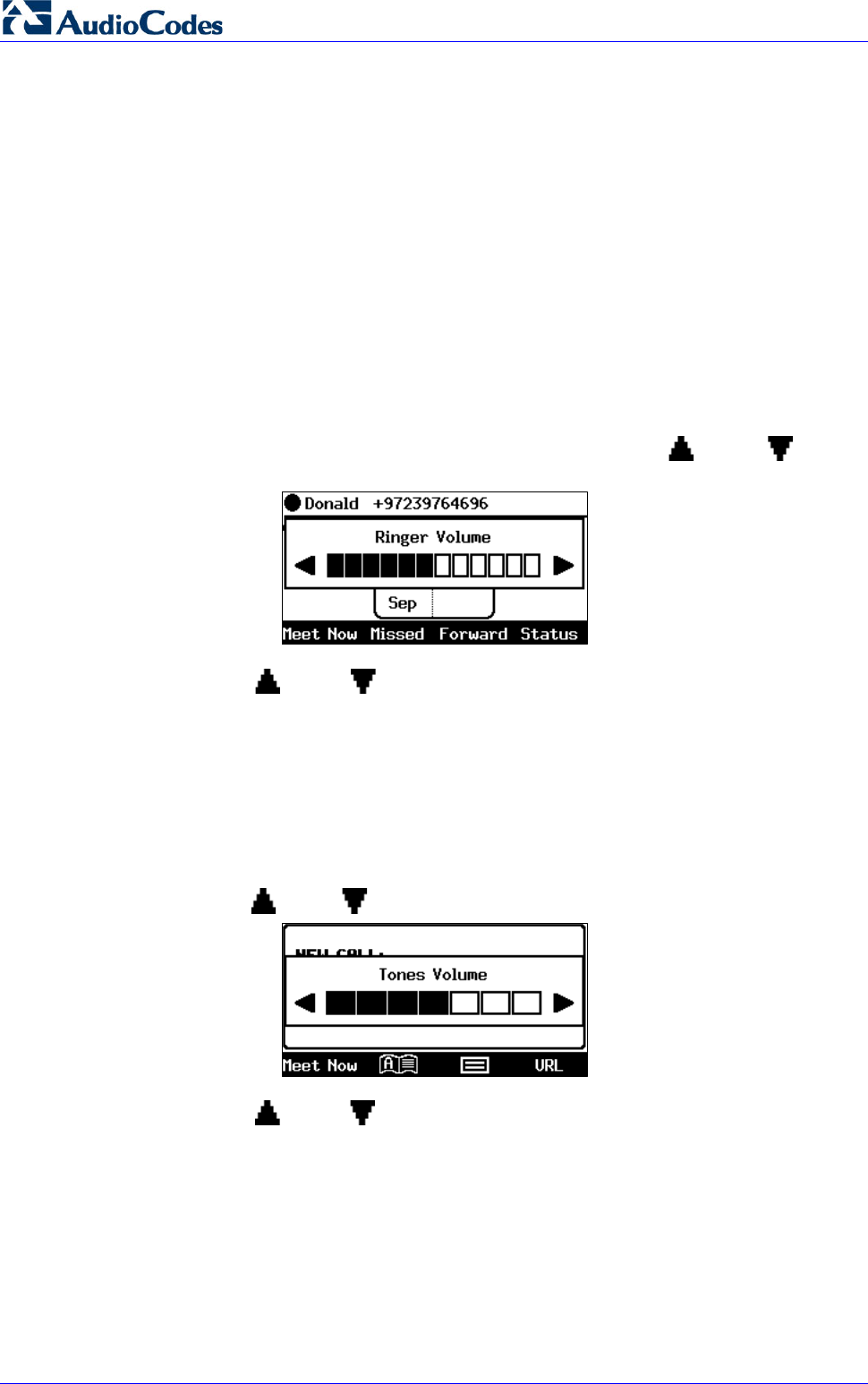
430HD and 440HD IP Phone
User's Manual 46 Document #: LTRT-11939
6.13 Adjusting Volume
You can adjust the volume of the phone's:
Ring
Tones (e.g., dial tone)
Handset
Speakerphone
Headset
6.13.1 Adjusting Ring Volume
You can adjust the volume of the ring indicating an incoming call.
To adjust ring volume:
1. When the phone is in idle state (i.e., not in use), press the VOL or VOL
key; the
Ringer Volume bar is displayed on the screen:
2. Press the VOL or VOL key on the keypad to adjust the volume. After adjusting, the
Ringer Volume level disappears from the screen.
6.13.2 Adjusting Tones Volume
You can adjust the phone tones, including dial tone, ring-back tone and all other call progress
tones.
To adjust tones volume:
1. Off-hook the phone (using handset, speaker or headset).
2. Press the VOL or VOL keyboard key; the Tones Volume bar displays on the screen:
3. Press the VOL or VOL key to adjust the volume. After adjusting, the Tones Volume
bar disappears from the screen.
6.13.3 Adjusting Handset Volume
The volume of the handset can be adjusted during a call or when making a call. The newly
adjusted level applies to all subsequent handset use.
To adjust handset volume:
1. During a call or when making a call ensure that the handset is off the cradle.
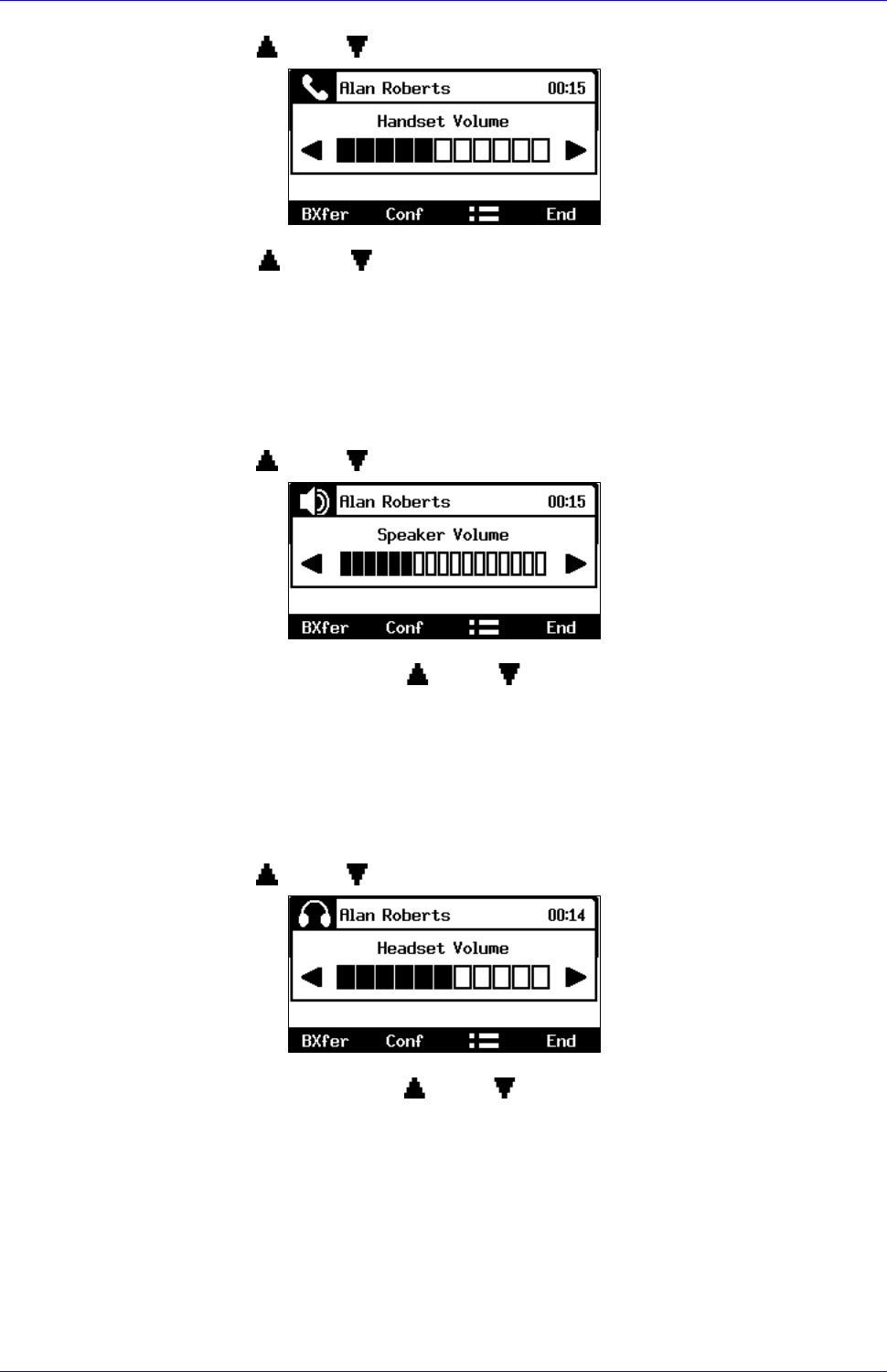
User's Manual Contents
Version 3.0.1 47 430HD and 440HD IP Phone
2. Press the VOL or VOL key; the Handset Volume bar is displayed on the screen.
3. Press the VOL or VOL key on the keyboard. After adjusting, the Handset Volume bar
disappears from the screen.
6.13.4 Adjusting Speaker Volume
The volume of the speakerphone can only be adjusted during a call.
To adjust the speakerphone volume:
1. During a call, press the SPEAKER key.
2. Press the VOL or VOL key; the Speaker Volume bar is displayed on the screen.
3. Adjust the volume using the VOL or VOL key. After you have completed adjusting the
volume, the Speaker Volume bar disappears from the screen.
6.13.5 Adjusting Headset Volume
The volume of the headset can only be adjusted during a call.
To adjust the headset volume:
1. During a call, press the HEADSET key.
2. Press the VOL or VOL key; the Headset Volume bar is displayed on the screen.
3. Adjust the volume using the VOL or VOL key.
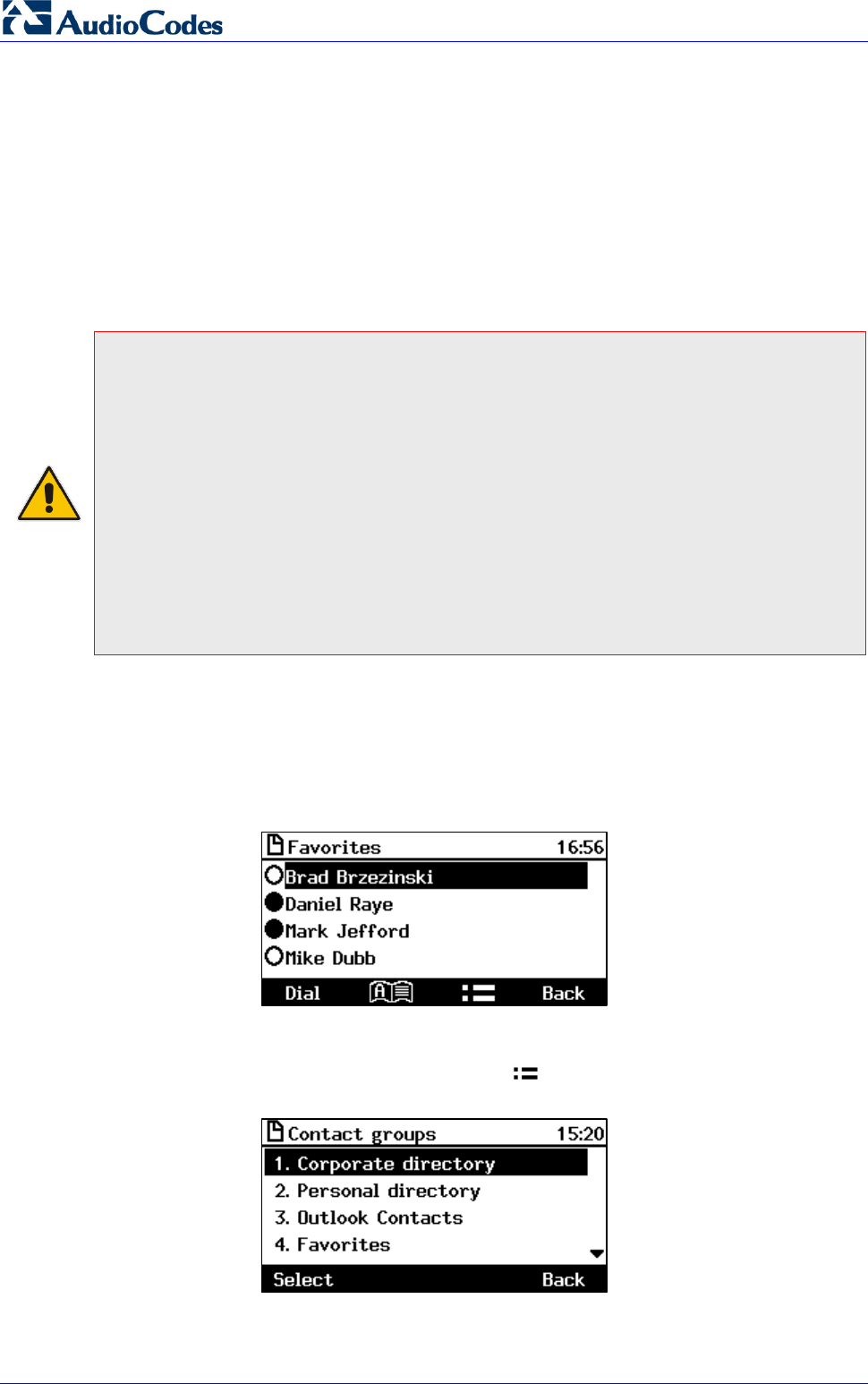
430HD and 440HD IP Phone
User's Manual 48 Document #: LTRT-11939
6.14 Managing Phone Directories
The phone supports a number of directories:
Favorites (integrated with Skype for Business client)
Corporate directory
Personal directory
Outlook Contacts
Others
Note:
• You can add, edit and delete contacts in the Personal directory. You cannot in the
Corporate directory. Your network administrator sets it up in the Microsoft Skype for
Business server (see the Administrator’s Manual).
• You can add a maximum of 1,000 contacts to your Personal directory. After adding a
contact, you can call the contact directly from the directory. If you receive an incoming call
from a contact listed in the directory, the screen displays the name listed.
• You can add, edit or delete contacts in the Skype for Business client's Favorites. See the
Skype for Business client documentation.
• The Personal directory and Corporate directory display the presence status of contacts if
your network administrator set them up in the Microsoft Skype for Business server (see
the Administrator’s Manual).
• If you assign a speed dial key to the contact, you can press it to call them.
6.14.1 Accessing Directories
All the directories are accessed from the CONTACTS hard key on the phone.
To access the Skype for Business client Favorities directory:
Press the CONTACTS key.
To access other directories:
In the Favorites screen shown above, press the softkey and select the directory of your
choice.
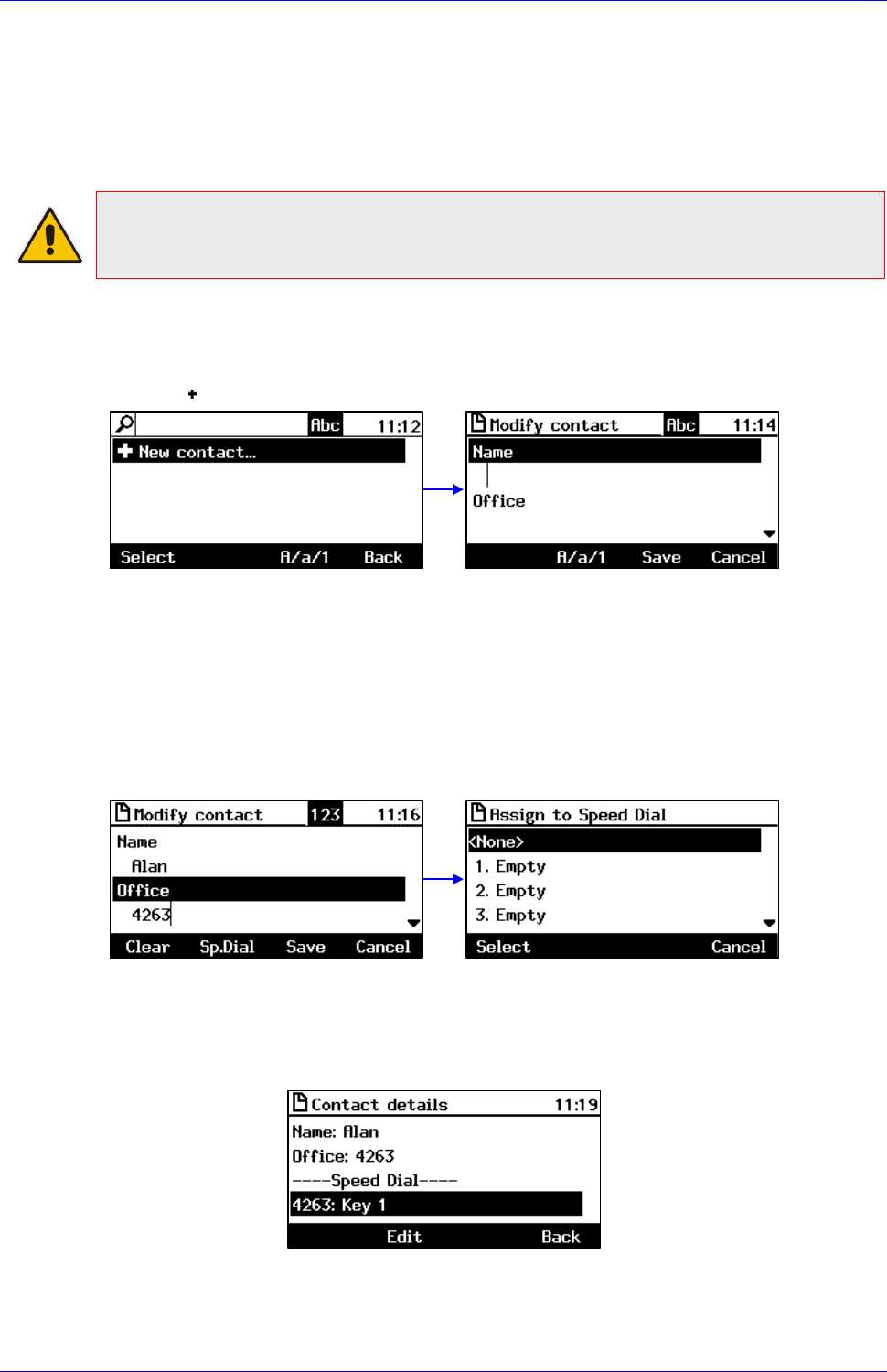
User's Manual Contents
Version 3.0.1 49 430HD and 440HD IP Phone
6.14.2 Adding a Contact to the Personal Directory
This section shows how to add a contact to the Personal directory. You can enter the contact's
home number, office number, mobile number, and/or SIP URI. You can also define a Speed Dial
to place calls quickly to the contact (see Section 6.16 on page 56). After adding a contact you
search and find them in the group, dial them, edit their contact information or delete them.
Note: You can add a maximum of 1,000 contacts to your Personal directory. After adding a
contact, you can call the contact directly from the directory. If you receive an incoming call
from a contact listed in the directory, the screen displays the name listed.
To add a contact to the Personal directory:
1. Access the Personal directory.
2. Select New contact (press the Select softkey):
3. In the 'Modify contact' screen, key in the ‘Name’ of the new contact (see Section 3.4 on page
22 for detailed instructions).
4. Navigate down and key in the new contact's office phone number (see Section 3.4 on page
22 for detailed instructions).
5. Optionally, navigate down and key in the new contact's home and mobile numbers as well.
6. Optionally, navigate down and enter the contact's SIP URI, e.g.,
mike.dubb@audiocodes.com.
You may find this option useful if you don't know their phone number.
7. Press the Sp. Dial softkey to assign a speed dial key if required:
8. Navigate to the first Empty speed dial and press the Select softkey, a speed dial key is
assigned to the contact.
9. Press the Save softkey; 'Contact Saved' is displayed.
10. To view the assigned speed dial, navigate down to the contact's name and press 'Detail'.
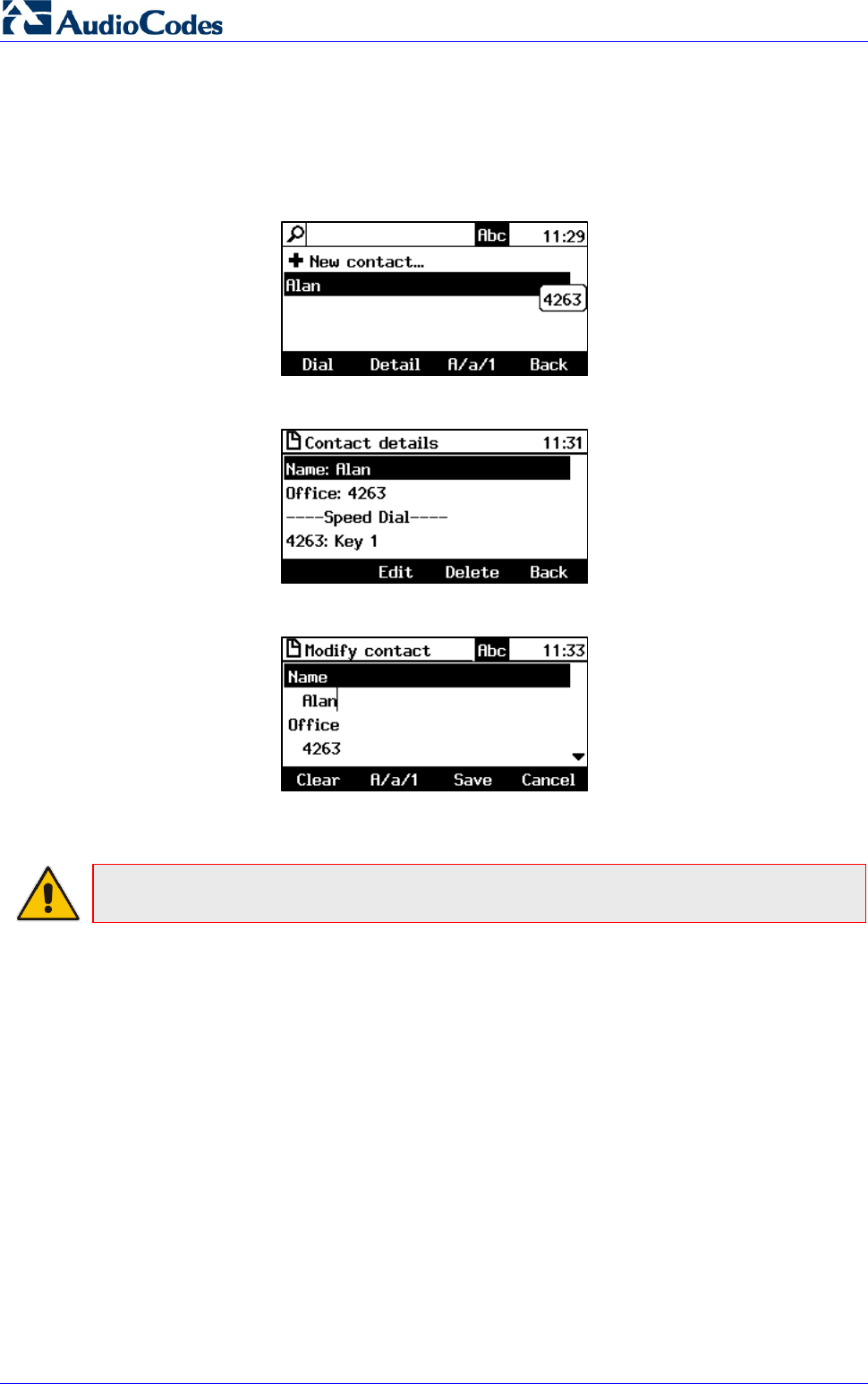
430HD and 440HD IP Phone
User's Manual 50 Document #: LTRT-11939
6.14.3 Editing Contact Information in the Personal Directory
This section shows how to edit contact information in the Personal directory.
To edit:
1. Access the Personal directory and navigate to the name of the contact to edit:
2. Press the Detail softkey:
3. Press the Edit softkey:
4. Modify the contact’s details and press the Save softkey.
Note: The Corporate directory cannot be modified.
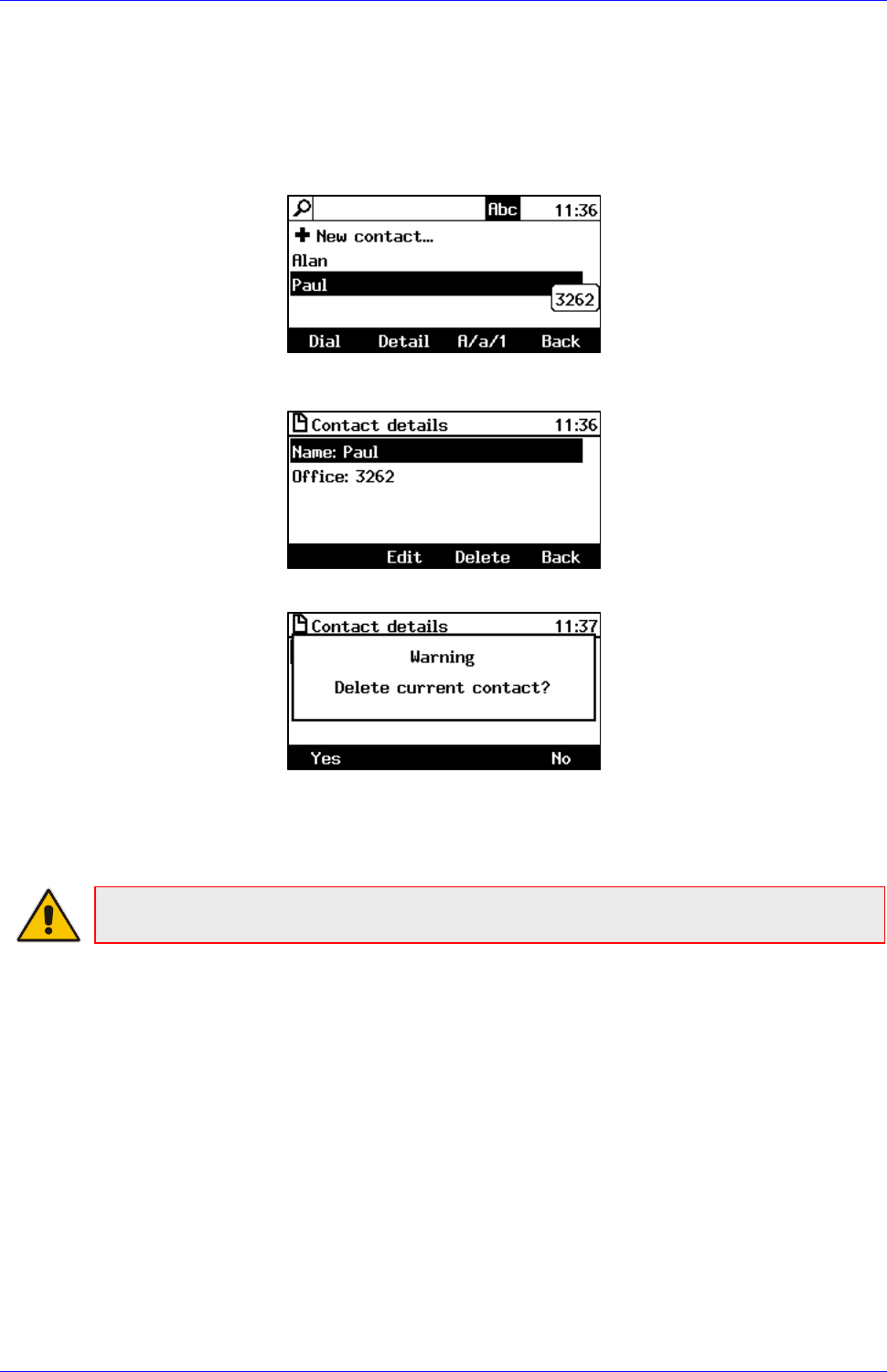
User's Manual Contents
Version 3.0.1 51 430HD and 440HD IP Phone
6.14.4 Deleting a Contact from the Personal Directory
This section shows how to delete a contact from the Personal directory.
To delete a contact from the Personal directory:
1. Access the Personal directory and navigate to the contact to delete:
2. Press the Detail softkey; the contact details are shown.
3. Press the Delete softkey; a 'Delete current contact?' warning message appears:
4. Press the Yes softkey to remove the contact from the phone directory or No if you want to
keep the contact in the directory; the contact is removed from the directory.
Note: Corporate directory contacts cannot be deleted.
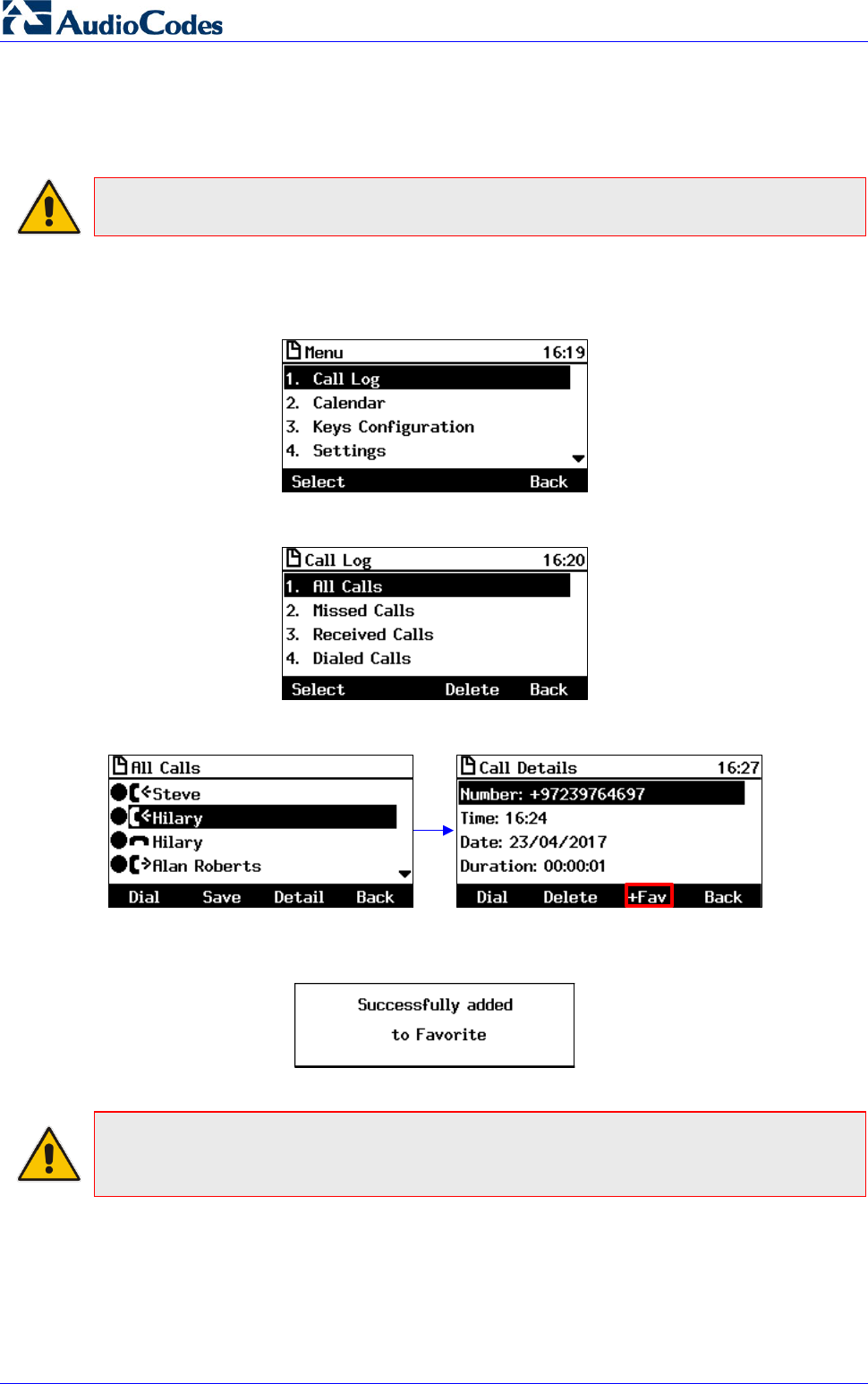
430HD and 440HD IP Phone
User's Manual 52 Document #: LTRT-11939
6.14.5 Adding a Person to Favorites after a Call with them is Logged
This section shows how to add a person to the Favorites directory after a call with them is logged.
Note: A maximum of 1,000 people can be added to the Favorites directory.
To add a person to your Favorites directory:
1. Open the Call Log (MENU key > Call Log).
2. Select the call log:
3. In the log, select the person with whom the call was made and then press the Detail softkey.
4. In the 'Call Details' screen, press the +Fav softkey; the person is added to your Favorites
directory.
Note: You can also add a person to the Favorites directory from the Corporate Directory,
Outlook Contacts, Personal Directory and (User) Groups, through the 'Contact details'
screen's +Fav softkey, shown below.

User's Manual Contents
Version 3.0.1 53 430HD and 440HD IP Phone
6.14.6 Removing a Person from Favorites
You can remove a person from the Favorites directory.
To remove a person from your Favorites directory:
1. Open the Favorites directory (MENU key > Favorites).
2. Navigate to the person to remove and press the OK navigation control; the Contact Details
screen opens.
3. Press the -Fav softkey; the person is removed from the Favorites directory.
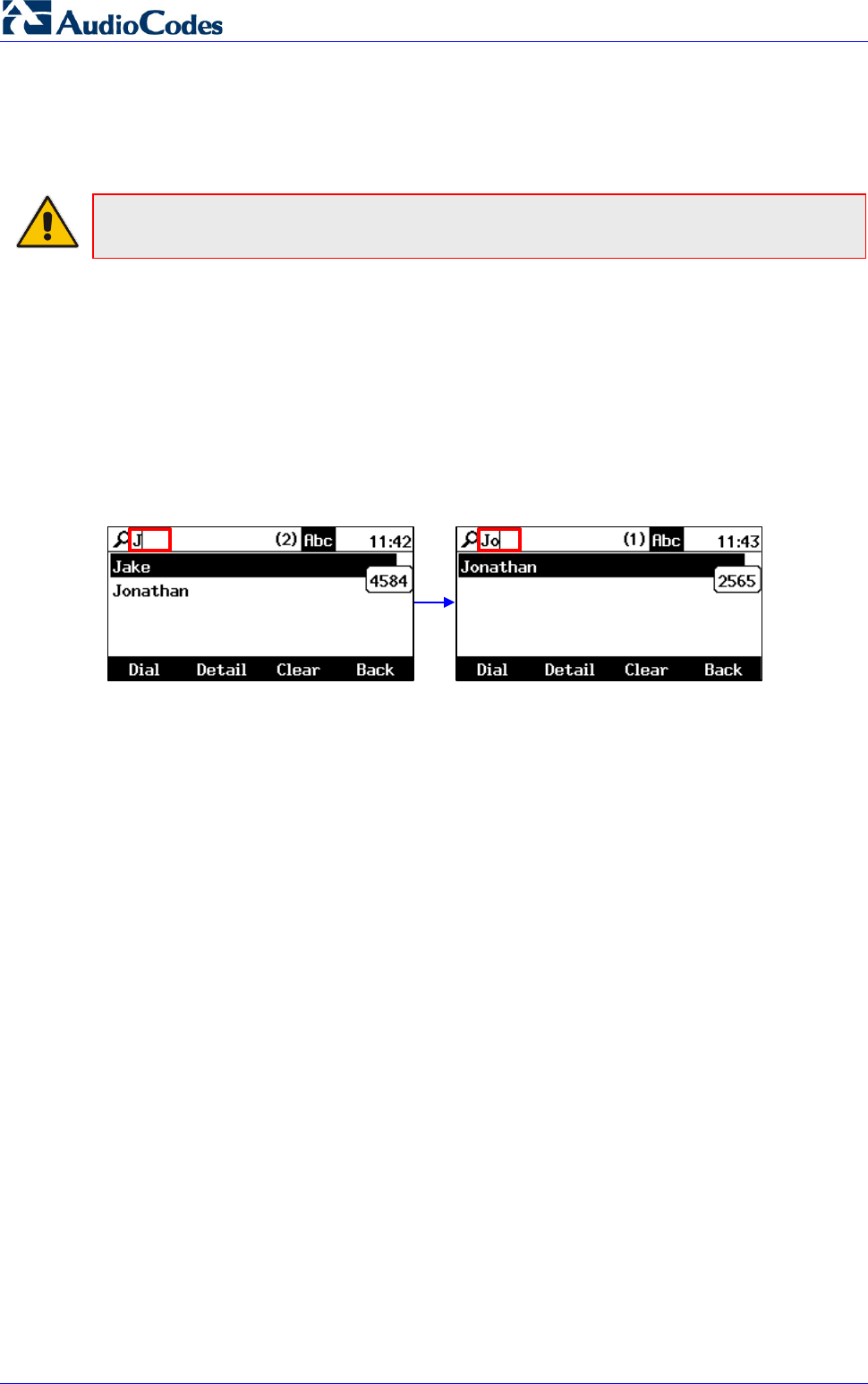
430HD and 440HD IP Phone
User's Manual 54 Document #: LTRT-11939
6.14.7 Searching for a Contact in a Directory
The search feature enables you to quickly and easily locate a contact in a directory. The feature
is especially useful if you have a long list of contacts.
Note: When searching in the Corporate directory, the T9 feature is available. See the next
section for details.
To search for a contact:
1. Access the phone directory.
2. Search for a contact:
• Scroll down to the contact in the list
-OR-
• Key the first letter in the contact's name; the directory locates contacts whose names
begin with that letter. For example, as you press the J key to search for contact
Jonathan, the directory locates contacts whose names begin with J. As you key in the
next letter, i.e., o, contacts whose names begin with Jo appear, etc.
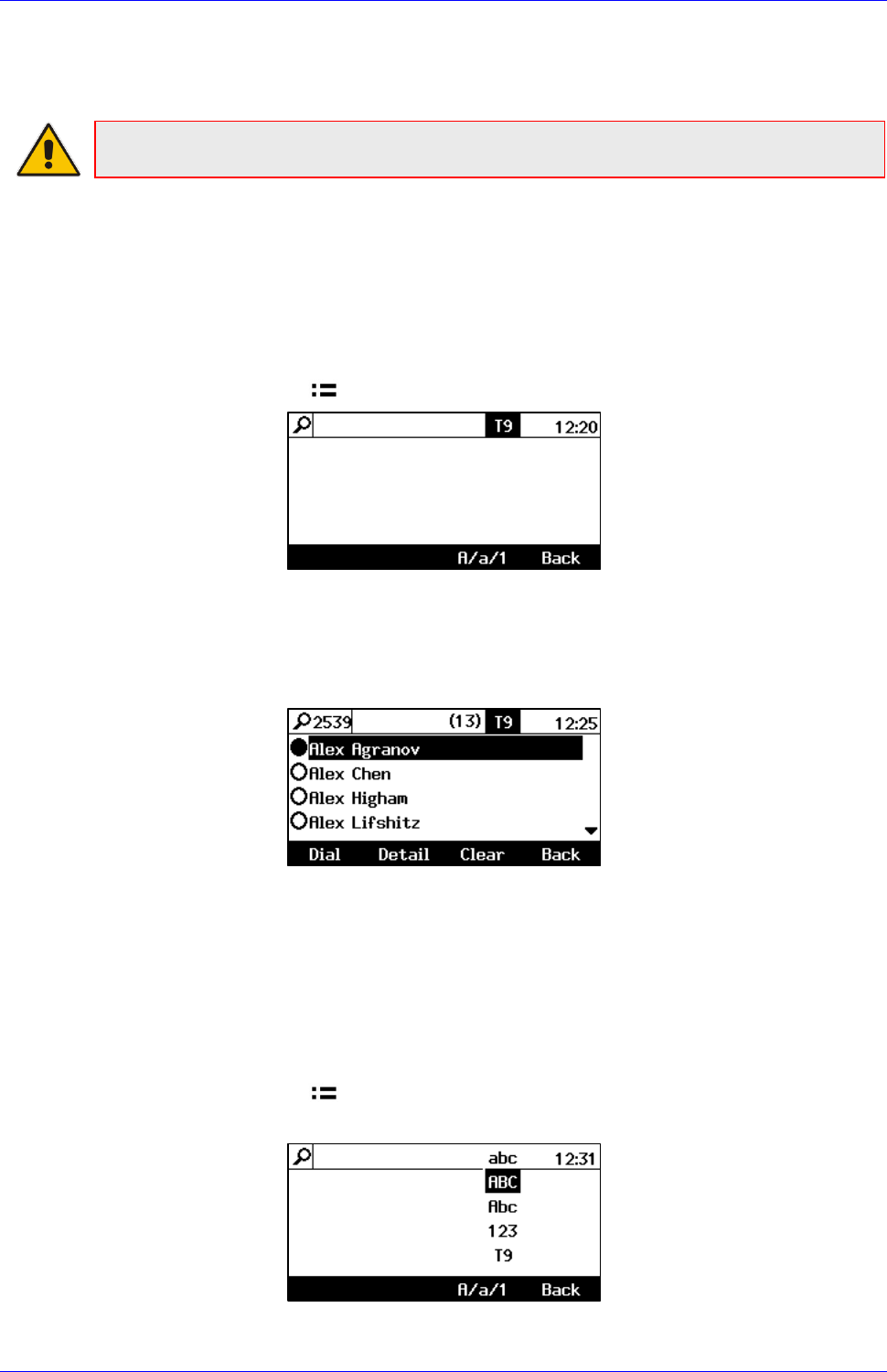
User's Manual Contents
Version 3.0.1 55 430HD and 440HD IP Phone
6.15 Searching for a Contact in the Corporate Directory using
T9
Note: The T9 feature only applies to searching for a contact in the Corporate directory.
The T9 (Text on 9 keys) feature lets you press the 2 key, for example, on the dialpad to input the
letter C. You only need to press it once. So to input Charles you can press 2427537. T9 supports
predictive search, so as letters are entered, possibilities are displayed before you finish entering
the name. If the name Alex, for example, appears multiple times in the directory, users can enter
ALEX, space (*), and then the first letter of the family name.
To access a contact in the Corporate directory using T9:
1. Open the Corporate directory (press the CONTACTS hard key and in the Favorites screen
that opens, press the softkey and select Corporate directory).
2. Note that T9 is enabled by default. On the dialpad, press the key containing the first letter in
the contact's name, for example, A. You only need to press it once. Then press the key
containing the second letter, for example, L. You only need to press it once. Press the key
containing the third letter, for example, E. You only need to press it once. If necessary, Press
the fourth letter, for example, X.
3. Use the * key on the dial pad to enter a space, and then enter the first letter of the family
name, if necessary.
6.15.1 Changing from T9 to A/a/1
You can search for a contact in the Corporate directory using T9 (default) or A/a/1.
To change from the default to A/a/1:
1. Open the Corporate directory (press the CONTACTS hard key and in the Favorites screen
that opens, press the softkey and select Corporate directory).
2. In the directory, press the A/a/1 softkey and choose your preference:
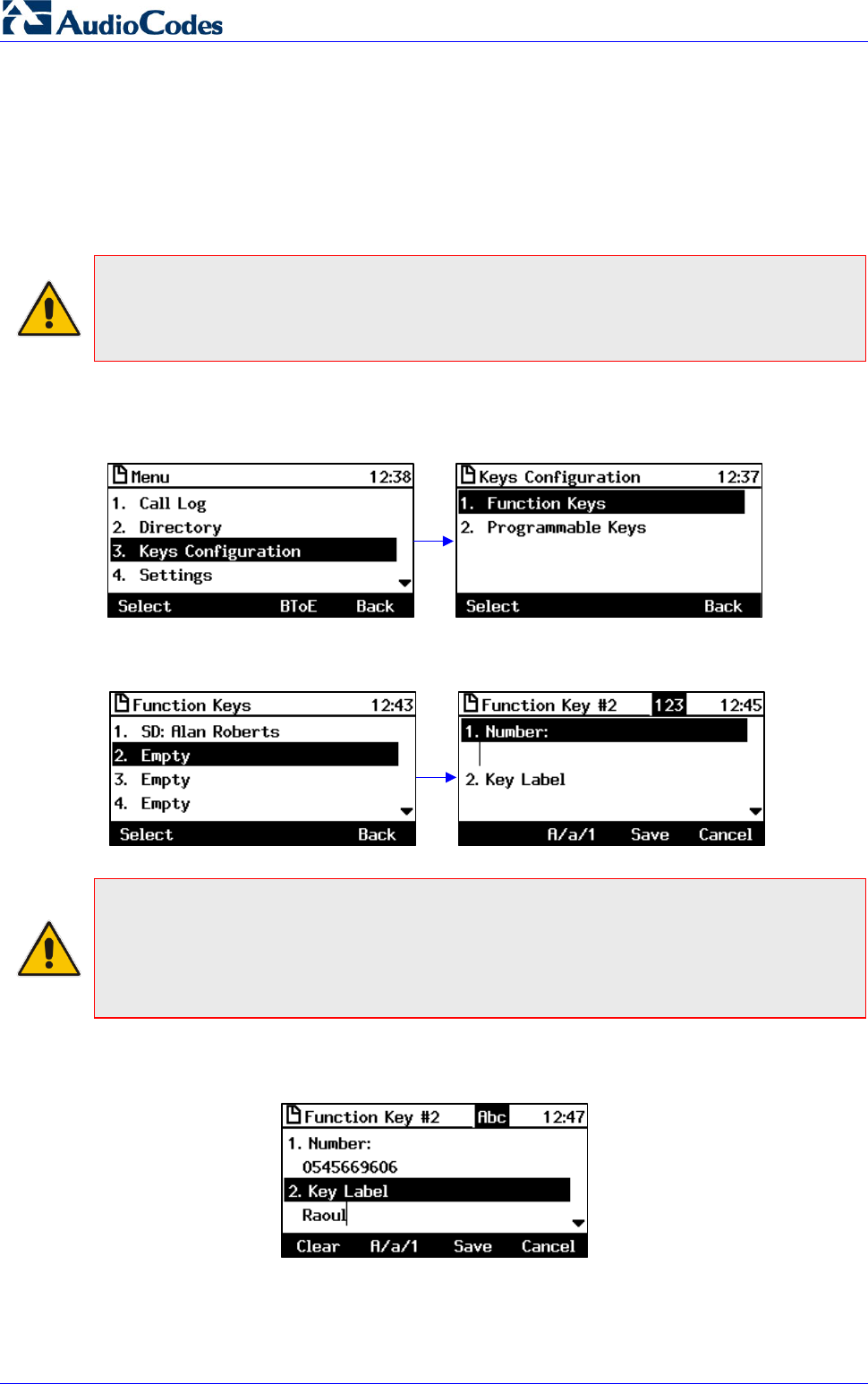
430HD and 440HD IP Phone
User's Manual 56 Document #: LTRT-11939
6.16 Defining Function Keys as Speed Dials
This section shows how to set up placing a call to a contact by pressing a Function Key defined
as a Speed Dial. You can define each of the 12 Function Keys on the phone's BLF sidecar as a
Speed Dial. Speed Dials for 12 contacts can therefore be defined. An additional five can be
defined using the Programmable Keys – see Section 6.20 on page 66).
Note: These are your own private Speed Dials. They are preserved even if you sign out of
the phone, sign in with another user, sign out as that user, and then sign in again as your own
user. The Speed Dials are preserved irrespective of whether configured on the BLF sidecar
or on the Programmable Keys adjacent to the screen.
To define a Function Key as a Speed Dial:
1. Access the Function Keys screen (MENU key > Keys Configuration > Function Keys):
2. Navigate to and select an empty (undefined) Function Key; the selected Function Key is
displayed (#2, in this example):
Note:
• Function Key #1 is the topmost of the 12. Function Key #2 is second from the top.
Function Key #12 is the lowermost.
• You can also access a Function Key # screen by long-pressing one of the twelve
Function Keys.
3. In the ‘Number’ field, enter the contact's phone number, as shown below.
Navigate down to the 'Key Label' field and enter the contact's name to be displayed.
-OR-
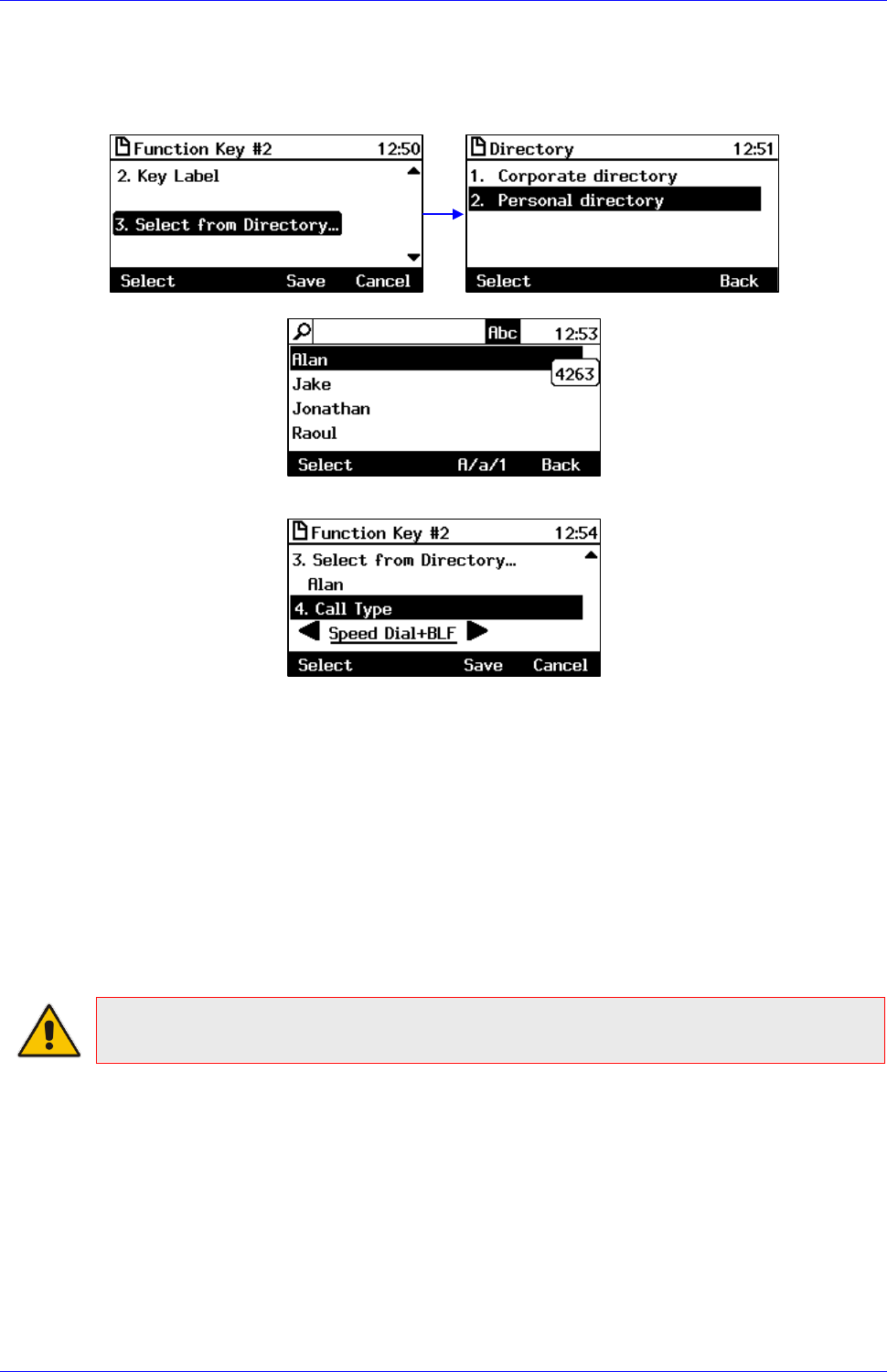
User's Manual Contents
Version 3.0.1 57 430HD and 440HD IP Phone
• Skip the 'Number' and 'Key Label' fields and navigate down to and select Select from
Directory > Personal Directory -or- Corporate Directory > the contact to whom to
assign the Speed Dial:
• Navigate down to 'Call Type' field:
• Navigate to and select Speed Dial or Speed Dial+BLF (if you’re unsure whether or not
the contact is a Skype for Business contact, it's advisable to leave this parameter's
default value unchanged).
4. Press the Save softkey; the SD is created; it is displayed in the BLF LCD (440HD phone
only) and listed in the Function Keys screen (both phone models). The BLF will turn on if it's
a Skype for Business contact.
6.16.1 Configuring Pause Dialing for a Speed Dial to an Ext. behind an IVR
Your network administrator can configure pause dialing for a Speed Dial, in order to create a time
break. This is typically requried for a Speed Dial which dials a destination extension number that
is behind an Interactive Voice Response (IVR) system.
Note: Consult your network administrator if you need a pause dialing configured for a Speed
Dial. See the Administrator's Manual for more information.

430HD and 440HD IP Phone
User's Manual 58 Document #: LTRT-11939
6.16.2 Editing a Speed Dial
You can edit a Speed Dial.
To edit a Speed Dial:
1. Long-press the Function Key defined as a Speed Dial; the Function Key# screen is
displayed.
2. In the 'Number' field, edit by pressing the Clear softkey to delete digits.
3. Navigate down to the 'Key Label' field. Edit by pressing the Clear softkey to delete letters.
4. Navigate down and select Select from Directory and then Personal directory. Navigate to
and select a contact.
5. Navigate down to the 'Call Type' field and press the navigation control’s left or right rim to
navigate to and select either Speed Dial or Speed Dial+BLF.
6. Press the Save softkey to save the edit.
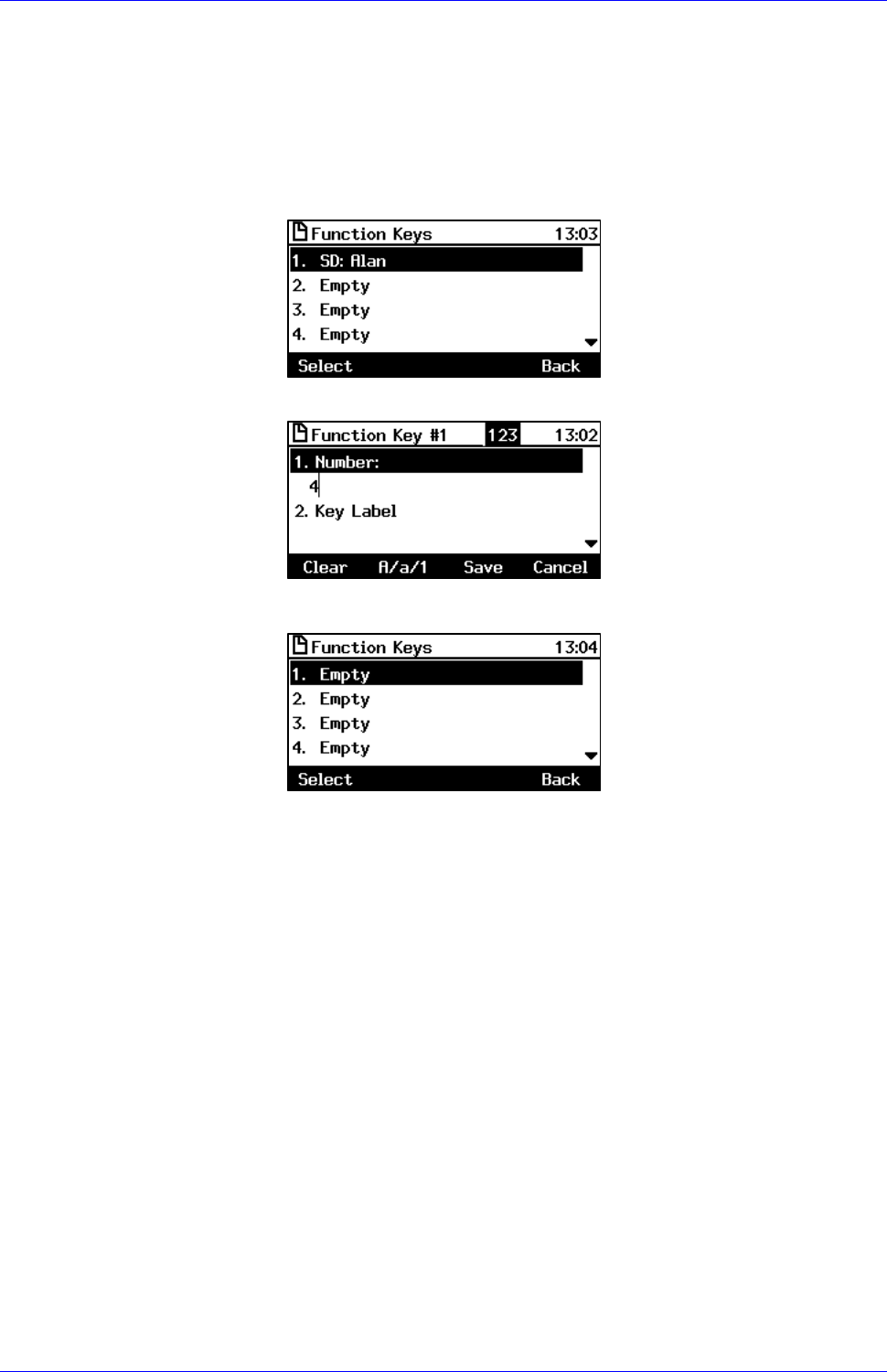
User's Manual Contents
Version 3.0.1 59 430HD and 440HD IP Phone
6.16.3 Deleting the Speed Dial
You can delete the Speed Dial.
To delete a Speed Dial:
1. Access the Function Key # screen (MENU key > Keys Configuration > Function Keys).
2. Navigate to and select the Speed Dial to delete (#1 in the example below).
3. In the ‘Number’ field, delete the entire number using the Clear softkey.
4. Press the Save softkey; the Speed Dial is now listed as 'Empty' in the Function Keys screen:

430HD and 440HD IP Phone
User's Manual 60 Document #: LTRT-11939
6.17 Defining Function Keys as Paging Dials
This section shows how to define a Function Key as a paging dial to page a group.
Note: Make sure the group paging feature is enabled – consult your network administrator.
You can define each of the 12 Function Keys on the phone's BLF sidecar to page up to 12
different paging groups. The paging feature allows a live announcement to be made (paged) from
a phone to a group of phones, to notify a team (for example) that a meeting is about to
commence at a certain venue. The paged announcement is multicast via a designated group IP
address, in real time, on all idle phones in the group, without requiring listeners to pick up their
receivers. The name of the group is displayed on phone BLF sidecar when the paging call comes
in.
To define a Function Key as a paging dial:
1. Access the Function Keys screen (MENU key > Keys Configuration > Function Keys):
2. Navigate to and select an empty (undefined) Function Key; the selected Function Key is
displayed:
Note:
• Function Key #1 is the topmost of the 12. Function Key #2 is second from the top.
Function Key #12 is the lowermost.
• You can also access a Function Key # screen by long-pressing one of the twelve
Function Keys on the phone's BLF sidecar.
3. Navigate to Paging (press the right rim of the navigation control button):
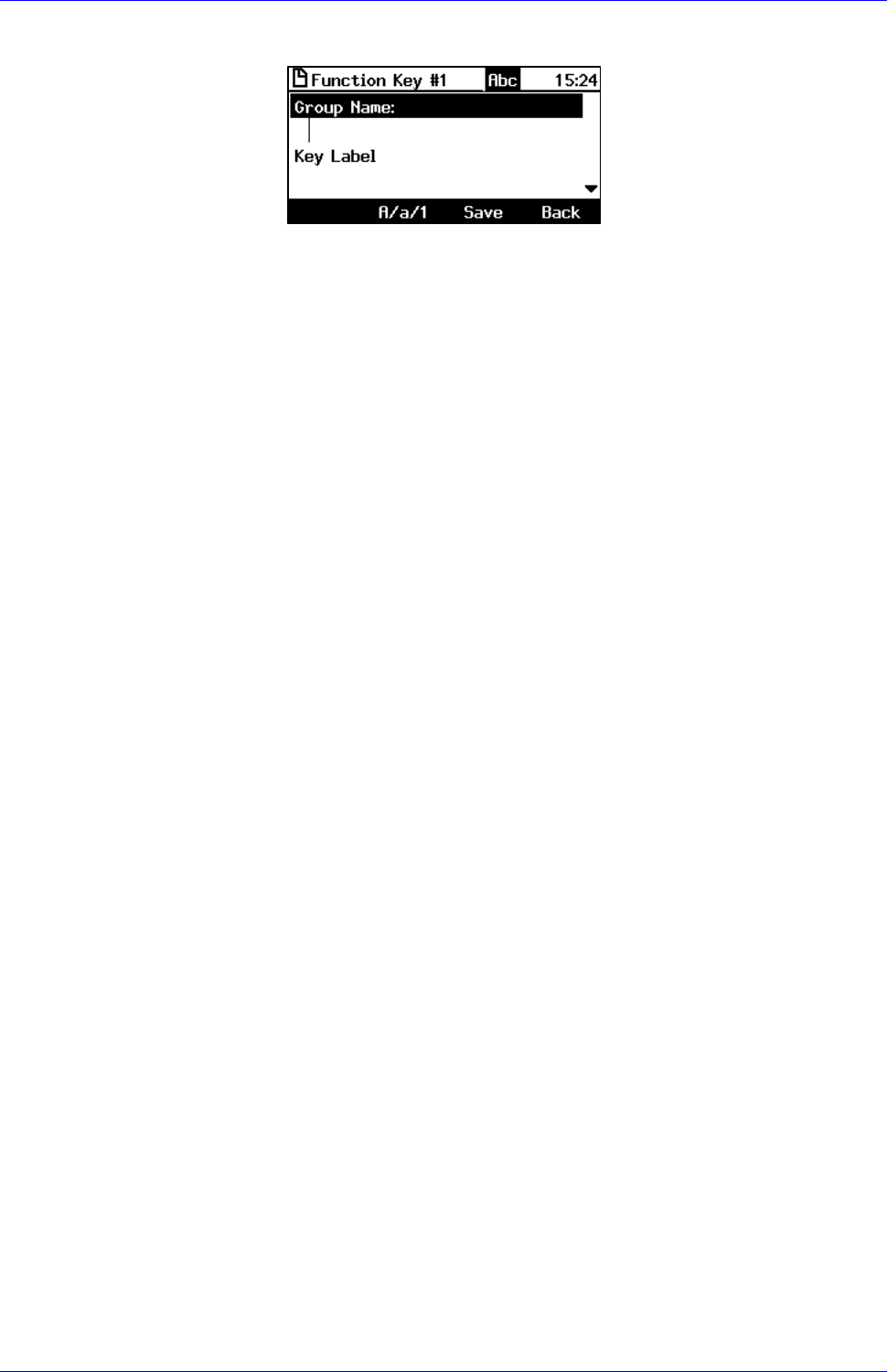
User's Manual Contents
Version 3.0.1 61 430HD and 440HD IP Phone
4. Press the Select softkey:
5. In the 'Group Name' field, enter the name of the group, to be displayed in the phone's screen
when there's an incoming / outgoing paging call.
6. In the ‘Key Label’ field (applies only to the 440HD phone), define a name for the Feature
Key-Paging Dial, to be displayed in the phone's BLF sidecar.
7. In the 'Multicast Address' field, enter the paging group's multicast IP address. Default:
224.0.1.0. For phones to be in a group, all must be configured with the identical multicast
address.
8. In the 'Multicast Port' field, enter the group's port. Default: 8888. For phones to be in a group,
all must be configured with the identical port.
9. Press the Save softkey; the Function Key is now configured for paging.
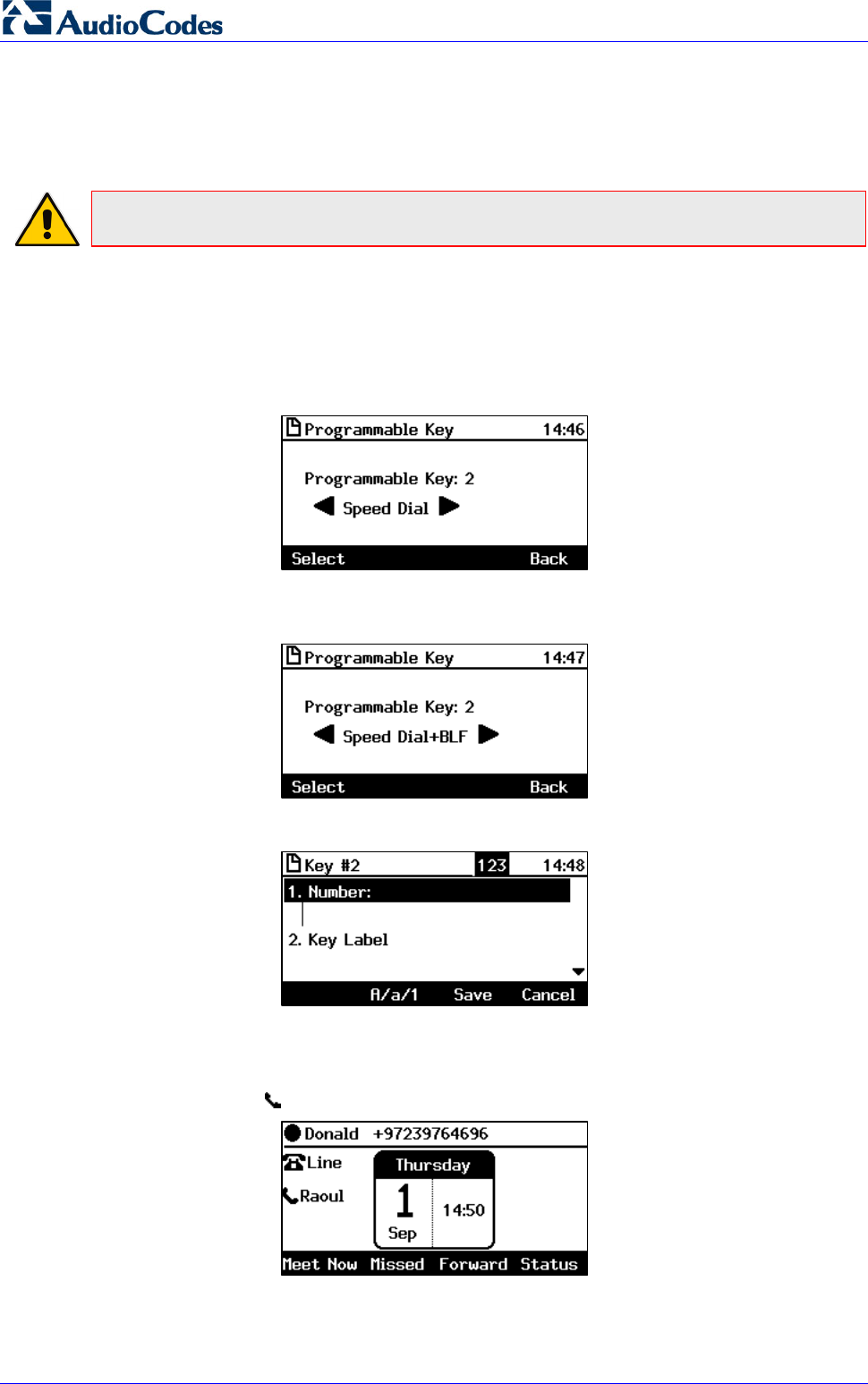
430HD and 440HD IP Phone
User's Manual 62 Document #: LTRT-11939
6.18 Defining Programmable Keys as Speed Dials
Three Programmable Keys are located on either side of the screen, making six in total.
Note: The upper left key is the preprogrammed line. It cannot be defined as a Speed Dial.
You can define the other five keys as Speed Dials just as you defined the 12 Function Keys as
SDs as shown in Section 6.16. You can therefore define a total of 17 SDs on a phone.
To define a Programmable Key as a Speed Dial:
1. Long-press a Programmable Key (that hasn't been defined) or press MENU > Keys
Configuration > Programmable Keys and select an 'Empty'; this screen is displayed:
2. Press the navigation control’s left/right rim to navigate to and select Speed Dial or Speed
Dial+BLF:
3. Press the Select softkey; this screen opens:
4. Define the 'Number' and 'Key Label' field – or navigate down to select the Select from
Directory option - as you did when defining a Function Key as Speed Dial (see Section 6.16
on page 56) and press the Save softkey; the screen reverts to idle mode displaying the
Speed Key icon next to the name of the contact you defined ('Raoul', in this example):
5. To quickly place a call, press the key on the phone opposite 'Raoul'; the number is dialed.
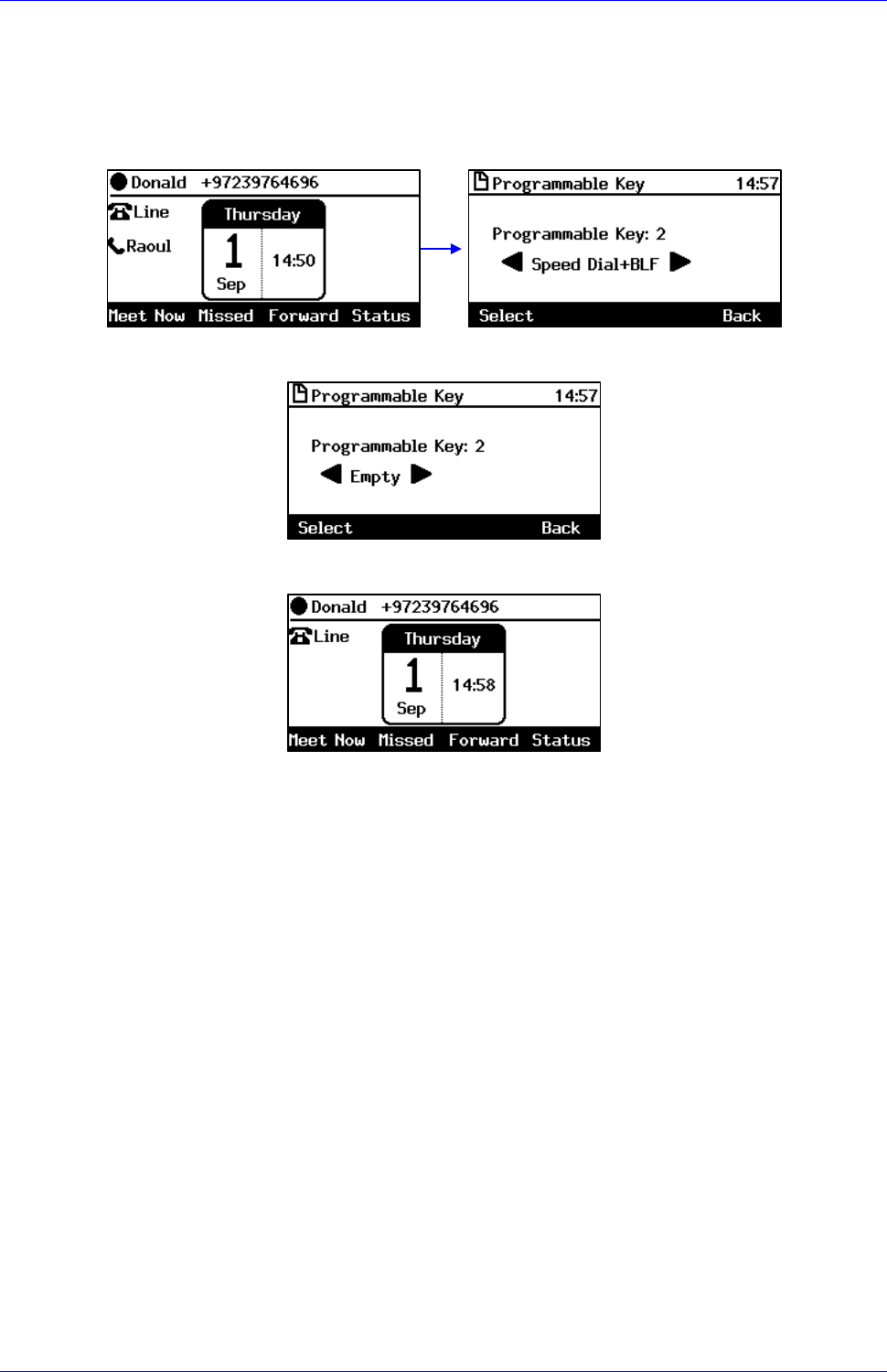
User's Manual Contents
Version 3.0.1 63 430HD and 440HD IP Phone
6.18.1 Deleting the Speed Dial
To delete a Speed Dial:
1. Long-press the key opposite the Speed Dial displayed in the screen ('Raoul', in the previous
example); this screen is displayed:
2. Press the navigation control’s left or right rim to navigate to and select Empty:
3. You're returned to the idle screen; the Speed Dial is removed:
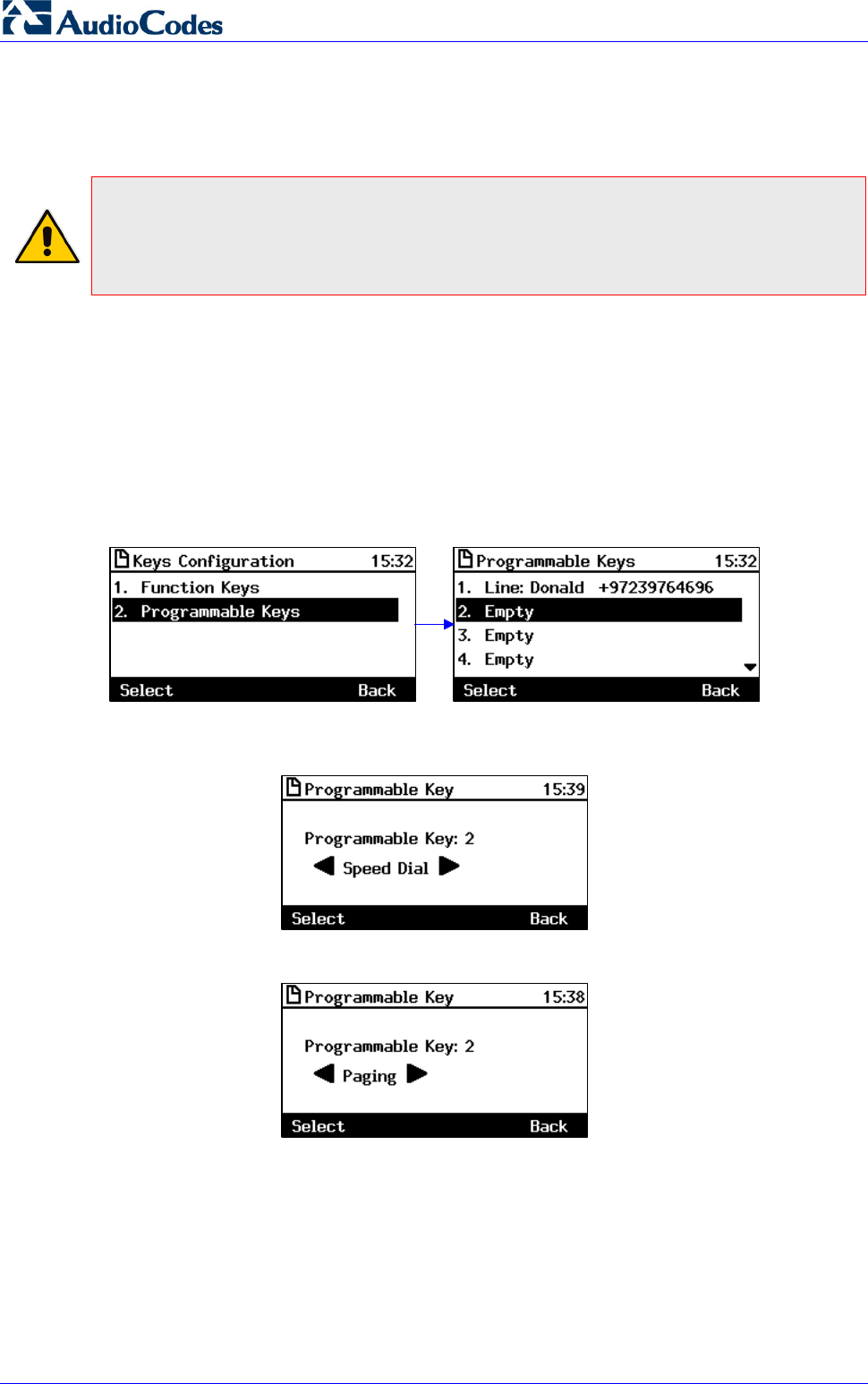
430HD and 440HD IP Phone
User's Manual 64 Document #: LTRT-11939
6.19 Defining Programmable Keys as Paging Dials
This section shows how to define a Programmable Key as a paging dial to page a group.
Note:
• Make sure the group paging feature is enabled – consult your network administrator.
• The feature is not allowed once a user is configured as a delegate for the Boss-Admin
feature.
You can define up to five Programmable Keys to page up to five different paging groups. The
paging feature allows a live announcement to be made (paged) from a phone to a group of
phones, to notify a team (for example) that a meeting is about to commence at a certain venue.
The paged announcement is multicast via a designated group IP address, in real time, on all idle
phones in the group, without requiring listeners to pick up their receivers. The name of the group
is displayed on phone screens when the paging call comes in.
To define a Programmable Key as a paging dial:
1. Access the Programmable Keys screen (MENU key > Keys Configuration >
Programmable Keys):
2. Navigate to and select an empty (undefined) Programmable Key; the selected
Programmable Key is displayed (#2, in this example):
3. Navigate to Paging (press the right rim of the navigation control button):
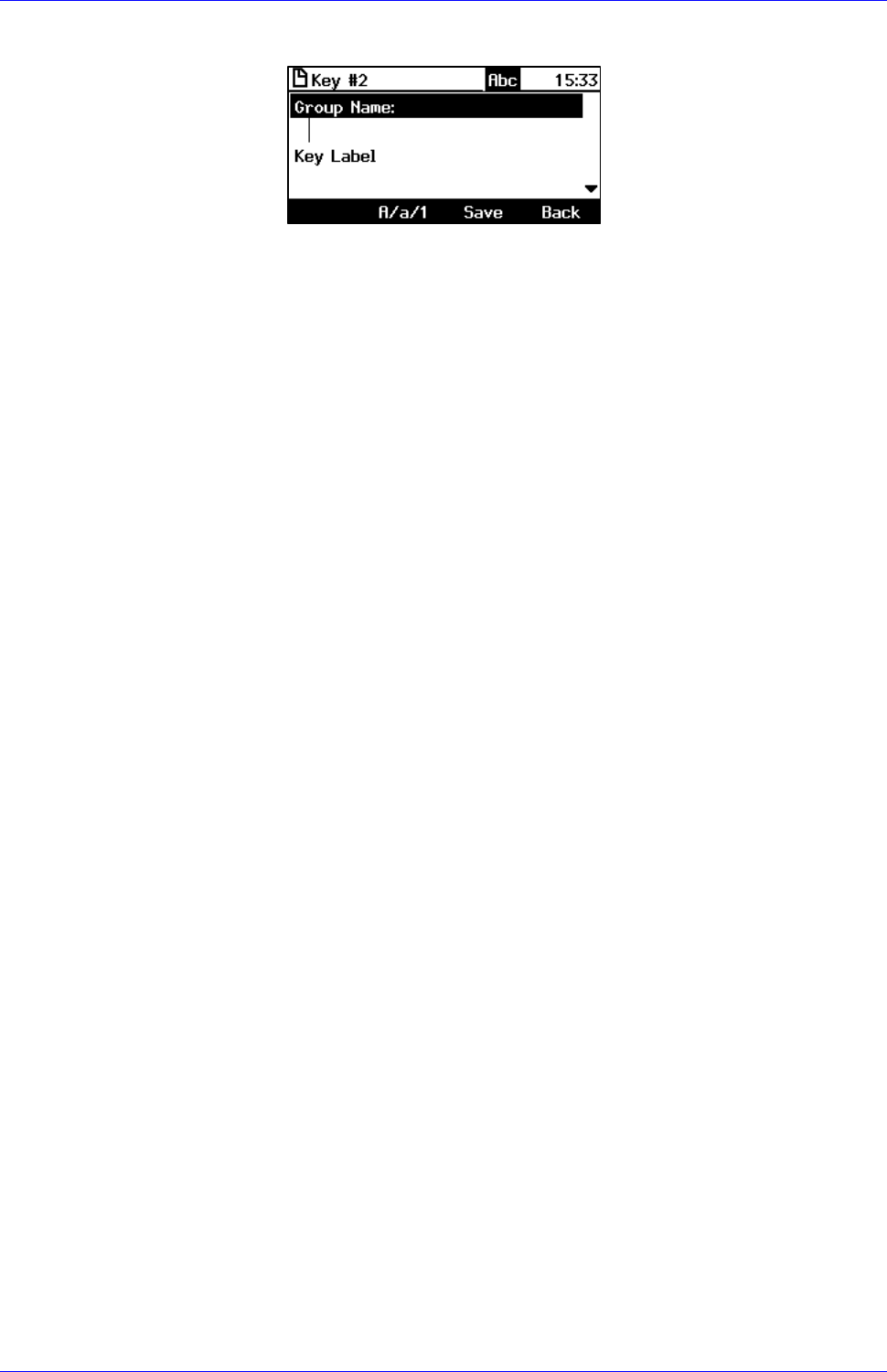
User's Manual Contents
Version 3.0.1 65 430HD and 440HD IP Phone
4. Press the Select softkey:
5. In the 'Group Name' field, enter the name of the group, to be displayed in the phone's screen
when there's an incoming / outgoing paging call.
6. In the ‘Key Label’ field, define a name for the Programmable Key-Paging Dial, to be
displayed in the phone's screen.
7. In the 'Multicast Address' field, enter the paging group's multicast IP address.
Default: 224.0.1.0. For phones to be in a group, all must be configured with the identical
multicast address.
8. In the 'Multicast Port' field, enter the group's port. Default: 8888. For phones to be in a group,
all must be configured with the identical port.
9. Press the Save softkey; the Programmable Key is now configured for paging.
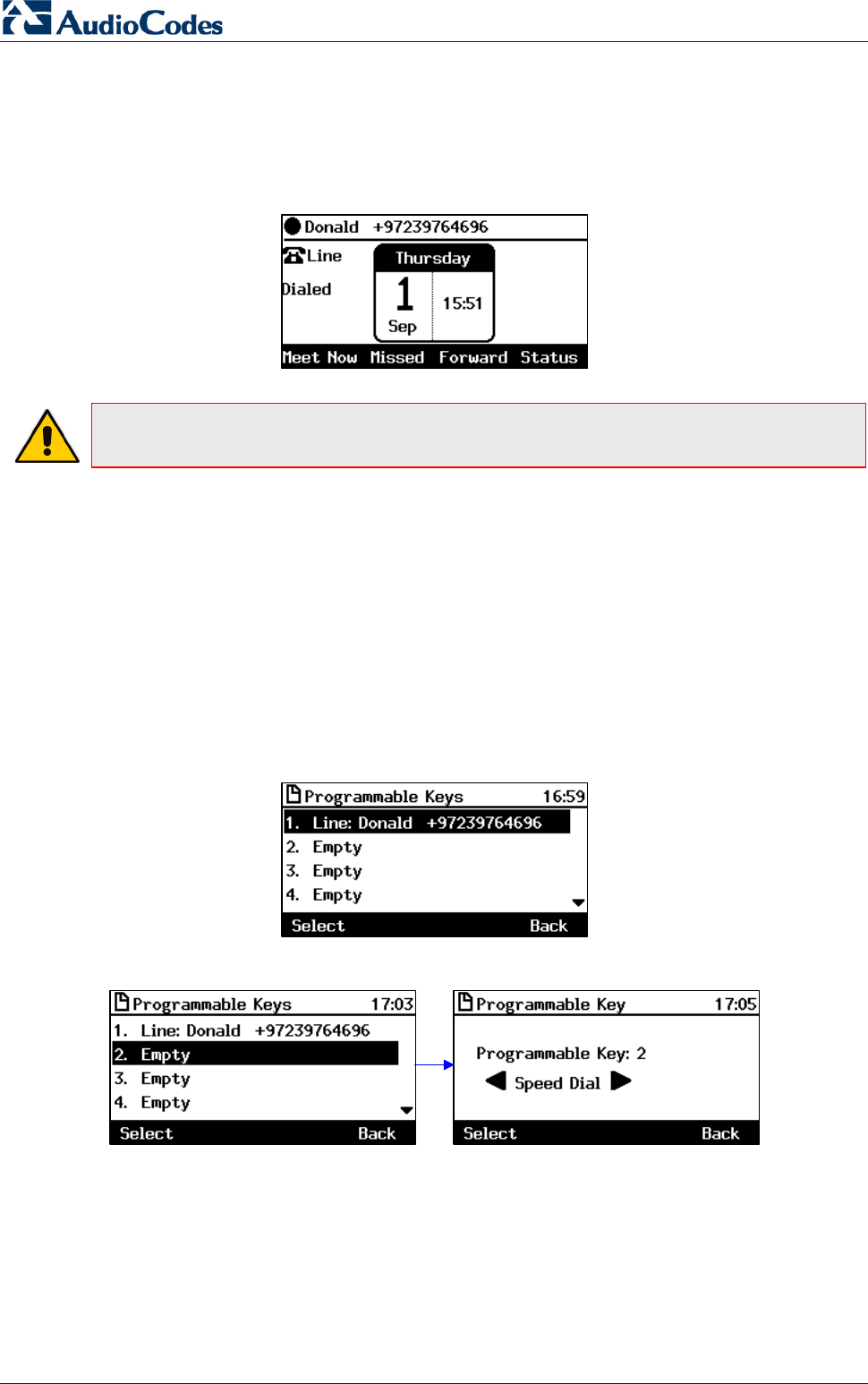
430HD and 440HD IP Phone
User's Manual 66 Document #: LTRT-11939
6.20 Defining Programmable Keys as Key Events
You can alternatively define the five Programmable Keys as Key Events. For example, in the
figure below, a Programmable Key has been defined as a ‘Dialed’ Key Event. Pressing the key
opposite 'Dialed' opens the Dialed Calls screen:
Note: The left uppermost key next to the screen is the preprogrammed phone line. It cannot
be defined as a Key Event.
Other Key Events you can define in addition to 'Dialed Calls' are:
Missed Calls
Received Calls
Directory
DnD All
Forward All
The section below shows how to define a Programmable Key as a Key Event.
To define a Programmable Key as a Key Event:
1. Access the Programmable Keys screen (MENU key > Keys Configuration >
Programmable Keys):
2. Navigate down to an Empty key and select it:
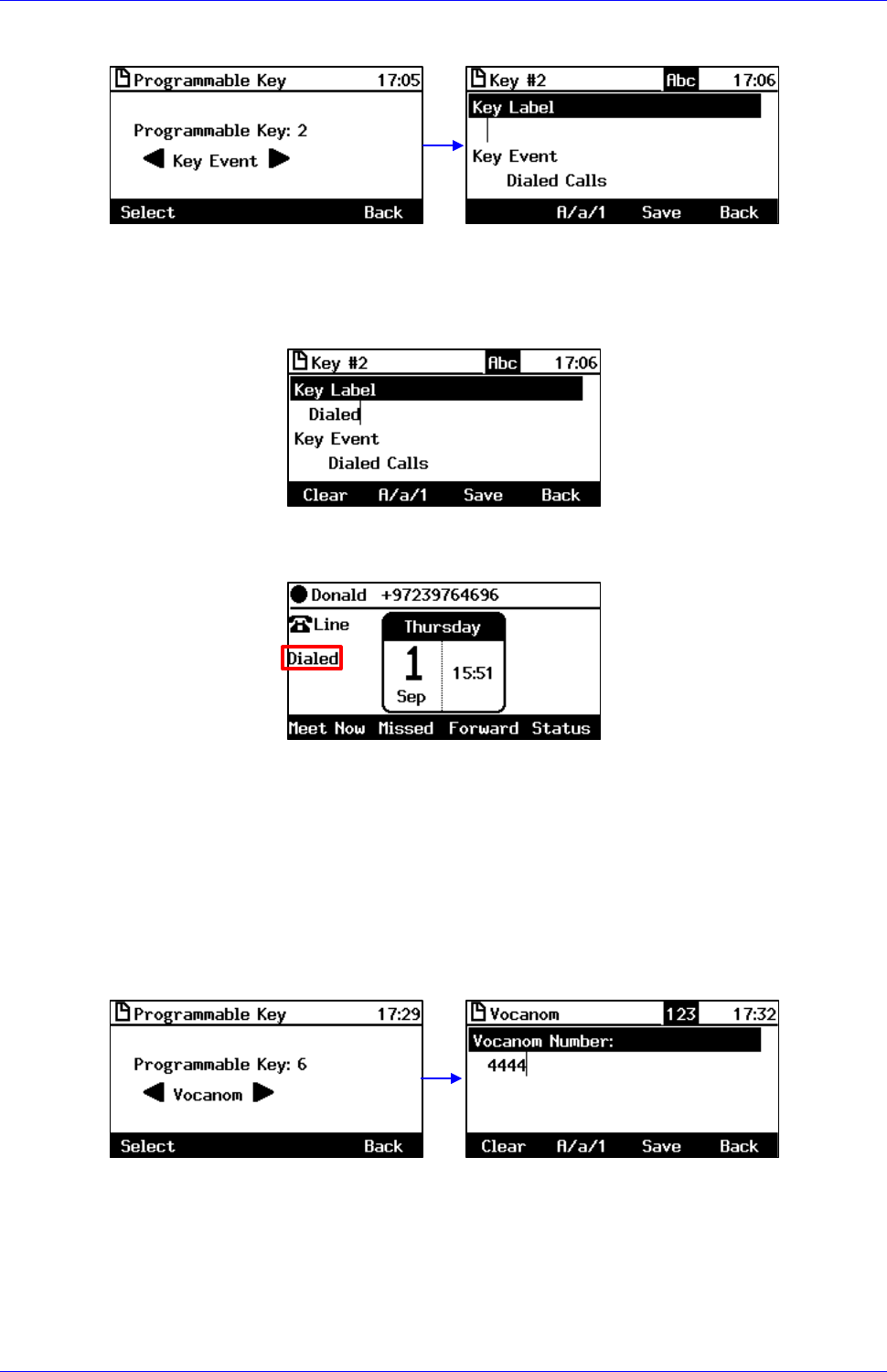
User's Manual Contents
Version 3.0.1 67 430HD and 440HD IP Phone
3. Press the navigation control’s left or right rim to navigate to and select Key Event:
4. In the ‘Key Label’ field, define an identifier that you’ll easily identify in the screen, e.g.,
'Dialed', as shown in the screen below.
5. Navigate down to the ‘Key Event’ field and then press the navigation control’s left or right rim
to navigate to and select the Key Event you want to define, for example, ‘Dialed Calls’:
6. Press the Save softkey; the screen reverts to idle mode displaying the ‘Dialed’ Key Event
you defined ('Dialed', in this example):
6.20.1 Defining Programmable Key #6 as a VocaNOM Speed Dial
You can configure programmable key #6 as a VocaNOM speed dial for quicker and friendlier
voice dialing ability.
To configure VocaNOM Programmable Key #6:
1. Long-press the sixth Programmable Key located to the right of the screen below the fifth
and fourth keys; the Programmable Key screen is displayed in the screen.
2. Press the navigation control’s left rim to navigate to and select the Key Event Vocanom
as shown in the figure below.
3. Enter the VocaNOM Number and press the Save softkey; VocaNOM is displayed in the
phone screen as shown in the figure below.
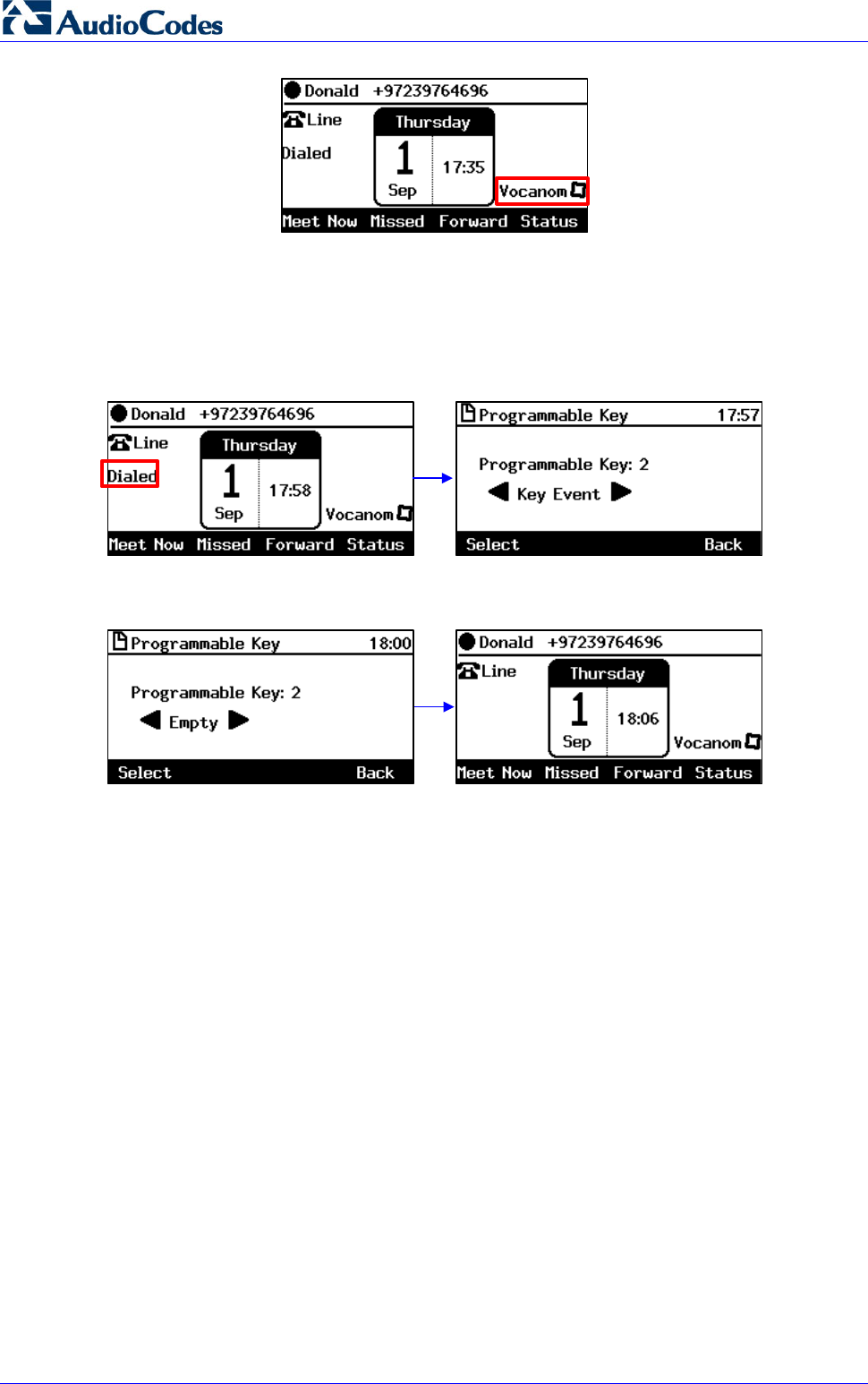
430HD and 440HD IP Phone
User's Manual 68 Document #: LTRT-11939
6.20.2 Deleting a Key Event
This section shows how to delete a Programmable Key defined as a Key Event.
To delete a Programmable Key defined as a Key Event:
1. Long-press the Programmable Key until this screen is displayed:
2. Press the navigation control’s left or right rim to navigate to and select Empty; you're
returned to the idle screen; the Programmable Key is removed.
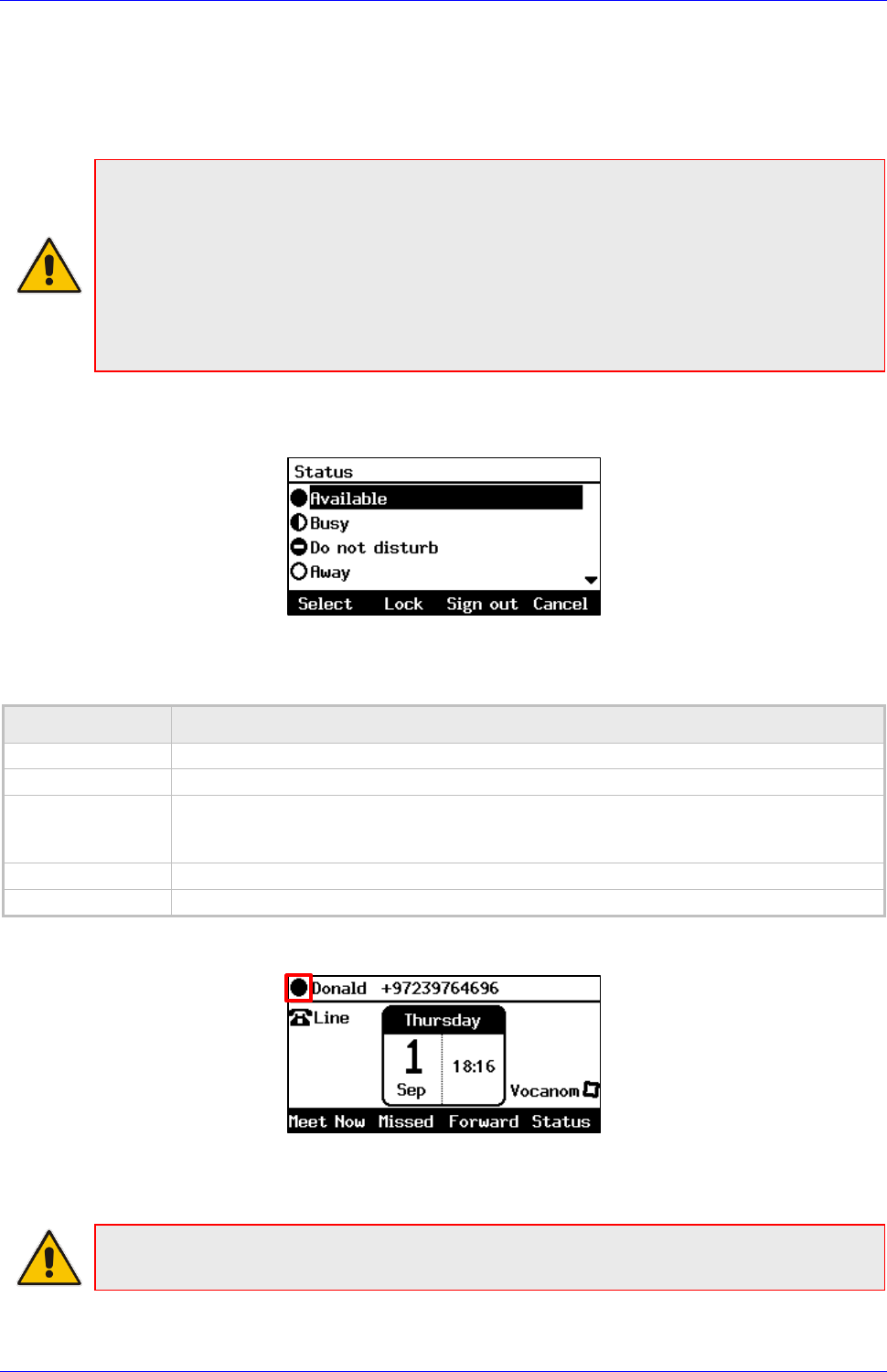
User's Manual Contents
Version 3.0.1 69 430HD and 440HD IP Phone
6.21 Changing your Presence Status
You can assign a presence status to control whether you want people to contact you or not, and if
so, how. By default, your status is based on your Skype for Business client.
Note:
• Presence status can be changed by your Skype for Business client running on your
computer. This status is reflected on the phone's screen.
• After n minutes (configured in the Skype for Business server by your administrator),
presence status automatically changes to ‘Inactive’.
• n minutes after this (also configured in the Skype for Business server by your
administrator), presence status automatically changes to ‘Away’; all calls are then
automatically forwarded to the RGS (Response Group Service) if it is configured.
To set/change presence status:
1. In the idle screen, press the Status softkey:
2. Navigate to a presence status:
Table 6-2: Presence Statuses
Presence Status Description
Available
You're online and available for other contacts to call.
Busy
You’re busy and don’t want to be interrupted.
Do not disturb
You don’t want to be disturbed. Stops the phone from ringing when others call you. If
DnD is activated, callers hear a tone indicating that your phone is busy; the call is
blocked and your idle screen indicates 'Missed Calls'.
Away
You want to hide your status and appear to others you're currently away.
Be right back
You' are away briefly and will return shortly.
3. Press the Select softkey; the status you selected is displayed in the idle screen:
4. To reset your presence status, navigate to and select Reset in the Status screen; your status
is received from the Skype for Business server and automatically updated.
Note: If a contact listed in your phone's BLF list is in a call, the red BLF LED on your phone
flashes on and off to indicate it.
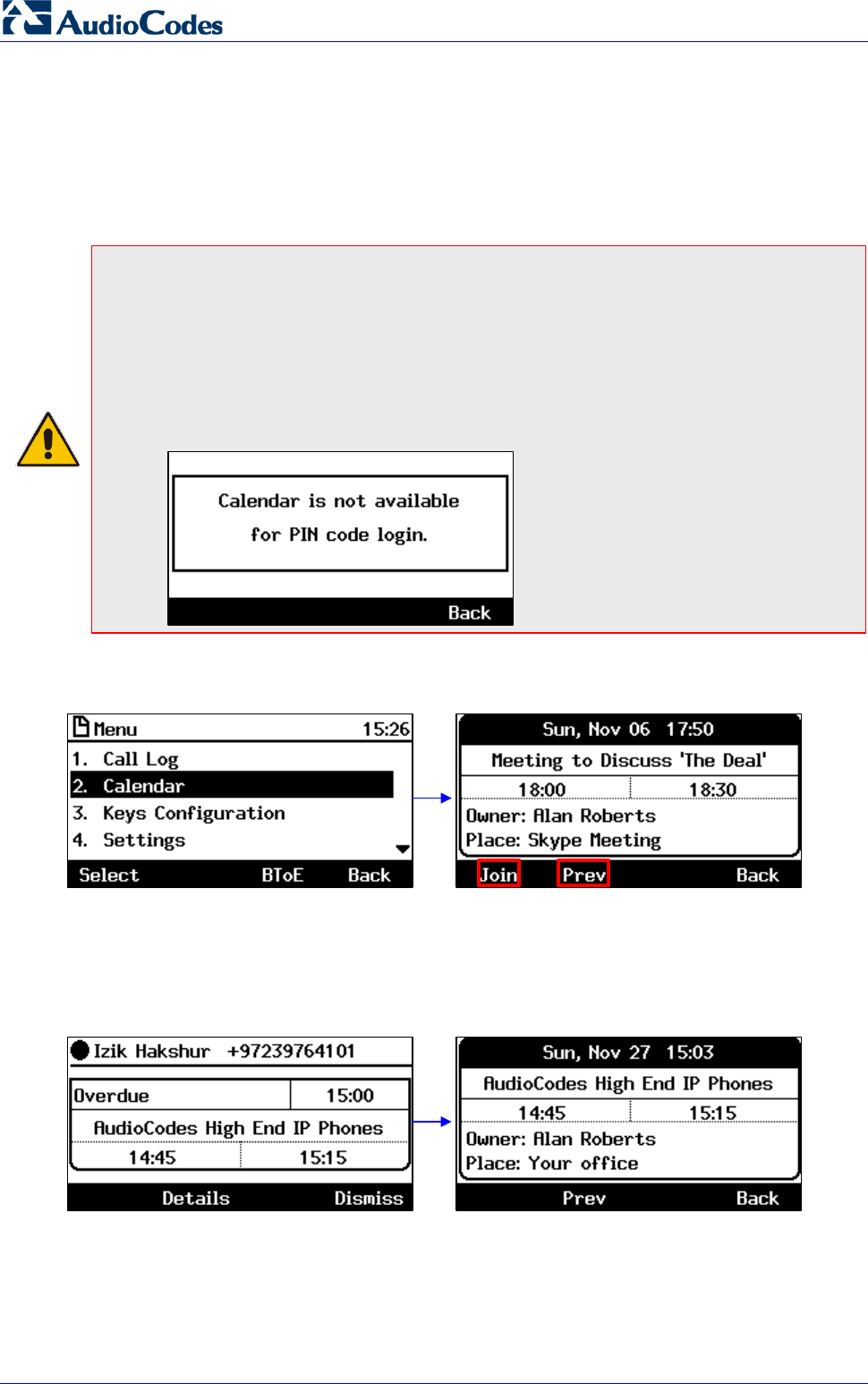
430HD and 440HD IP Phone
User's Manual 70 Document #: LTRT-11939
6.22 Viewing Microsoft Exchange Calendar in the Phone
Screen
You can view Microsoft Exchange Calendar items displayed in the phone's screen. Only items
whose start date / time falls on the same day are displayed.
Note:
• For this feature to function:
√ The feature must be enabled by your network administrator if it isn't enabled already
(the default is enabled). For more information, see the Administrator's Manual.
√ You need to sign in to the phone with your username and password. If you signed in
with your PIN code, the feature will not be available and you'll receive the message
below. Features such as this one which are activated from Microsoft's Exchange
Server are only available after signing in to the phone with username and password.
To your Microsoft Exchange calendar items:
1. Press the MENU hard key on the phone and in the Menu screen, select the Calendar option.
2. You can view other meetings scheduled for that day by scrolling down or pressing Prev.
3. You can join in an online Skype for Business meeting such as the one shown in the example
above, by pressing the Join softkey.
4. In an offline, non Skype for Business meeting such as the one shown below, you can press
the Details softkey:

User's Manual Contents
Version 3.0.1 71 430HD and 440HD IP Phone
6.23 Receiving Meeting Reminders
The phone automatically pops up meeting reminders for meetings defined as Skype for Business
meetings. Meeting reminders pop up in the phone's idle screen at the time defined for them in the
meeting invitation.
Note: If the feature is disabled, ask your network administrator to enable it. For more
information, see the Administrator's Manual.
You can Snooze a Reminder, or Dismiss it. If you select Dismiss, the Reminder does not pop up
again; you'll still be able to access Calendar items and view the meeting.
If you select Snooze, the Reminder pops up 10 minutes before the start of the meeting, five
minutes before the start of the meeting, and when the meeting begins.
The feature therefore allows you to receive advance notice about meetings and to enjoy direct
access to them by clicking Join.

430HD and 440HD IP Phone
User's Manual 72 Document #: LTRT-11939
This page is intentionally left blank.
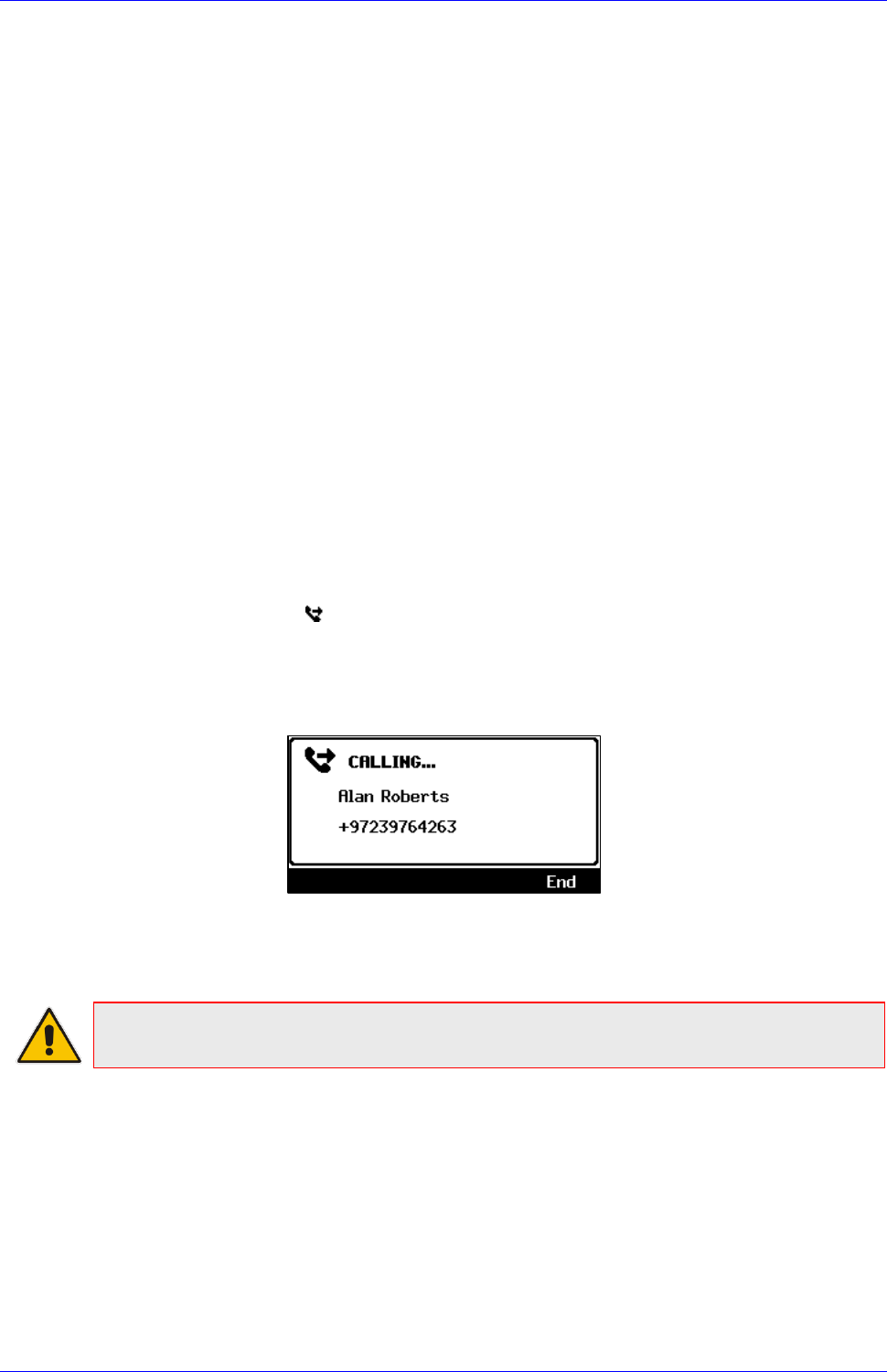
User's Manual Contents
Version 3.0.1 73 430HD and 440HD IP Phone
7 Performing Basic Operations
This section shows basic phone operations.
7.1 Using Audio Devices
You can use one of the following audio devices on the phone for speaking and listening:
Handset: To make a call or answer a call, lift the handset off the cradle.
Speaker (hands-free mode). To activate it, press the speaker key during a call or when
making a call. To deactivate it, press the speaker key again.
Headset (hands-free mode). When talking on the phone, you can relay audio to a connected
headset. To enable it, press the headset key. To disable it, press it again.
You can easily change audio device during a call.
To change from speaker/headset to handset: Activate speaker/headset and pick up the
handset; the speaker/headset is automatically disabled.
To change from handset to speaker/headset: Off-hook the handset and press the
speaker/headset key to activate the speaker/headset. Return the handset to the cradle; the
speaker/headset remains activated.
7.2 Making Calls
The phone offers multiple ways of making a call. After dialing a number:
The screen displays and the called party’s phone number or contact name if it's listed in
the phone directory
The screen displays the line extension number on which the called party is dialed
The phone plays a ring-back tone
Screen indications:
To end dialing a call before it's answered:
Press the End softkey or the speaker key.
Note: For advanced dialing using the phone directory, see Section 6.14 on page 48.
For defining a Speed Dial key, see Section 6.16 on page 56.
7.2.1 Dialing
This section shows how to dial. To dial, either (1) key-in the number on the keypad (2) press the
speaker key and enter the number (3) press the speaker key or lift the handset and enter a URL
address (e.g., host and domain name, or IP address) or alphabetical letters (e.g., tvservice).
To dial a regular-digits phone number:
1. On the keypad, key the first digit of a regular phone number; the screen displays the digit in
the NEW CALL field; key in the remaining digits. To delete (from right to left) entered digits,
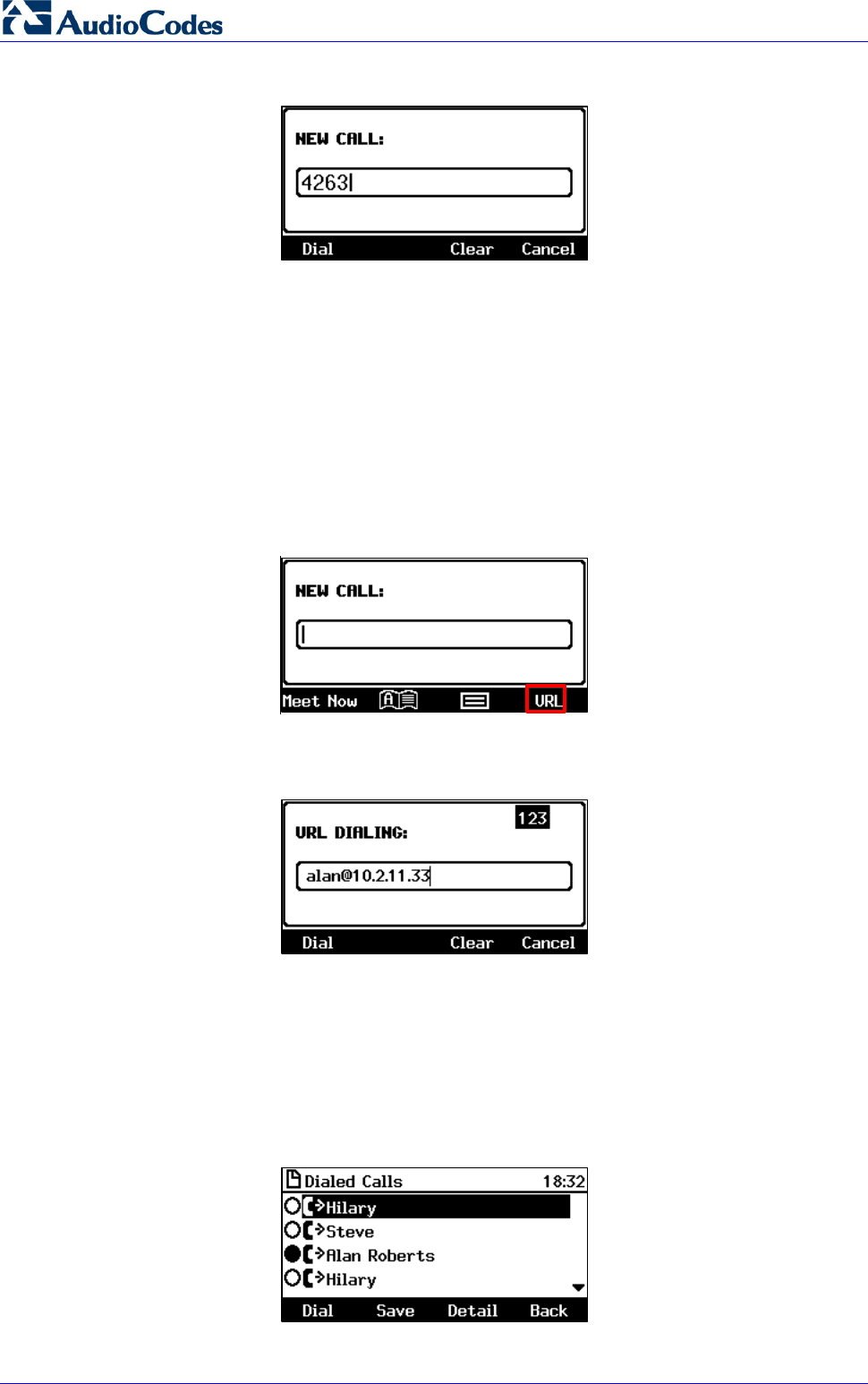
430HD and 440HD IP Phone
User's Manual 74 Document #: LTRT-11939
press the Clear softkey. To cancel the call, press the Cancel softkey.
2. Do any of the following:
• Don't do anything; dialling is automatically performed after a few seconds.
• Press the Dial softkey; dialing is performed.
• Pick up the receiver; dialing is performed.
• Press the Speaker button; dialing is performed.
• Press # (if you switched on speaker/handset/headset before keying in the digits of the
phone number); dialing is performed.
To dial a URL:
1. Press the speaker key or lift the handset; the screen displays the NEW CALL field and the
URL softkey:
2. Press the URL softkey and enter a URL address (see Section 3.4 for how to switch letters,
numerals and symbols). To delete (from right to left) entered letters/numerals/symbols, press
the Clear softkey. To cancel the call, press the Cancel softkey.
3. Press the Dial softkey.
7.2.2 Redialing
You can redial a number previously dialed.
To redial:
1. Press the REDIAL key; the Dialed Calls screen is displayed, listing in chronological order,
recently dialed numbers:
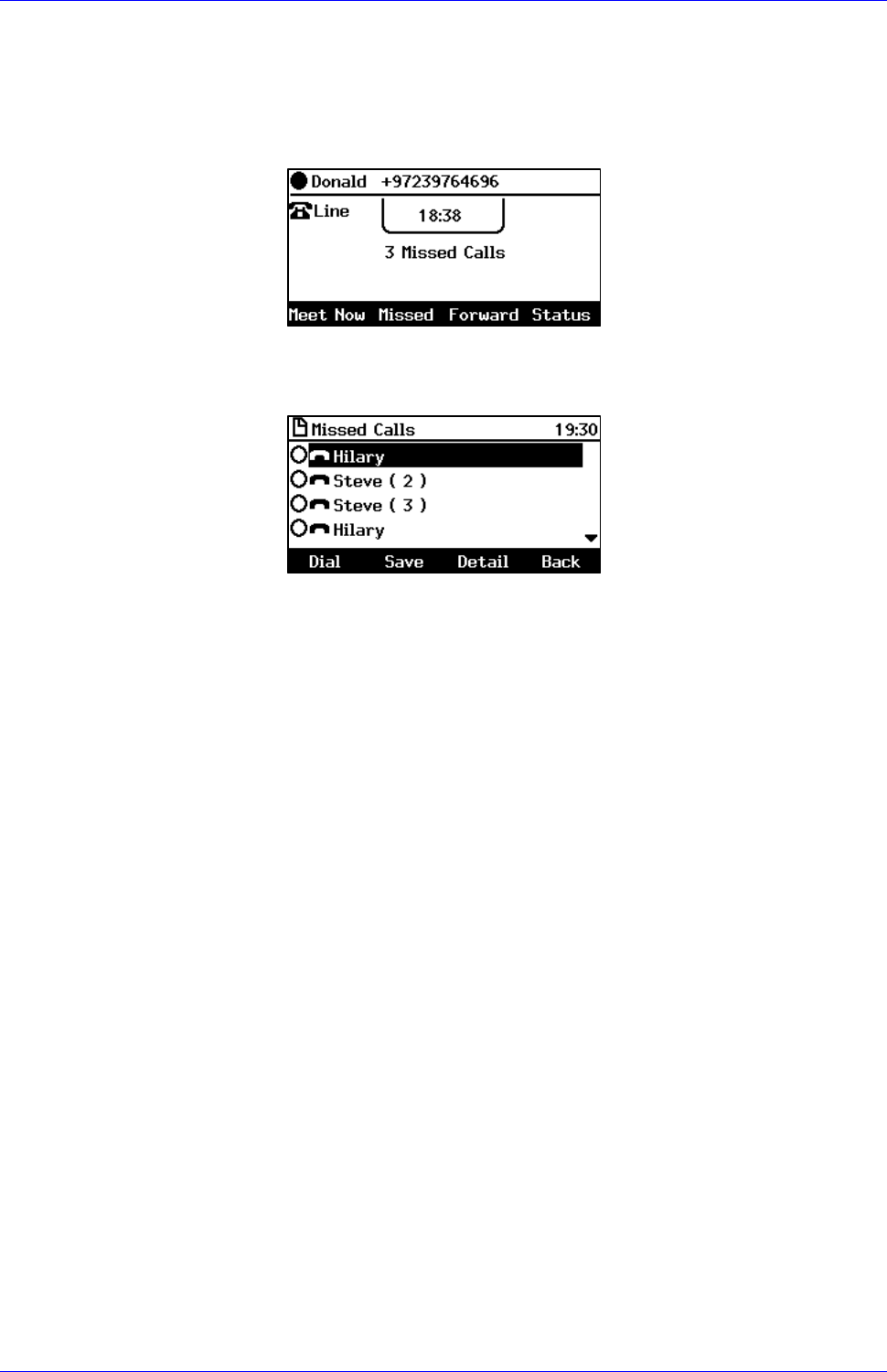
User's Manual Contents
Version 3.0.1 75 430HD and 440HD IP Phone
2. Navigate to and select the number to redial.
3. Press the Dial softkey or press the OK key.
7.2.3 Dialing a Missed Call
The phone logs all missed calls. The screen in idle state displays the number of missed calls.
To dial a missed call:
1. Press the Missed softkey; the Missed Calls screen is displayed:
2. Navigate to the missed call to dial if there are more than one listed.
3. Press the Dial softkey or press the OK key.
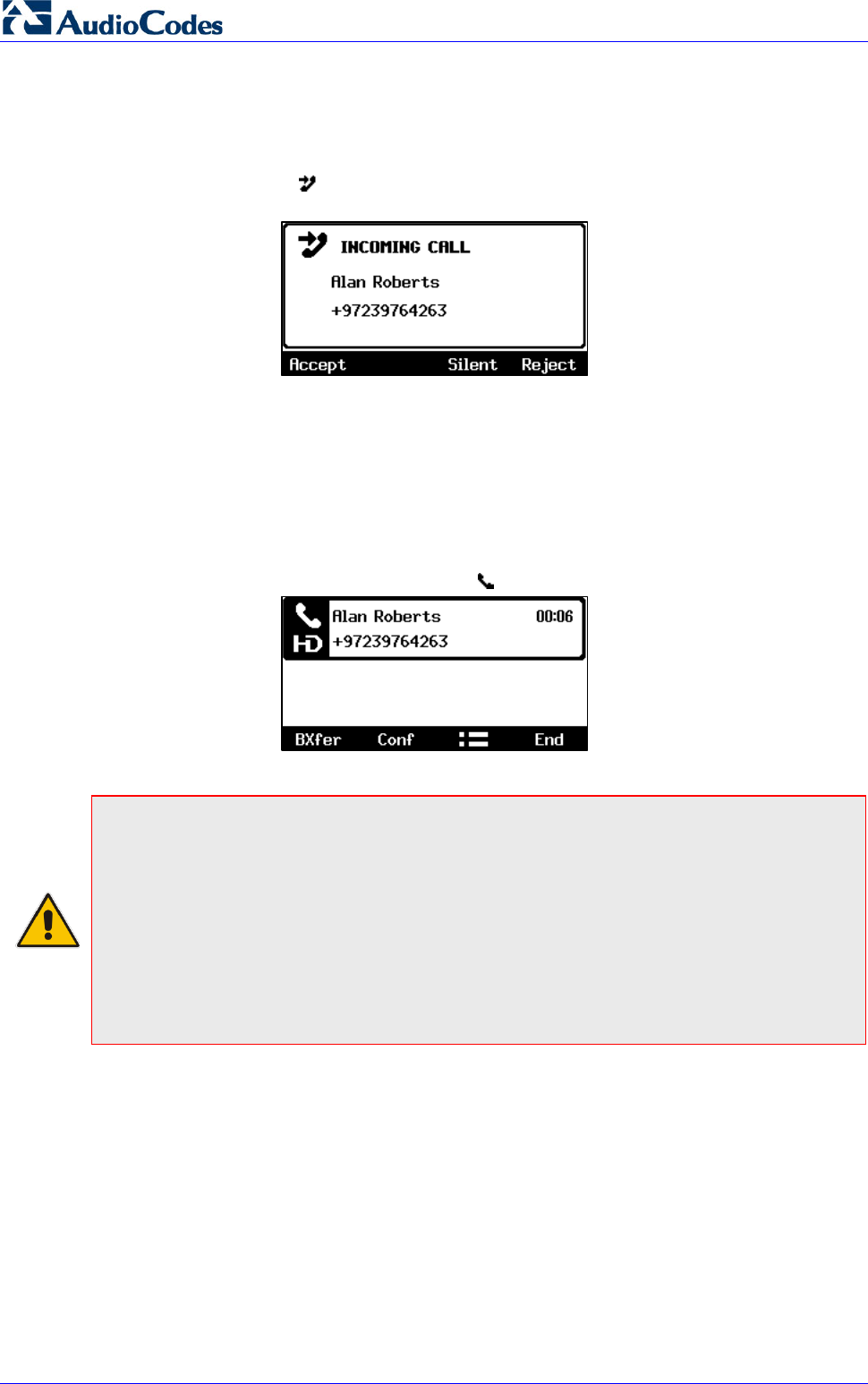
430HD and 440HD IP Phone
User's Manual 76 Document #: LTRT-11939
7.3 Answering Calls
The phone indicates an incoming call as follows:
The screen displays
together with the caller’s phone number (or contact name if listed in
the phone directory):
Phone rings.
Ring LED flashes blue.
To answer:
Pick up the handset-OR- press the headset key (ensure that the headset is connected to the
phone) -OR- press the speaker key -OR- press the Accept softkey (the speaker is
automatically activated)
When you answer, the screen displays the icon and the caller’s details and call duration:
Note:
• HD in the screen indicates a high-definition call (using a wideband voice coder).
• If a contact is in a call and they're listed in your phone's BLF list, the red BLF LED flashes
on and off to indicate that the contact is in a call. If that contact is in a call with another
contact listed in your phone's BLF list, the red BLF LEDs of both the calling contact and
the called contact flash on and off on your phone.
• When two incoming calls occur simultaneously, the names of the calling parties appear on
the screen and the adjacent incoming call icons flash. If a user is in a call and a third party
calls, the name of the calling party appears on the screen and the adjacent incoming call
icon flashes.
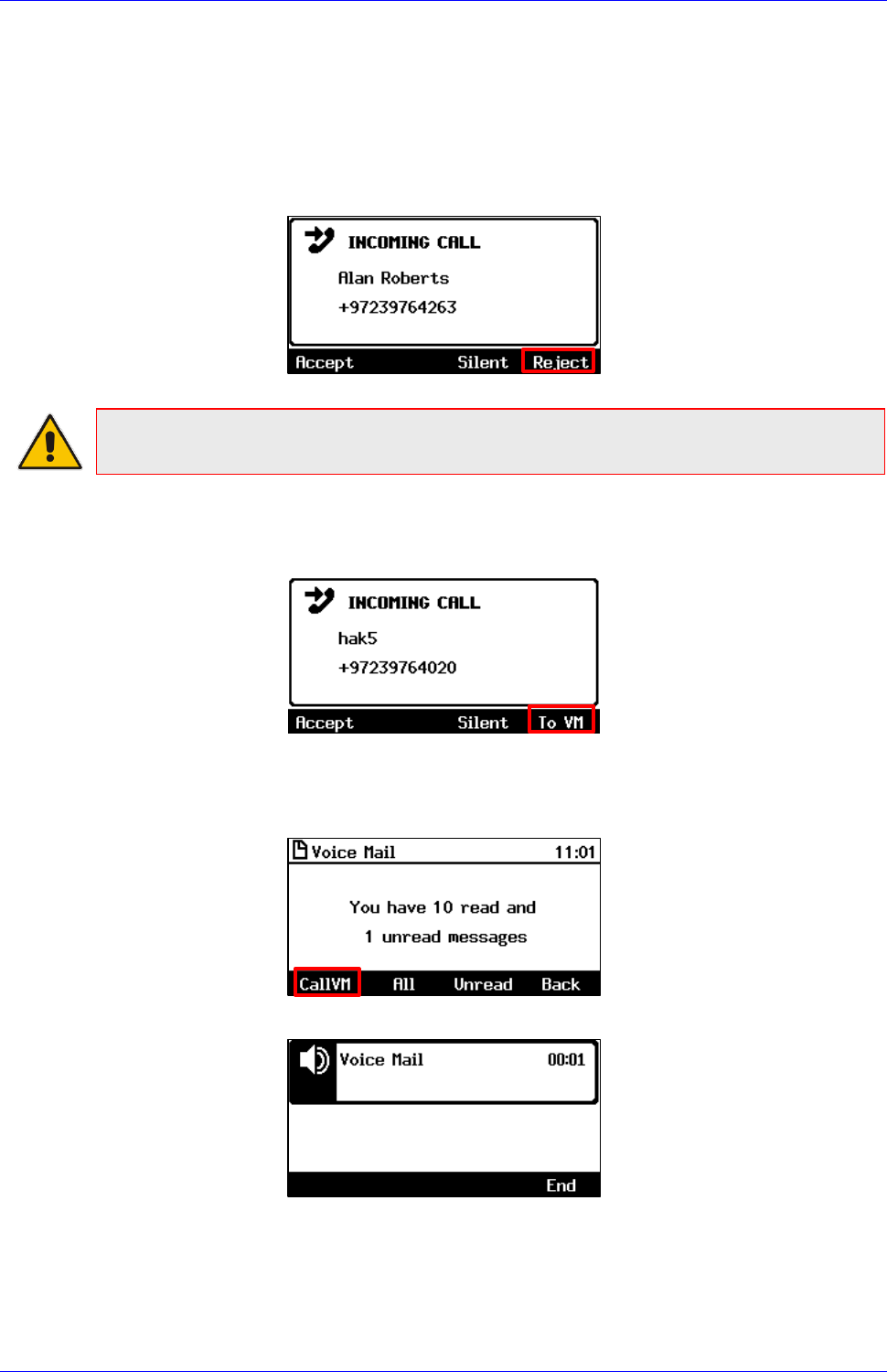
User's Manual Contents
Version 3.0.1 77 430HD and 440HD IP Phone
7.4 Rejecting Incoming Calls
You can reject an incoming call; the caller hears a busy tone from your phone if you do.
To reject an incoming call:
Press the Reject softkey.
Note: If your enterprise network administrator has activated voicemail on your phone, you
can send the incoming call directly to voicemail. See details below.
To send an incoming call to Voicemail:
When the phone rings to alert to an incoming call, press the To VM softkey that is displayed.
To view voicemail content:
1. Press the voicemail key on the phone, indicated by an envelope icon which will be
illuminated red if you have voicemail; this screen is displayed:
2. Press the CallVM softkey
3. Listen to your messages played back to you and then (optionally) press the End softkey.
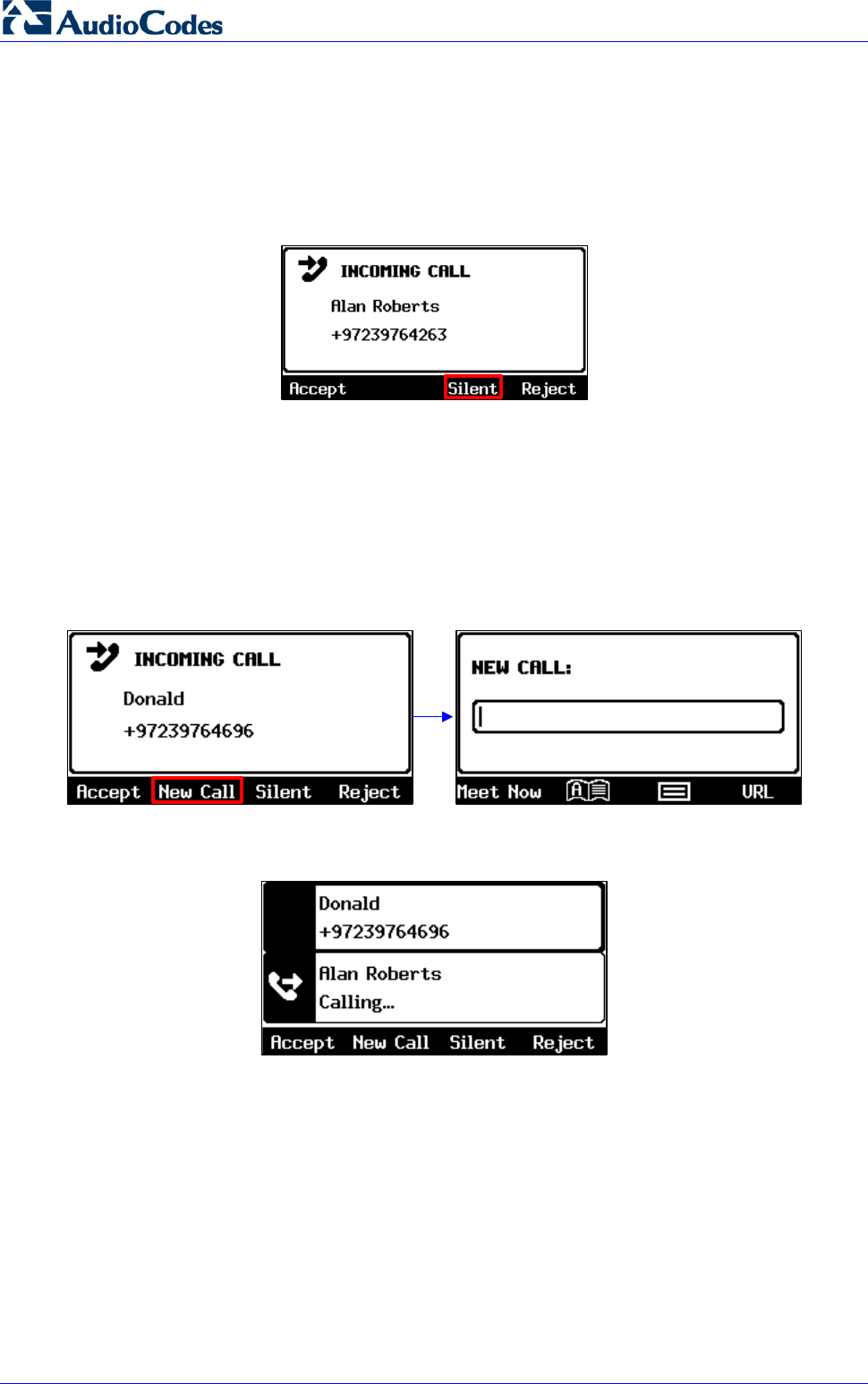
430HD and 440HD IP Phone
User's Manual 78 Document #: LTRT-11939
7.5 Silencing Incoming Calls
You can silence an incoming call's ringing; the caller hears normal ringing but no answer.
To silence the ringing of an incoming call:
Press the Silent softkey.
Answer a silenced call by pressing the Accept softkey or picking up the handset.
7.6 Making a New Call Even Though a Call is Coming in
Users can make a new call even though a call is coming in. This is typically necessary when it is
more important and more pressing to make a new call than to accept the incoming call.
To make a new call when a call is coming in:
1. In the INCOMING CALL (Donald) screen, press the New Call softkey:
2. In the NEW CALL screen, enter the number of the destination to which to call, and press the
then-enabled Dial softkey. If necessary, you can clear digits entered / cancel the new call.
3. When the called party answers, you can toggle to the calling party and reject or accept them.
7.7 Ending an Established Call
You can end an established call.
To end an established call:
Return the handset to the phone cradle if it was used to take the call -or- press the headset
key -or- press the speaker key -or- press the End softkey.
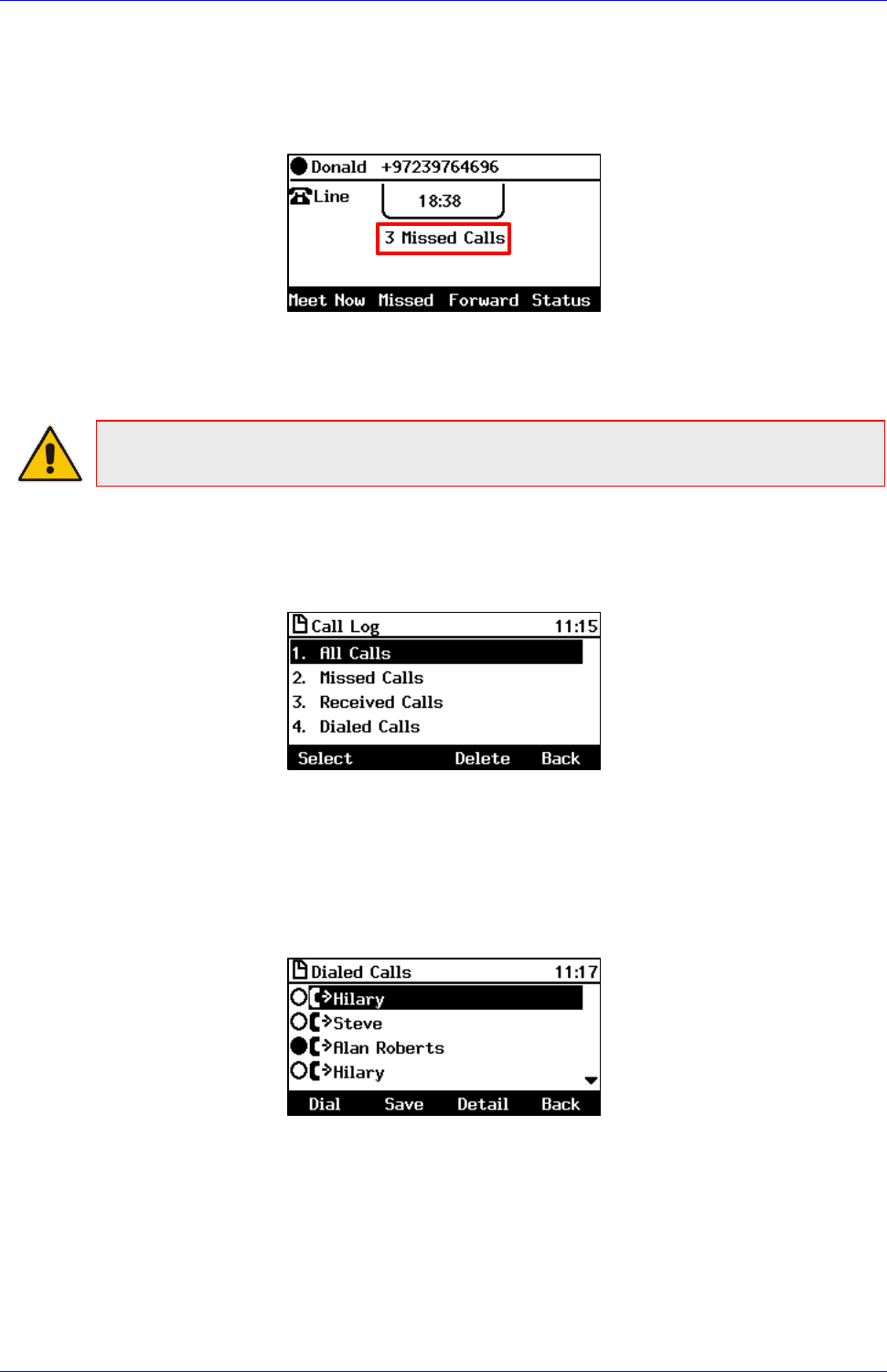
User's Manual Contents
Version 3.0.1 79 430HD and 440HD IP Phone
7.8 Viewing Missed, Received and Dialed Calls
The phone logs calls missed, received and dialed. In idle state, the screen displays the number of
missed calls (if any). In the example below, 3 missed calls are indicated.
To view missed calls:
Press the Missed softkey.
Note: After viewing, the indication disappears from the screen. The next time a call is missed,
the indication will reappear.
To view call history:
1. Access the Call Log screen (MENU key > Call Log).
2. In the Call Log screen, navigate to and select the call log you require.
• All Calls = calls that were missed, received and dialed
• Missed Calls = calls that were not answered
• Received Calls = the most recently answered numbers
• Dialed Calls = the most recently dialed numbers
3. Navigate to the option you want and press the Select softkey; a list of the logged calls is
displayed, for example, Dialed Calls:
4. Press the softkey you need:
• Dial = dials the number of the selected logged entry.
• Save = saves the related information about the call entry in the personal directory (for
adding a contact in the directory, see Section 6.14 on page 48).
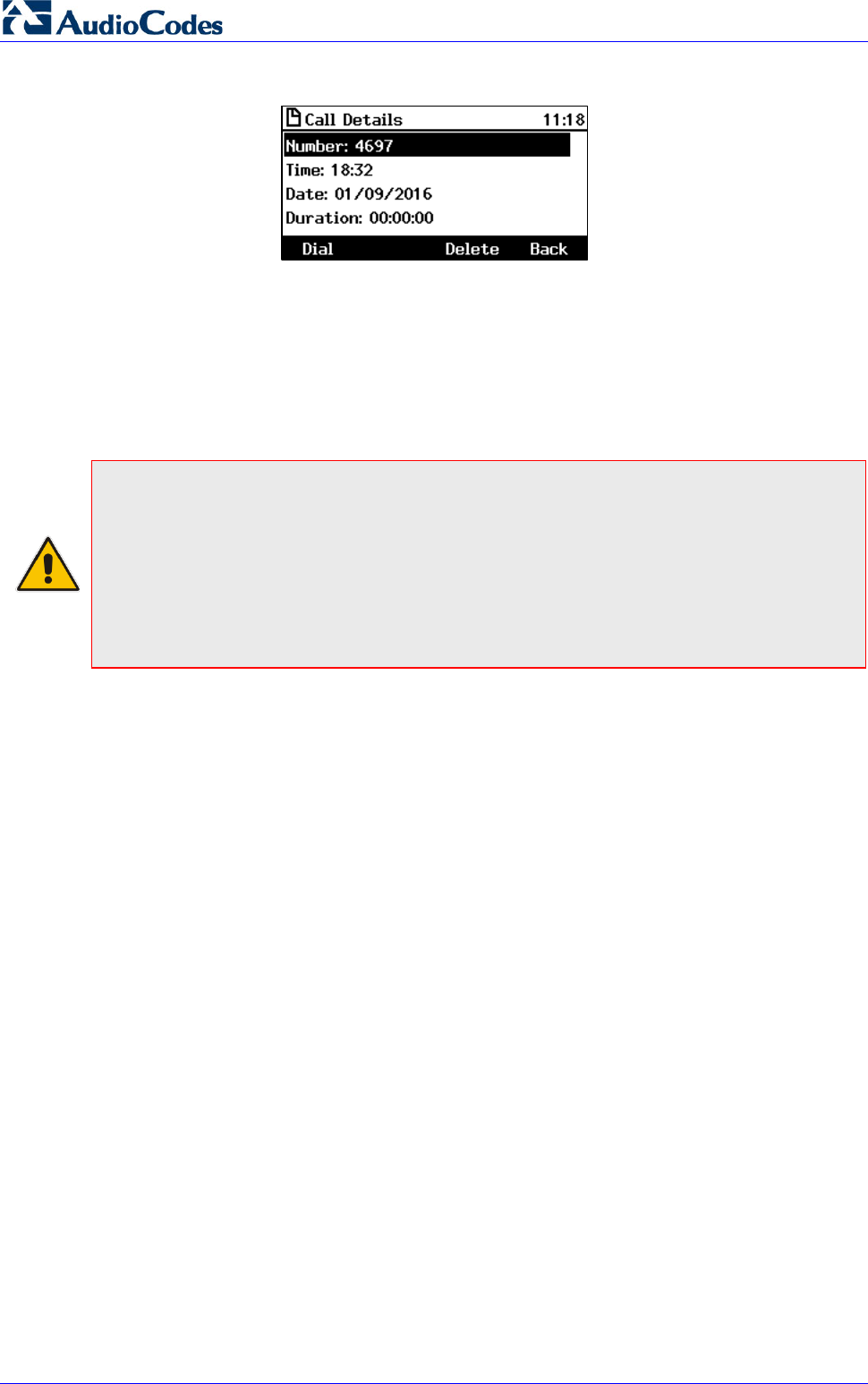
430HD and 440HD IP Phone
User's Manual 80 Document #: LTRT-11939
• Detail = accesses the Call Details screen, which displays details of the call entry:
The Call Details screen displays the following logged call information:
• Number = phone number logged
• Time = the time the call was logged
• Date = the date on which the call was logged
• Duration = the duration of the call
Notes:
• The call history lists are stored from the newest to oldest entries. The maximum number of
entries for each call history type is 200. Once this maximum is attained, the oldest entry is
deleted and replaced with the new entry.
• The call history lists are saved on a daily basis. In the case of a power outage, some of the
received information may be lost.
• If you view missed calls by pressing the Missed softkey, the missed calls notification no
longer appears on the screen and reappears the next missed call.
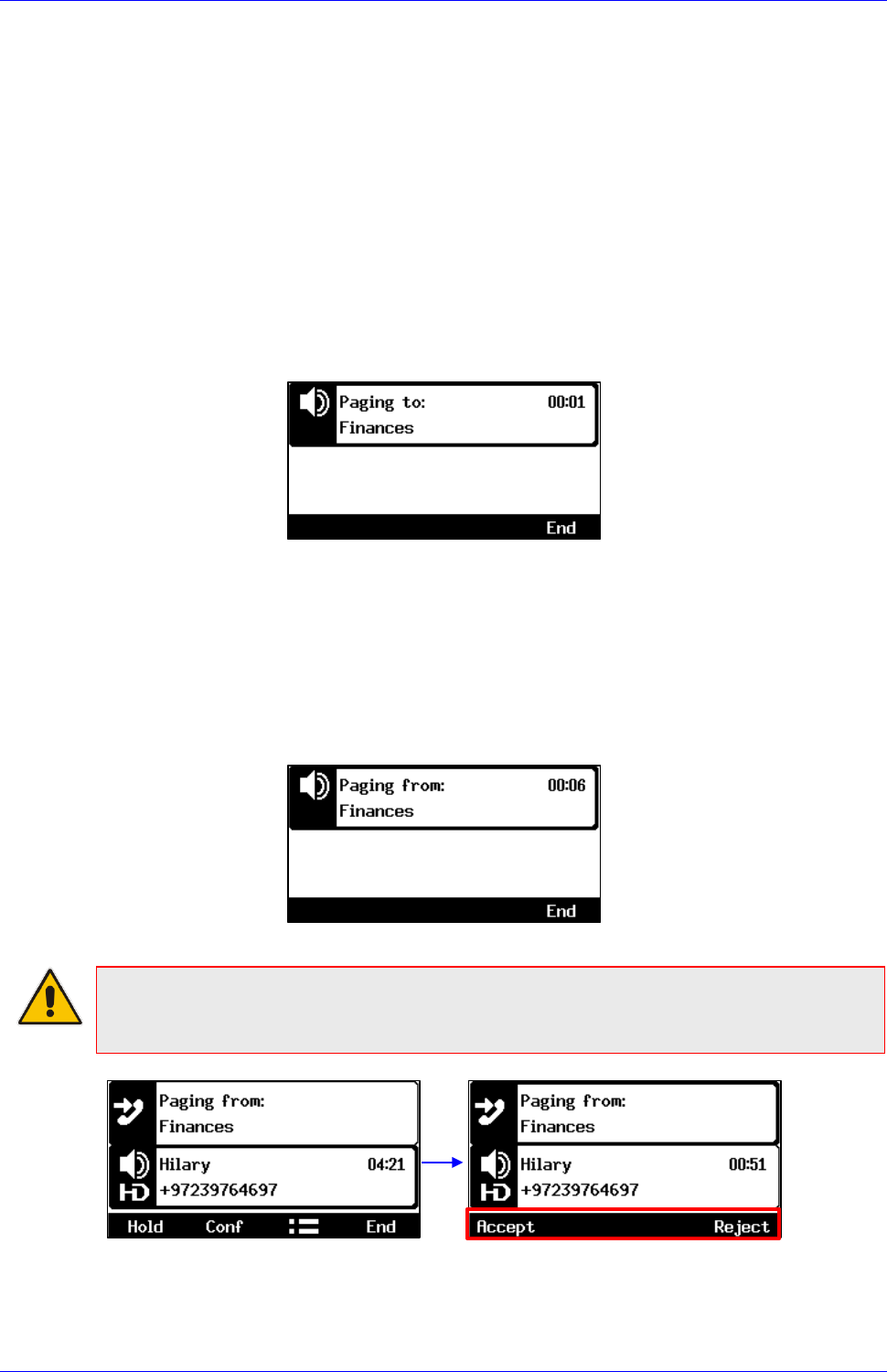
User's Manual Contents
Version 3.0.1 81 430HD and 440HD IP Phone
7.9 Paging
You can page others in your group and they can page you after configuring the group and the
paging dial on the phone.
For detailed information on setting up a paging group, see Sections 6.17 and 6.19.
7.9.1 Performing Outgoing Paging Calls
You can page others in your group. You can use the speaker, handset or headset as the audio
device.
To page others in your group:
1. Press the key that you assigned to the group for paging (Function Key or Programmable
Key); your phone displays this:
2. Pick up the receiver and make the announcement (or talk directly into the speaker).
7.9.2 Receiving Incoming Paging Calls
Others in your group can page you.
To receive a paging call from another in your group:
1. View in your phone's screen which group (member) is paging you and listen for the incoming
paging call:
Note: If you're in a call when the paging call comes in and the 'Barge-in' feature was disabled
(default) by your IP Administrator, you're prompted to accept/reject the paging call (see
below).
2. Navigate from the regular call to the paging call and then press the Accept softkey to hear it;
the regular call you were in is put on hold.
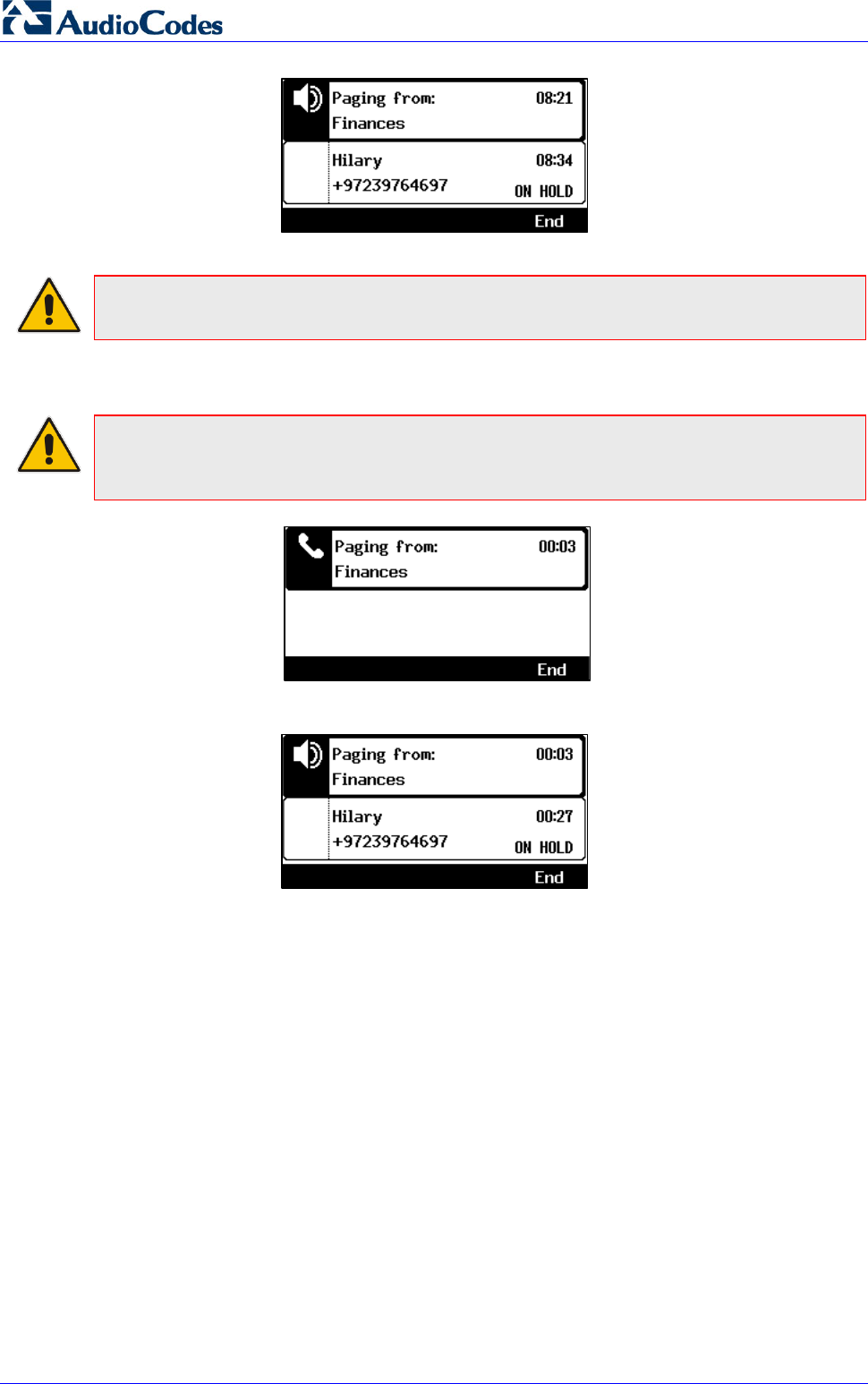
430HD and 440HD IP Phone
User's Manual 82 Document #: LTRT-11939
Note: If you would have pressed the Reject softkey, you would have continued in the regular
call and not heard the paging call.
3. Press the Resume softkey when the paging call ends.
Note: If you're in a call when the paging call comes in and the 'Barge-in' feature was enabled
by your network administrator, the regular call is automatically eclipsed by the paging call
(see below).
4. Press the End softkey (optional); the regular call is put on hold.
5. Press the Resume softkey; the regular call is resumed.
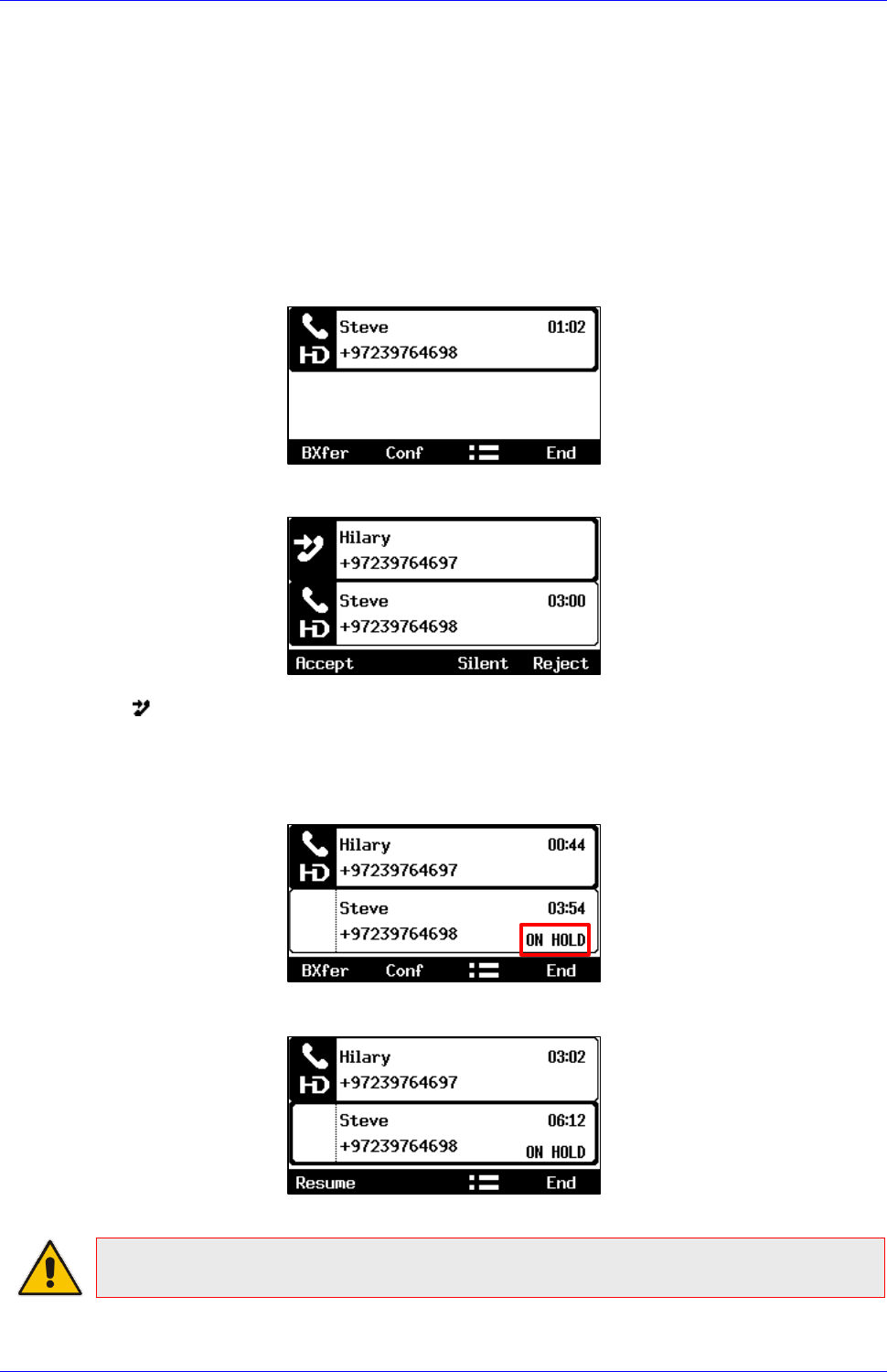
User's Manual Contents
Version 3.0.1 83 430HD and 440HD IP Phone
8 Performing Advanced Operations
This section shows how to perform advanced operations.
8.1 Answering Waiting Calls
You can accept a call on an extension on which there already is an active call.
To answer a waiting call:
a. A call with Steve is in progress
b. A call comes in from Hilary
= call waiting
To answer Hilary:
1. Press the Accept softkey; the waiting call from Hilary is answered; the previous call from
Steve is put on hold:
2. To toggle between calls, press the navigation control's upper or lower rim.
Note: To enable / disable the call waiting feature, see Section 6.3 on page 35.
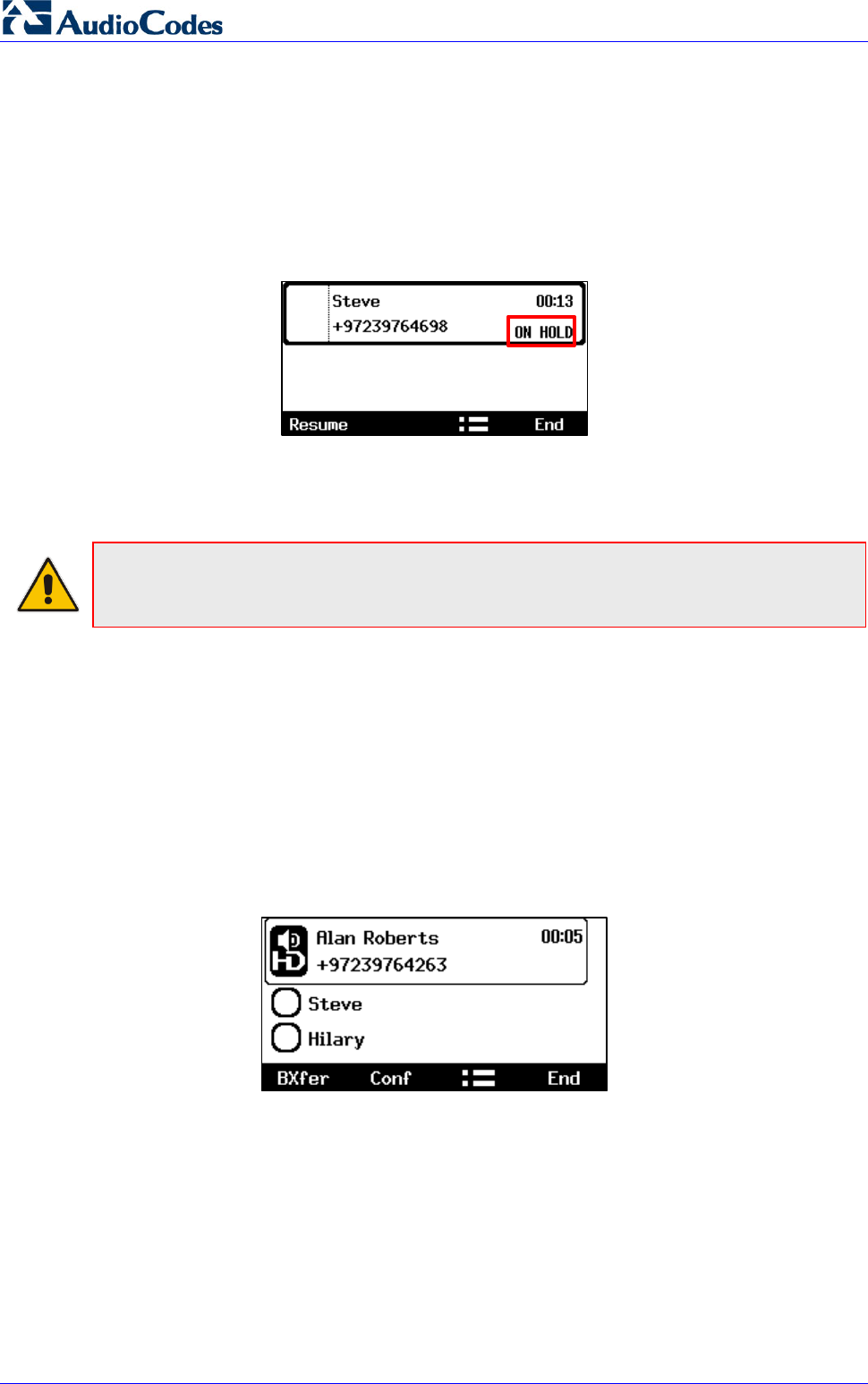
430HD and 440HD IP Phone
User's Manual 84 Document #: LTRT-11939
8.2 Placing Calls On Hold
You can place a call on hold in order to answer an incoming call (see Section 8.1 on page 83) or
to make another call. The party put on hold will hear music played (Music on Hold (MOH)).
To place a call on hold:
Accept an incoming call and then press the HOLD key on the keyboard or press the Hold
softkey; the call is put on hold:
To retrieve a call on hold:
Press the HOLD key again -OR- press the Resume softkey.
Note: When using the handset in a call, if the handset is on-hooked after putting the call on
hold, the call is not disconnected and the audio is switched to the speaker. For the call to be
disconnected, as it was in earlier versions, refer to your network administrator.
8.3 Handling Multiple Incoming Calls
The phone is capable of handling up to eight concurrent calls per line. Multiple calls can be put on
hold and you can switch between them. This feature is important for front desk personnel.
To manage multiple incoming calls:
If a call comes in from Hilary and then after it, a call comes in from Steve, when you answer
Steve, Hilary is put on hold.
If a third call comes in, this one from Alan, and you answer it, Steve is also put on hold, so
now both Hilary (caller 1) and Steve (caller 2) will be on hold.
To toggle between callers:
Press the upper or lower rim of the control button to navigate from one caller to another.

User's Manual Contents
Version 3.0.1 85 430HD and 440HD IP Phone
8.4 Calling a Contact from 'Favorities'
You can directly call from the phone any contact that is listed in your Skype for Business client's
'Favorites'.
To call a contact listed in 'Favorities':
1. Press the CONTACTS key.
2. Navigate to a contact to call and then press the Dial softkey or the OK hard key.
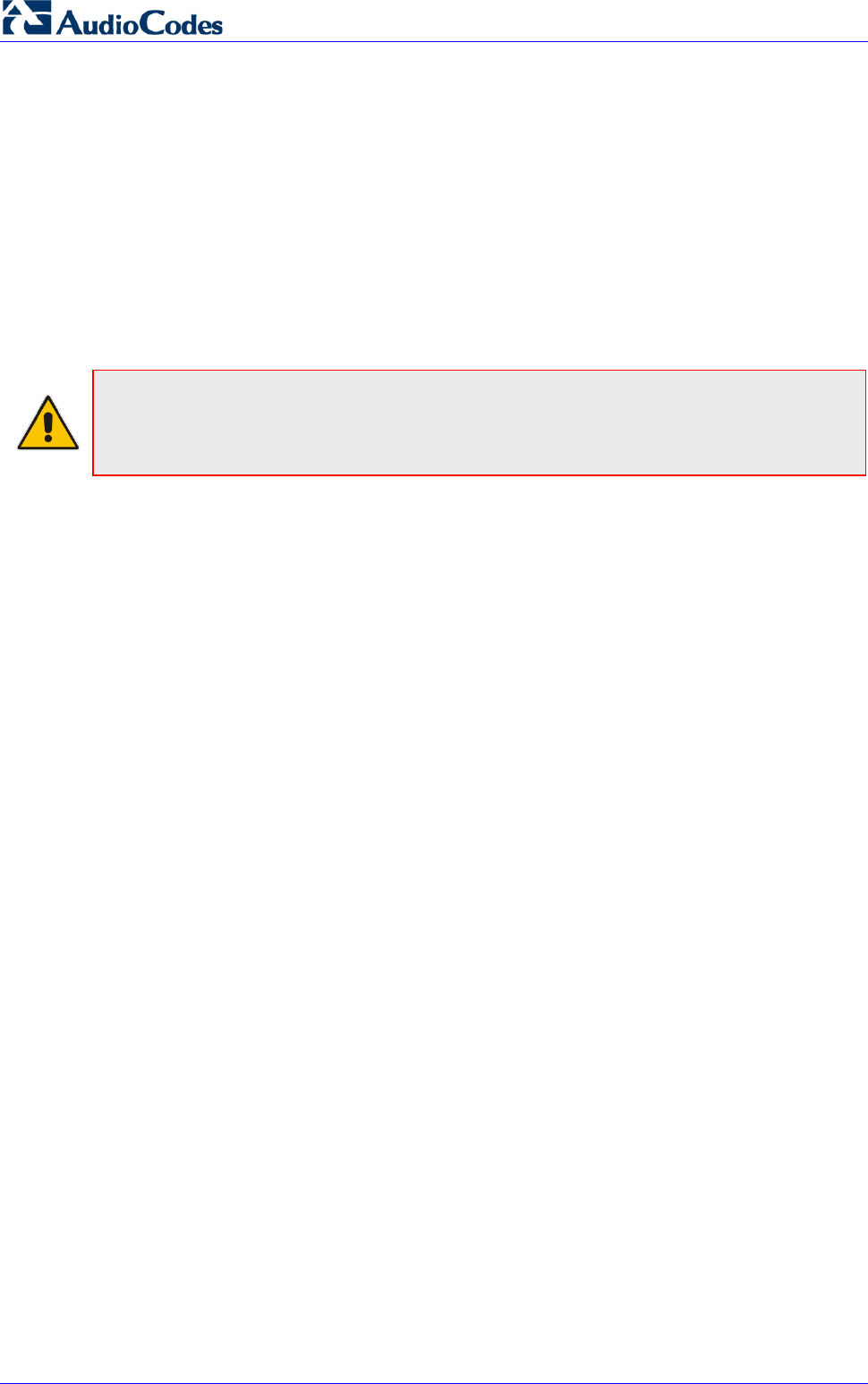
430HD and 440HD IP Phone
User's Manual 86 Document #: LTRT-11939
8.5 Using a Speed Dial to Call
You can press a Function Key or a Programmable Key, that you defined as a Speed Dial, to
quickly place a call. To define a Function Key as a Speed Dial, see Section 6.16. To define a
Programmable Key as a Speed Dial, see Section 6.17.
To place a call using a Speed Dial:
Press a Function Key (1-12 on the right side of the phone) that you defined as a Speed Dial;
the phone dials the defined contact's number -OR-
Press a Programmable Key (the six flanking the screen with the exception of the uppermost
left key) that you defined as a Speed Dial; the phone dials the defined contact's number.
Note: If you haven't defined Function Key #8 (for example) as a Speed Dial and you press it,
the screen displays the Function Key #8 screen enabling definition. If you haven't defined a
Programmable Key and you long-press it, the Line Key screen is displayed enabling
definition. See Section 6.16 and Section 6.17.
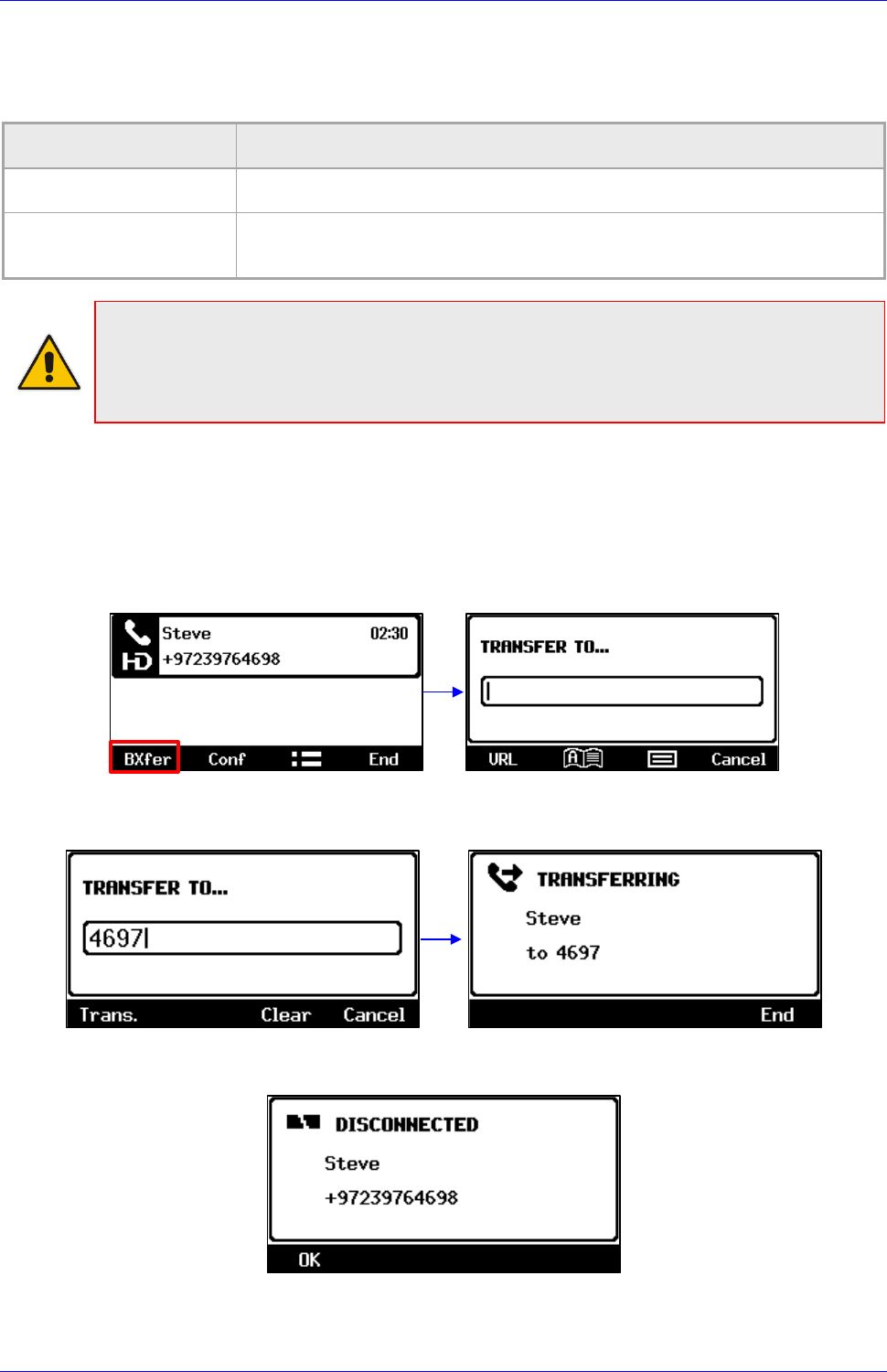
User's Manual Contents
Version 3.0.1 87 430HD and 440HD IP Phone
8.6 Transferring Calls
You can transfer a call to another party using blind transfer (default) or consultative transfer.
Transfer Description
Blind Connects another party to a third party before the third party answers.
Consultative Connects another party to a third party after the third party answers and
agrees to take the call from the second party.
Note:
• The hard TRANSFER key on the phone by default performs a blind transfer.
• Your network administrator can change the key's functionality to consultative transfer.
See the Administrator's Manual for more information.
8.6.1 Performing a Blind Transfer
You can transfer a call to a destination party without consulting them.
To perform a blind transfer:
1. Steven asks you – Donald - to transfer him to Hilary. Press the TRANSFER hard key on the
phone or press the BXfer softkey.
2. In the TRANSFER TO screen that opens, enter Hilary's number (4697) and then press the
Trans. softkey.
3. Hilary's phone rings. When she picks up, your phone is disconnected from Steve who is
transferred to Hilary:
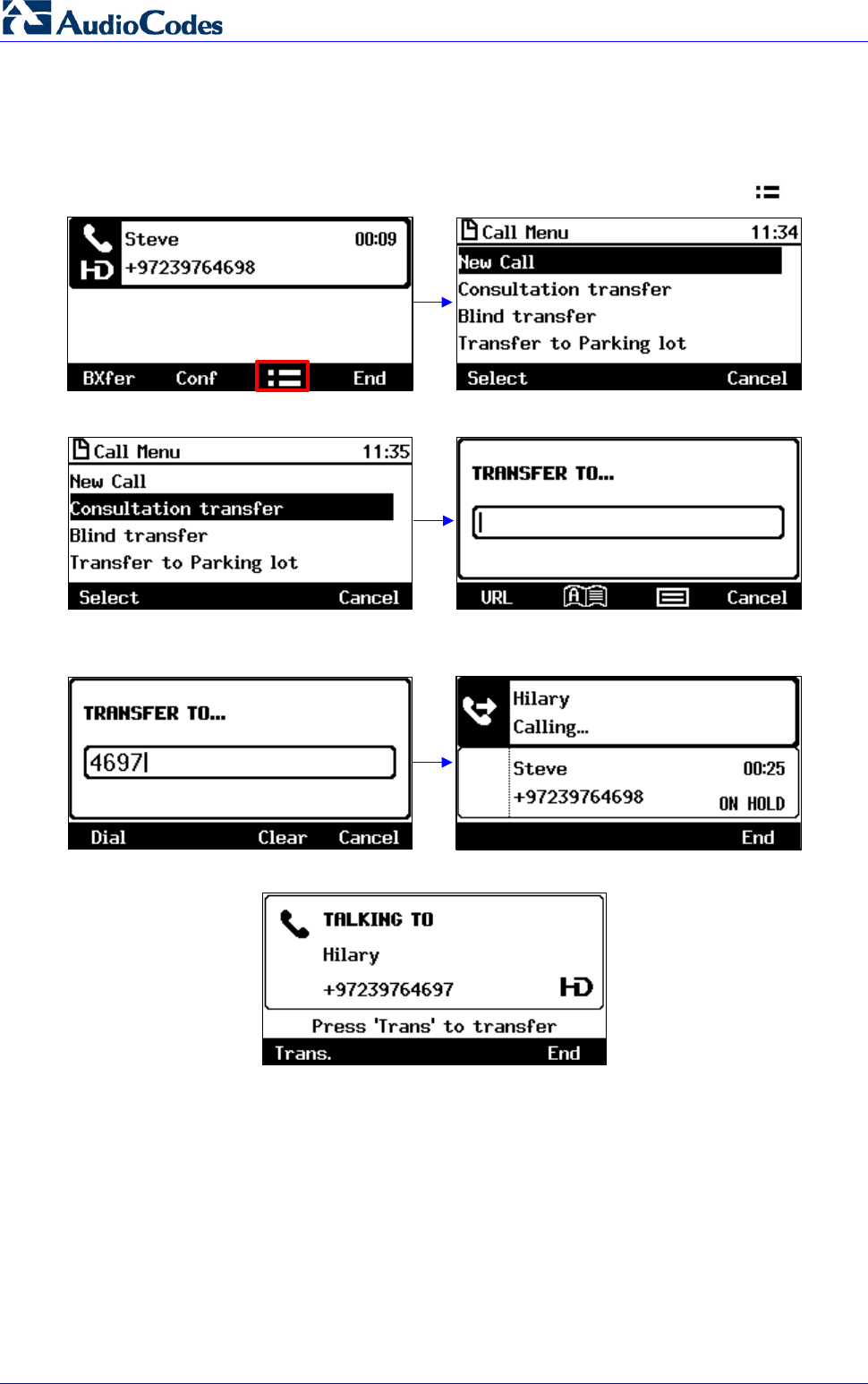
430HD and 440HD IP Phone
User's Manual 88 Document #: LTRT-11939
8.6.2 Performing a Consultative Transfer
You can consult with a party before transferring the call to them.
To perform a consultative transfer:
1. In a call with Steve, he asks you – Donald - to transfer him to Hilary. Press the softkey.
2. Scroll down in the Call Menu to select Consultation transfer.
3. In the TRANSFER TO field, enter Hilary's number and press the Dial softkey; Hilary's phone
rings and Hilary answers:
4. Press the Trans. Softkey or press the TRANSFER hard key on the phone.
Hilary is connected to Steve.
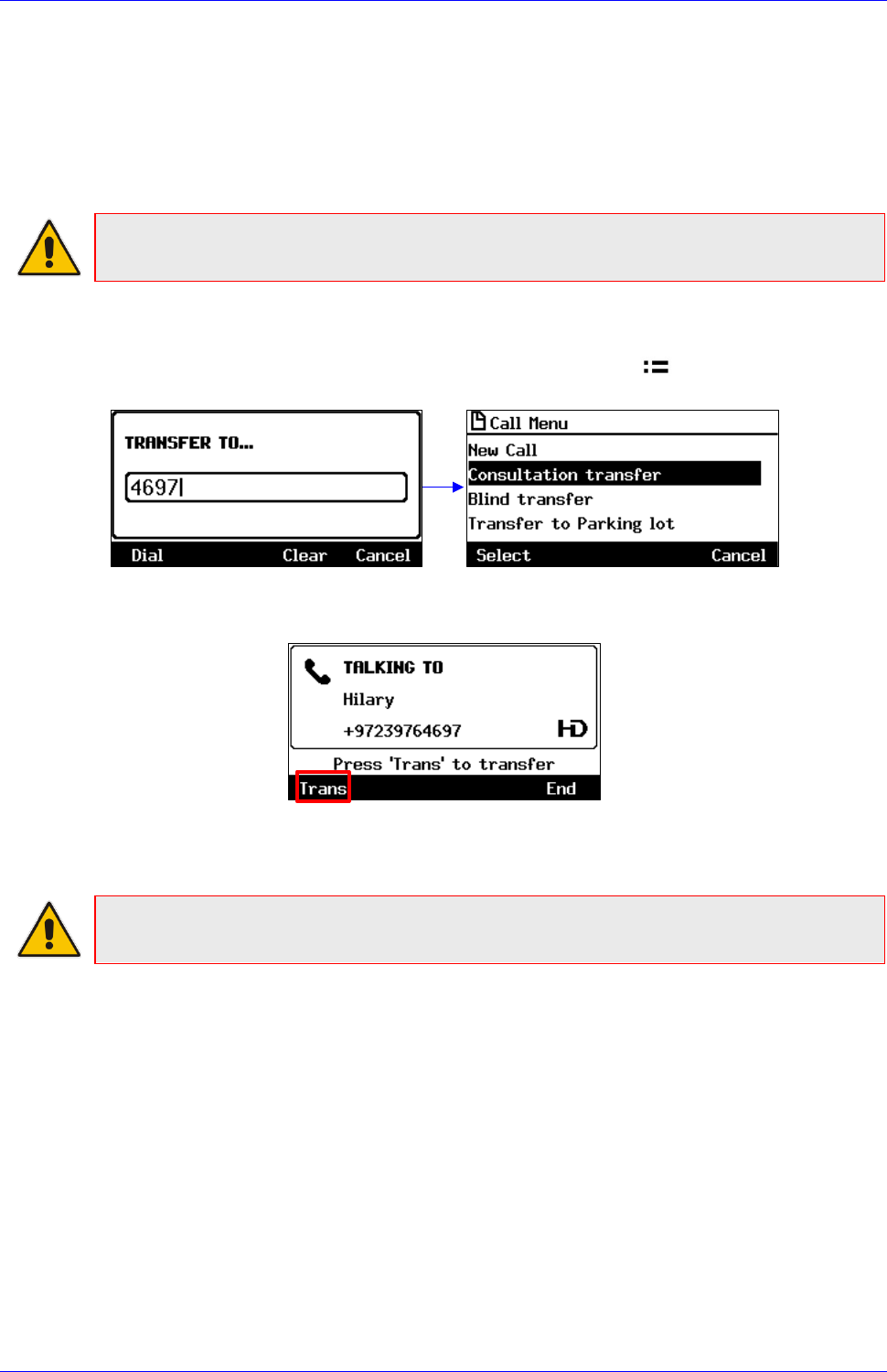
User's Manual Contents
Version 3.0.1 89 430HD and 440HD IP Phone
8.6.3 Performing a Semi-Consultative Transfer
Instead of consulting extensively with the destination party after they answer, you can transfer the
call when they say hello. Semi-consultative transfer allows you to identify the voice of the
destination party before transferring the call to them, without asking them whether they agree to
take the call or not.
Note: The feature is by default disabled. For the feature to be available, your enterprise
network administrator must enable it on the phone. See the Administrator's Manual for details.
To perform a semi-consultative transfer:
1. Steve asks you – Donald - to transfer him to Hilary. Press the softkey, as shown above,
and select the Consultation transfer option:
2. Enter Hilary's number and press the now-enabled Dial softkey. Steve is put on hold. MoH is
played to him.
3. When Hilary answers, press the Trans softkey or press the TRANSFER hard key on the
phone; Hilary is connected to Steve.
Note: If your network administrator has not enabled the feature, the Trans softkey will not be
displayed.
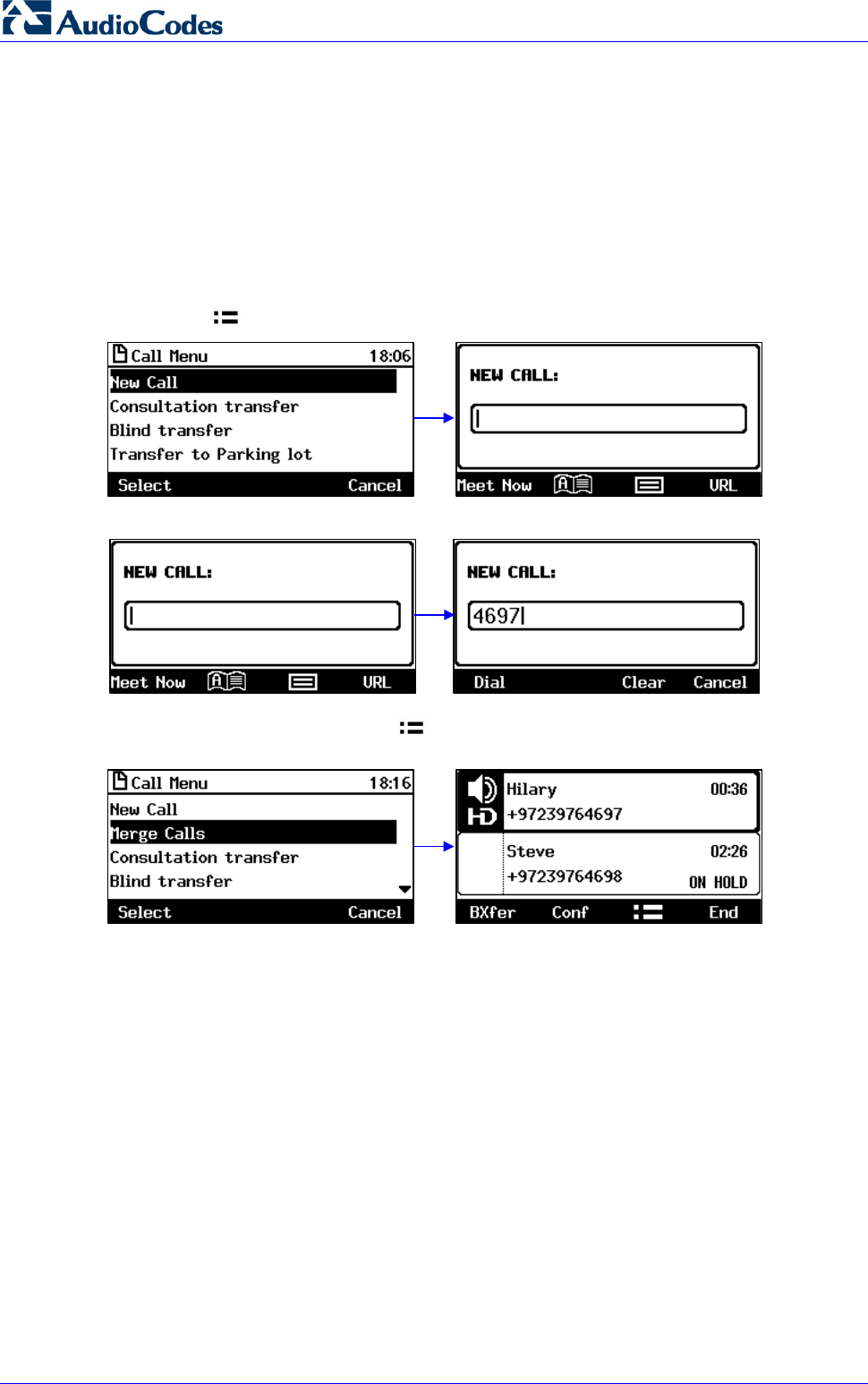
430HD and 440HD IP Phone
User's Manual 90 Document #: LTRT-11939
8.6.4 Merging Calls
You can merge two separate calls into one conference call if you're in a call and you want to add
another participant to the established call.
Merging therefore is in effect similar to adding a participant to a conference. It can be performed
via the phone's menu softkey or via the Skype for Business client if the user is paired.
To merge calls:
1. While in a call with Steve, you (Donald) decide you want to add Hilary to the conversation.
Press the softkey and then select New Call.
2. In the New Call field, enter Hilary's number and press the now-enabled Dial softkey.
3. When Hilary answers, press the softkey and then select Merge Calls; all three of you
are now in the conversation.
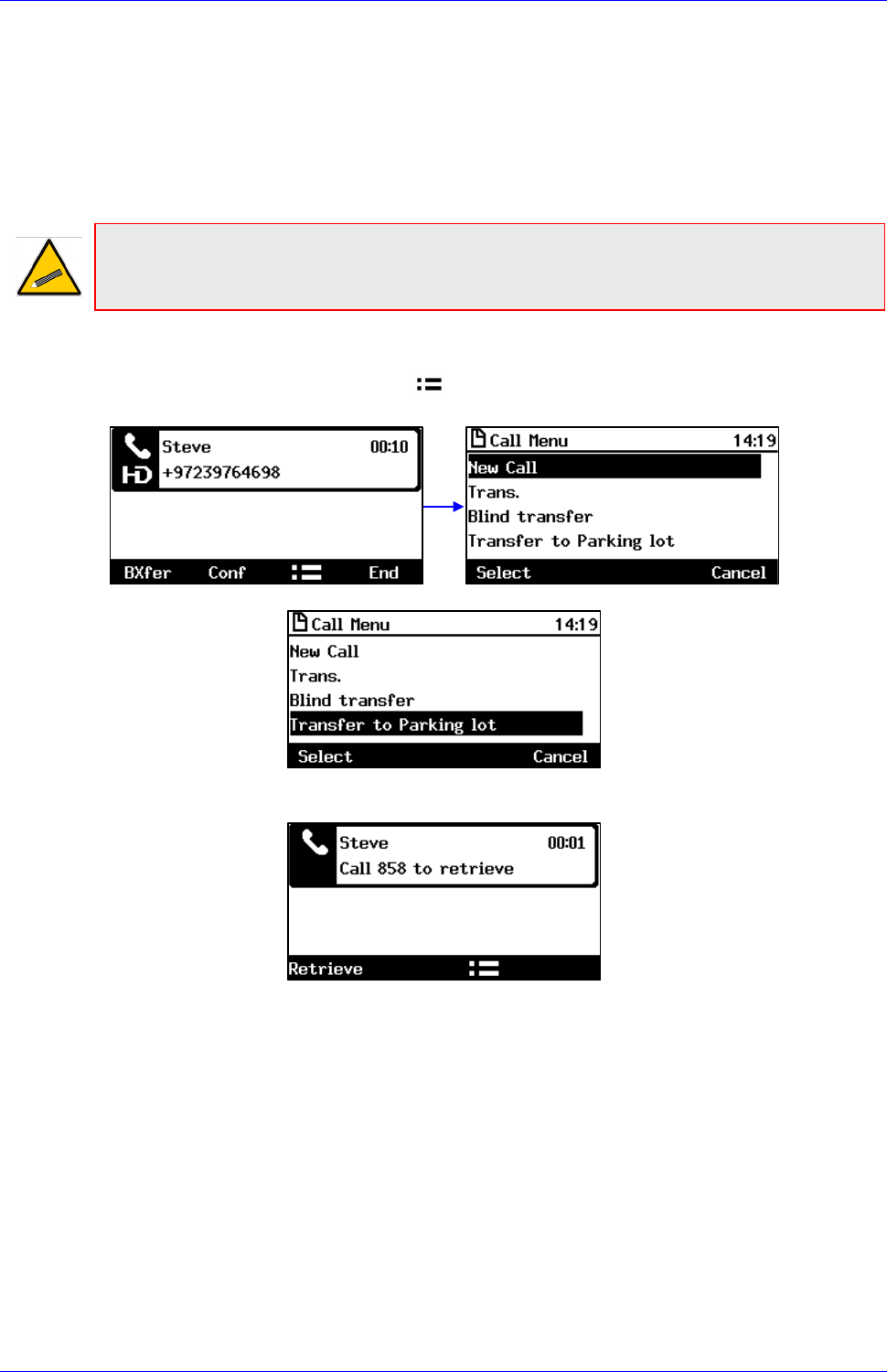
User's Manual Contents
Version 3.0.1 91 430HD and 440HD IP Phone
8.7 Parking a Call
You can park a call, i.e., you can transfer a call to a "parking lot" for it to be picked up on any
other phone in the enterprise by a party who must dial a retrieval number in order to retrieve it on
that phone. The retrieval number is configured in the Skype for Business server's parking lot
parameter. Your network administrator can change the retrieval number if required.
Tip: Don't park a call unless you know precisely who you want to answer it. If you park a call,
it can be answered by anyone in the enterprise listed in the Skype for Business server's
parking lot parameter.
To park a call:
1. When you're in the call, press the softkey and then navigate to and select the Transfer
to Parking Lot option:
The screen notifies you of the retrieval number to dial to retrieve the call on another phone:
2. On another phone, dial the retrieval number (858 in the example above); the call is pulled to
that phone.
3. You can pull the call back to the phone which it originally was on by pressing the Retrieve
softkey.
8.8 Configuring Group Call Pickup (GCP)
GCP capability lets an employee take a call coming in on a colleague's phone, on their phone. If
an employee in an open space hears a colleague's phone ringing and knows that colleague is
unavailable, instead of having the call go unanswered and routed to voicemail, the call can be
redirected and answered by the available employee. Only employees configured in the Skype for
Business server's GCP parameter can pick up the call. Consult your network administrator if
required.
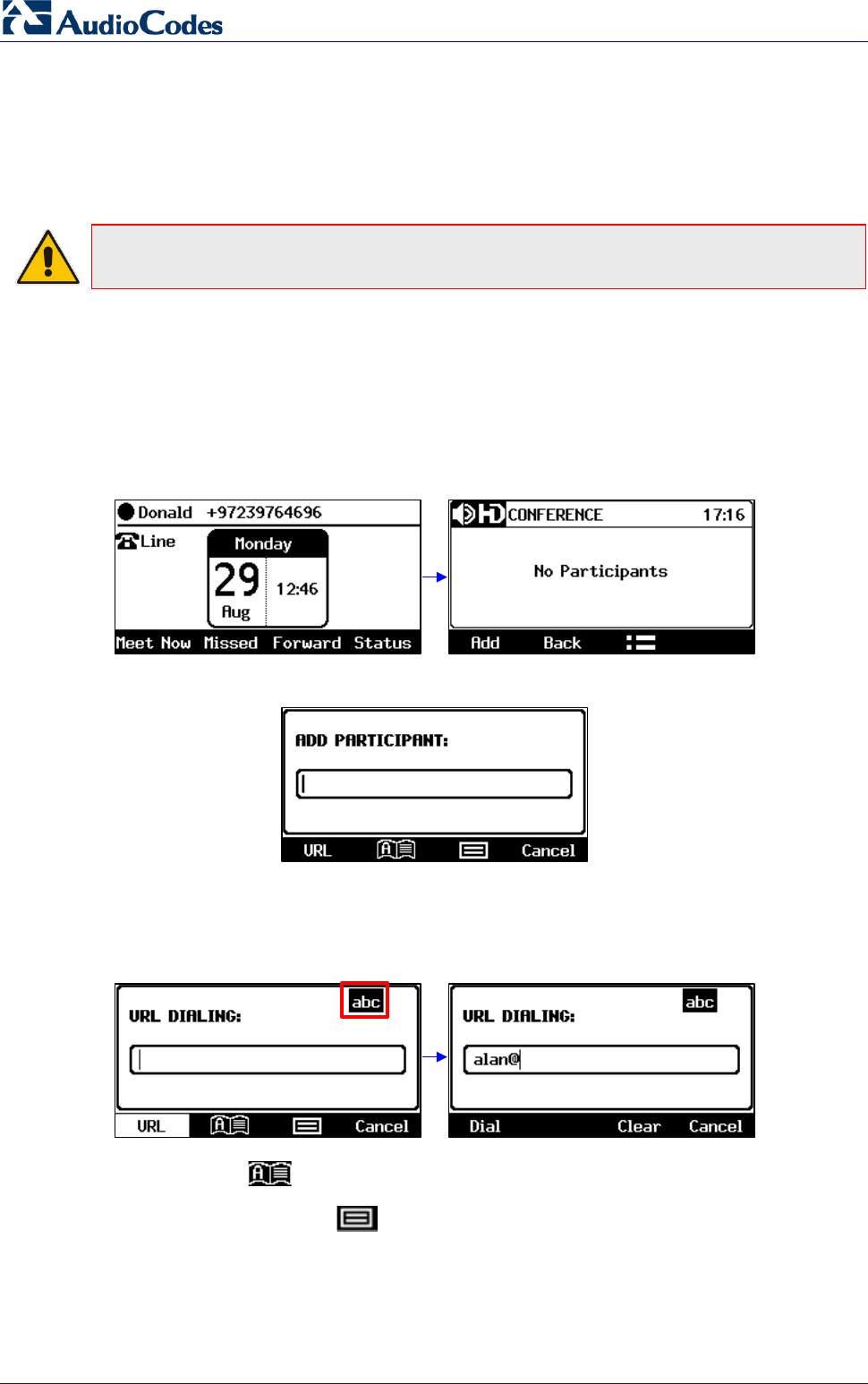
430HD and 440HD IP Phone
User's Manual 92 Document #: LTRT-11939
8.9 Initiating a Multi-Party Skype for Business Remote
Conference
A multi-party call conference based on the Skype for Business server (remote conference) can be
initiated from the phone.
Note: This section describes conferencing when Better Together over Ethernet (BToE) is not
installed. See Section 8.2.4 for information about conferencing when BToE is installed.
In versions preceding 3.0, supported conference capability was locally based (phone based). As
of version 3.0, the phone of the conference initiator uses CCCP (Centralized Conference Control
Protocol) to establish the conference. The feature is integrated with Microsoft Exchange so in an
email invitation to join a Skype for Business meeting, you can click a Join link.
To initiate a conference:
1. In the phone's idle screen, press the Meet Now softkey; the CONFERENCE screen opens
indicating No Participants.
3. Press the Add softkey; the ADD PARTICIPANT screen opens.
4. Enter the participant's phone number. Either:
• Press the URL softkey, use the alphanumerical selection displayed to enter the
participant's URL (see Section 3.4 for more information), and then press the Dial
softkey.
• Press the softkey; the contacts added to 'Favorites' in the Skype for Business
client are displayed by default. If the contact you are searching for is not in your
'Favorites', press the softkey and navigate in the Corporate Directory, Personal
Directory, Outlook Contacts or Others to find them (see Sections 6.14 and 6.15 for more
information). After finding them, select and then press the Dial softkey.
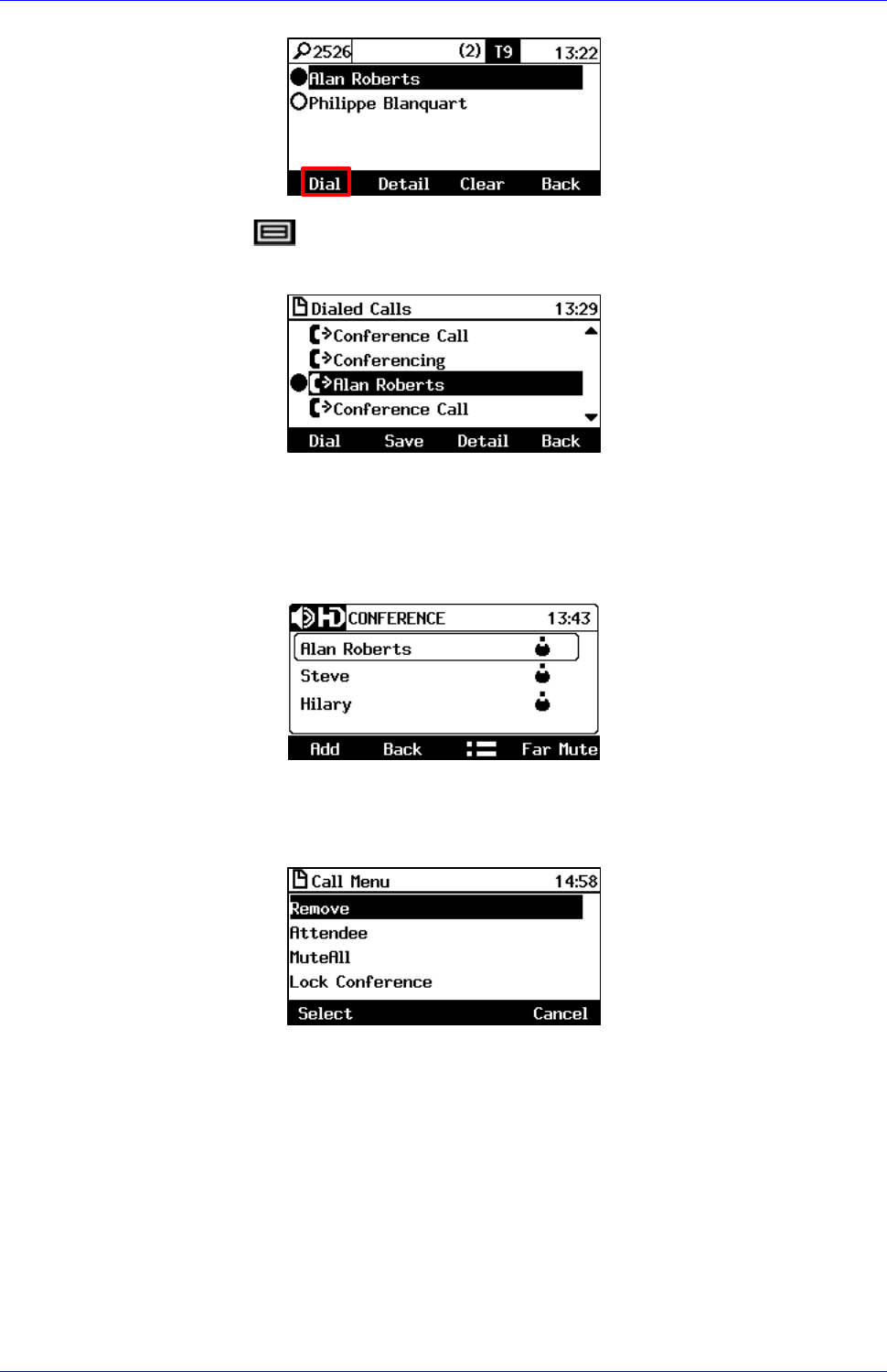
User's Manual Contents
Version 3.0.1 93 430HD and 440HD IP Phone
• Press the softkey, choose a Call Log (e.g., Dialed Calls, shown below), navigate
to the participant and then press the Dial softkey (see Section 7.8 for more information
about the Call Logs).
5. After adding and dialing a participant, add and dial the other participants to include in the
conference.
To view conference participants:
In the phone's idle screen, press the Meet Now softkey to open the CONFERENCE screen.
To remove a conference participant:
In the CONFERENCE screen, navigate to the participant to remove, and then press the
softkey. In the Call Menu screen that opens, select the Remove option.
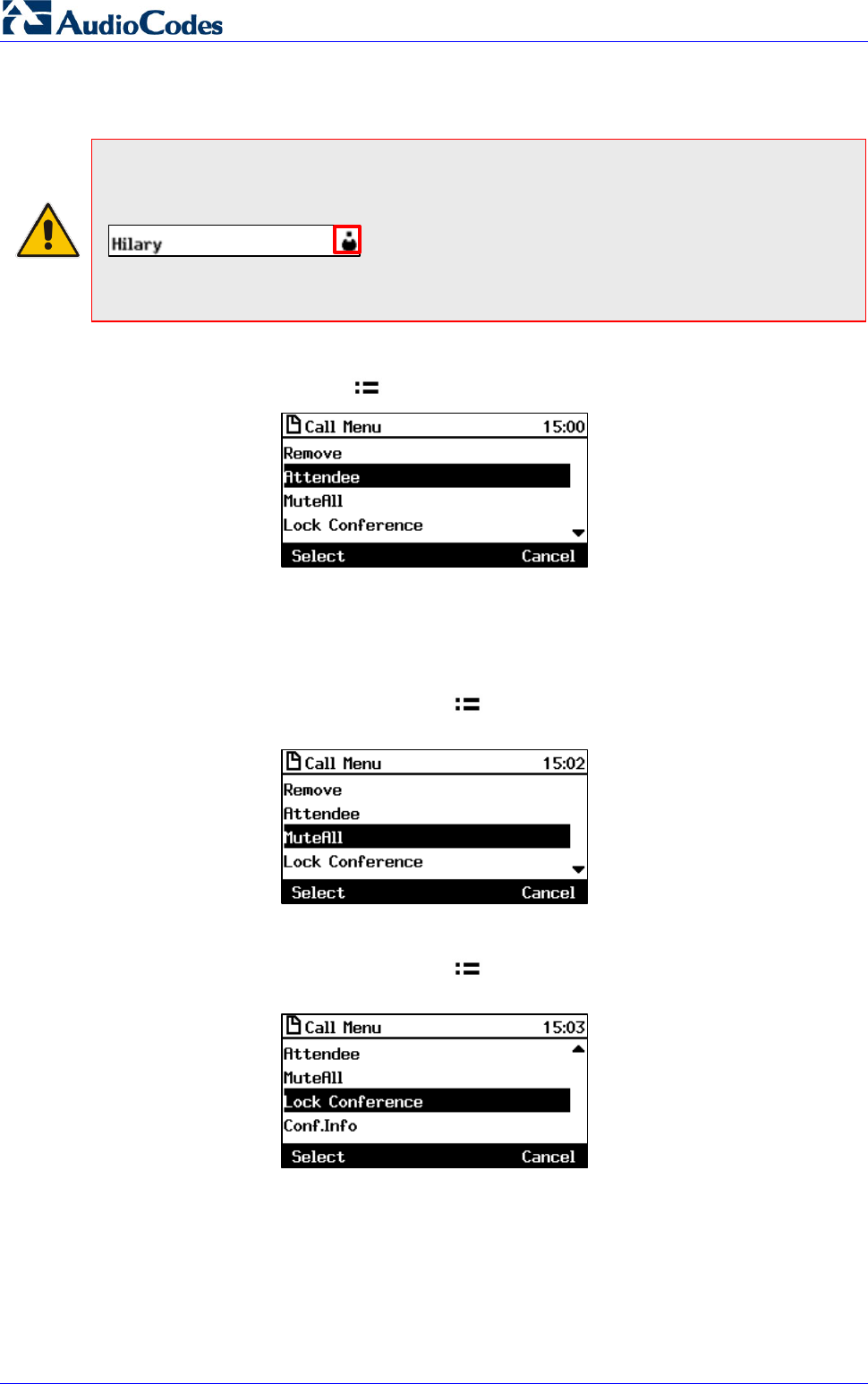
430HD and 440HD IP Phone
User's Manual 94 Document #: LTRT-11939
To change a participant's privileges:
Note: The icon adjacent to each participant in the CONFERENCE screen indicates that that
participant has got 'host' privileges (relevant only to Skype for Business users rather than to
PSTN/mobile calls, for example):
Participants with 'host' privileges can perform every action: far mute, mute all, remove, etc.
Participants with 'attendee' privileges can only add participants, no more.
1. In the CONFERENCE screen, navigate to the participant whose privileges you want to
change, and then press the softkey.
2. In the Call Menu screen that opens, select the Attendee option; the participant's privileges
will change to 'attendee' privileges and the icon indicating 'host' privileges in the
CONFERENCE screen will disappear.
To mute all participants:
In the CONFERENCE screen, press the softkey and in the Call Menu screen that
opens, select the MuteAll option.
To lock a conference:
In the CONFERENCE screen, press the softkey and in the Call Menu screen that
opens, select the Lock Conference option.
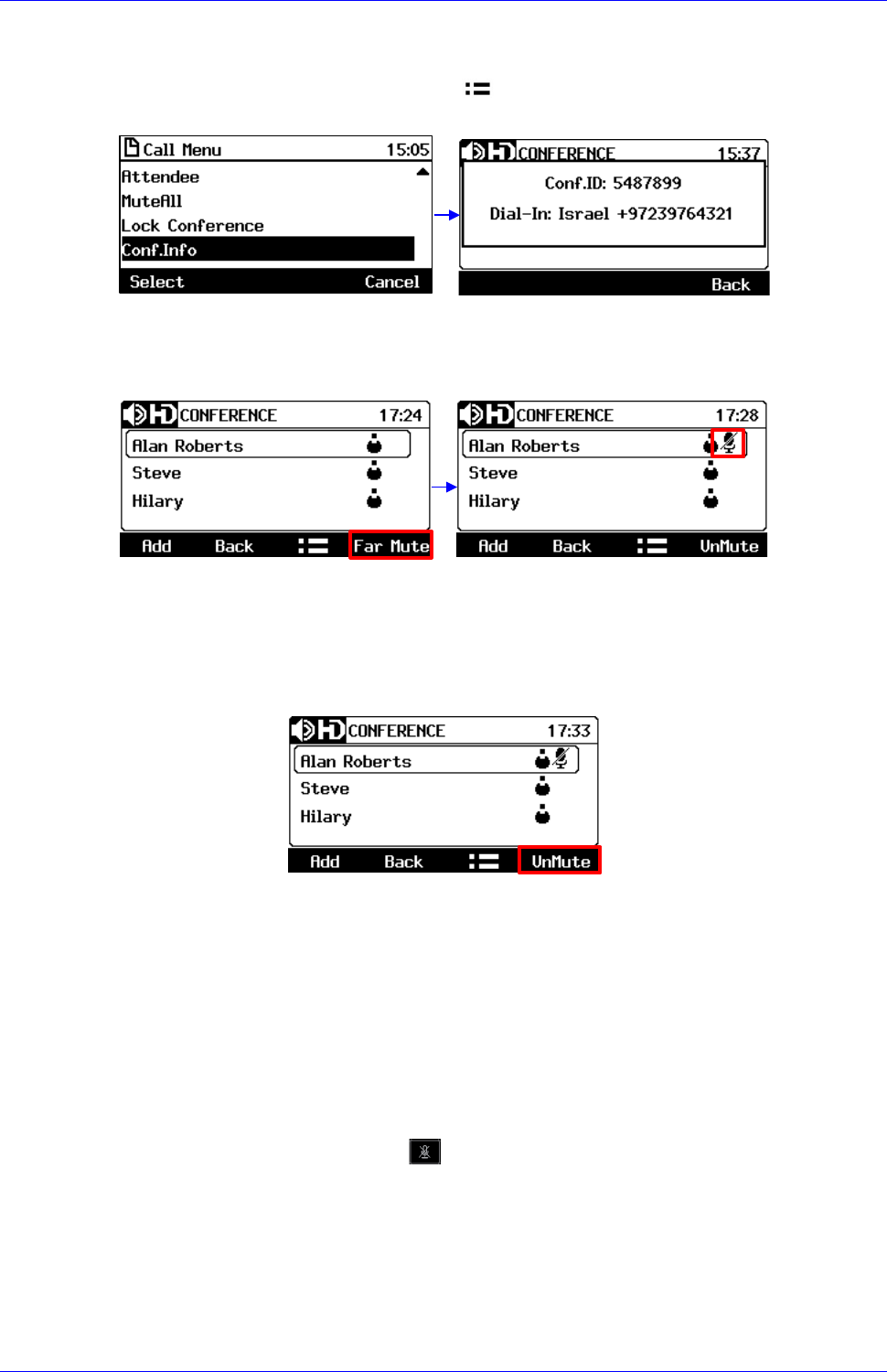
User's Manual Contents
Version 3.0.1 95 430HD and 440HD IP Phone
To view conference information:
In the CONFERENCE screen, press the softkey and in the Call Menu screen that
opens, select the Conf.Info option.
To mute a remote participant:
In the CONFERENCE screen, navigate to the participant to mute and then press the Far
Mute softkey.
On the participant's screen, the mute key illuminates red and the following message is displayed:
A presenter has muted you
To unmute a remote participant:
In the CONFERENCE screen, navigate to the participant to unmute and then press the
UnMute softkey.
On the participant's screen, the following message is displayed: A presenter wants you to
unmute yourself. The participant should press the illuminated mute button on their phone to
unmute.
8.10 Muting Calls
You can mute the microphone of the handset, headset, or speakerphone during a call so that the
other party cannot hear you. While the call is muted you can still hear the other party. Muting calls
can also be used during conference calls, as described above.
To mute/unmute:
1. During a call, press the mute key:
2. To unmute, press the mute key again and resume the conversation.
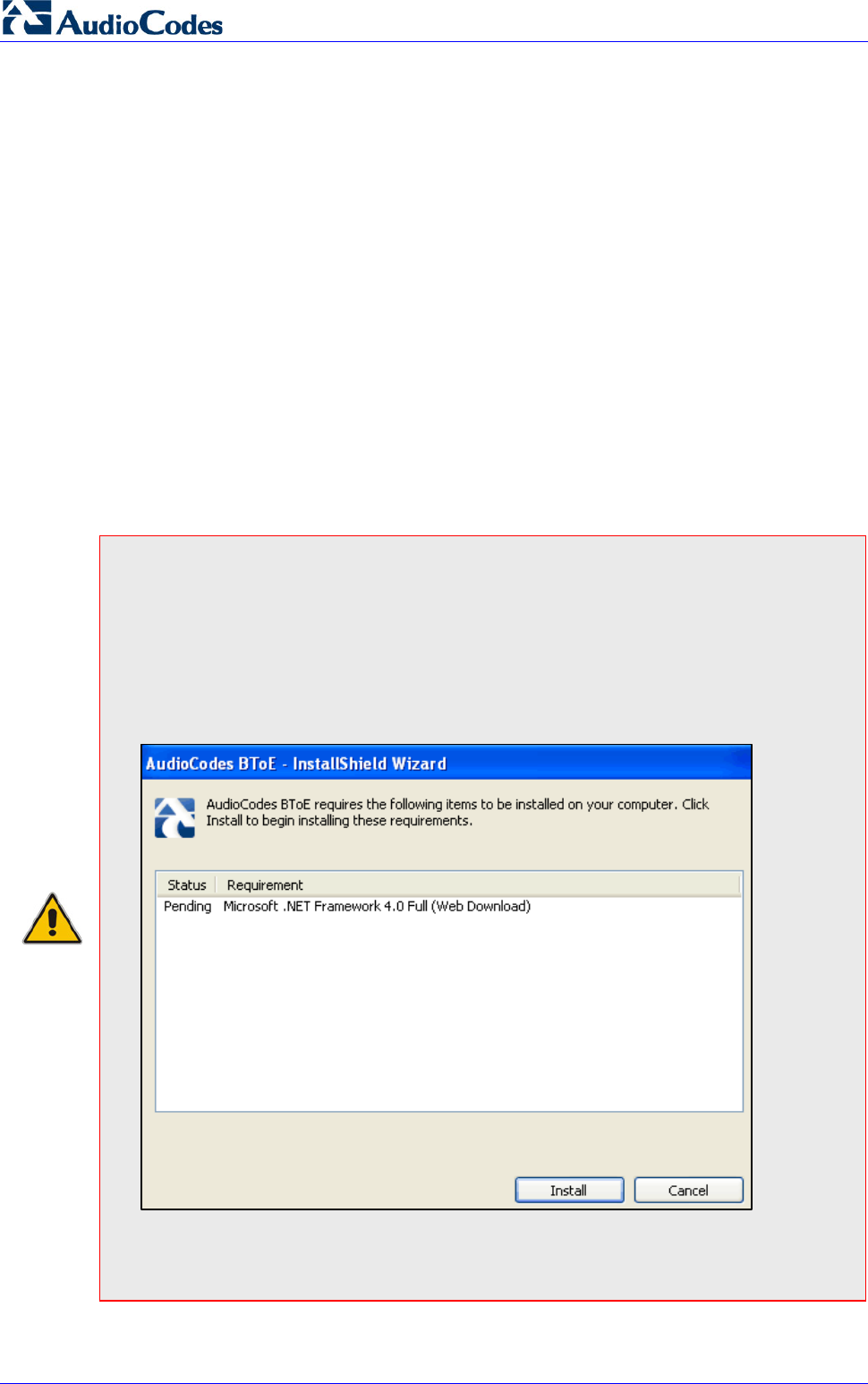
430HD and 440HD IP Phone
User's Manual 96 Document #: LTRT-11939
8.1 Setting up Better Together over Ethernet
This section shows how to set up the Microsoft Skype for Business feature 'Better Together over
Ethernet' on AudioCodes' 400HD Series of IP Phones.
BToE enables operations to be mirrored on both AudioCodes' IP phone and the Skype for
Business client on the PC/laptop, so that these operations can be controlled from either the IP
phone or the PC/laptop, whichever is convenient to the user at the time, for enhanced unified
communications and optimized enterprise efficiency.
After your IP phone is paired with your Skype for Business client, you can control (from phone or
PC/laptop) operations such as answering incoming calls, making outgoing calls (click-to-dial),
putting calls on hold and resuming them, and making conference calls.
8.1.1 Installing the BToE PC/Laptop Application
This section shows how to install AudioCodes' BToE PC/laptop application.
To install the BToE PC/laptop application:
1. After obtaining the installation file whose name will be either AudioCodes BToE.exe or
AudioCodes BToE.msi, save it to your PC/laptop and then double-click it.
Note:
• The msi file is for the purpose of network administrator distribution. Users are not allowed
to install BToE using the msi file, only using the exe file.
• After installing with the exe, then when upgrading the exe must be used. Upgrading with
the msi cannot be done if the first installation was with the exe, and vice versa.
• Some PCs require the installation of .Net 4.0 prior to the installation of the BToE
PC/laptop application. If you use the installation file AudioCodes BToE.exe, the
Installation Wizard will detect that .Net 4.0 is missing and will prompt you to install it:
When installing the BToE PC/laptop application using the installation file AudioCodes
BToE.msi, you won’t be prompted to install .Net 4.0 and the network administrator should
make the necessary preparations prior to installation of the BToE PC application.
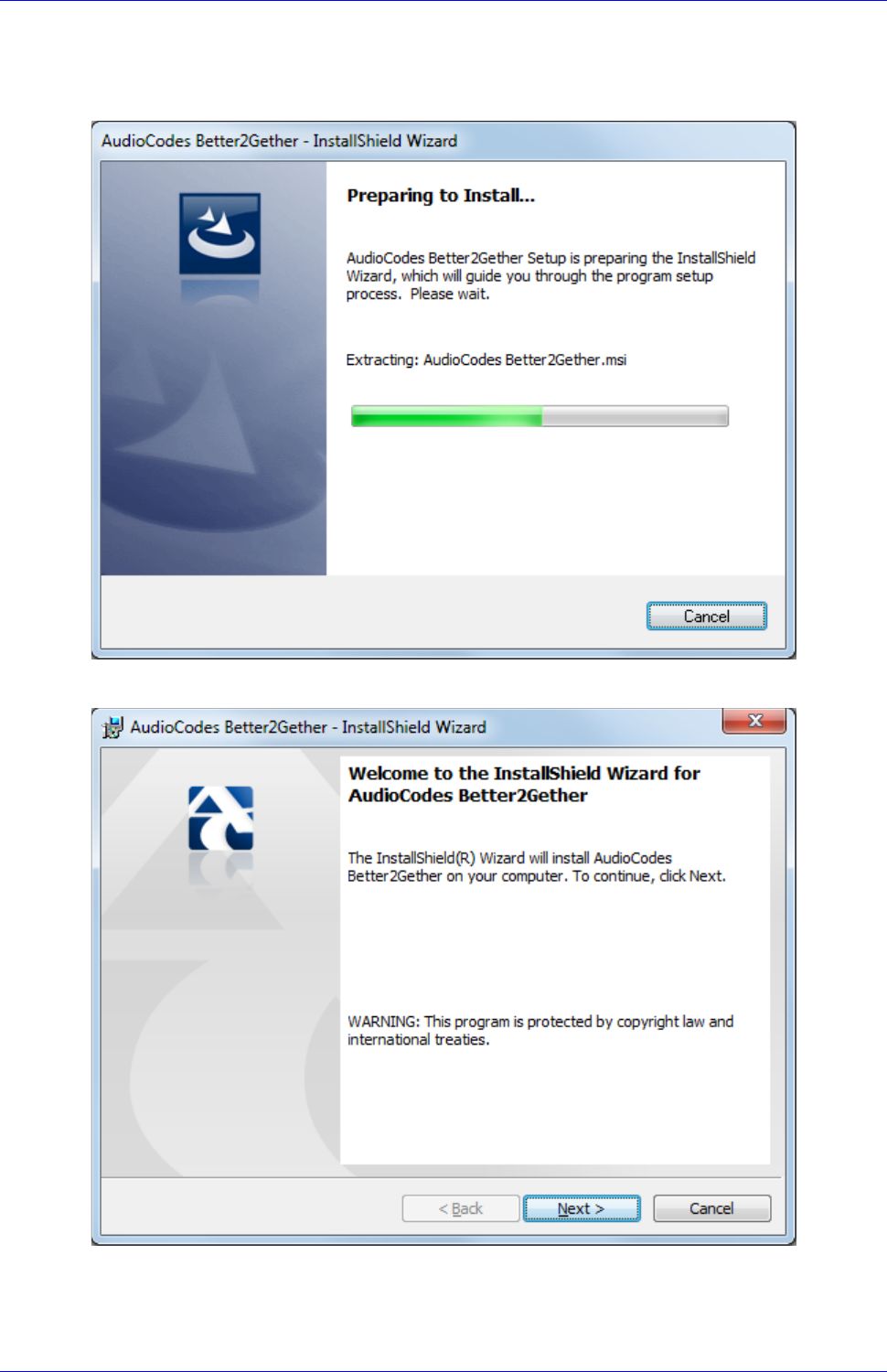
User's Manual Contents
Version 3.0.1 97 430HD and 440HD IP Phone
The Prepare to Install screen opens showing preparation progress until the Welcome to the
InstallShield Wizard screen opens:
Figure 8-1: InstallShield Wizard – Preparing to Install
Figure 8-2: Welcome to the InstallShield Wizard
2. Click the Next button; the License Agreement screen opens.
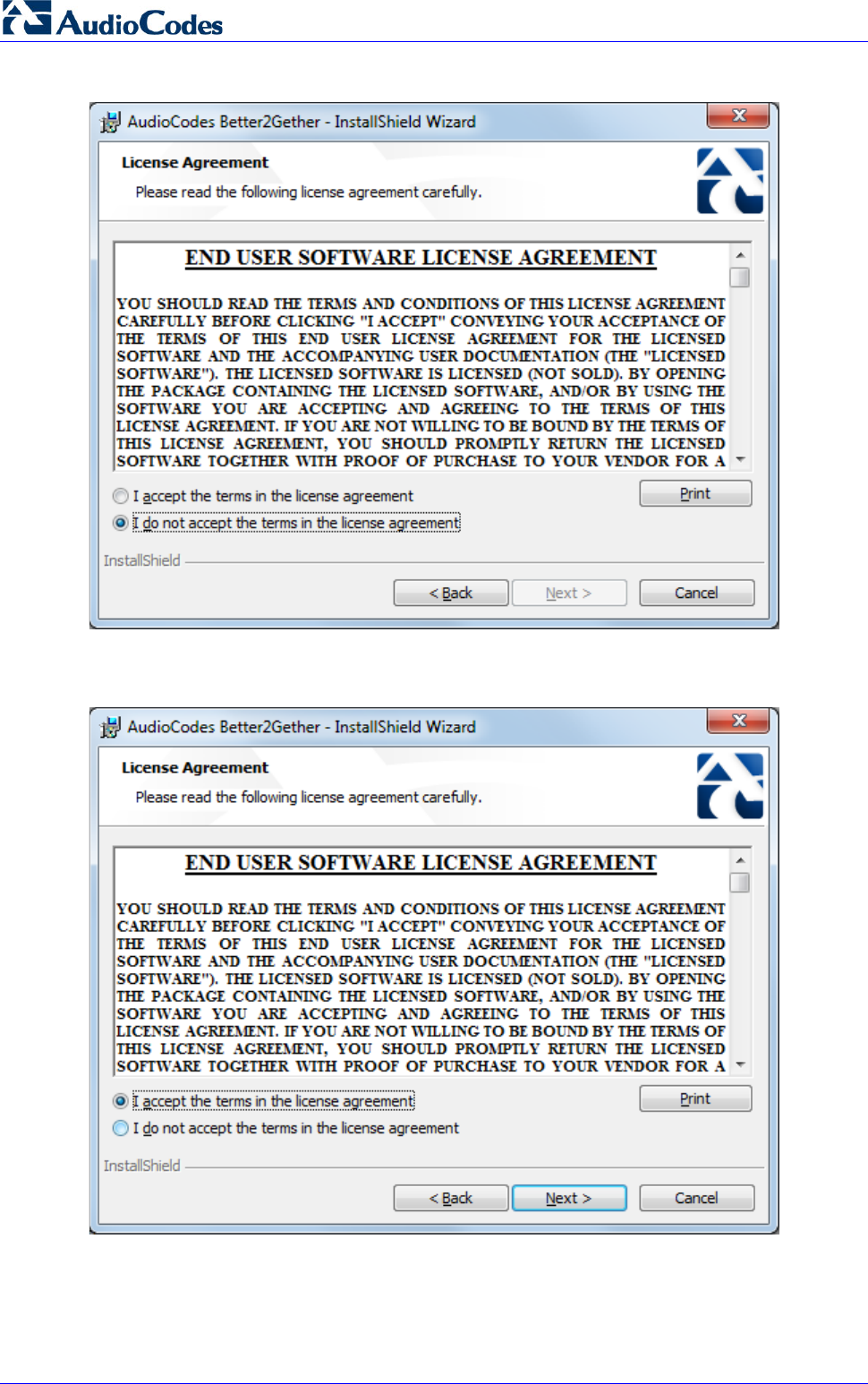
430HD and 440HD IP Phone
User's Manual 98 Document #: LTRT-11939
Figure 8-3: License Agreement
3. Select the I accept… option and click Next.
Figure 8-4: License Agreement
4. Click Next; the Destination Folder screen opens.
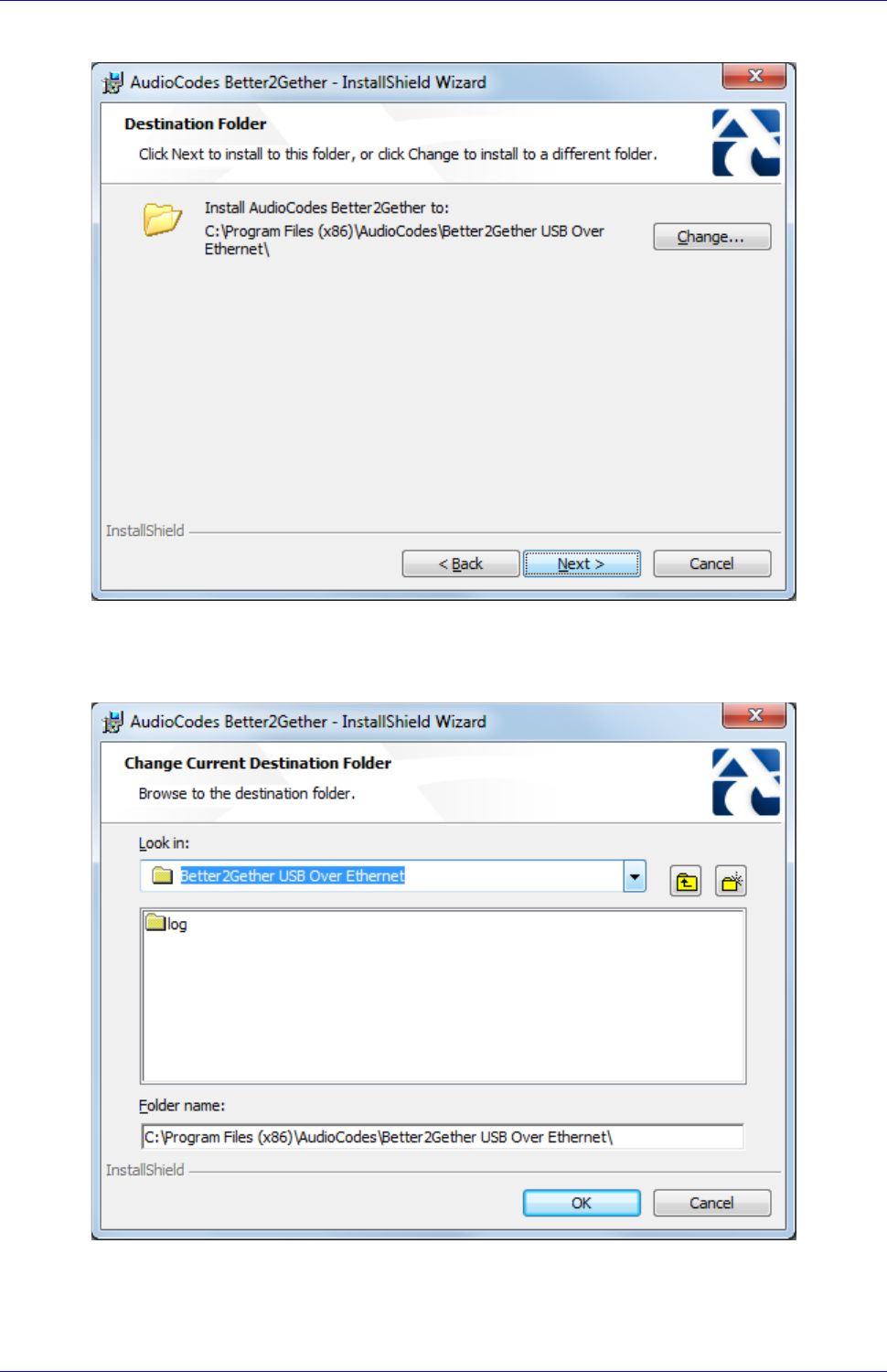
User's Manual Contents
Version 3.0.1 99 430HD and 440HD IP Phone
Figure 8-5: Destination Folder
5. To change the default Destination Folder, click Change and proceed to step 6.
To leave the Destination Folder at its default, click Next and proceed to step 7.
Figure 8-6: Change Current Destination Folder
6. Click OK; you're returned to the Destination Folder screen.
7. Click Next; the Ready to Install screen opens.
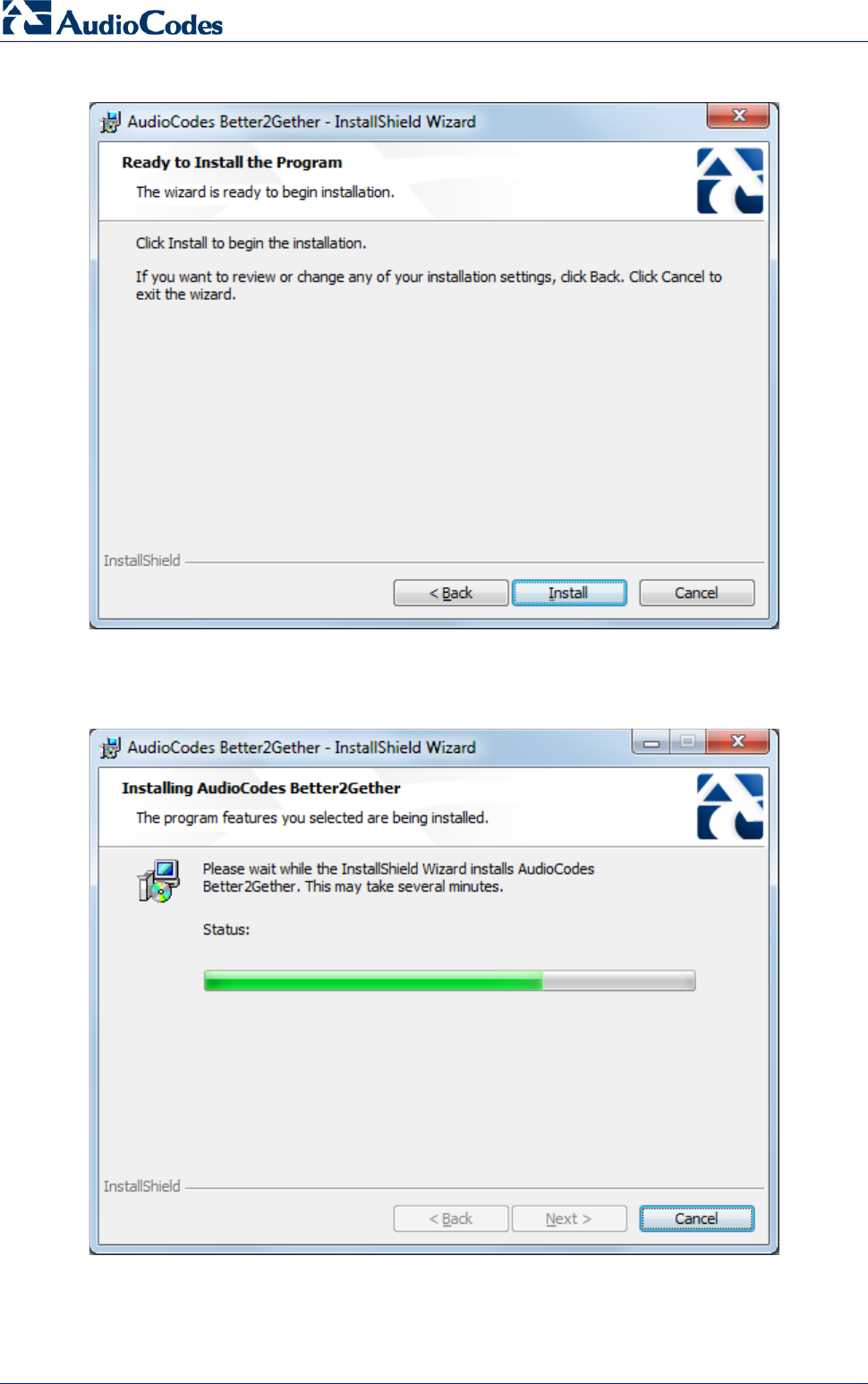
430HD and 440HD IP Phone
User's Manual 100 Document #: LTRT-11939
Figure 8-7: Ready to Install
8. Click the Install button; the Installing AudioCodes Better2Gether screen opens indicating
installation progress status.
Figure 8-8: Installing AudioCodes Better2Gether
9. Wait until the following screen is displayed:
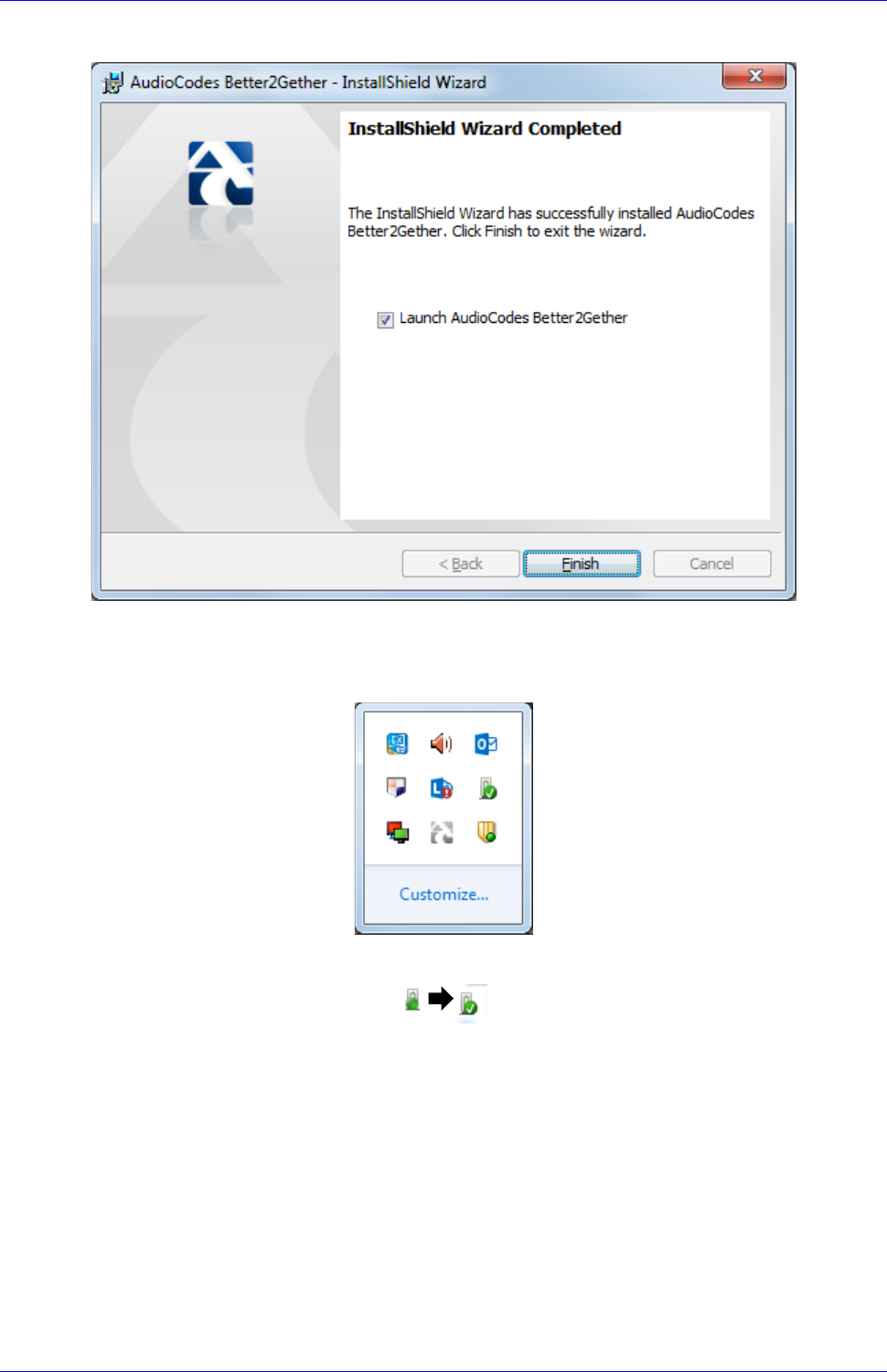
User's Manual Contents
Version 3.0.1 101 430HD and 440HD IP Phone
Figure 8-9: InstallShield Wizard Completed
10. Click the Finish button and then check your Windows taskbar and locate the newly
displayed AudioCodes icon (AC) as shown below:
Figure 8-10: AudioCodes Icon in Taskbar
11. Wait until the “Installing device driver software” process completes:
12. Check your programs in the Control Panel > Programs. You should see:
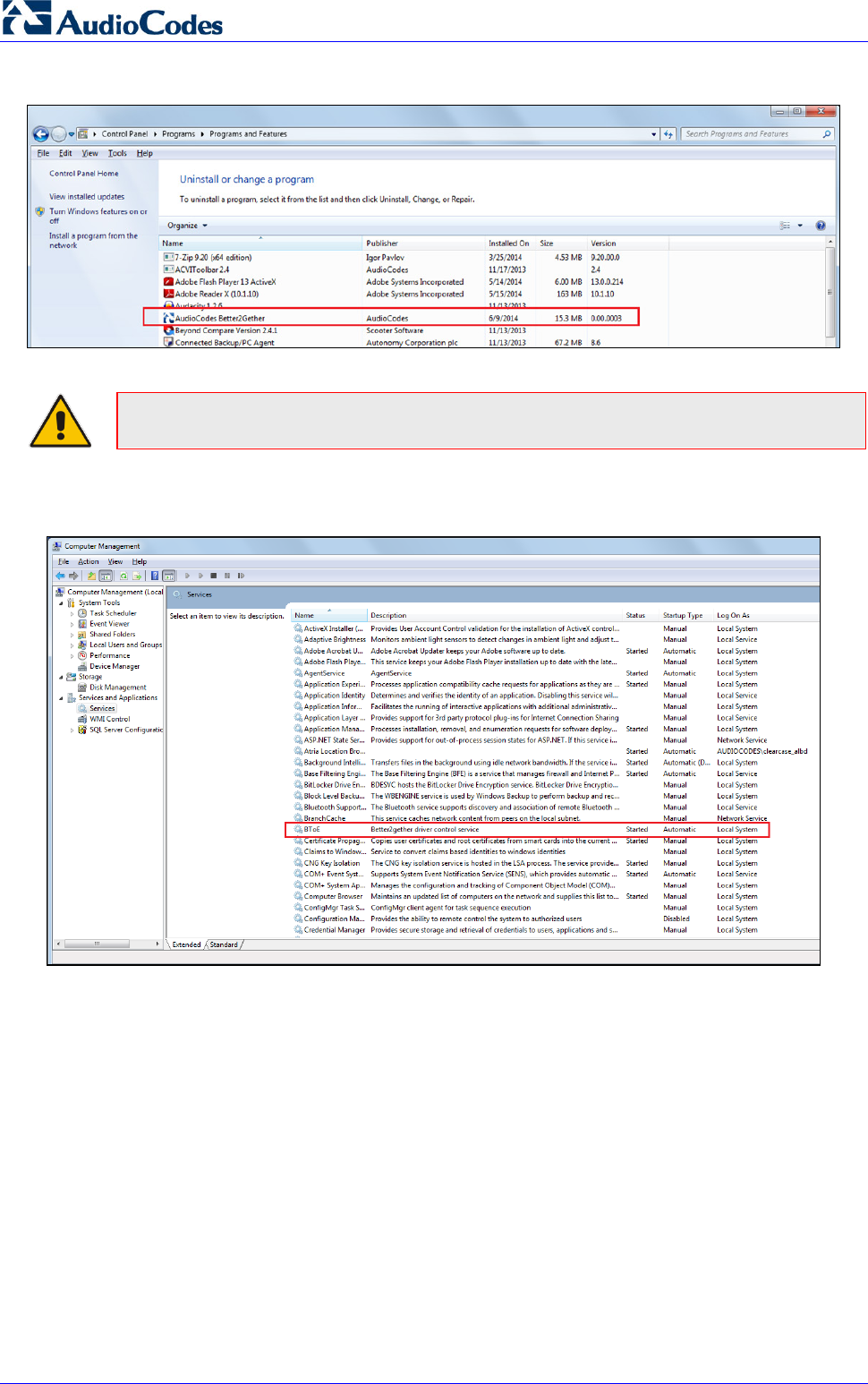
430HD and 440HD IP Phone
User's Manual 102 Document #: LTRT-11939
Figure 8-11: Control Panel>Programs>AudioCodes Better2Gether
Note: You can use this entry in the Control Panel > Programs to uninstall.
13. Access Computer Management > Services and Applications and locate BToE:
Figure 8-12: Computer Management > Services and Applications
14. Access the Device Manager and locate 'AudioCodes B2GoE USB driver'.
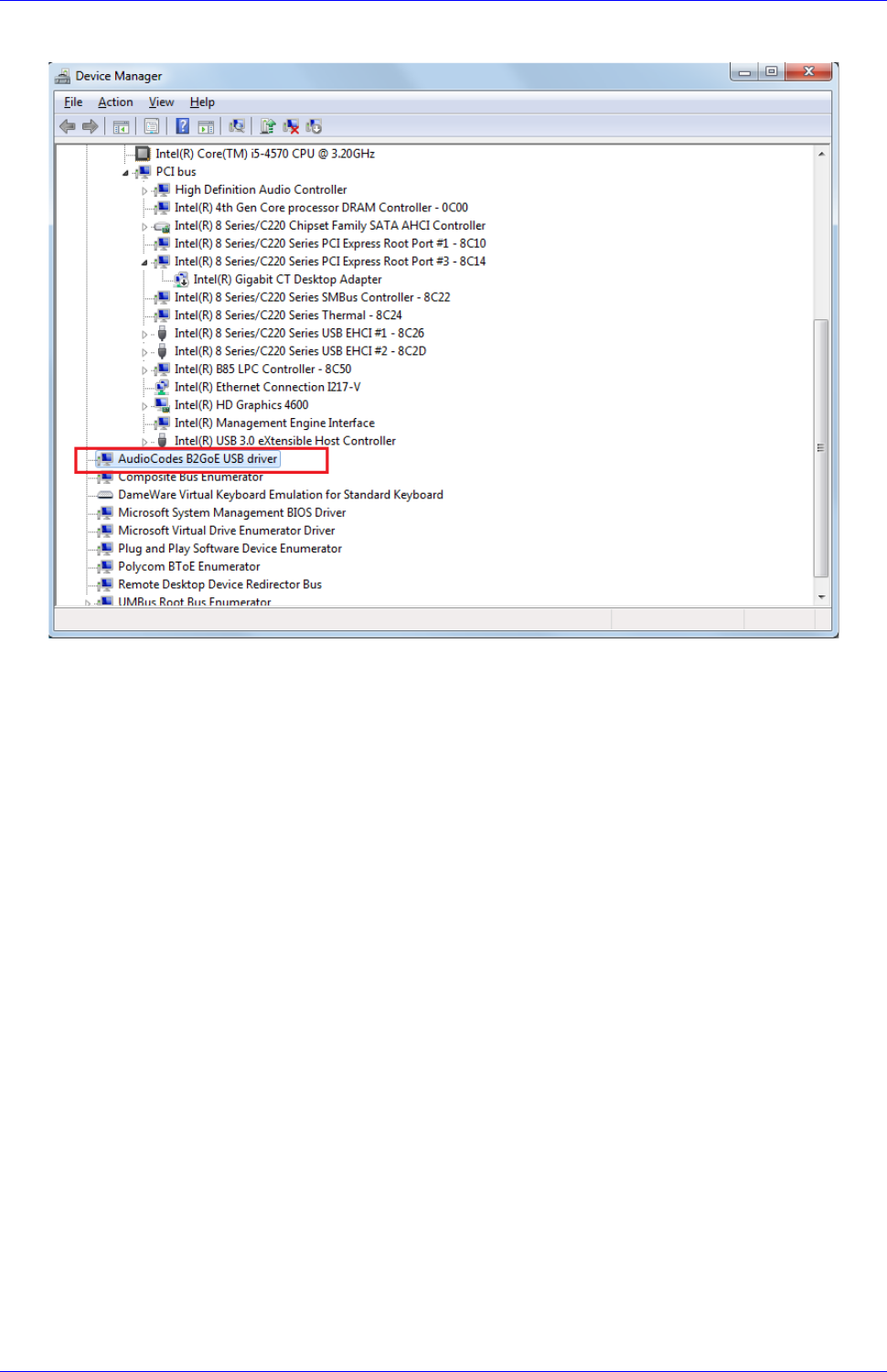
User's Manual Contents
Version 3.0.1 103 430HD and 440HD IP Phone
Figure 8-13: Device Manager > AudioCodes B2GoE USB Driver
You've successfully installed the program.
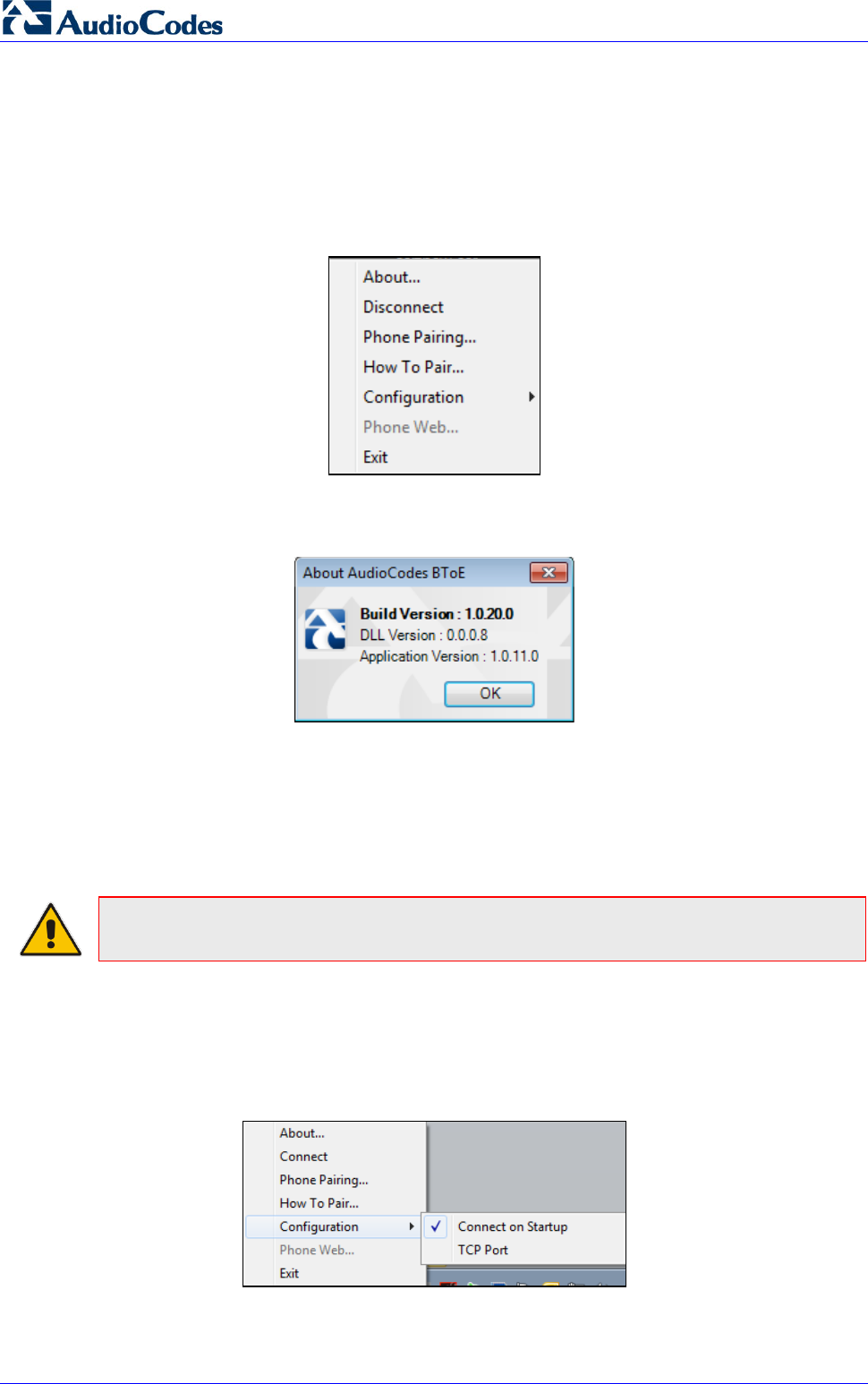
430HD and 440HD IP Phone
User's Manual 104 Document #: LTRT-11939
8.1.2 Making Sure BToE is Correctly Installed
This section shows how to make sure Better Together over Ethernet is correctly installed.
To make sure BToE is correctly installed:
1. Click the AC (AudioCodes) taskbar icon; the following menu pops up:
Figure 8-14: Popup Menu
2. Select the About… menu option to verify the DLL and BToE version:
Figure 8-15: About AC BToE
8.1.3 Configuring the BToE TCP Port
You can opt to configure a different BToE TCP port to the default 9999, depending on the
requirements of your enterprise. For example, you may decide to change the BToE TCP port to
5000 because your enterprise is using the default port of 9999, and 5000 is available. This
feature therefore provides enterprise administrators with more freedom in network administration.
Note: If you decide to change the default BToE TCP port, you must update both the
PC/laptop and the IP phone with the new BToE TCP port number.
To change the BToE TCP port on the PC/laptop side:
1. Click the AC (AudioCodes) taskbar icon; the menu shown in Figure 8-14 pops up.
2. Select Disconnect in the popup menu and then select Configuration > TCP Port.
Figure 8-16: TCP Port
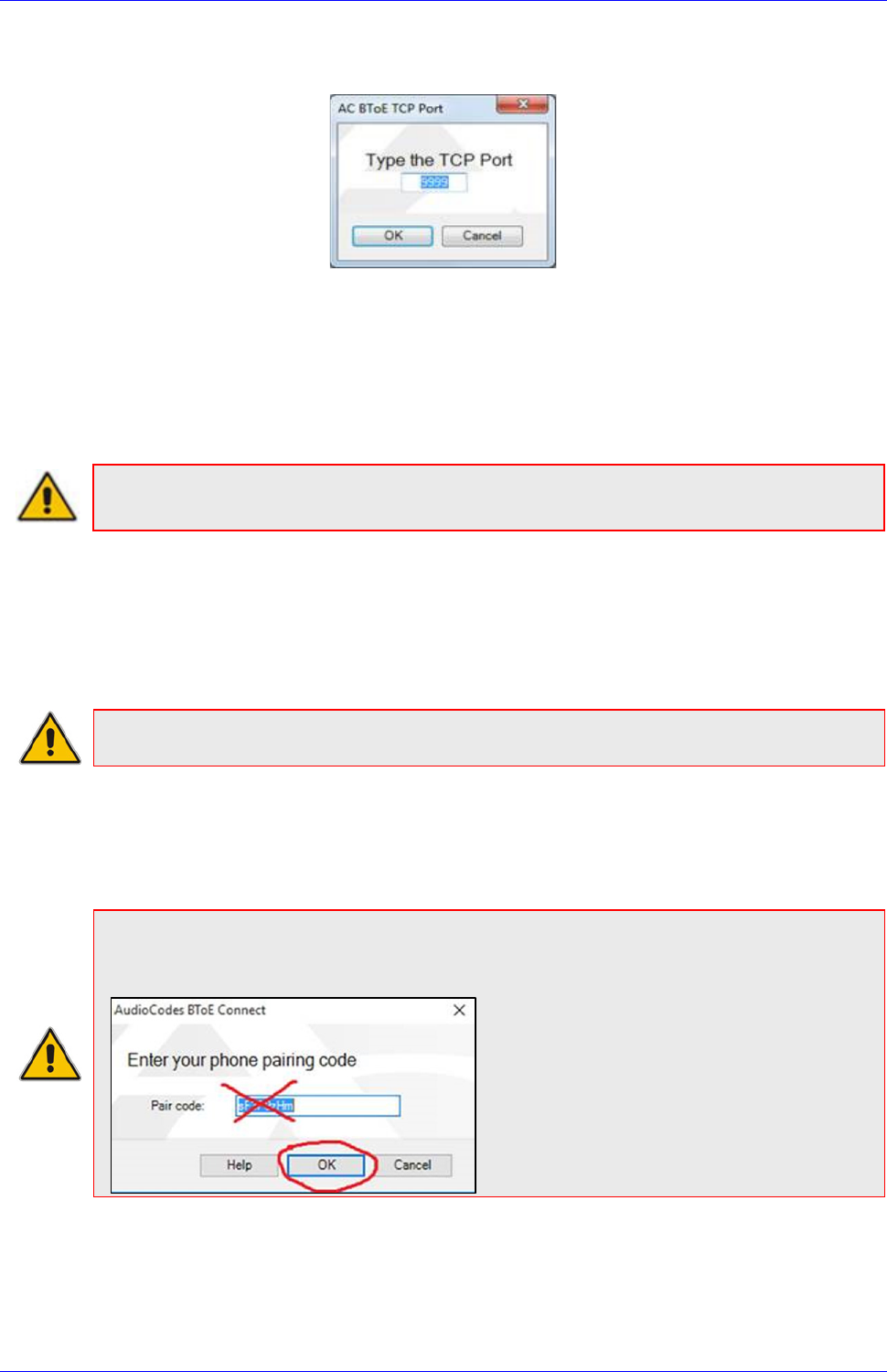
User's Manual Contents
Version 3.0.1 105 430HD and 440HD IP Phone
3. From the AC BTOE TCP Port dialog that opens, configure the TCP Port:
Figure 8-17: AC BToE TCP Port
The valid range is 1 to 65535.
To change the BToE TCP port on the IP phone side:
See the Administrator's Manual.
8.1.4 Enabling BToE for Online Users
Note: To enable BToE for online users, the Skype for Business server must be configured to
enable BToE.
8.1.5 Automatically Pairing the BToE PC/Laptop Application with the IP
Phone
Pairing is automatically performed when the phone's PC port is connected to the PC/laptop
'behind' the phone. See the Administrator's Manual for more information.
Note: Automatic pairing requires BToE PC/laptop application Version 2.x.
If the laptop after automatic pairing is disconnected and moved to another location, its
speaker/headset becomes the audio device associated with the Skype for Business client.
If the laptop is manually paired and then relocated, Skype for Business audio will remain through
the phone. It's therefore advisable to pair automatically.
Note: If the BToE PC/laptop application has already been manually paired with the phone, as
shown in the section below, and you want to automatically pair, you must delete the old pair
code from the BToE PC/laptop application in order to allow BToE automatic pairing:
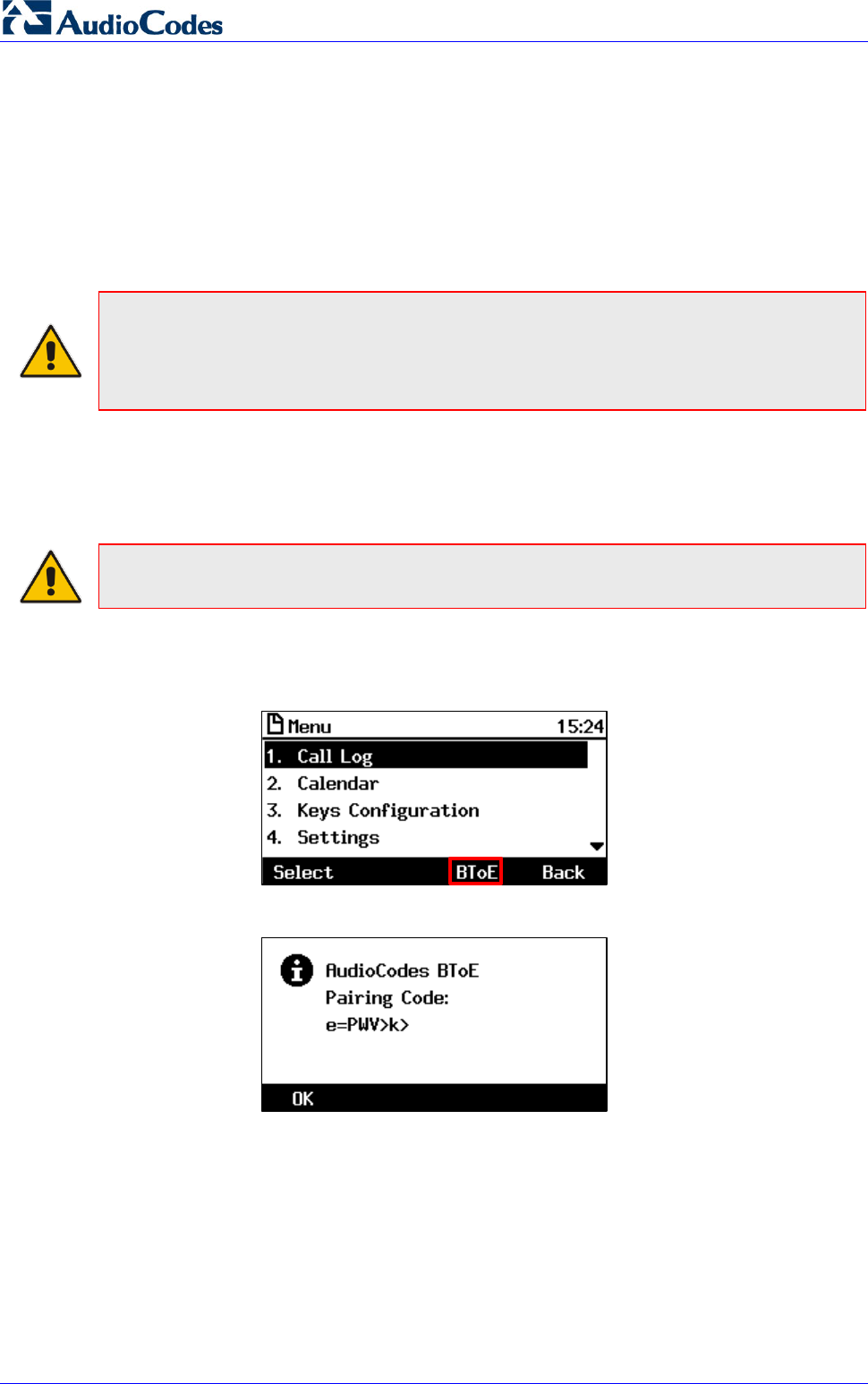
430HD and 440HD IP Phone
User's Manual 106 Document #: LTRT-11939
8.1.6 Manually Pairing the BToE PC/Laptop Application with the IP Phone
This section shows how to manually pair AudioCodes' BToE PC/laptop application with the IP
phone using a pair code. Even though automatic pairing gives users greater freedom, manual
pairing is still an option. Manually pair like this:
1. Generate a pair code (see Section 8.1.6.1)
2. Connect the IP phone and BToE PC/laptop application using the pair code (see
Section 8.1.6.2)
Note:
• If the IP changes, you will need to generate a pair code again.
• If you know the last pair code, you don't need to generate a new one.
If you don't know it, continue below.
8.1.6.1 Manually Generating a Pair Code
This section shows how to manually generate a pair code.
Note: The phone is by default automatically paired with the PC/laptop. If you want to
manually pair, consult with your network administrator. See the Administrator's Manual.
To manually generate a pair code:
1. Press the MENU hard key on the phone.
2. Press the BToE softkey; the BToE pair code is displayed:
This is the pair code that will be used by the BToE PC/laptop application. Make a note of it for
reference when connecting the IP phone with the BToE PC/laptop application.
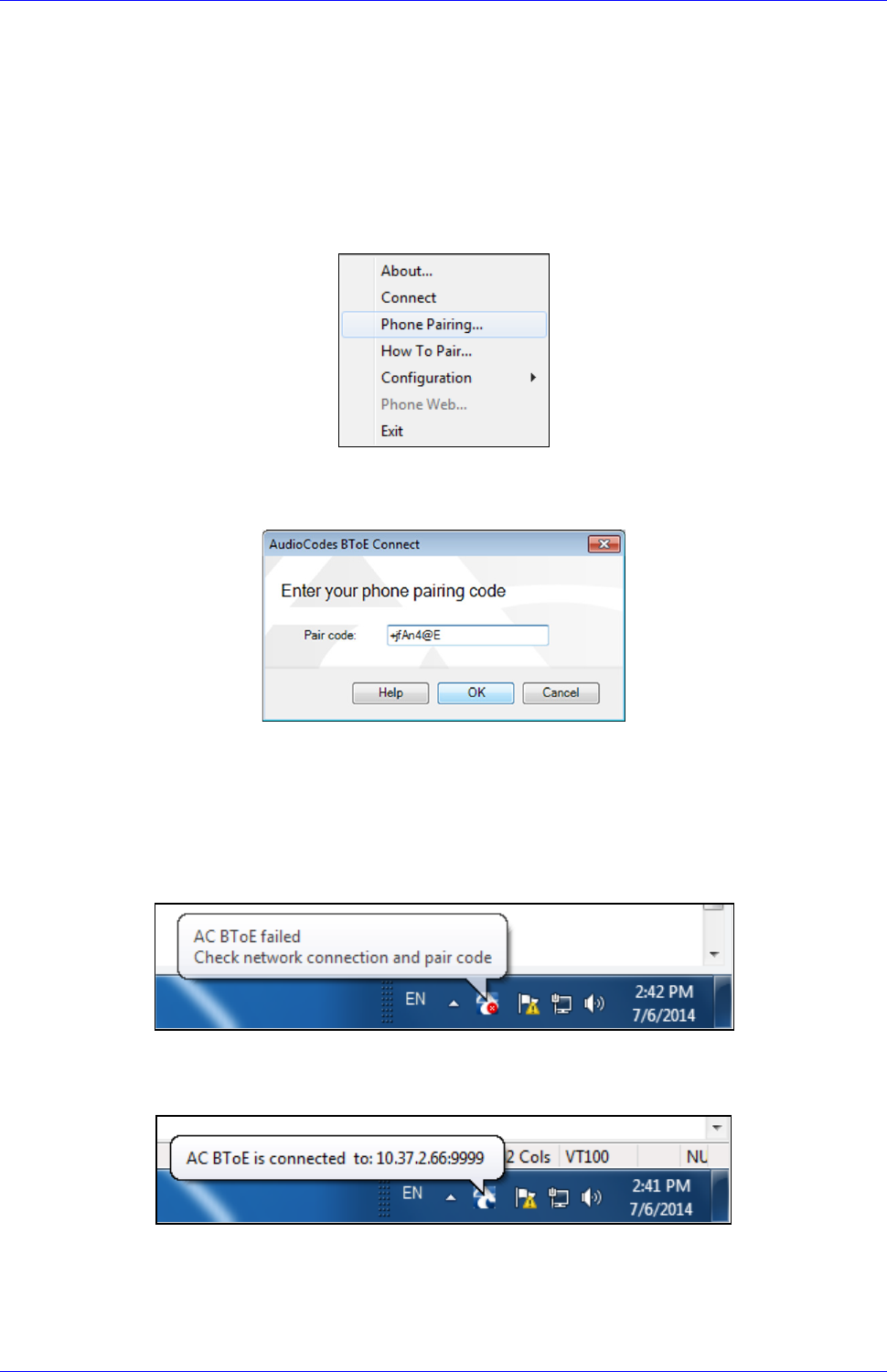
User's Manual Contents
Version 3.0.1 107 430HD and 440HD IP Phone
8.1.6.2 Manually Connecting the IP Phone with the BToE PC/Laptop Application
This section shows how to connect the IP phone with the BToE PC/laptop application.
To connect the two:
1. Open the AudioCodes BToE Connect screen: Click the BToE client icon placed on your
taskbar after installation; the following popup menu opens.
Figure 8-18: Popup Menu
2. Select the Phone Pairing option
Figure 8-19: Phone Pairing
3. In the 'Type the pair code' screen, enter the pair code that you generated as shown in
Section 8.1.6.1; the OK button is activated after 8 characters are entered.
3. Click the OK button; BToE is activated.
4. If a communication error occurs or the wrong pair code was entered, the following icon
indication appears:
Figure 8-20: AC BToE Failed Indication
5. When BToE is successfully connected, view the following icon indication:
Figure 8-21: AC BToE is Connected Indication
6. When BToE is in 'Connected' state, the popup menu shows the Disconnect menu item
and the Phone Pairing menu item is deactivated:
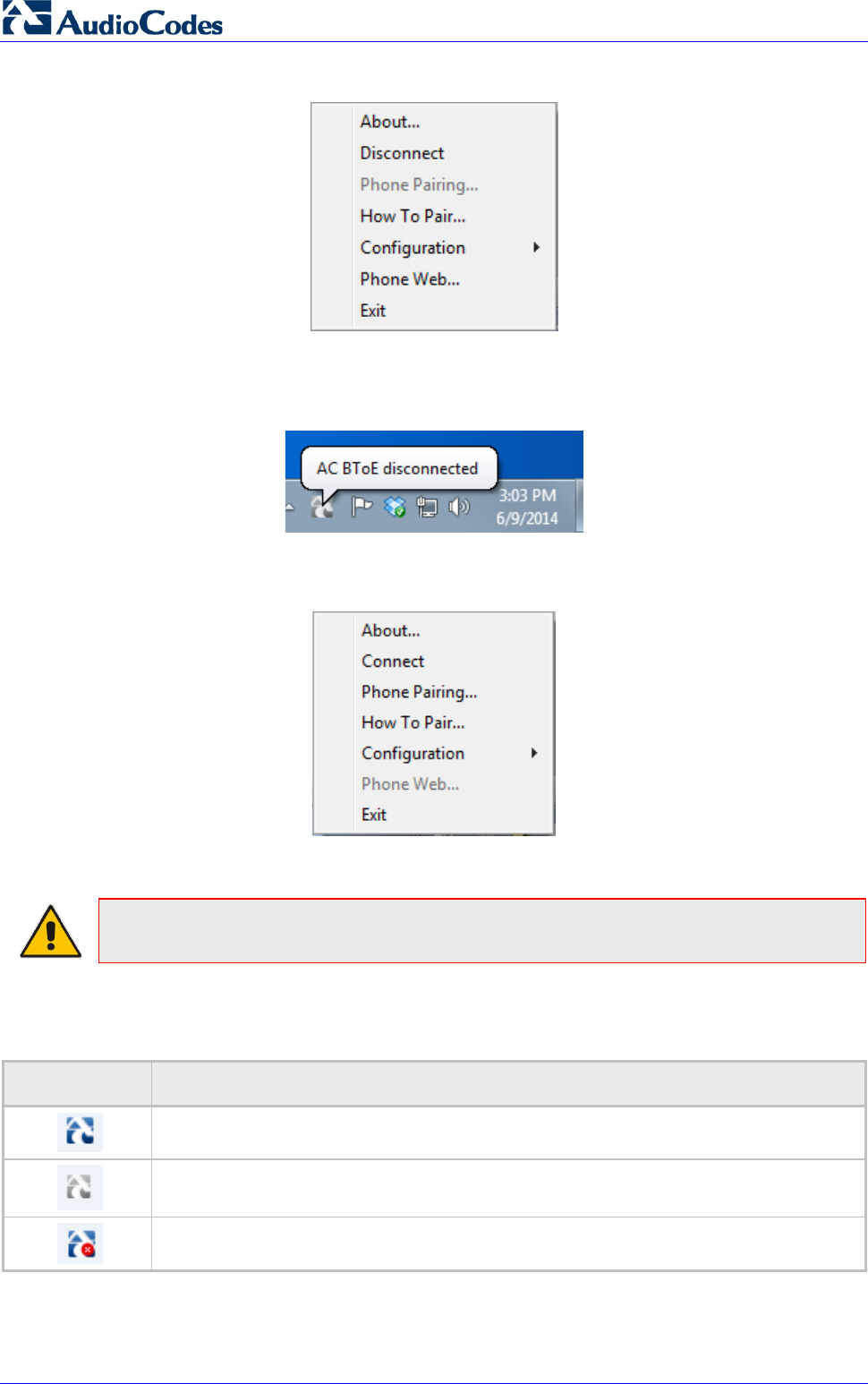
430HD and 440HD IP Phone
User's Manual 108 Document #: LTRT-11939
Figure 8-22: Popup Menu: 'Disconnect' Enabled, 'Phone Pairing' Disabled
7. After selecting the Disconnect menu option, the 'AC BToE Disconnected' indication is
displayed:
Figure 8-23: BToE Disconnected
8. From the popup menu as well you can see if BToE is disconnected:
Figure 8-24: Popup Menu: BToE Disconnected
Note: When BToE is connected, you can select the Phone Web menu option to open the
phone's the Web interface.
9. Use the table below as reference when determining BToE's connection state from the
taskbar icon.
Taskbar Icon BToE's connection state
BToE is connected
BToE is disconnected
BToE is connected but a failure is preventing a correct connection. The failure can be a
network problem or the wrong pair code was defined.
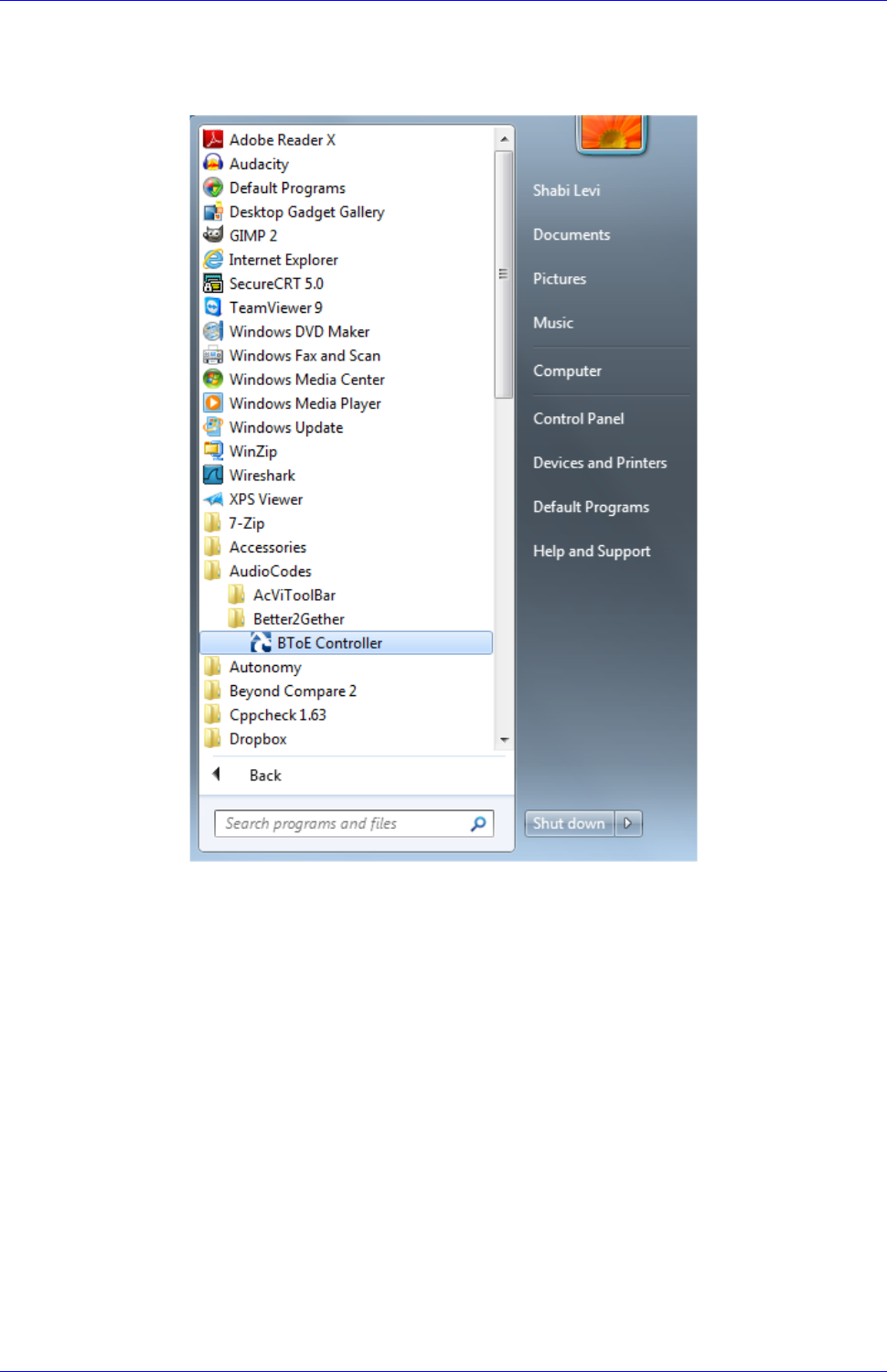
User's Manual Contents
Version 3.0.1 109 430HD and 440HD IP Phone
10. From the click popup menu, you can select the Exit option; the BToE PC application stops.
You can activate the application again from the Start menu as shown in Figure 8-25.
Figure 8-25: Start > Programs > AudioCodes > BToE Controller
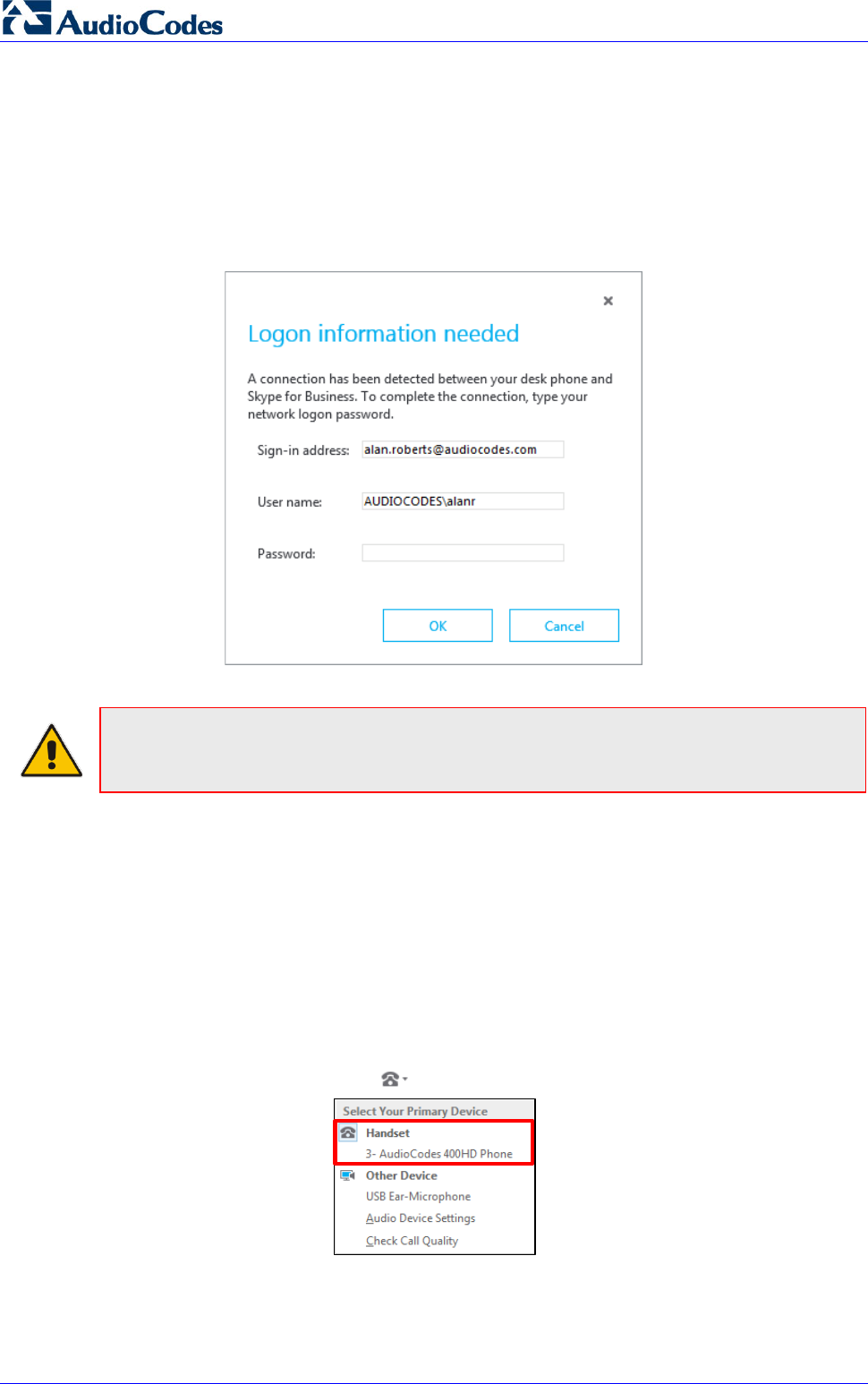
430HD and 440HD IP Phone
User's Manual 110 Document #: LTRT-11939
8.1.6.3 Connecting the Skype for Business Client with the IP Phone
This section shows how to connect the Microsoft Skype for Business client with the IP phone
using the Skype for Business login screen.
To connect the two:
Enter your credentials in the Skype for Business Sign-in request prompt, and click OK.
Figure 8-26: Skype for Business Sign-in Request Prompt
Note: Primary Device cannot be changed in Skype for Business Client PC/laptop client
during a call. When the phone is in idle mode (not in a call), the PC/laptop application must
be disconnected in order to change Primary Device. See the Release Notes.
8.1.7 Making Sure IP Phone/ Skype for Business Client are Paired
This section shows how to make sure you successfully paired your IP phone with the Skype for
Business client.
8.1.7.1 Making Sure Skype for Business Client is Paired
You can make sure the Skype for Business client is paired with the IP phone.
To make sure the Skype for Business client is paired with the IP phone:
1. In the Skype for Business client application, in the lowermost left corner of the screen, click
the Select Primary Device icon ; the following popup menu opens:
2. Make sure Handset AudioCodes 400HD Phone is selected.
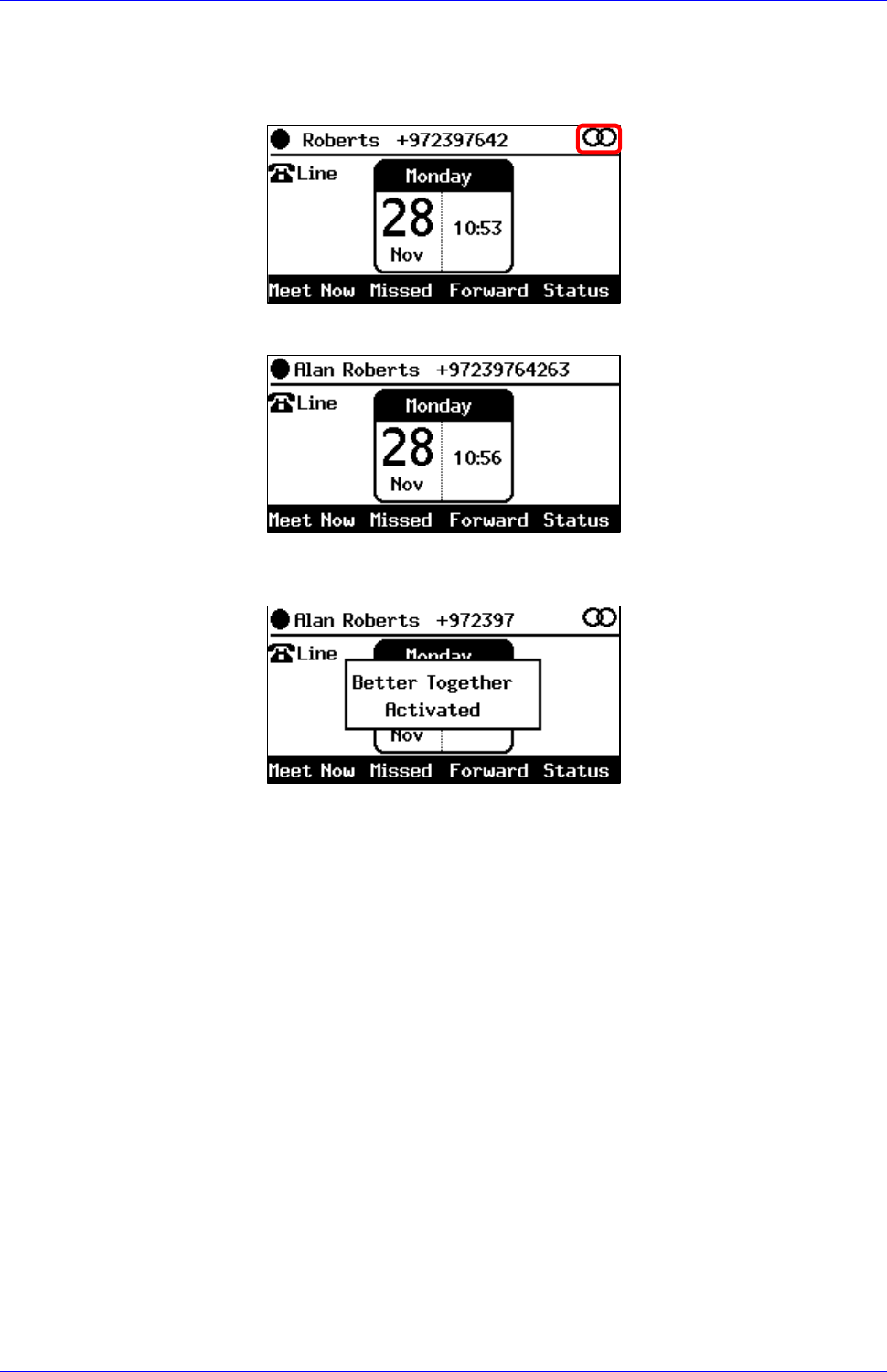
User's Manual Contents
Version 3.0.1 111 430HD and 440HD IP Phone
8.1.7.2 Making Sure the IP Phone is Paired
You can determine from the IP phone's idle screen if the phone is paired with the Skype for
Business client. Two interlocked rings in the idle screen indicate the phone is paired.
If the idle screen does not display two interlocked rings, the phone is not paired.
After connecting, a 'BToE Activated' notification pops up and then disappears. The two
interlocked rings remain.
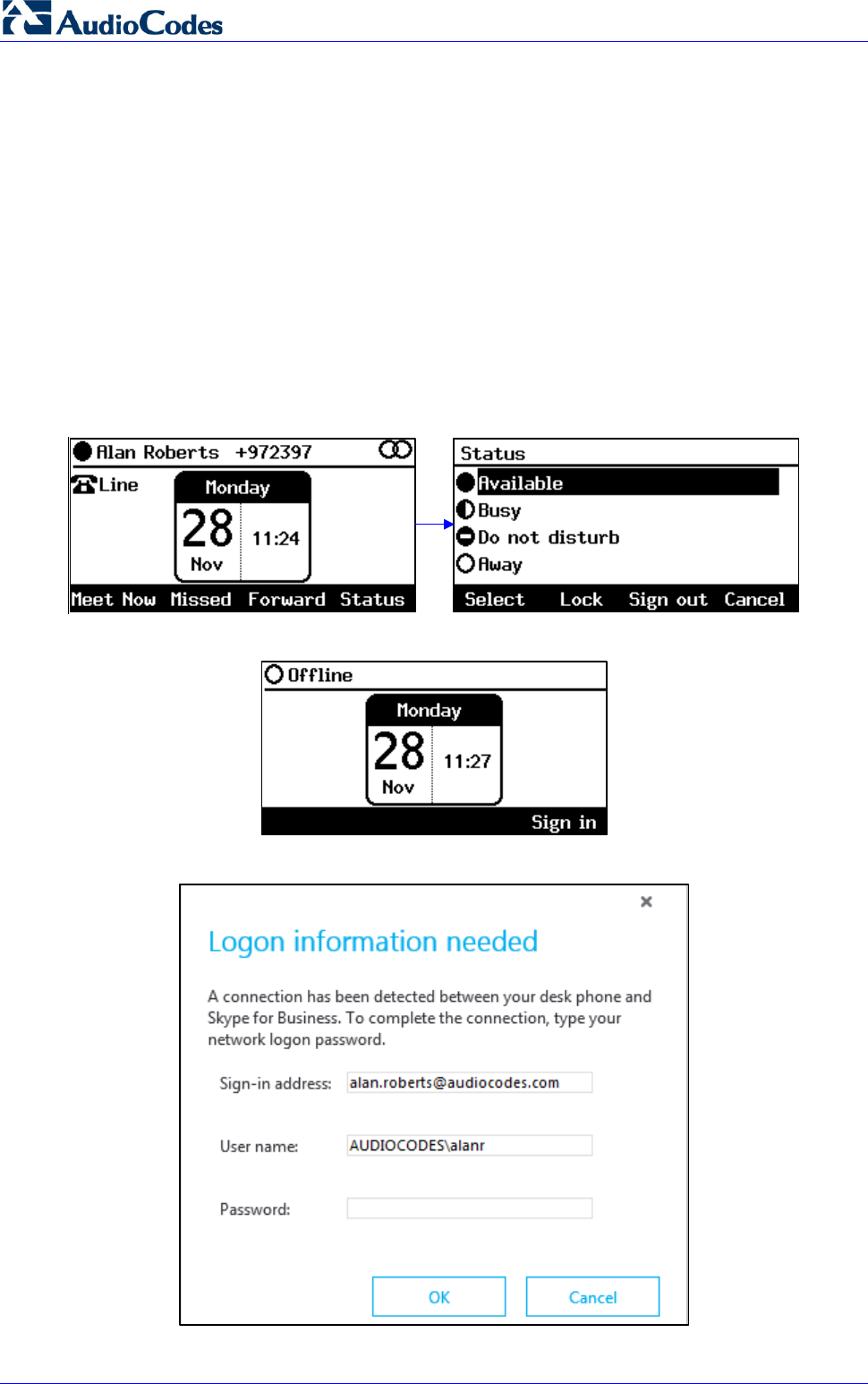
430HD and 440HD IP Phone
User's Manual 112 Document #: LTRT-11939
8.2 Using BToE Functions
This section shows how to use your IP phone as an extension of your Skype for Business client,
and how to use your client as an extension of your IP phone, for enhanced unified
communications and optimized efficiency.
Before using BToE functions, you need to install BToE. See the Administrator's Manual for
detailed information on installing BToE. Before using BToE functions, make sure in the Skype for
Business client that the 'Primary Device' selected is Handset AudioCodes BToE.
8.2.1 Signing in to the Phone from the Skype for Business Client
You can sign in to the IP phone from the Skype for Business client.
To sign in to the phone from the Skype for Business PC client:
1. Sign out from the IP phone.
a. In the phone's idle screen, press the Status softkey:
b. In the Status screen, press the Sign out softkey; the phone goes offline.
c. The Skype for Business client on the PC prompts you for Logon information.
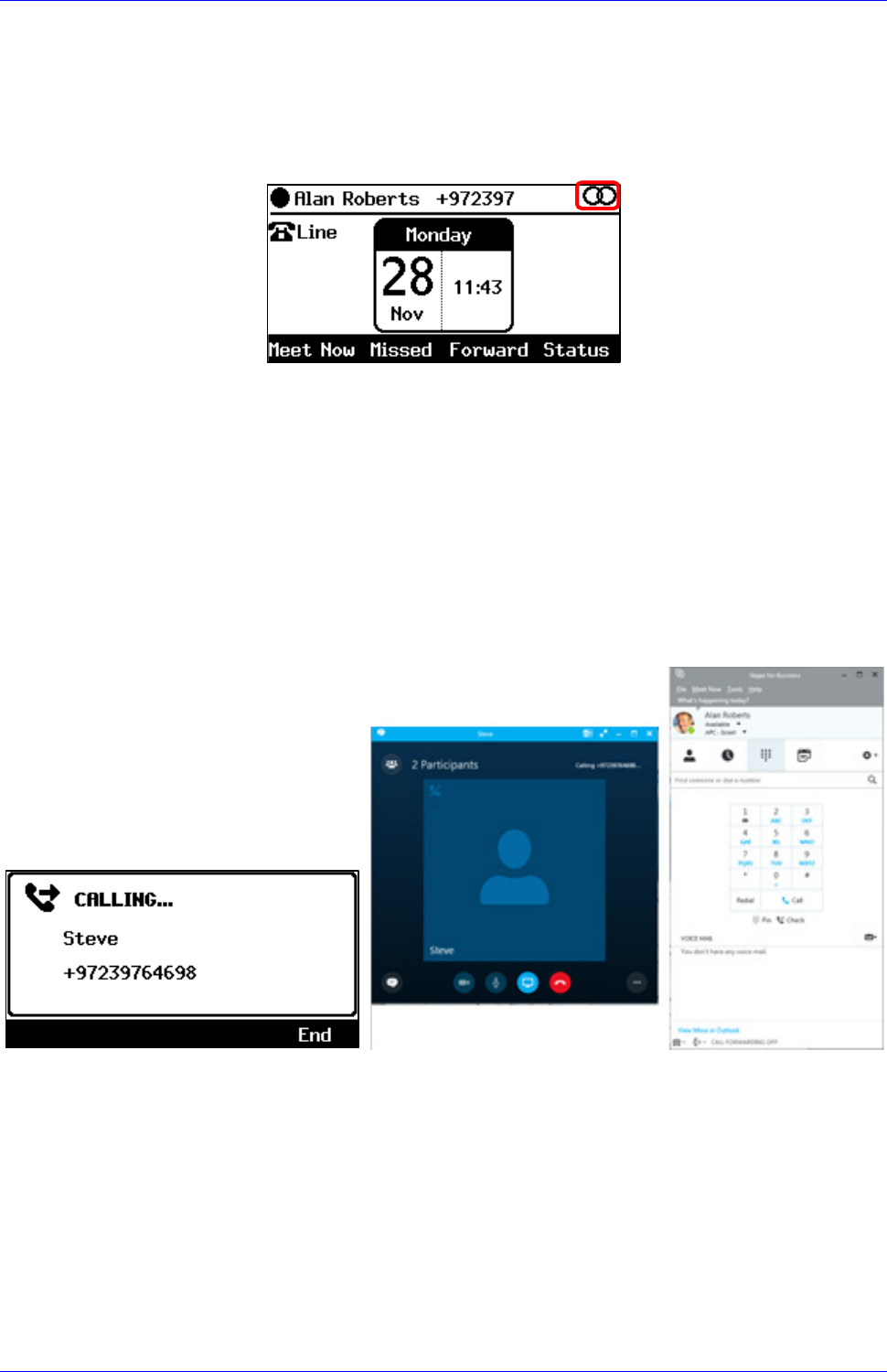
User's Manual Contents
Version 3.0.1 113 430HD and 440HD IP Phone
2. In the Skype for Business client Logon information prompt, enter the same password you
use to access your PC and then click OK; the phone's screen displays the registration
process, a 'BToE Activated' notification pops up, and the Phone Lock screen is displayed.
3. Enter a PIN code to unlock the phone – see Section 5 for more information.
The phone is signed in and after a few seconds, the two interlocked rings are displayed
indicating that the phone is paired with the PC BToE application.
Note that the phone's IP address may change during the registration process.
8.2.2 Making a Call (Click-to-Dial)
You can make a call from the PC Skype for Business client or from the IP phone; in both cases,
the one operation mirrors the other, providing an enhanced unified communications experience
and optimizing enterprise efficiency.
To make a call:
1. In the PC Skype for Business client, click the digit keys of the person's number to call.
Alternatively, you can call them from Outlook; the IP phone's user interface displays the
CALLING screen (shown below) while the PC Skype for Business client simultaneously
displays the conversation screen.
2. When the called party answers, you can use either your phone or PC Skype for Business
client to talk, whichever is more convenient. When BToE is paired, you can use only the
phone to talk; the client is used to control the call. To talk via the client, you must switch the
primary device. You can use the phone's speakerphone, handset or headphones.
8.2.3 Answering a Call
You can answer an incoming call on the Skype for Business client or IP phone, whichever is more
convenient for you at the time, providing an enhanced unified communications experience and
optimizing enterprise efficiency. When answering an incoming video call with a paired phone, the
call is established. The default device is the PC speaker/microphone rather than the phone.
Subsequent audio calls will be unaffected; the paired phone will still be the default device.
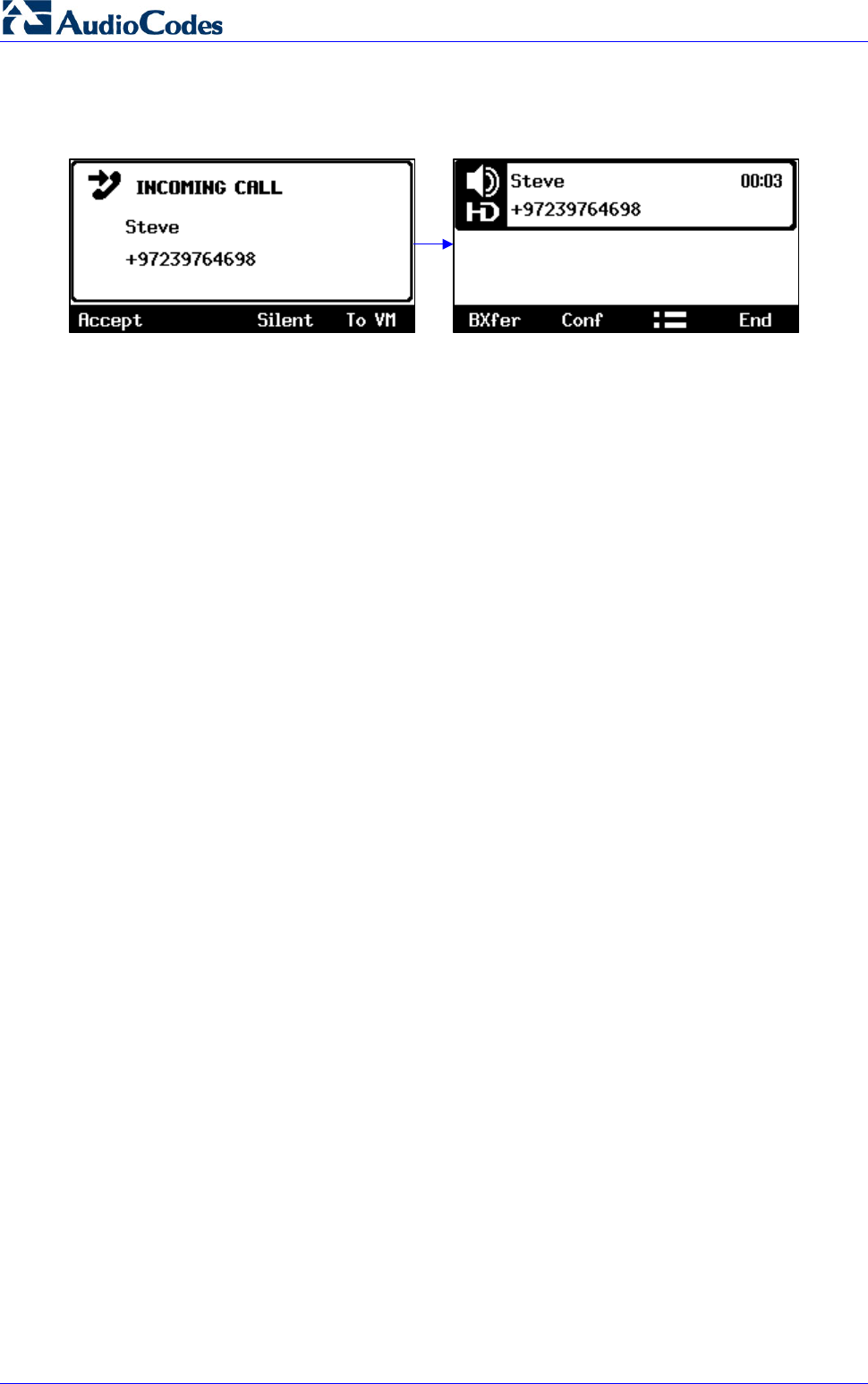
430HD and 440HD IP Phone
User's Manual 114 Document #: LTRT-11939
To answer a call on the IP phone:
1. When the INCOMING CALL screen is displayed in the IP phone's user interface, press the
Accept softkey; the call is answered.
2. You can end the call by pressing the End softkey.
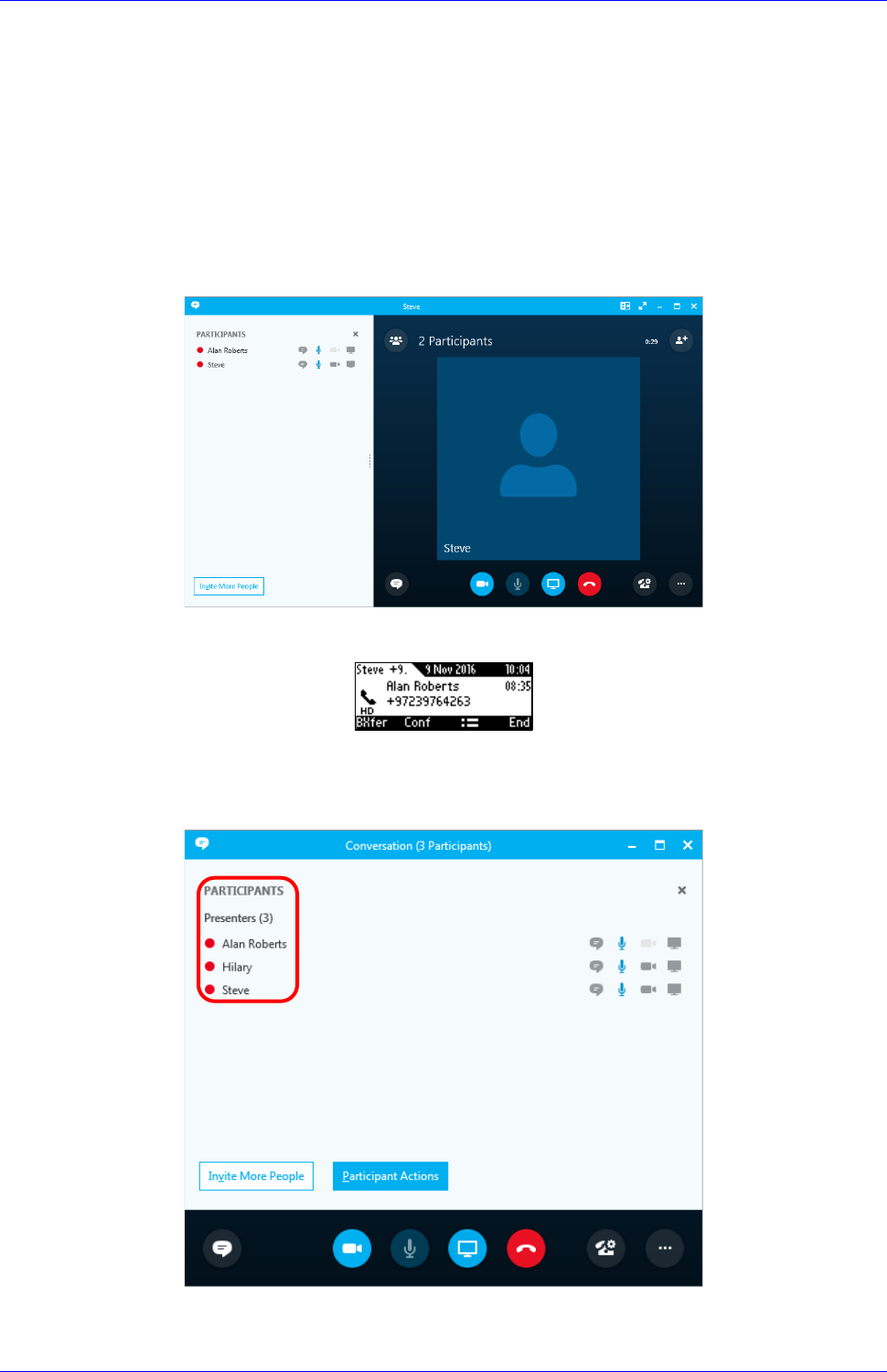
User's Manual Contents
Version 3.0.1 115 430HD and 440HD IP Phone
8.2.4 Establishing a Unified Communications Call Conference
The phone supports multi-party Skype for Business remote conferencing. BToE is not mandatory
for conferencing - see Section 8.9 for more information about conferencing. BToE is mandatory
for unified communications conferencing. When BToE is installed, the phone's screen mirrors the
PC Skype for Business client; conferencing in the phone's screen then reflects conferencing in
the PC Skype for Business client.
The example below shows how BToE integrates phones with PC Skype for Business clients for
unified communications call conferencing.
In the PC Skype for Business client, Alan calls Steve.
Steve answers his phone.
[The screen of another phone model is shown here for illustrative purposes]
In his client, Alan clicks Invite More People and dials Hilary, who answers.
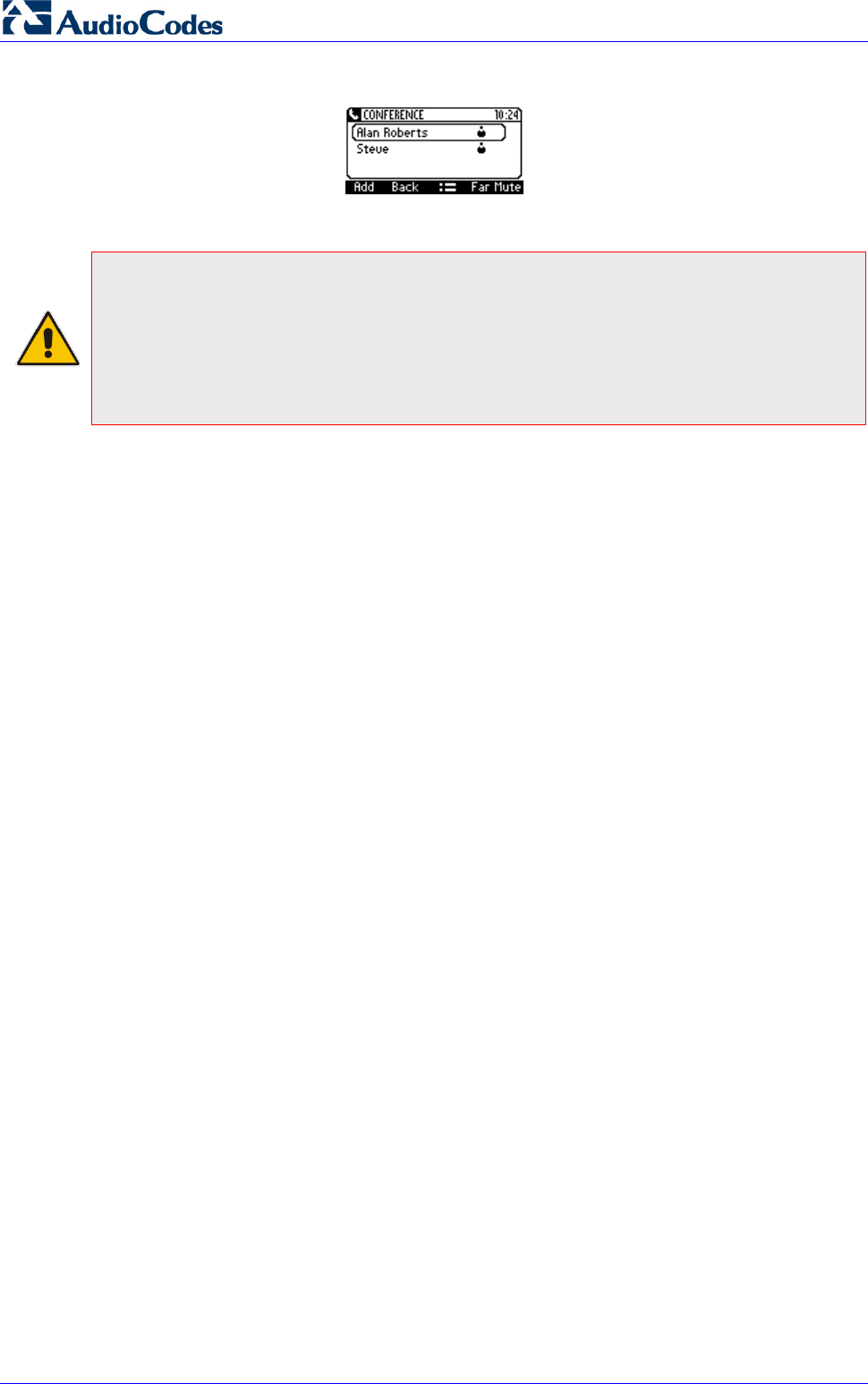
430HD and 440HD IP Phone
User's Manual 116 Document #: LTRT-11939
Hilary sees the call is a conference call initiated by Alan and that Steve has been invited:
[The screen of another phone model is shown here for illustrative purposes].
Note:
• After making a call in the client, you can invite an unlimited number of other participants.
• You can use the phone's speakerphone, handset or headphones to continue the meeting.
• When a user whose phone is connected to BToE joins a meeting, their phone is muted
and the red MUTE button is lit. The user can unmute using the phone's MUTE button.
• You can press the phone's End softkey to end a meeting.
See Section 8.9 for more information about conferencing.
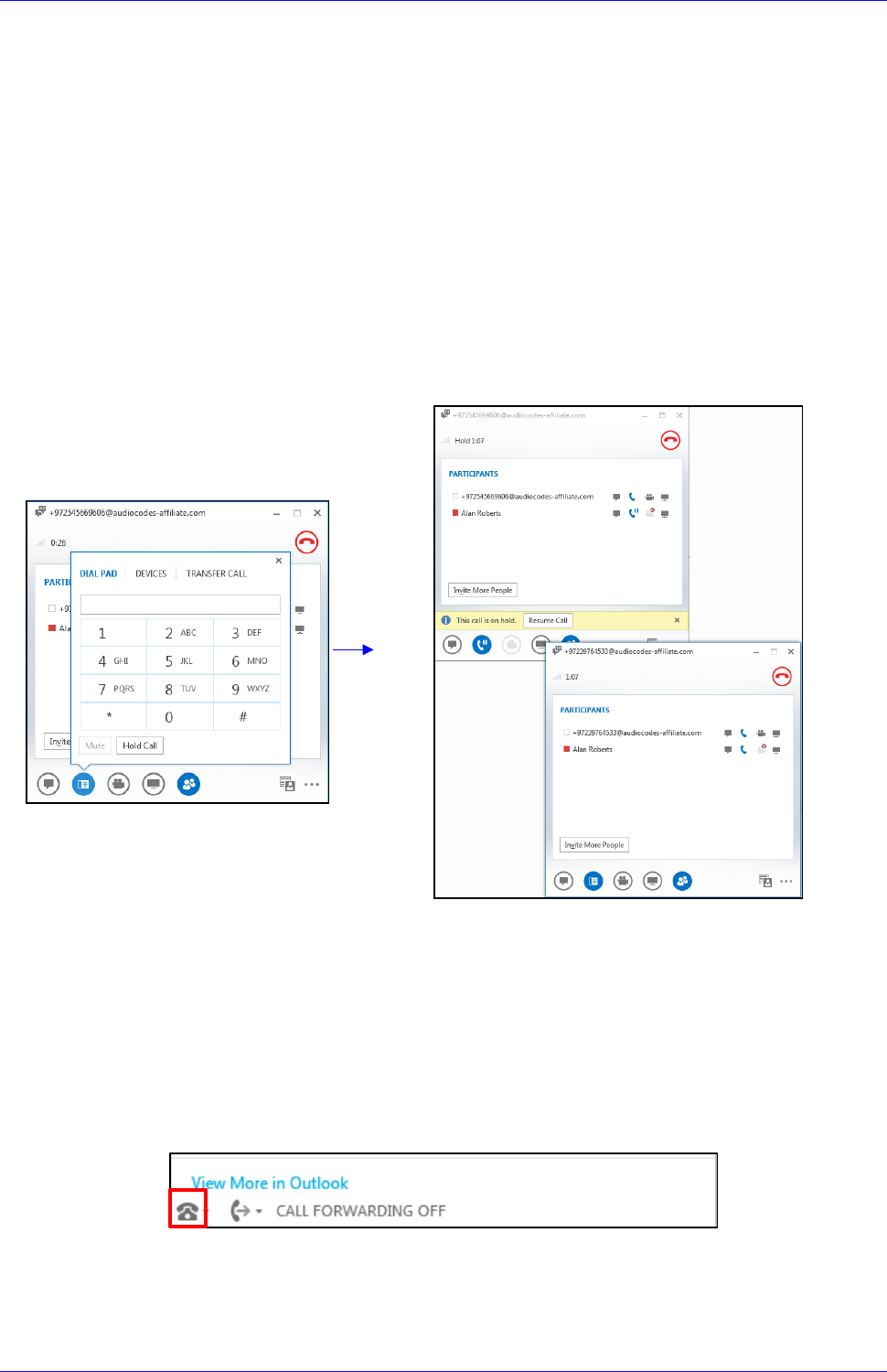
User's Manual Contents
Version 3.0.1 117 430HD and 440HD IP Phone
8.2.5 Transferring a Call
You can transfer a call to another party either from your PC Skype for Business client or IP
phone, whichever is more convenient for you at the time, for an enhanced unified
communications experience.
To transfer a call:
1. From your PC Skype for Business client or IP phone, whichever is more convenient, make a
call; calling is indicated on both the PC Skype for Business client and the IP phone.
2. When the called party answers, you can perform a blind transfer or a consultative transfer,
using your phone or your PC Skype for Business client, whichever you prefer.
• For detailed information on performing call transfer with the phone, see Section 8.6.
• For details on performing call transfer with the PC Skype for Business client, see
Microsoft documentation. A guideline is shown below. The operation is mirrored in your
phone. Note that a paired Skype for Business client can’t perform consultation transfer.
8.2.6 Switching the Primary Audio Device
BToE lets you switch primary audio device, so you can switch from listening to a Skype for
Business conversation through the phone handset, for example, to listening on a headset, or from
listening on a headset to listening through the IP phone speaker.
To determine which audio device is currently primary:
Locate in the lowermost left corner of the Skype for Business client screen the icon indicating
'Primary Device'.
Figure 8-27: Primary Device: IP Phone
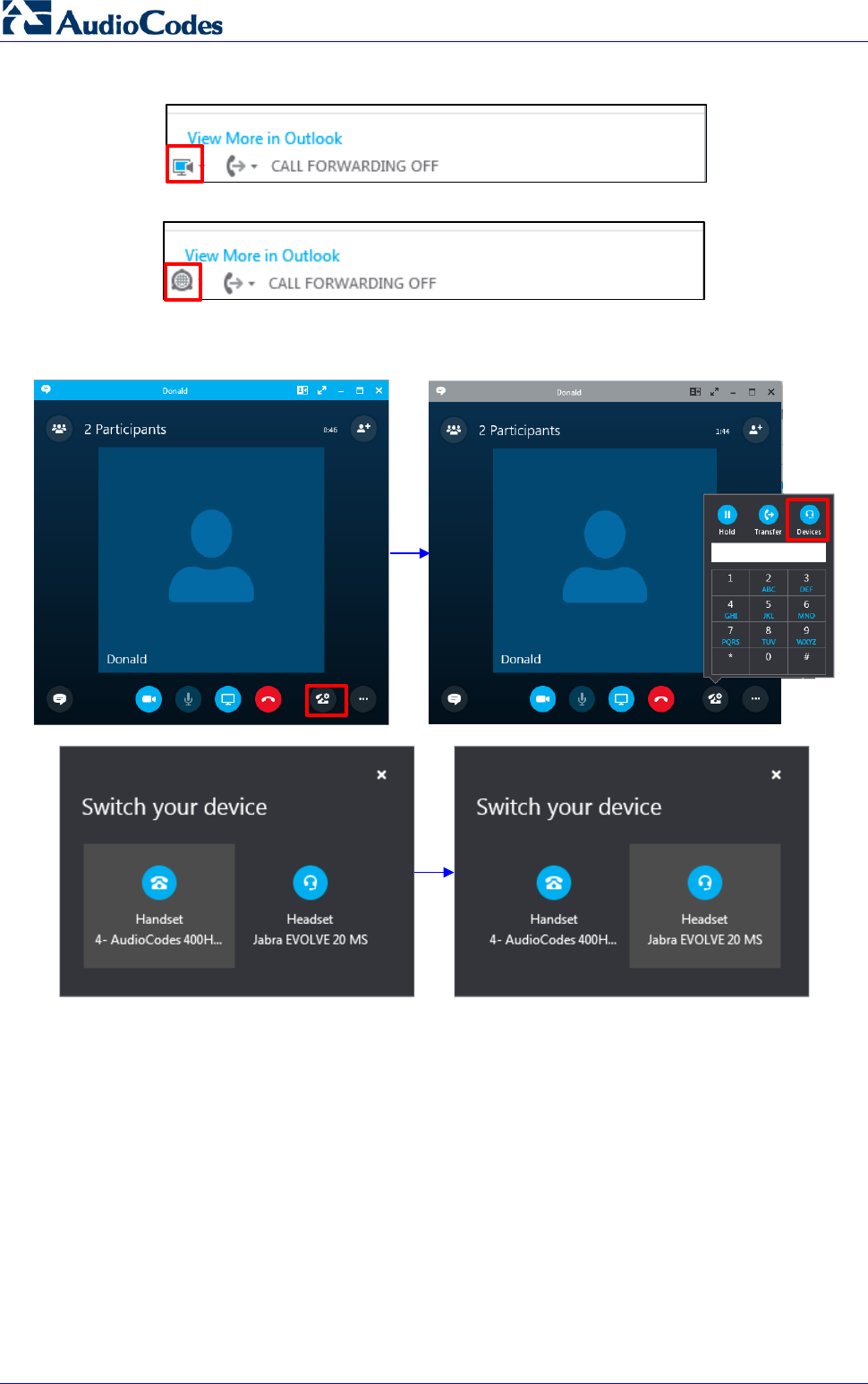
430HD and 440HD IP Phone
User's Manual 118 Document #: LTRT-11939
Figure 8-28: Primary Device: Headset
Figure 8-29: Primary Device: Speaker
To switch primary device:
In a Skype for Business call, click the Call Control icon and select Devices.
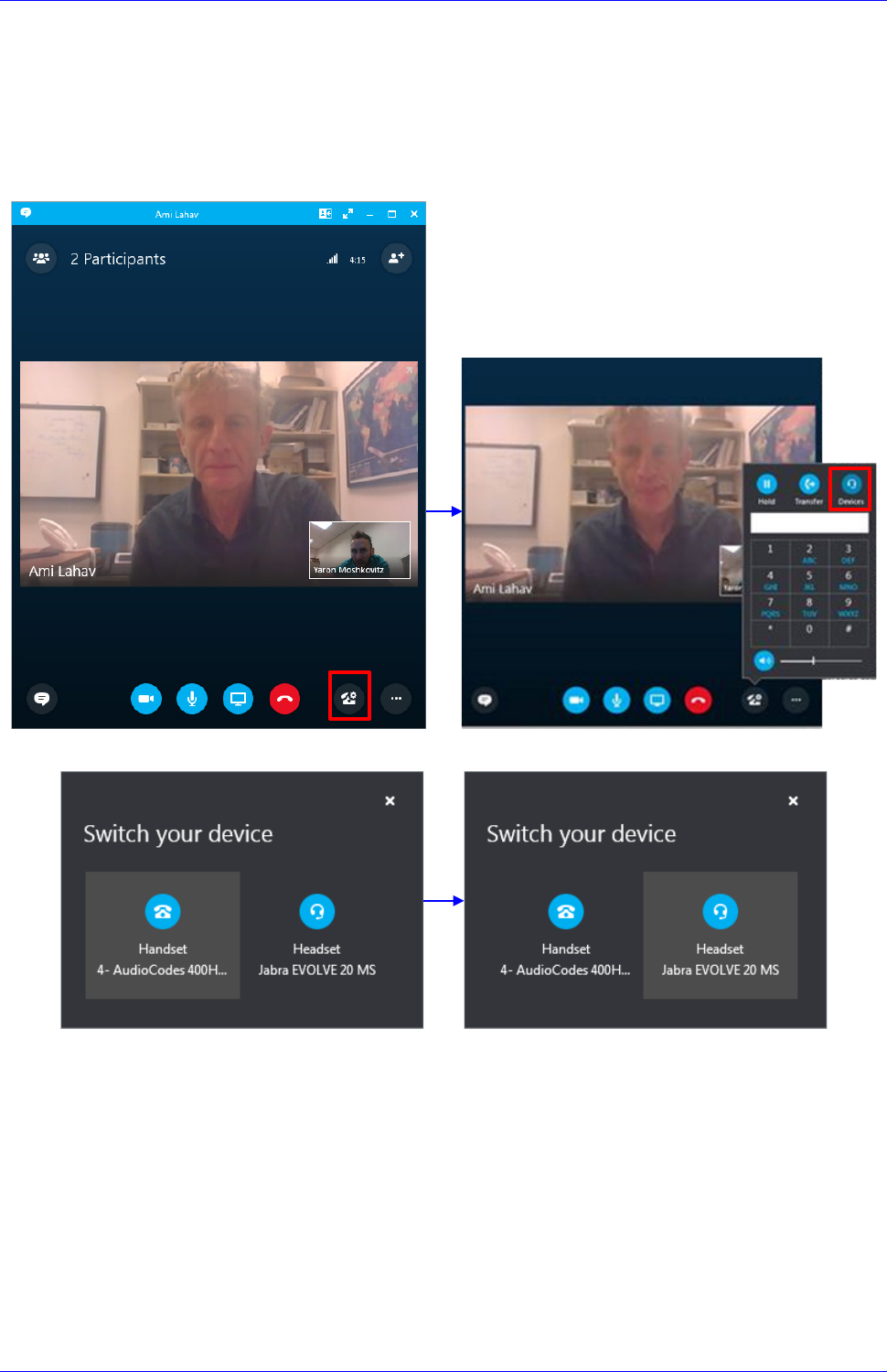
User's Manual Contents
Version 3.0.1 119 430HD and 440HD IP Phone
8.2.7 Routing Voice from a Video Call to the Phone
When a video call comes in, video is displayed in the PC/laptop based Skype for Business client.
The user can route the voice from the video call to the phone. In this scenario, the phone
performs similarly to a USB device.
The example below illustrates how Ami Lahav, who's in a video call with Yaron Moshkovitz,
routes voice to the phone.
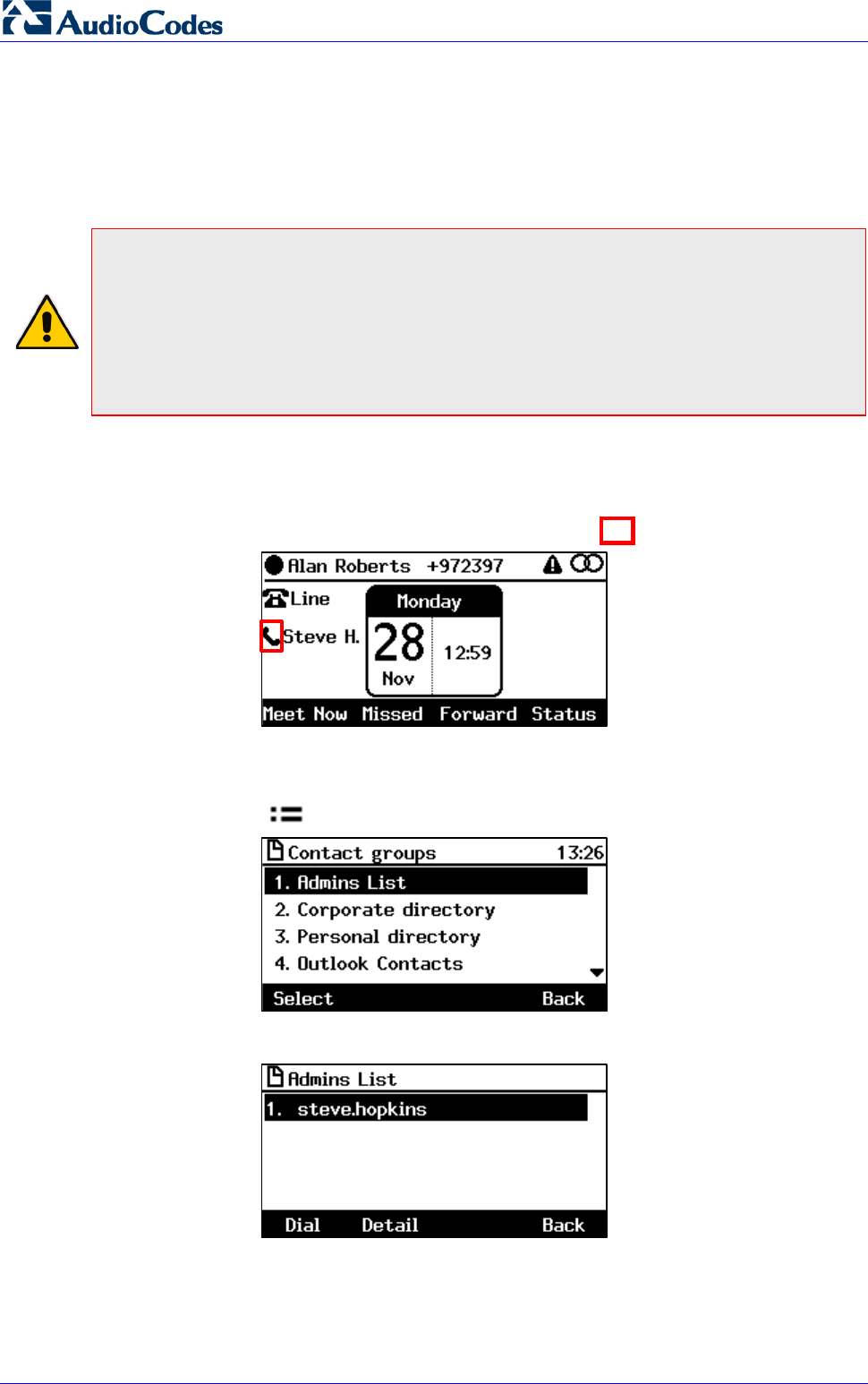
430HD and 440HD IP Phone
User's Manual 120 Document #: LTRT-11939
8.3 Using the Boss Admin Feature
This section shows how to use the Boss Admin feature. The feature allows a relationship to be
established between a boss's phone and an administrative secretary's phone. The feature
streamlines office workflow and enhances office efficiency.
Note:
• Each phone can support up to five Bosses or Admins.
• For setup information, see the Administrator's Manual.
• To remove an Admin, the Boss must remove the Admin in the 'Call Forwarding –
Delegates' screen (open the Skype for Business client > click Call Forward Settings >
click Edit my delegate members > select the Admin > click Remove). It's not enough to
turn off call forwarding.
8.3.1 Viewing who the Admins are on the Boss' Phone
After configuring an Admin, you can view the Admin on the Boss' phone.
In the Boss's phone's idle screen, the Admin line is indicated by this icon:
To alternatively see the Admins on the Boss' phone:
1. Press the CONTACTS hard key on the phone and and then in the Favorities screen that
opens, press the softkey; the Contact groups are displayed:
2. Select Admins List from the Contact groups.
One Admin is configured: Steve Hopkins
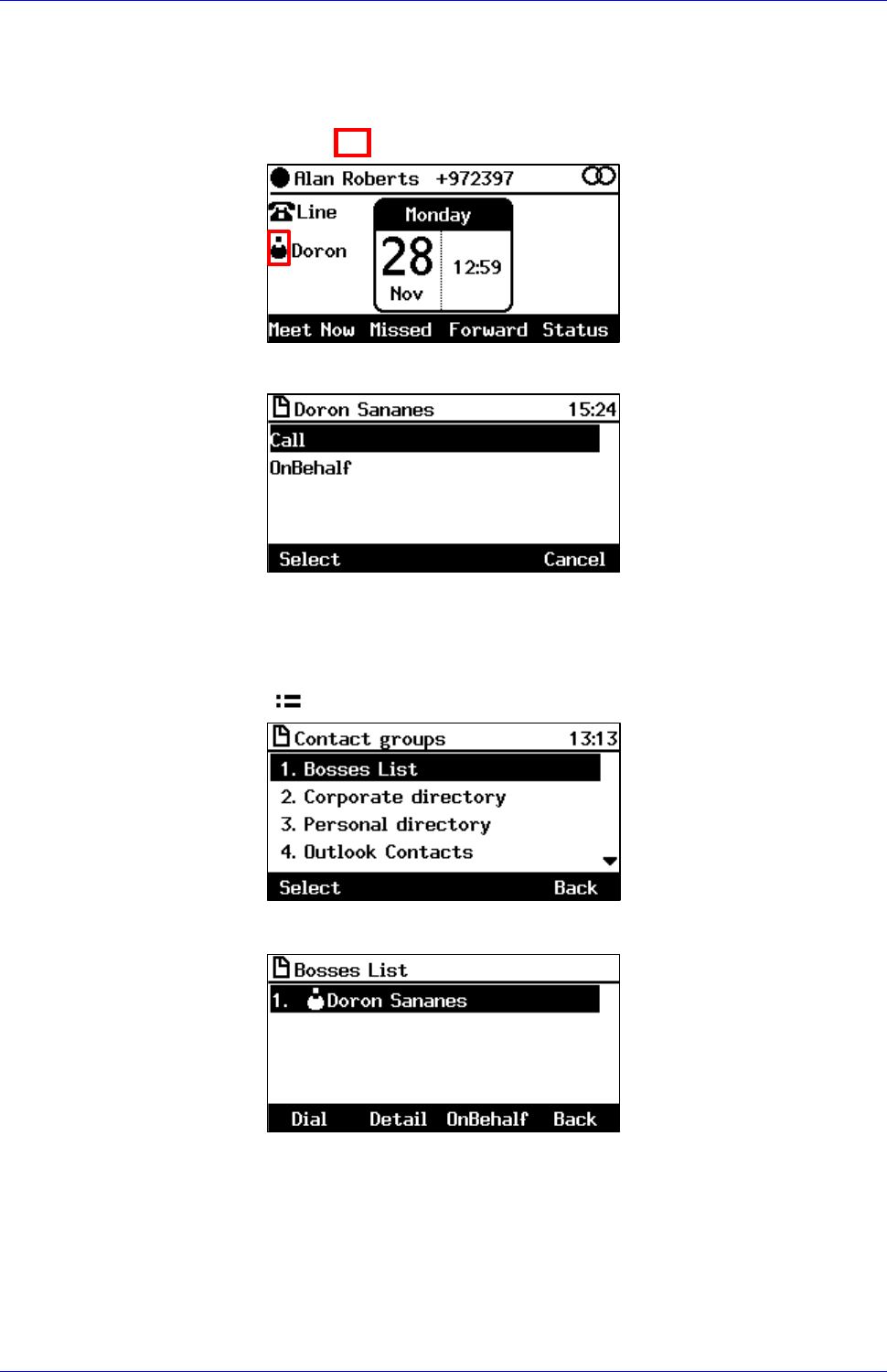
User's Manual Contents
Version 3.0.1 121 430HD and 440HD IP Phone
8.3.2 Viewing who the Bosses are on the Admin's Phone
You can view on your phone which Boss configured you on their phone as an Admin. This can be
useful for an administrative secretary replacing another during a lunch break.
The Boss' line is indicated by this icon in the Admin's idle screen:
On the phone, you can press the line key of a Boss:
Select Call to dial that Boss or OnBehalf to dial on behalf of that Boss.
To alternatively see the Bosses on an Admin's phone:
1. Press the CONTACTS hard key on the phone and and then in the Favorities screen that
opens, press the softkey; the Contact groups are displayed.
2. Select Bosses List from the Contact groups.
One Boss is configured, as you can see: Doron Sananes
3. From the list, you can select a Boss and press the Dial softkey to dial them, or press the
OnBehalf softkey to dial a destination number on their behalf.
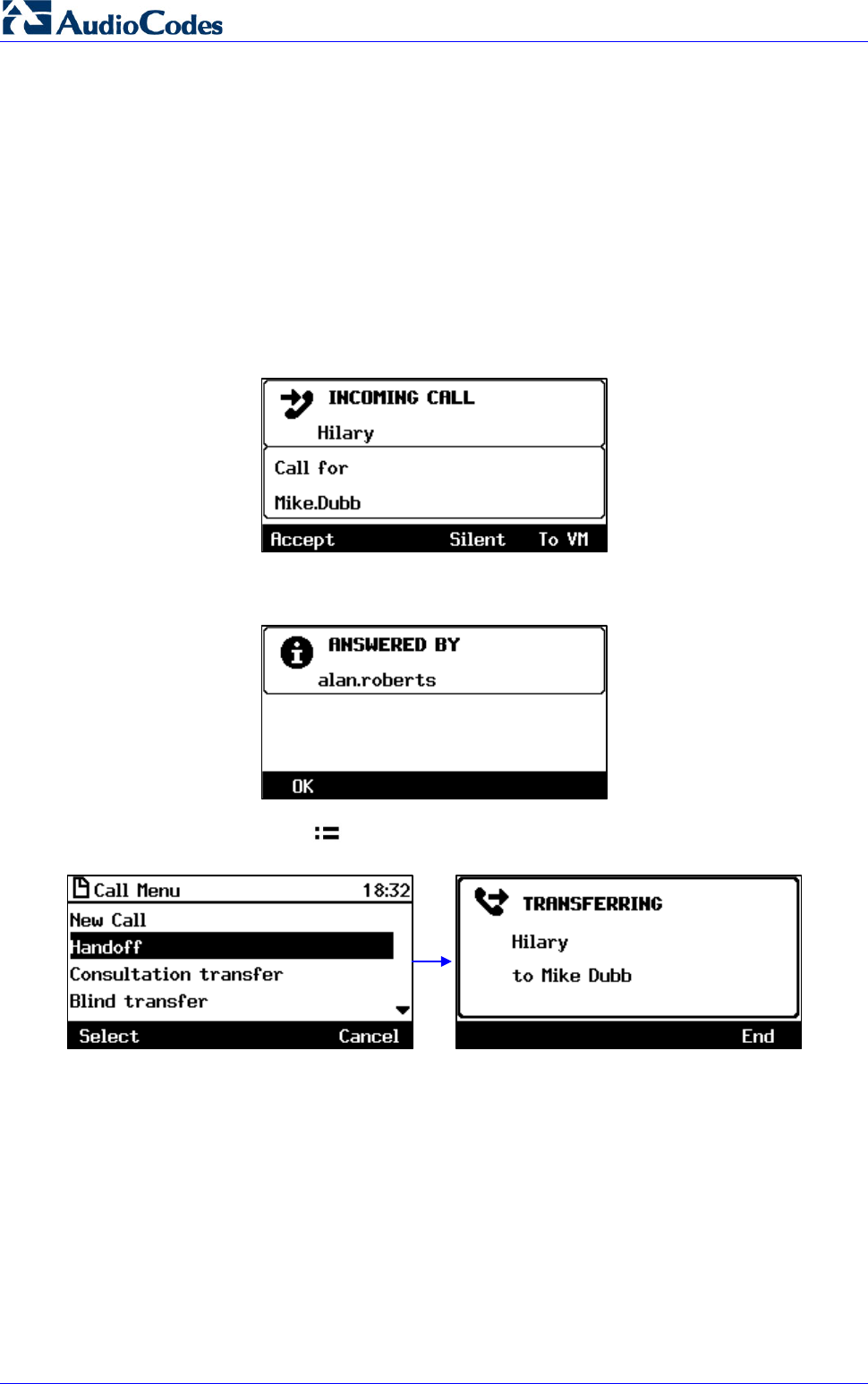
430HD and 440HD IP Phone
User's Manual 122 Document #: LTRT-11939
8.3.3 Viewing Bosses and Admins
You can be a Boss and you can have a Boss. You can be an Admin in charge of the other
Admins in the office, i.e., you can be their Boss, but you can also report to a Boss above you. You
can, therefore, have two lists displayed in your IP phone: Bosses and Admins. To view them,
access the 'Contacts groups' screen as shown in the previous section.
8.3.4 Handling an Incoming Call for the Boss
Admin can handle an incoming call for the Boss.
To handle an incoming call for the Boss:
1. If a call (from Hilary for example) comes in on the phone of the Boss (Mike Dubb), the
phone of the Admin (Alan Roberts, shown below) rings simultaneously:
2. Admin can press the Accept softkey or lift the handset to take the call. On the Boss' phone,
a notification is displayed indicating the call was answered by Admin.
3. Admin can press the softkey and from the Call Menu screen that opens, select the
Handoff option; the call is transferred to the Boss.
4. When the Boss answers, a notification is displayed on Admin's phone indicating the the call
was answered by Boss (similar to the notification displayed on Boss' phone when a call is
answered by Admin).
8.3.5 Calling on Behalf of the Boss
Admin can make a call on behalf of Boss by
pressing Boss' line key (see Section 8.3.5.1)
keying the digits of the destination number (see Section 8.3.5.2)
pressing the CONTACTS key on the phone (see Section 8.3.5.3)
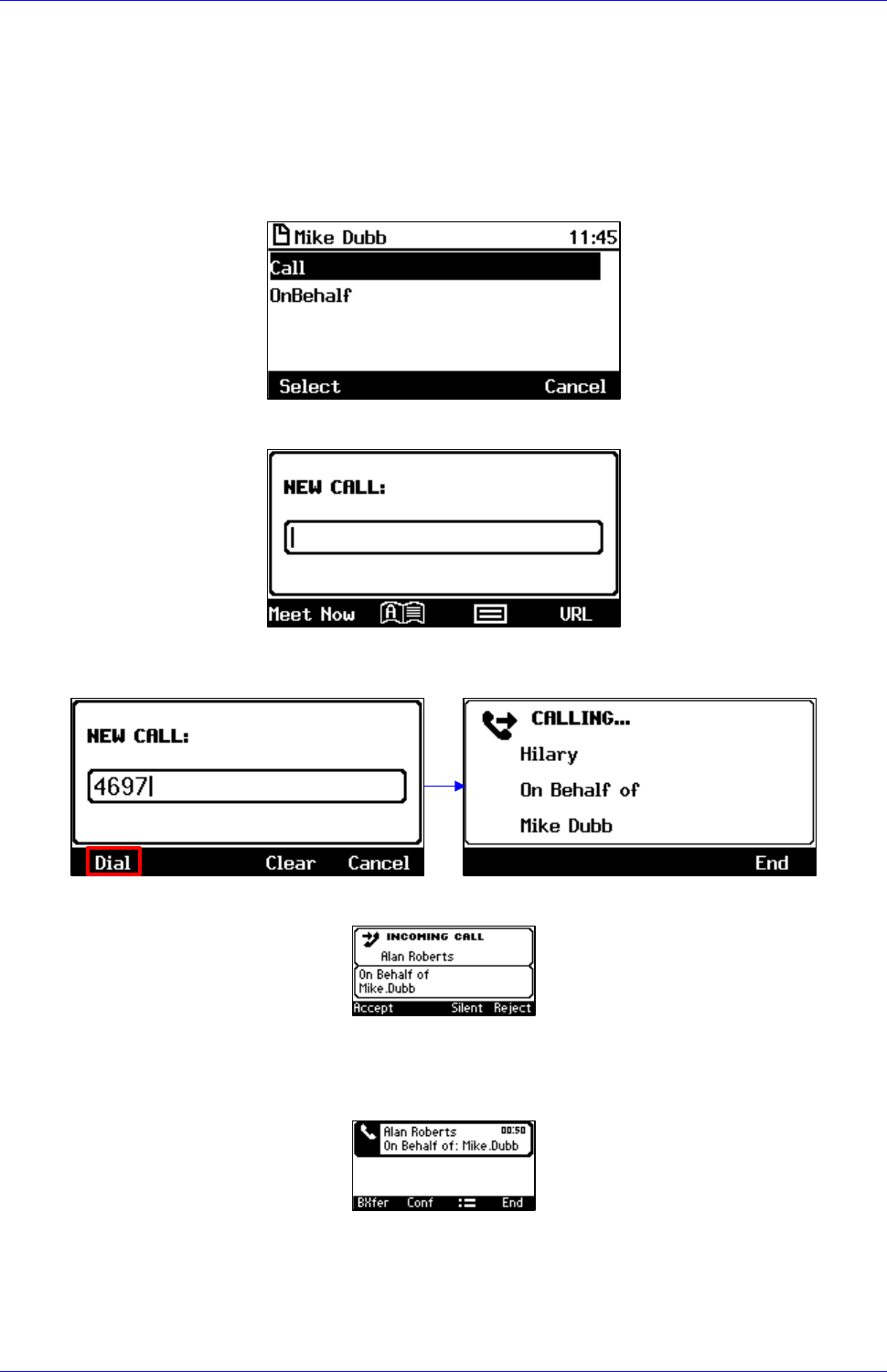
User's Manual Contents
Version 3.0.1 123 430HD and 440HD IP Phone
8.3.5.1 Using Boss' Line Key
Admin can call on behalf of Boss by pressing Boss' line key in Admin's phone's idle screen.
To make a call on behalf of Boss using Boss' line key:
1. In the idle screen of the Admin's phone, press the line key of the Boss (Mike Dubb, in the
example below).
2. Scroll down and select Call on behalf.
3. Enter the number of the destination to call (Hilary, in the example below) and press the
enabled Dial softkey; the number is dialed; Hilary's end rings.
4. Hilary views an incoming call from Admin (Alan) on behalf of Boss (Mike).
[The screen of another phone model is shown here for illustrative purposes].
5. Hilary answers; Hilary's phone displays this screen:
[The screen of another phone model is is shown here for illustrative purposes].
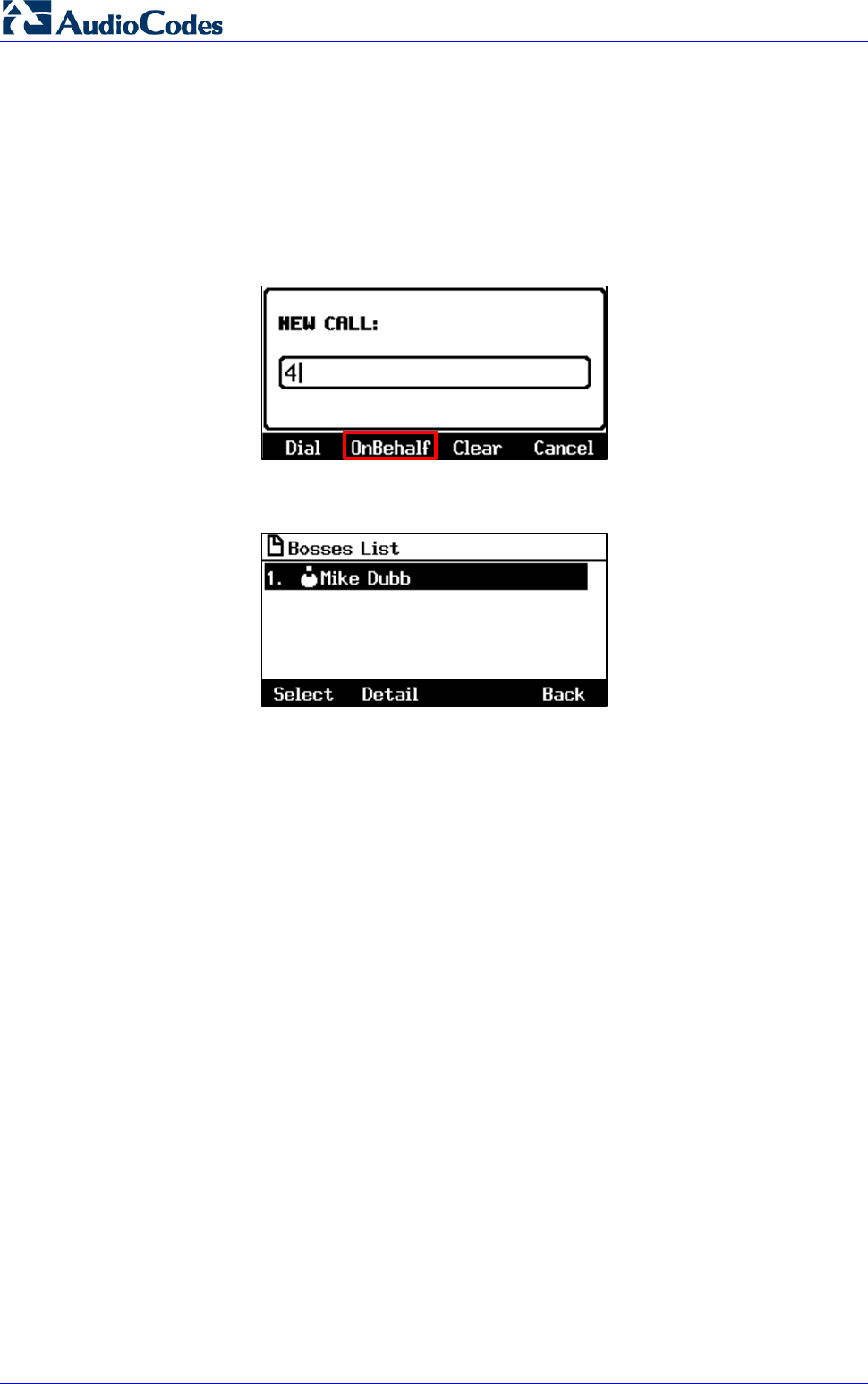
430HD and 440HD IP Phone
User's Manual 124 Document #: LTRT-11939
8.3.5.2 Keying in the Destination Phone Number
You can make a call on behalf of Boss by pressing the digit keys of the destination phone
number.
To make a call on behalf of Boss:
1. On the phone's dial pad, press the first digit key of the destination number; the NEW CALL
screen opens displaying the OnBehalf softkey:
2. Enter the rest of the destination number and then press the OnBehalf softkey; the Bosses
List screen opens:
3. Navigate to the Boss on behalf of whom to call (the screen above shows only one configured
Boss, Mike Dubb, as an example), and then press the Select softkey; the phone of the
called party phone shows an INCOMING CALL on behalf of Mike Dubb (the Boss).
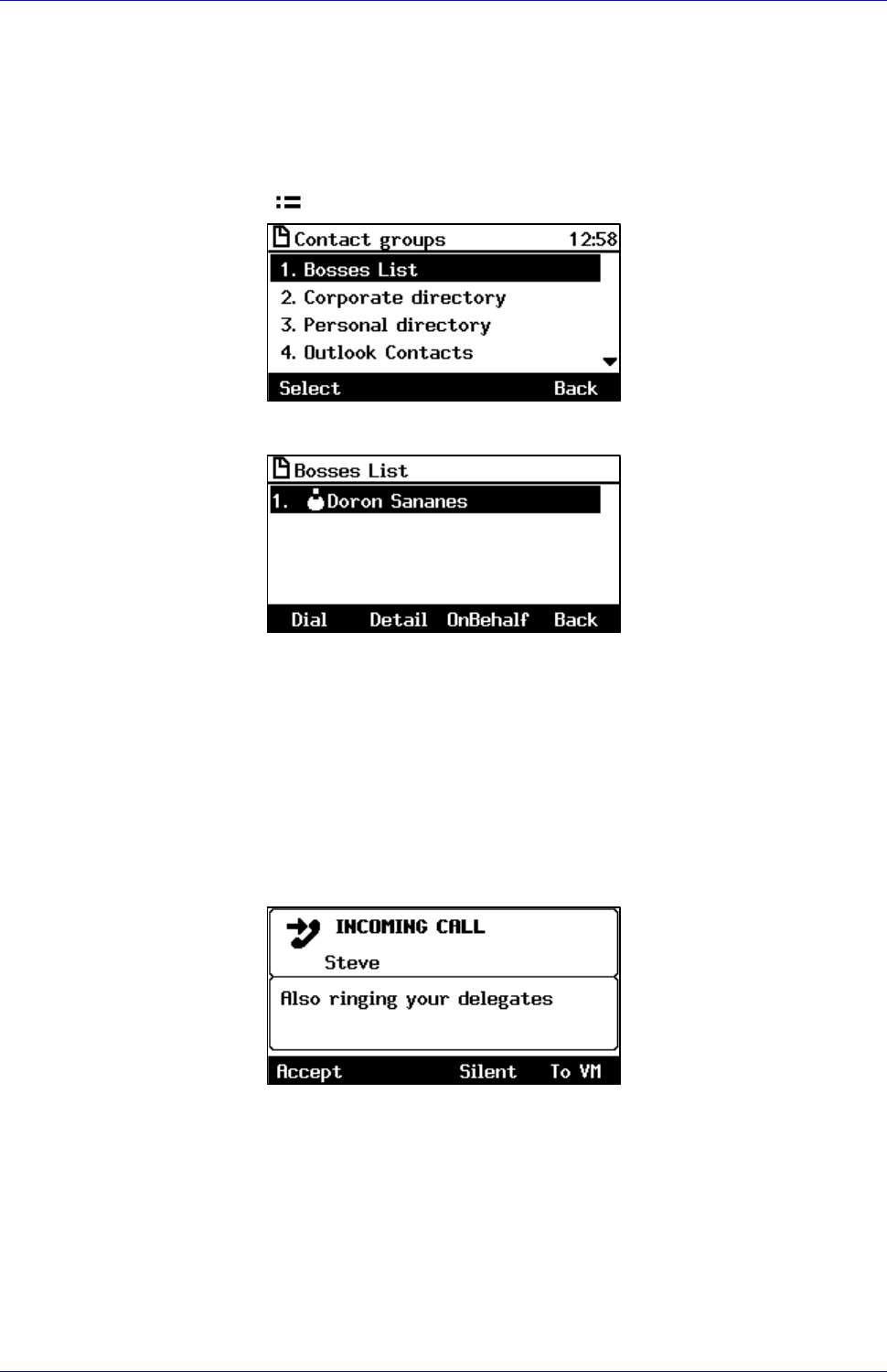
User's Manual Contents
Version 3.0.1 125 430HD and 440HD IP Phone
8.3.5.3 Pressing the CONTACTS Key
You can make a call on behalf of Boss by pressing the CONTACTS key on the phone.
To call on behalf of Boss by pressing the CONTACTS key:
1. Press the CONTACTS hard key on the phone and and then in the Favorities screen that
opens, press the softkey; the Contact groups are displayed:
2. Select the Bosses List option.
3. Select the Boss on whose behalf you want to make the call.
4. Press the OnBehalf softkey and then dial the required number.
8.3.6 Answering a Call on Boss' Phone
When a call comes in for Boss, Boss' phone and Admin's phone ring simultaneously. Boss can
answer the call independently of Admin.
To answer a call on Boss' phone:
1. When Boss' phone rings, Boss views INCOMING CALL (from Steve, in the example below).
Also indicated is that the phones of Boss' Admins (delegates) are also ringing.
2. If Boss answers the call, a notification is displayed on Admin's phone indicating the call was
answered by Boss.
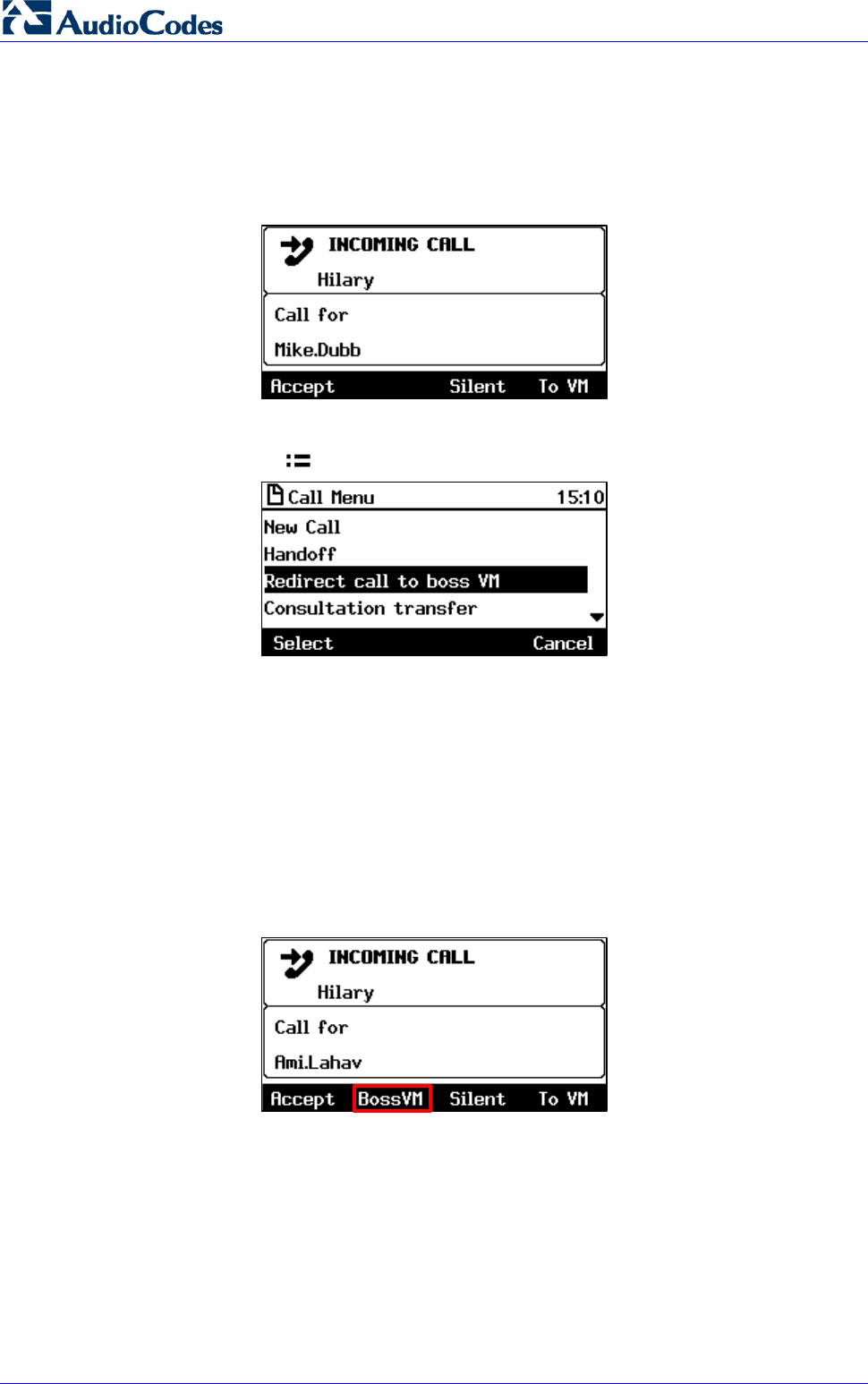
430HD and 440HD IP Phone
User's Manual 126 Document #: LTRT-11939
8.3.7 Redirecting an Established Call to Boss' Voicemail
Admin can redirect an established call to Boss' voicemail.
To redirect an established call to Boss' voicemail:
1. Admin's phone rings at the same time as Boss' phone when a call for Boss comes in.
2. Admin presses the Accept softkey or lifts the receiver to establish the call.
3. Admin presses the softkey; the Call Menu is displayed:
4. Admin selects Redirect call to boss VM; the call is forwarded to Boss' voicemail.
8.3.8 Redirecting an Incoming Call to Boss' Voicemail
Admin can redirect an incoming call to Boss' voicemail without answering it. For this feature to be
supported, Microsoft Exchange Unified Messaging - including voicemail - must be activated on
Boss’ account.
To redirect an incoming call to Boss' voicemail:
1. When a call for Boss (Ami Lahav in the example below) comes in, Admin's phone rings at
the same time as Boss' phone. Admin's phone displays a BossVM softkey when the call
comes in.
2. Admin presses the BossVM softkey before accepting the call; the call is automatically
redirected to Boss’ voicemail.
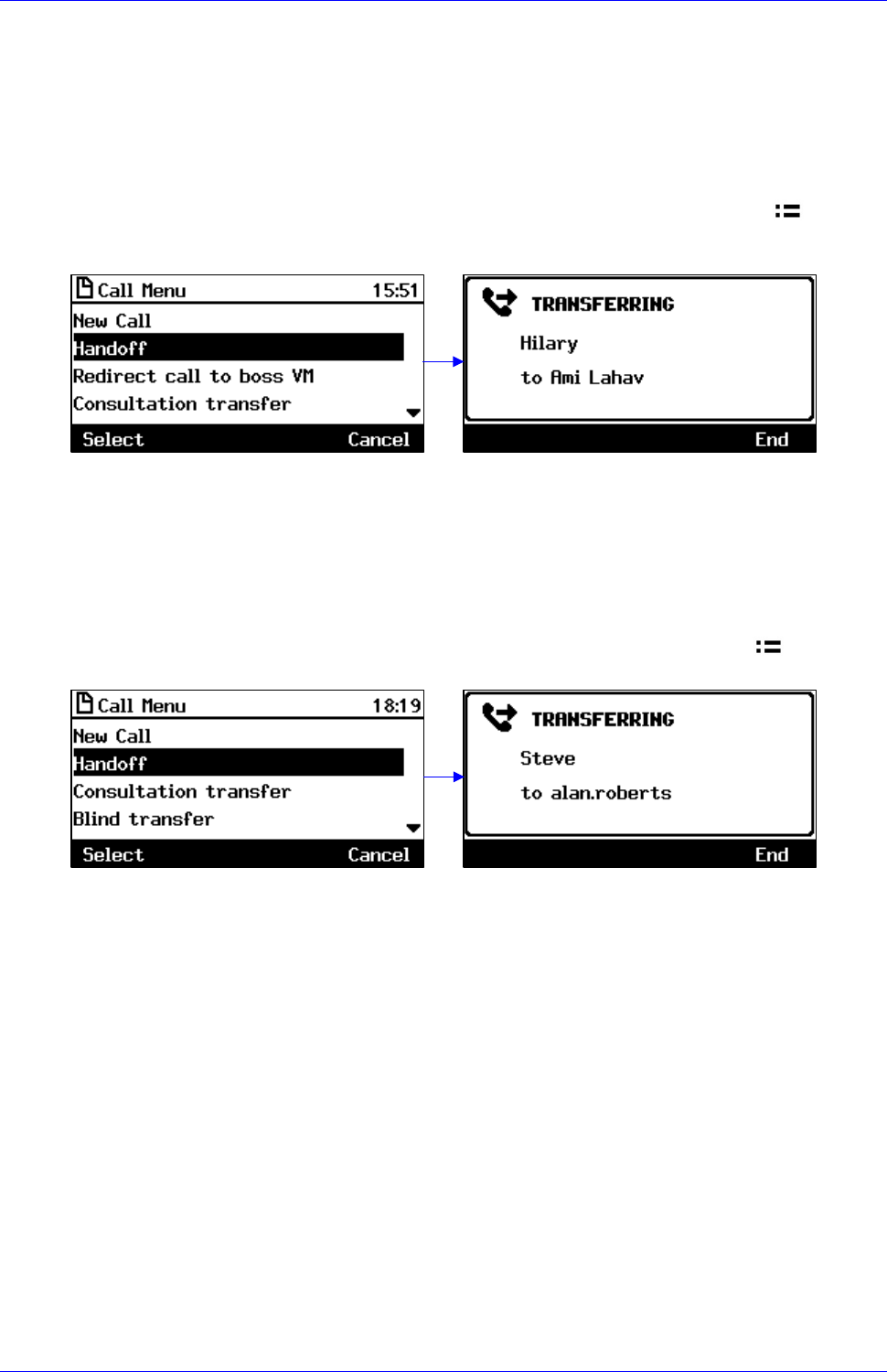
User's Manual Contents
Version 3.0.1 127 430HD and 440HD IP Phone
8.3.9 Admin Handing Off a Call to Boss
When in a call on Boss' behalf, Admin can hand the call off to Boss. Boss' phone rings and Admin
is disconnected. This is similar to Blind Transfer (see Section 8.6.1) except that Boss is always
the party to whom the call is transferred.
To hand off a call to Boss:
When in a call on behalf of Boss (with Hilary, in the example below), press the softkey
and in the Call Menu, scroll to and select the Handoff option; the call with Hilary is handed
off to Boss (Ami Lavi)
8.3.10 Boss Handing Off a Call to Admin
When in a call, Boss can hand off the call to Admin. This is similar to Blind Transfer (see
Section 8.6.1) only with Admin always the party to whom the call is transferred. Admin's phone
rings and Boss is disconnected.
To hand off a call to Admin:
When Boss is in a call (with Steve, in the example below), Boss presses the softkey and
selects the Handoff option to hand off Steve to Admin (Alan Roberts).
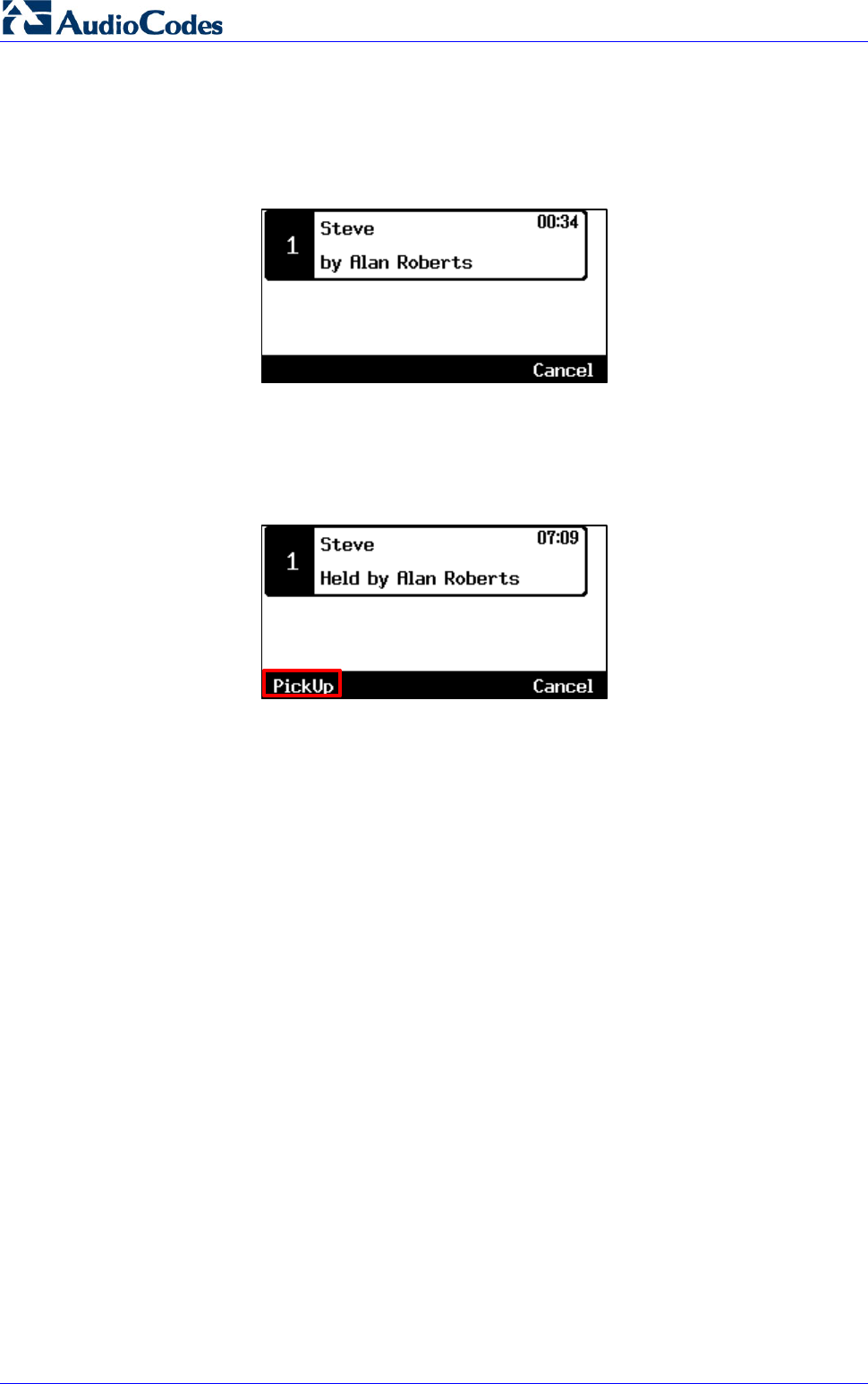
430HD and 440HD IP Phone
User's Manual 128 Document #: LTRT-11939
8.3.11 Boss Monitoring Admins, Seizing a Call Put on Hold by an Admin
Boss can monitor Admin when Admin is in a call on Boss’ behalf. If Admin's line key on Boss'
phone flashes red slowly, it indicates to Boss that Admin is in a call on Boss' behalf. Boss can
long-press the line key to see at a glance with whom Admin is talking and for how long they've
been talking.
In the example above, Admin (Alan Roberts) answered a call on Boss' behalf from Steve. They've
been talking for 34 seconds.
If Boss long-presses the red-flashing line key of Admin (Alan Roberts, in the example below)
and Admin has put the call with Steve on hold, Boss will see that the call is on hold and that
the PickUp option is available.
Boss can press the PickUp softkey to seize the call from Admin, who'll be disconnected.
Boss can then talk with the other side (Steve).
8.3.12 Admin Picks up a Call from Boss
Admin can pick up a call from Boss:
A call comes in and Admin determines that Boss has answered it because Admin didn't
answer and the Programmable Key on Admin's phone is flashing
Admin long-presses the Programmable Key to verify that Boss indeed answered and is in a
call
If Boss puts the caller on hold, the Pick up softkey displays on Admin's phone
Admin presses the Pick up softkey and picks up the call from Boss
8.3.13 Admin 1 Picks up a Call from Admin 2
Admin 1 can pick up a call from Admin 2:
A call comes in and Admin 2 answers it on behalf of Boss
Admin 1 sees in Admin 1’s screen that Admin 2 has taken the call on behalf of Boss
Admin 1 long-presses the Programmable Key
If Admin 2 puts the caller on hold, the Pick up softkey displays in Admin 1's screen
Admin 1 presses the Pick up softkey and picks up the call from Admin 2
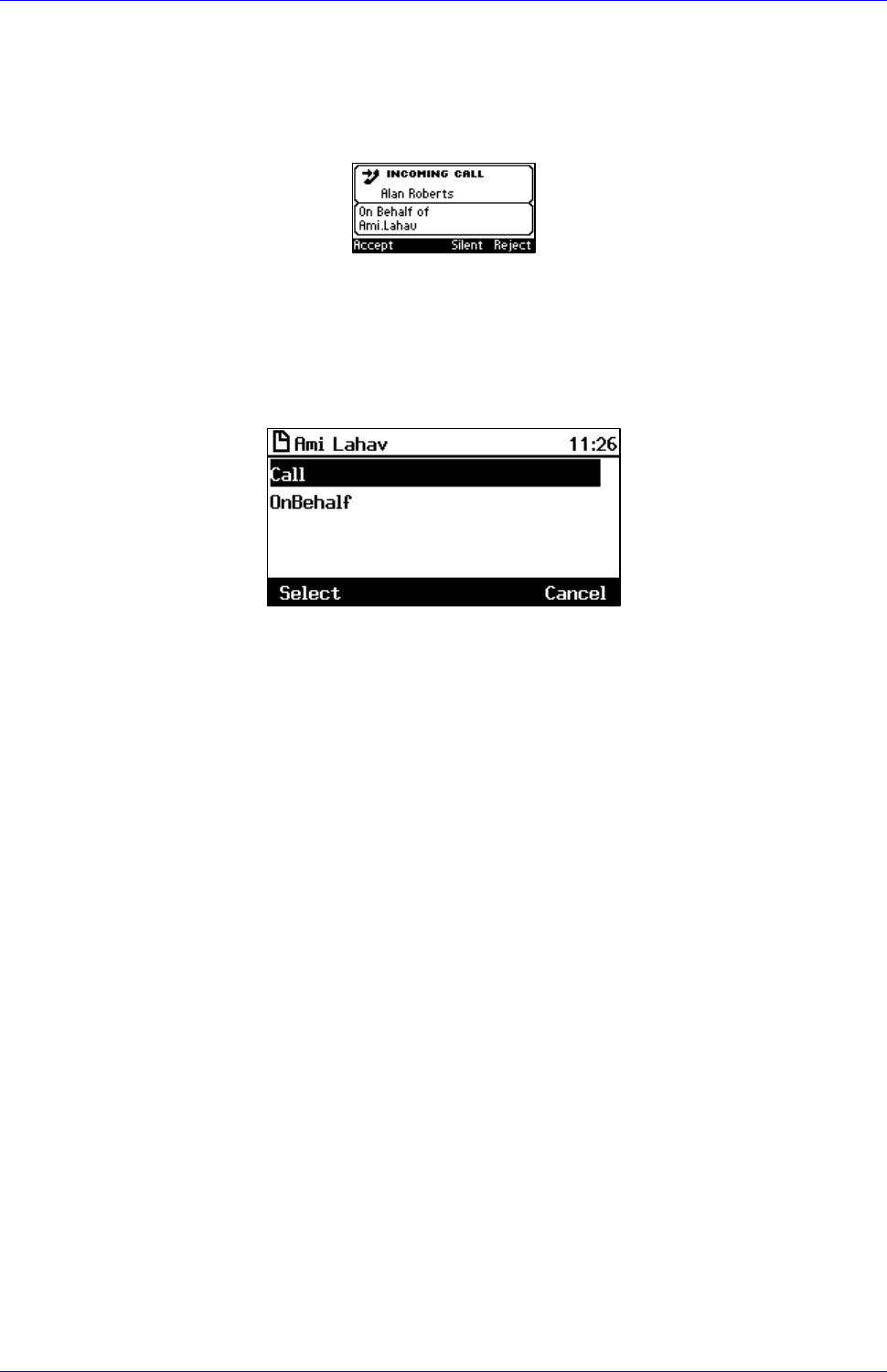
User's Manual Contents
Version 3.0.1 129 430HD and 440HD IP Phone
8.3.14 Admin's Phone Notifies Recipient that Admin's Call is on Behalf of
Admin's Boss
Admin’s phone notifies the recipient that Admin is calling on behalf of Admin's Boss. This function
applies to external recipients as well.
[The screen of another phone model is is shown here for illustrative purposes].
8.3.15 Admin Calling Boss, Admin Calling a Recipient on Behalf of Boss
Admin can short-press the Boss' line key on the phone to call Boss or to call a recipient on behalf
of Boss.
Call = select to call Boss
OnBehalf = select to call another recipient on behalf of Boss
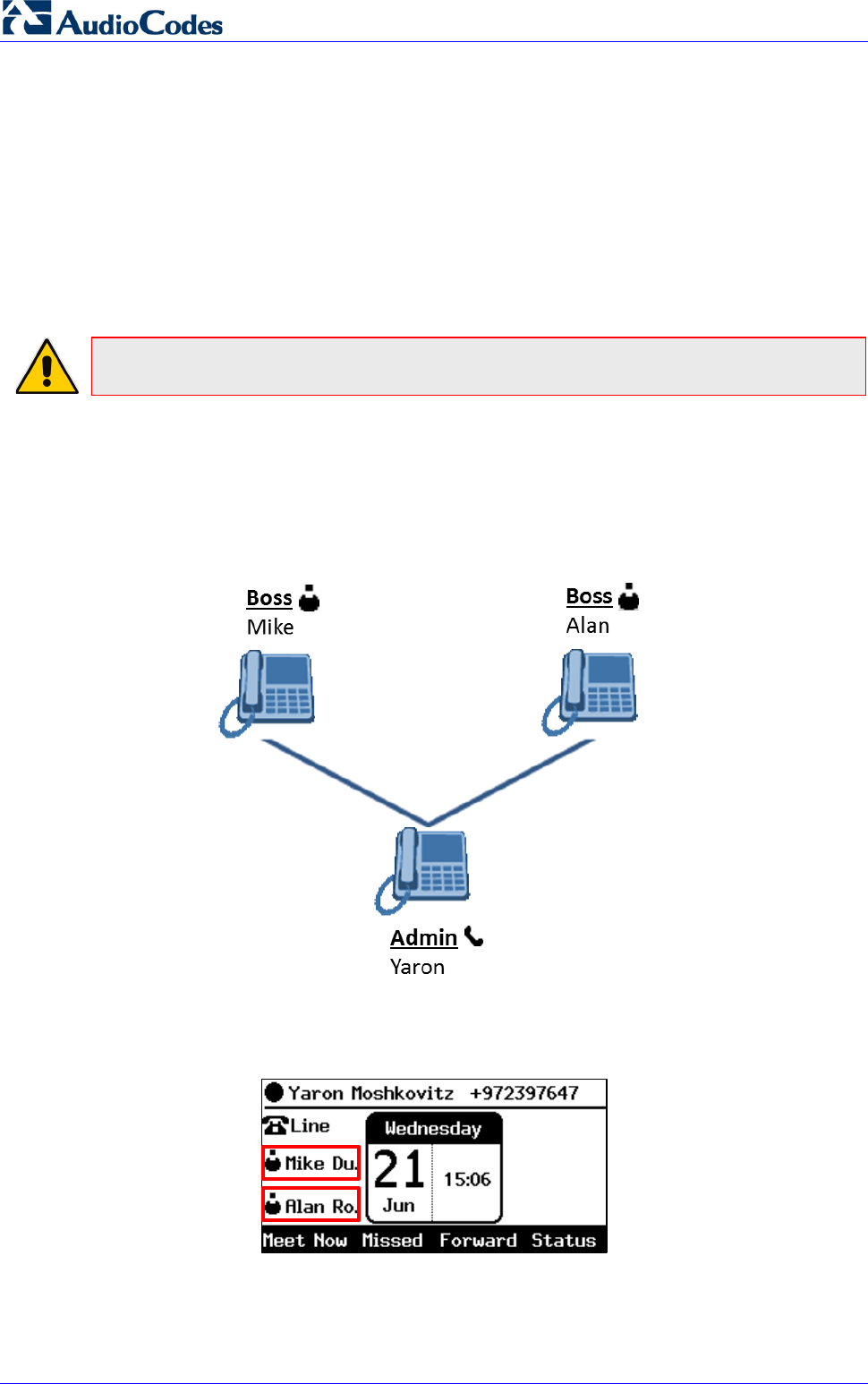
430HD and 440HD IP Phone
User's Manual 130 Document #: LTRT-11939
8.4 Using the Multiple Boss Admin Feature with the 440HD
Sidecar
This section shows how you can benefit from the multiple Boss Admin feature, typically but not
exclusively implemented in a hotline or call center environment.
The feature allows multiple relationships to be established between multiple Boss' phones and
multiple Admins' phones (up to five Bosses/Admins). The sidecar on the 440HD phone, together
with the phone's screen, allow these relationships to be implemented.
The feature streamlines workflow and enhances efficiency between office managers and workers.
Note: Each 440HD phone's screen can support up to five Bosses or Admins.
8.4.1 Displaying a Boss's or an Admin's Active Calls in the Sidecar
This section demonstrates using the multiple Boss Admin feature. In the figure below, you can
see two Boss phones: Mike and Alan. They share an Admin, Yaron, whom they delegated in
Skype for Business client/server - see the Administrator's Manual for setup information.
Table 8-1: Multiple Boss Admin
To view a Boss's active calls:
1. On Admin's phone's, Admin sees the two Boss lines' softkeys:
• If the adjacent hard key LED on the phone is illuminated green, Boss is available.
• If it flashes red, Boss is busy.
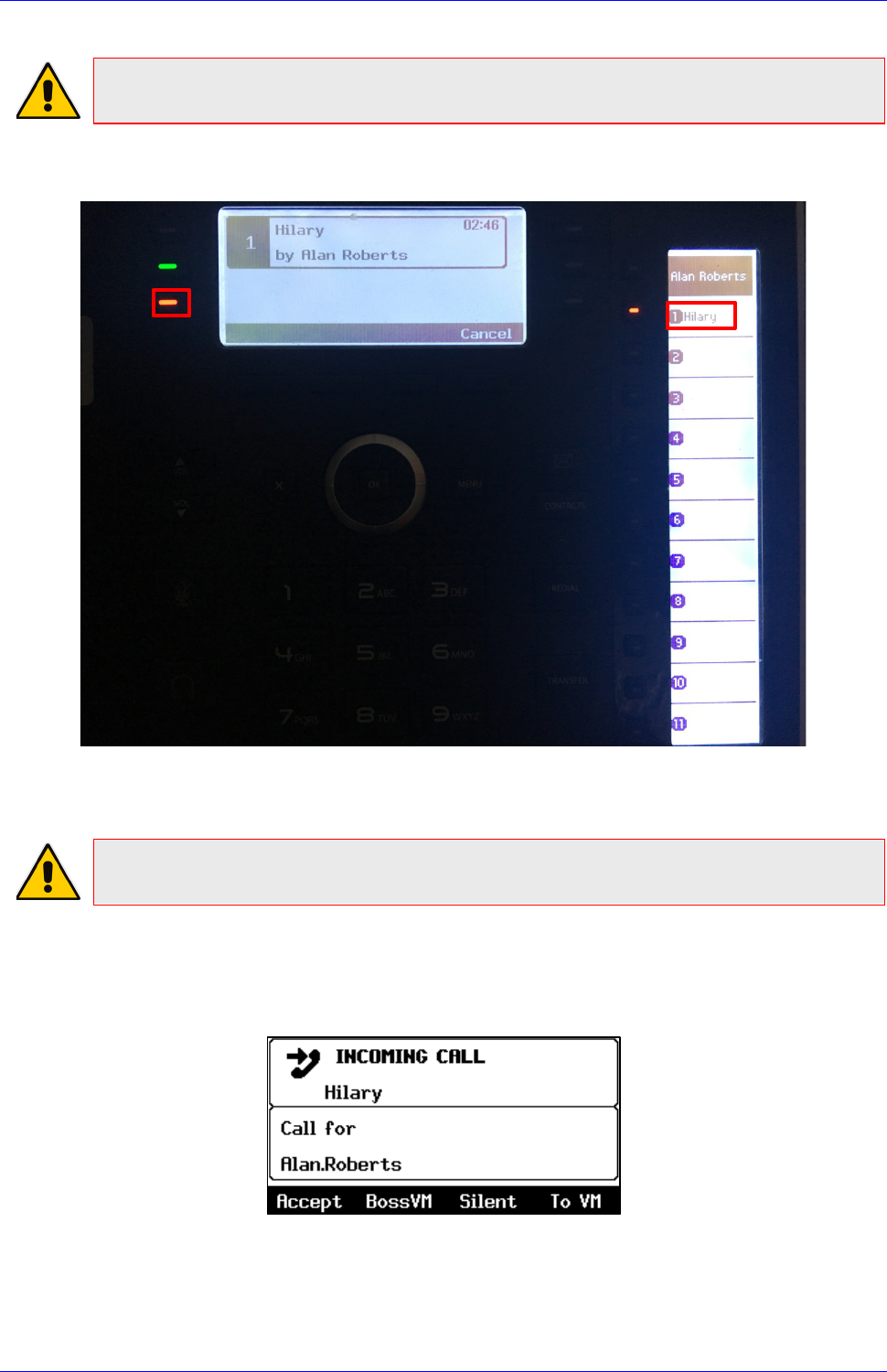
User's Manual Contents
Version 3.0.1 131 430HD and 440HD IP Phone
Note: Similarly, if a Boss has multiple Admins, the Boss can see which Admin is available or
busy.
2. Admin (Yaron) long-presses Boss's (Alan's) line's hard key, whose red-illuminated LED
indicates Boss is busy; the sidecar displays Boss's (Alan's) active calls:
3. Admin (Yaron) can long-press the other Boss's (Mike's) line's key to display the other Boss's
active calls in the sidecar. Admin can toggle between Bosses.
Note: Similarly, if a Boss has multiple Admins, the Boss can similarly toggle between Admins
to view each Admin's active calls in the sidecar.
• A call coming in to Admin (Yaron) does not ring on Boss's (Alan's or Mike's) phone.
• A call coming in to Alan, e.g., from Hilary, rings on Yaron's phone and on the phones of
all Alan's delegated Admins. On Yaron's phone, an incoming call from Hilary looks like
this:
• Similarly, a call coming in to Mike will ring on all Mike's delegated Admins.
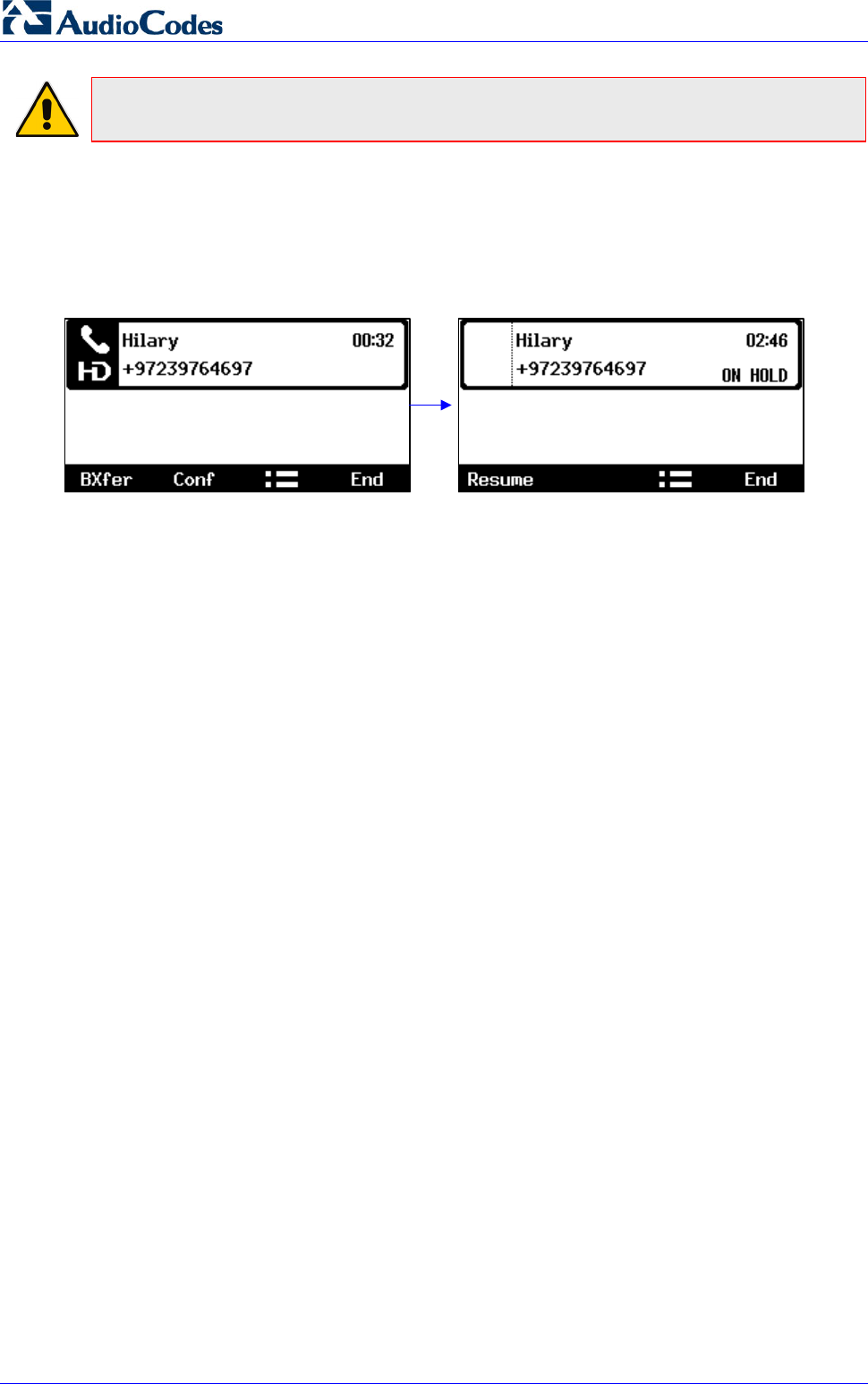
430HD and 440HD IP Phone
User's Manual 132 Document #: LTRT-11939
Note: If a call comes in to Mike, Alan will not hear or see it because the two Bosses are not
delegated to one another - they're unassociated with and unrelated to one another.
8.4.2 Boss Picking up a Call that Admin Put on Hold
Boss can take over a call that Admin answered on behalf of Boss and put on hold.
To take over a call that Admin answered and put on hold
1. Admin (Yaron) answers a call coming in from Hilary and puts it on hold.
2. Admin notifies Boss (Alan) who by long-pressing Admin's (Yaron's) line key will see Admin's
active calls in the sidecar.
3. Boss sees the BLF adjacent to Hilary displayed in the sidecar, flashing red, indicating that
Admin is in a call with Hilary but that the call is on hold.
4. Alan presses the BLF LED to pick up the call.
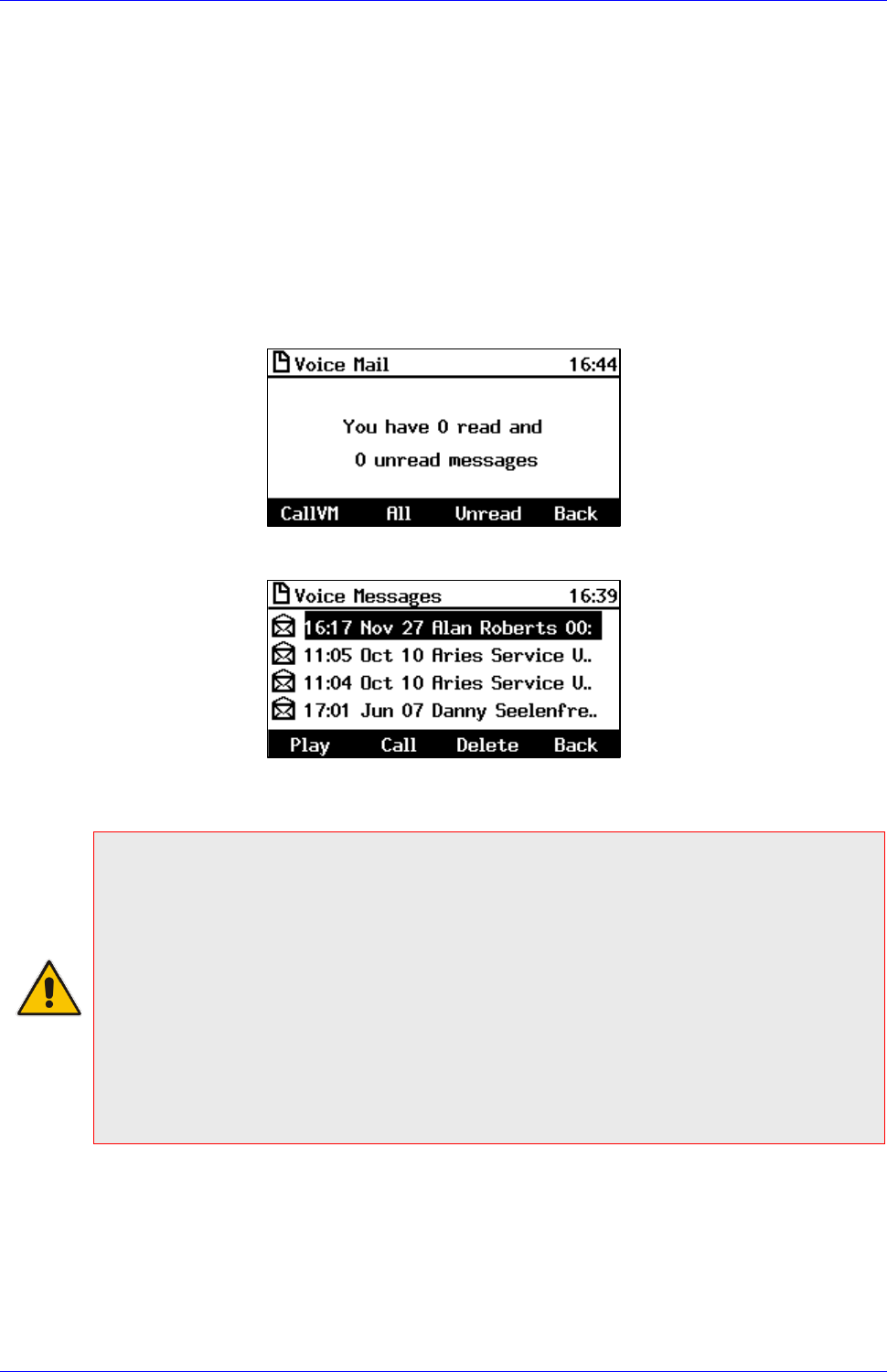
User's Manual Contents
Version 3.0.1 133 430HD and 440HD IP Phone
8.5 Viewing and Playing Voicemail Messages
New messages will be in your voicemail box if:
The Ring LED on the front of the phone is permanently lit blue (see Figure 2-1, label 1).
An envelope icon is displayed in the phone's screen.
A stutter dial tone is heard when you pick up the handset.
The voicemail key on the phone is illuminated red
When you have at least one new message in your voicemail box, you can listen to it.
To view a list of your voicemail messages:
1. Press the voicemail key:
2. Press the All softkey and wait for the list to update.
3. Scroll to select from the list which message to Play, Call or Delete.
Note:
For this feature to function:
• Your network administrator must enable private voicemail for you.
You must sign in to the phone with your username and password. If you signed in with
your PIN code, voicemail will be unavailable and you'll see the message Your account is
not configured for Exchange Unified Messaging.
• Features like this, activated from Microsoft's Exchange Server, are only available after
signing in to the phone with username and password.
• By default, the phone skips PIN code authentication and allows users direct access to
voicemail. The network administrators can secure user access to voicemail with PIN code
authentication so that when the user presses the voicemail key, they're prompted to enter
their PIN code. See the Administrator's Manual for details.
When you have at least one new message in your voicemail box, you can listen to it.
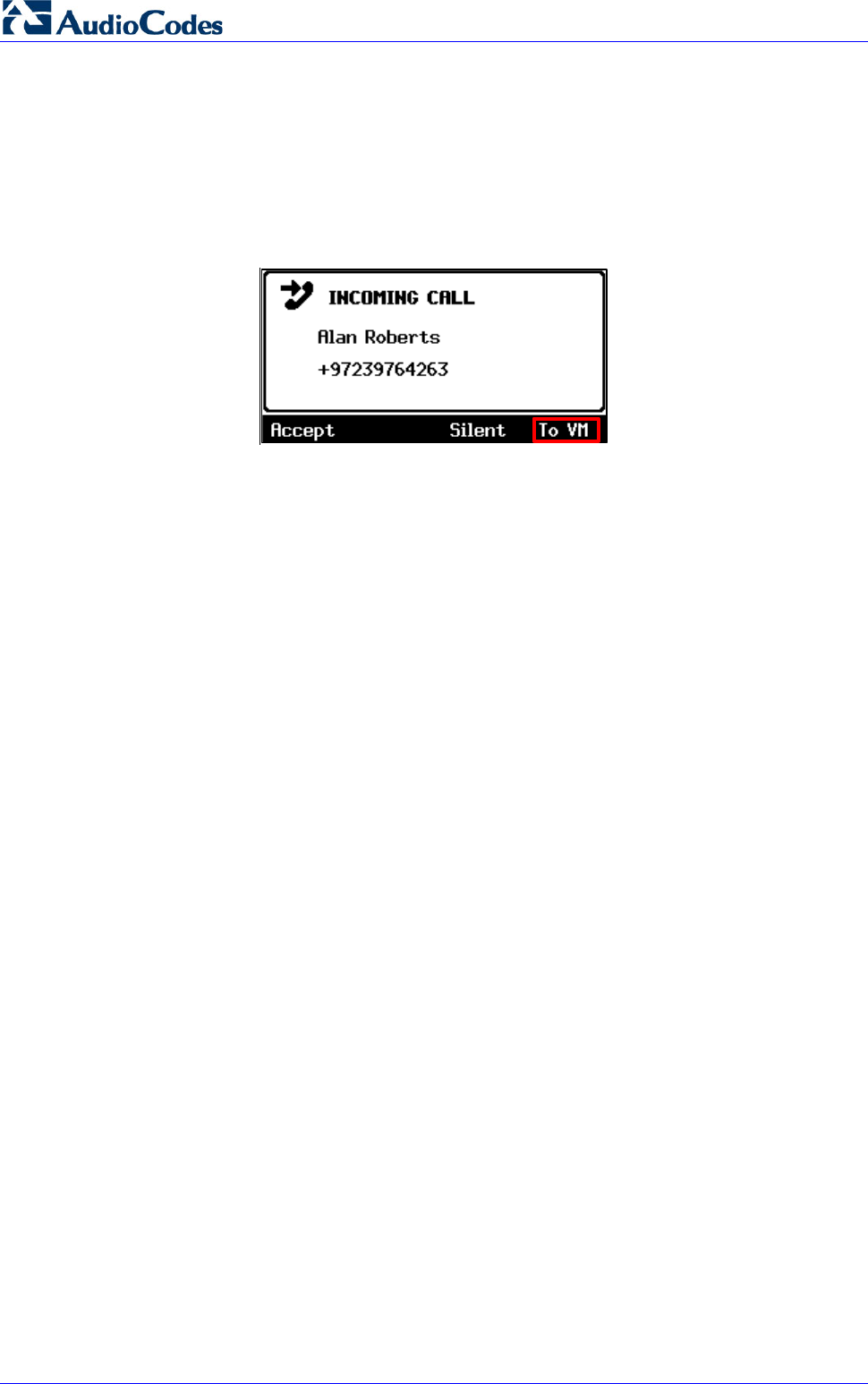
430HD and 440HD IP Phone
User's Manual 134 Document #: LTRT-11939
8.5.1 Sending an Incoming Call Directly to Voicemail
If a time constraint, for example, prevents you from answering an incoming call, you can sent it
directly to voicemail.
To send an incoming call directly to voicemail:
Press the To VM softkey displayed when the phone rings.
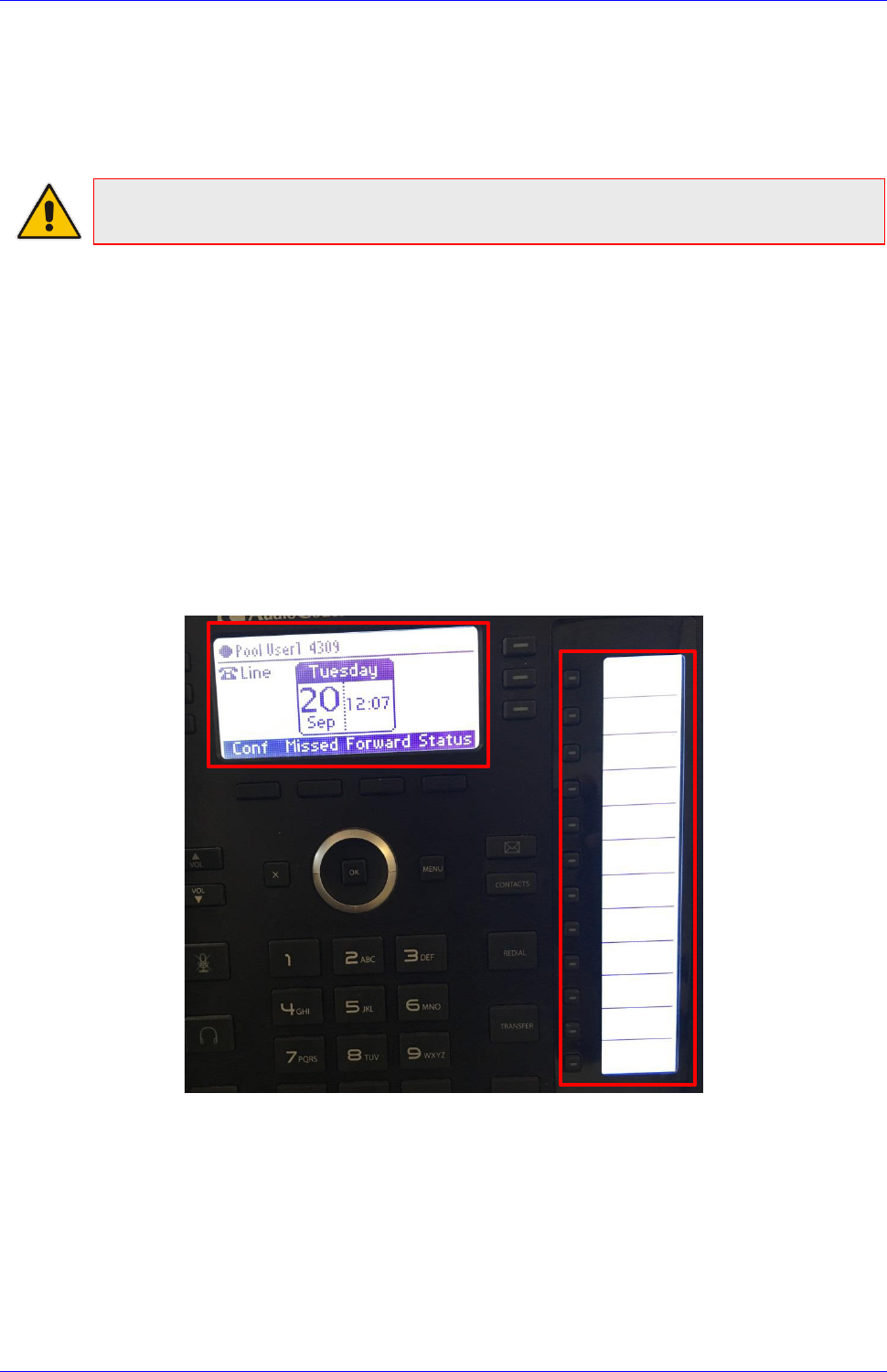
User's Manual 9. Managing Calls on 2+ Phones with a Delegated Line, Using Sidecars
Version 3.0.1 135 430HD and 440HD IP Phone
9 Managing Calls on 2+ Phones with a
Delegated Line, Using Sidecars
Note: Applies to the 440HD phone only. Consult the enterprise network administrator in order
to set up the feature. For setup information, see the Administrator's Manual.
This feature allows configuring two or more phones with the same phone number so that each
user in the pool can see, monitor and/or handle incoming calls using the phone's integrated
sidecar.
Using the feature, employees may be able to handle calls more effectively and efficiently,
enhancing both user and the customer experience.
Boss and Admin can utilize the sidecar to present active and held calls in the queue.
Admin can see each Boss queue on the sidecar
Boss can see all Boss calls in the queue on the sidecar
A mix of Admin and Boss can be also used in this mode
Users can still use the sidecar for Speed Dial/BLF. The upper sidecar key allows users to
switch between BLF and Boss/Admin queues.
The screenshots below illustrate how the feature works.
Table 9-1: Phone Screen in Idle Mode and Sidecar BLF Keys and Fields
The figure above shows the phone screen (in idle mode) and sidecar (BLF keys and fields) of a
phone in the pool.
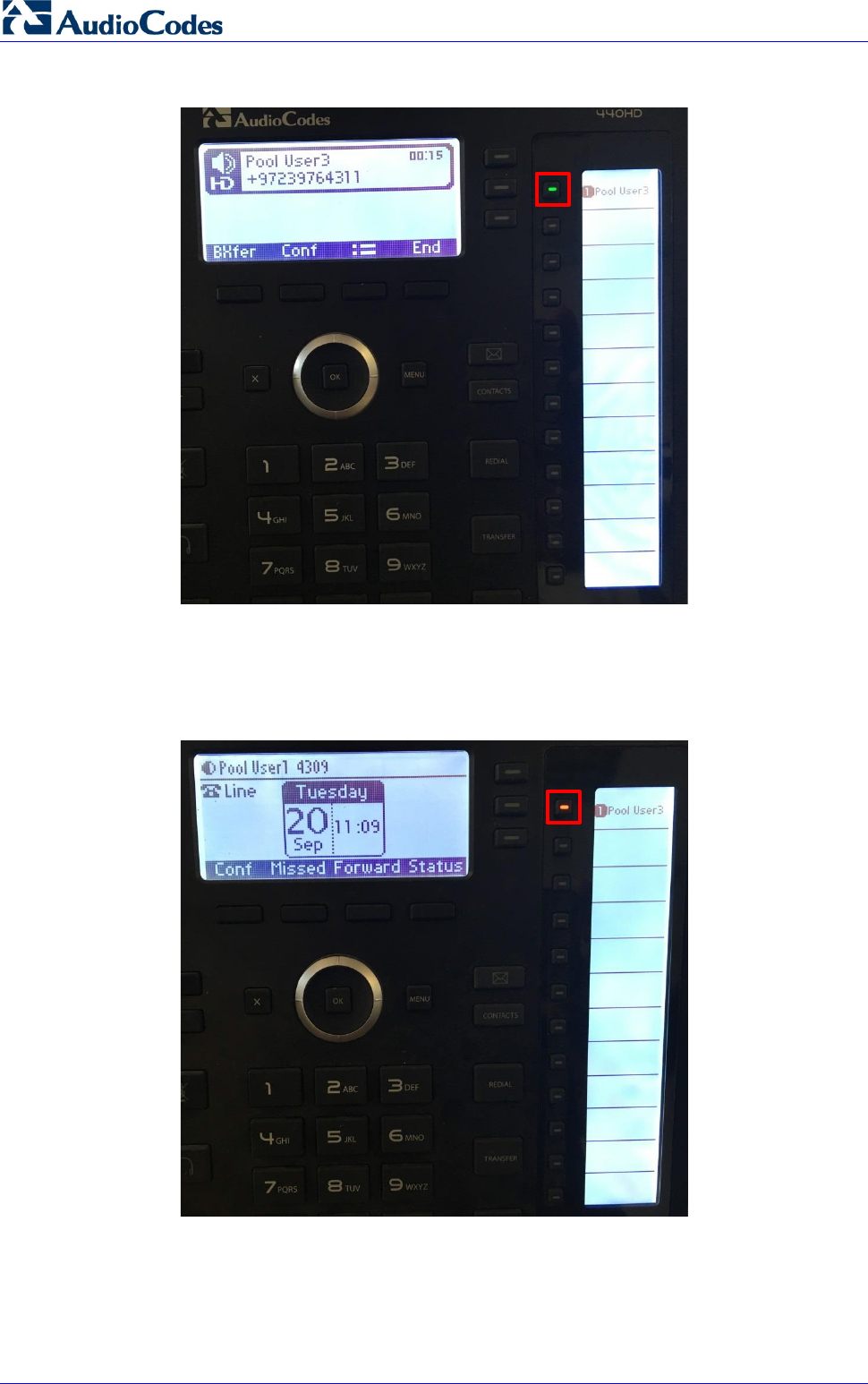
430HD and 440HD IP Phone
User's Manual 136 Document #: LTRT-11939
Table 9-2: Phone A: Answered Incoming Call on Phone A
The figure above shows an answered incoming call.
Steady green BLF key = active call on this phone (Phone A)
Flashing green BLF key = held call on this phone (Phone A)
Table 9-3: Phone B: Answered Incoming Call on Phone A
The figure above shows Phone B.
Steady red BLF key = call answered on phone A
Flashing red BLF key = call answered on phone A and put on hold on phone A
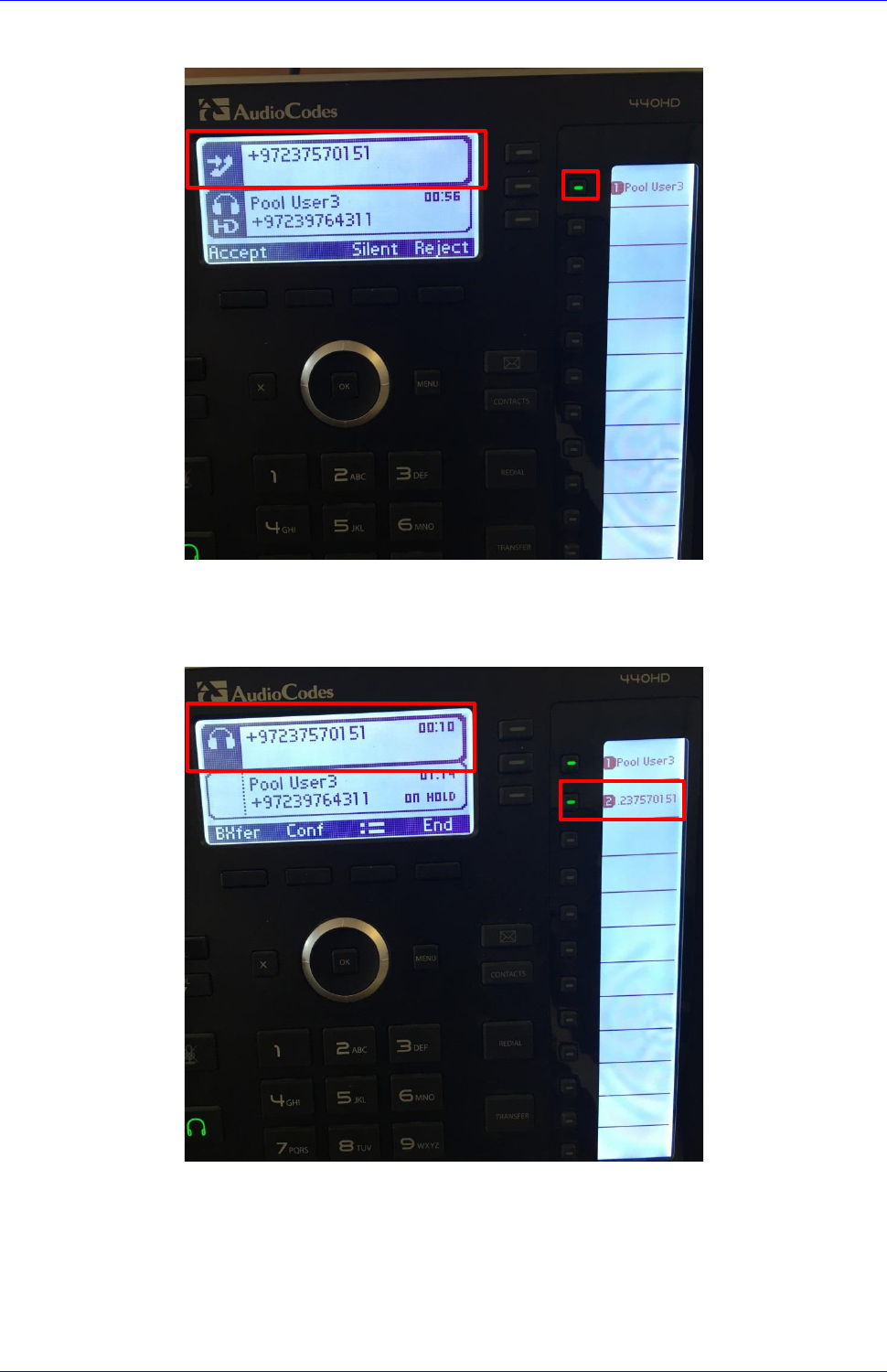
User's Manual 9. Managing Calls on 2+ Phones with a Delegated Line, Using Sidecars
Version 3.0.1 137 430HD and 440HD IP Phone
Table 9-4: New Incoming Call
Phone A: The figure above shows a new incoming call. Note that it's on top. Note the steady
green BLF key indicating the first call that was answered on this phone.
Table 9-5: Answered New Incoming Call
Phone A: The figure above shows an answered new incoming call. It appears in the sidecar BLF
field only after it is answered.
Steady green BLF key = active call on this phone (Phone A)
Flashing green BLF key = held call on this phone (Phone A)
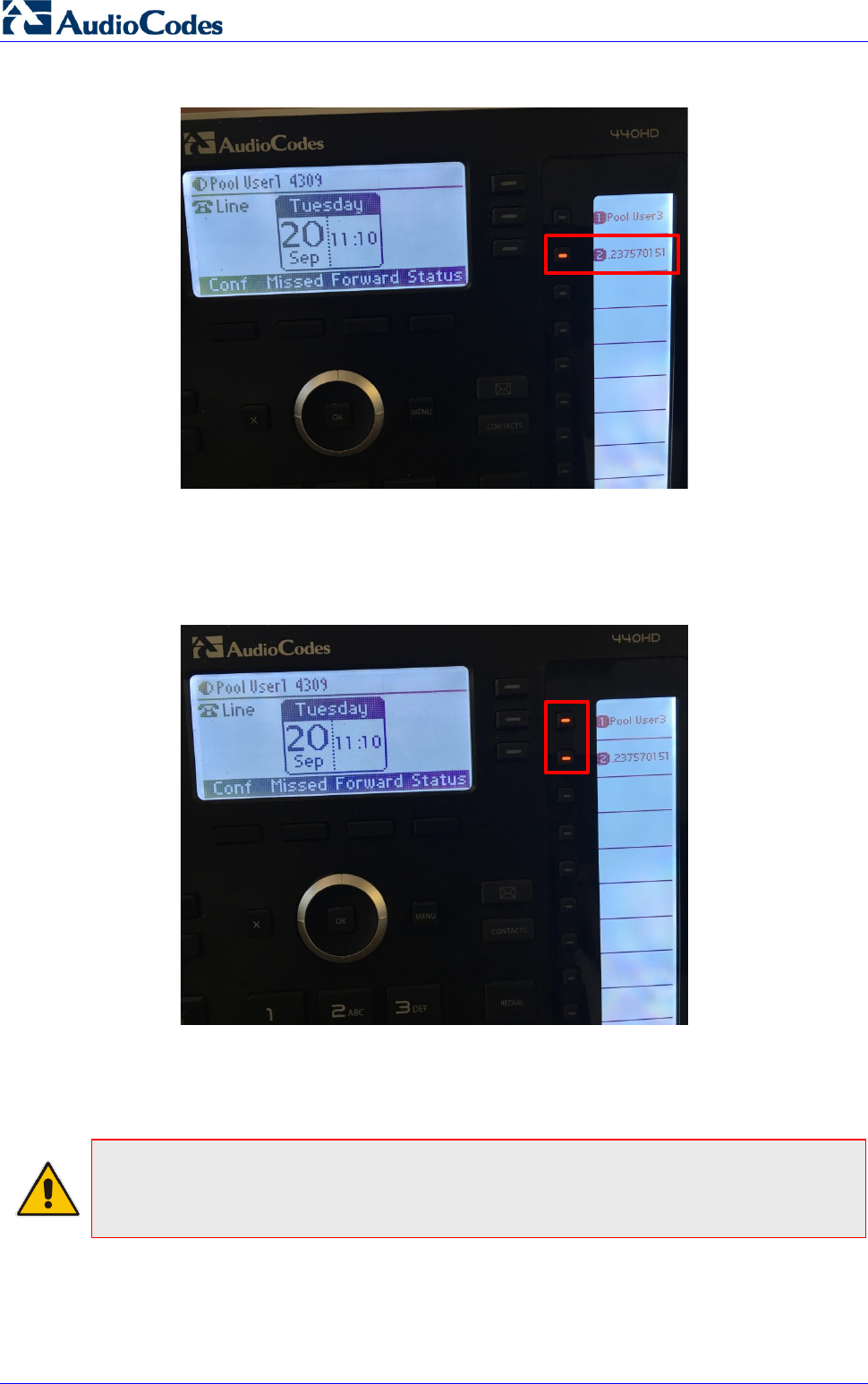
430HD and 440HD IP Phone
User's Manual 138 Document #: LTRT-11939
Table 9-6: Phone B: Answered New Incoming Call
The figure above shows Phone B.
Red BLF key = incoming call answered on Phone A
Flashing red BLF key = incoming call answered on Phone A and put on hold on Phone A
Table 9-7: Phone B: Two Red BLF Keys
The figure above shows Phone B.
Two red BLF keys = both incoming calls were answered by Phone A.
Note:
• Users can press a BLF key to connect to an active call at any time.
• The feature optimizes the work of users who work in groups.
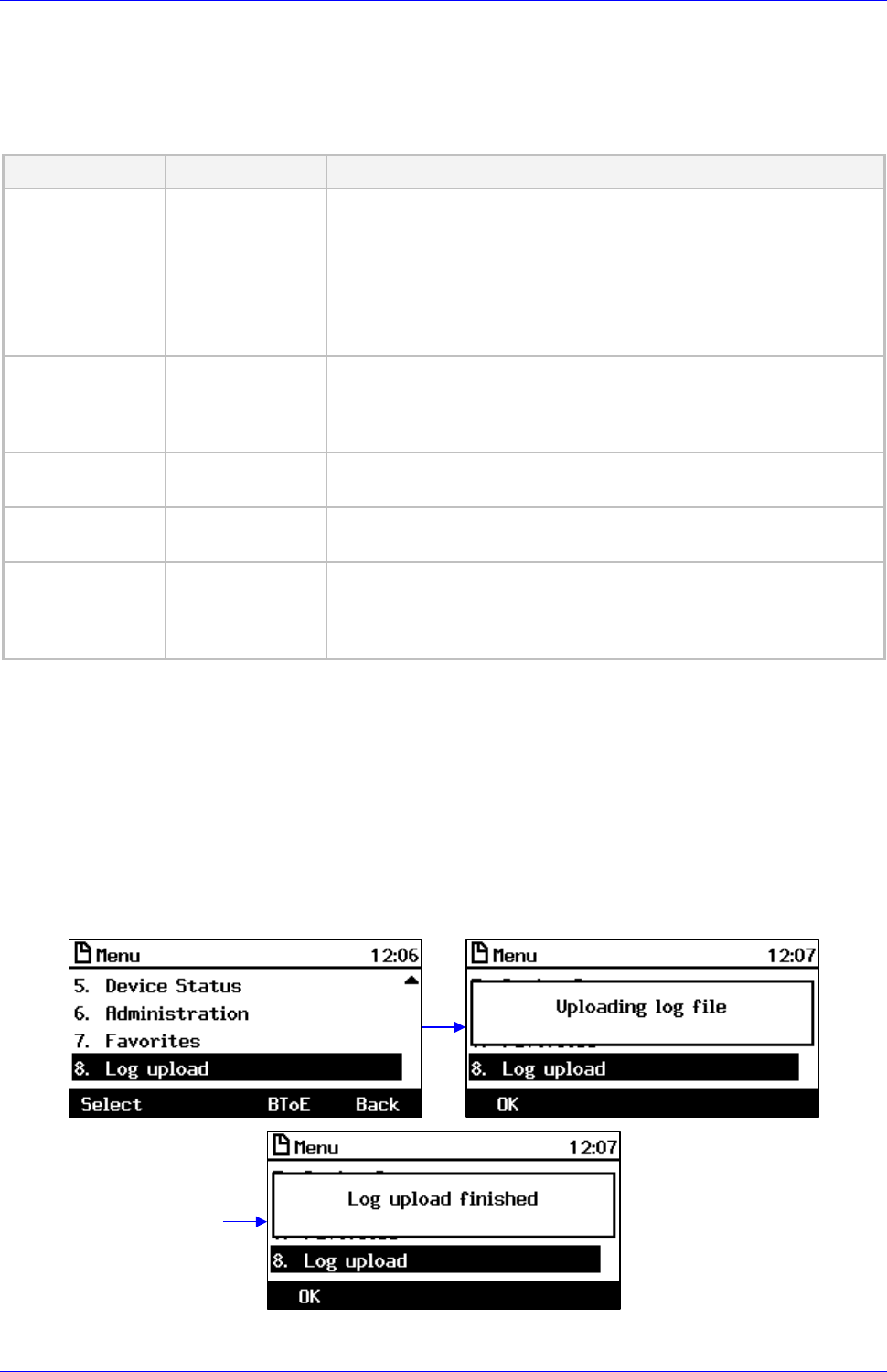
User's Manual 10. Troubleshooting
Version 3.0.1 139 430HD and 440HD IP Phone
10 Troubleshooting
Read this section if a problem with a phone occurs. Contact your administrator if necessary.
Table 10-1: Troubleshooting
Symptom Problem Corrective Procedure
Phone is off
(no screen
displays and
LEDs)
Phone is not
receiving power
Verify that the AC/DC power adapter is attached firmly to the DC
input on the rear of the phone.
Verify that the AC/DC power adapter is plugged into the
electrical outlet.
Verify that the electrical outlet is functional.
If using Power over Ethernet (PoE), contact your network
administrator to check that the switch is powering the phone.
'LAN Link Failure'
message
displayed on
screen
No LAN connection
Verify that the LAN cable is connected securely to the LAN port
on the rear of the phone.
Verify that the other end of the LAN cable is connected to the
network (switch). If it's not, inform your network administrator.
Phone is not
ringing
Ring volume is
set
too low
Increase the volume (see Section 6.13.1)
Screen display is
poor
Screen settings
Adjust the phone’s screen contrast level (see Section 6.7)
Adjust the screen’s backlight timeout (see Section 6.8)
Headset has no
audio
Headset not
connected properly
Verify that your headset is securely plugged into the headset
port located on the side of the phone.
Verify that the headset volume level is adjusted adequately (see
Section 6.13.5).
10.1 Uploading Logs to MS Server for Support Purposes
An integrated log upload feature allows network administrators to upload logs from the phone to
the Microsoft server for troubleshooting/support purposes, in compliance with Microsoft's
certification requirements for 3
rd
party Skype for Business clients. If a user experiences an
irregularity such as poor voice quality, they'll contact an AudioCodes Field Application Engineer
(FAE) who will instruct them to upload and send the logs for analysis. The FAE then downloads
the logs to their PC, performs the analysis, and provides a fix.
To perform log upload:
Press the MENU hard key and scroll down to select Log upload.

